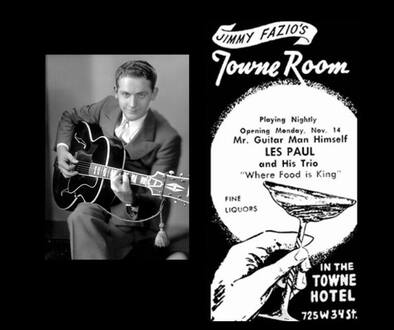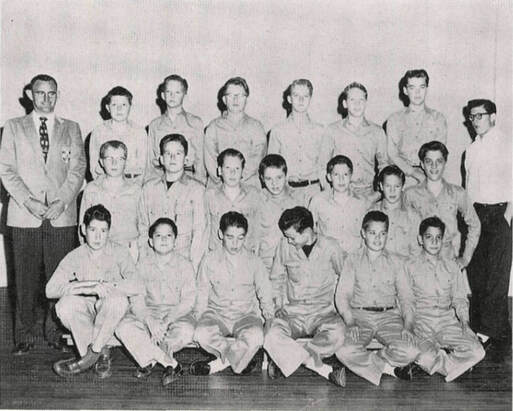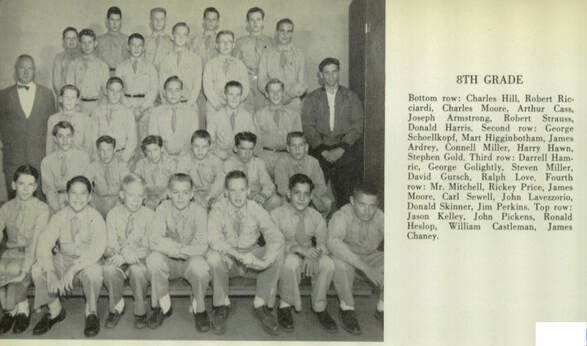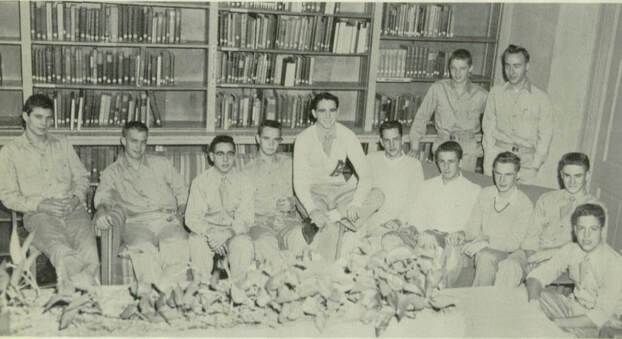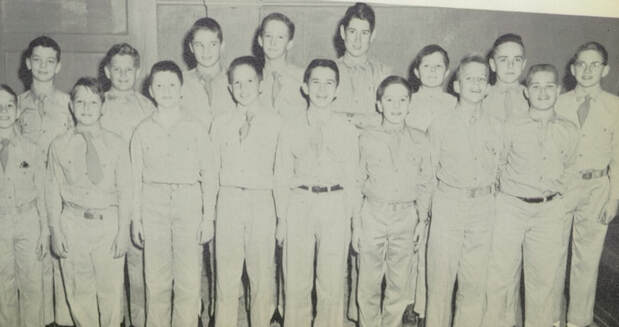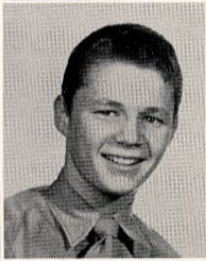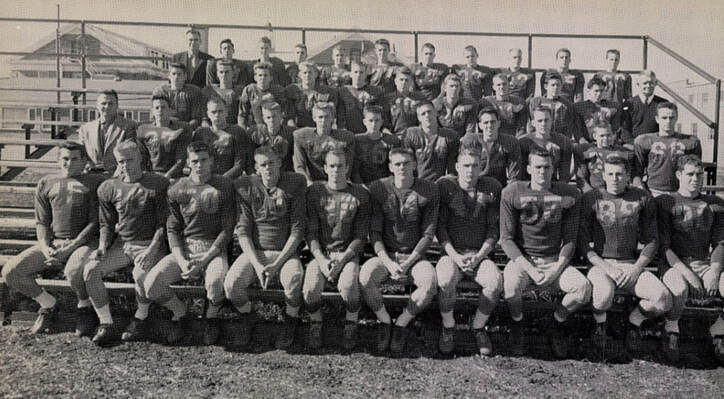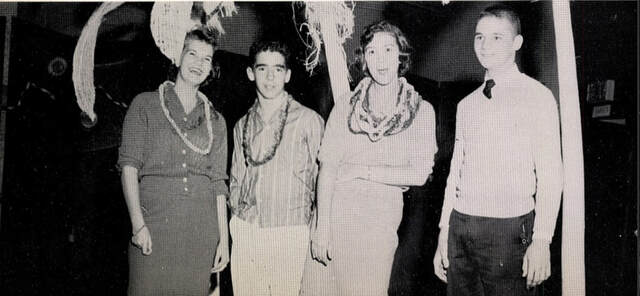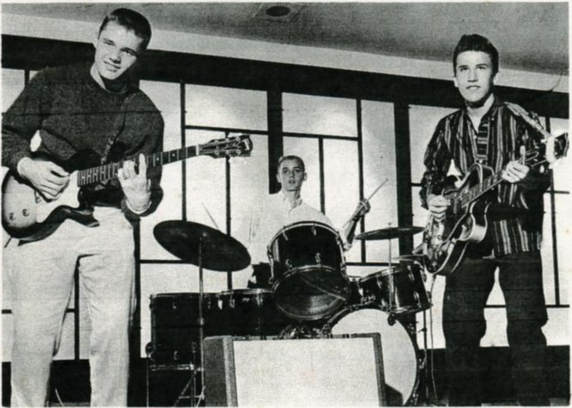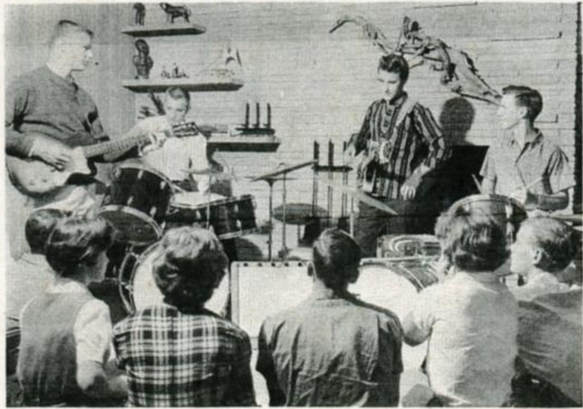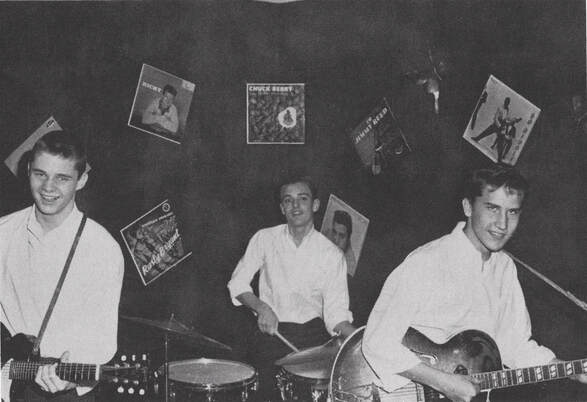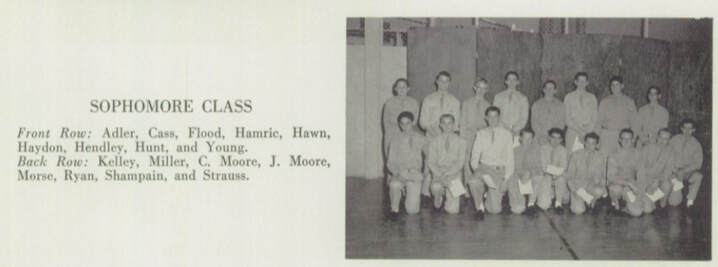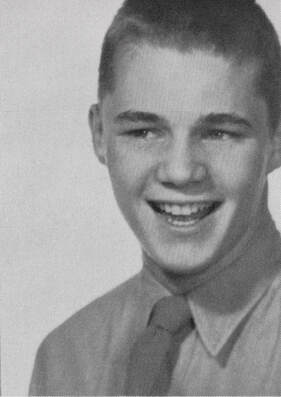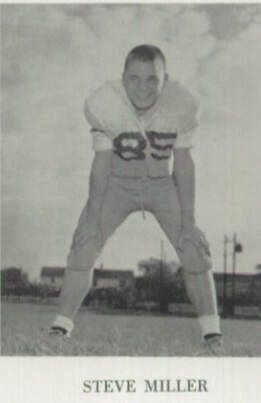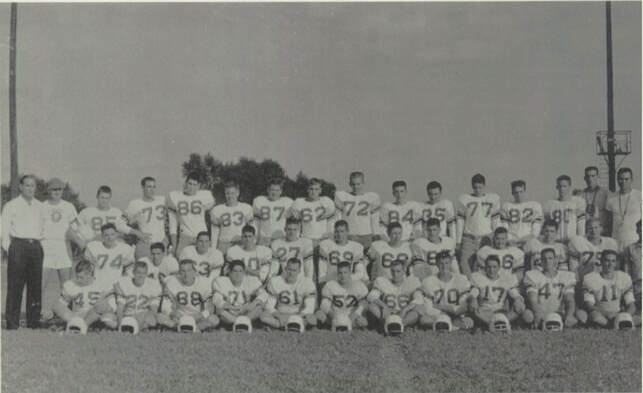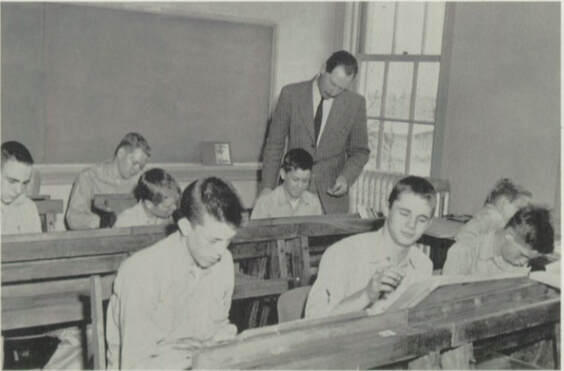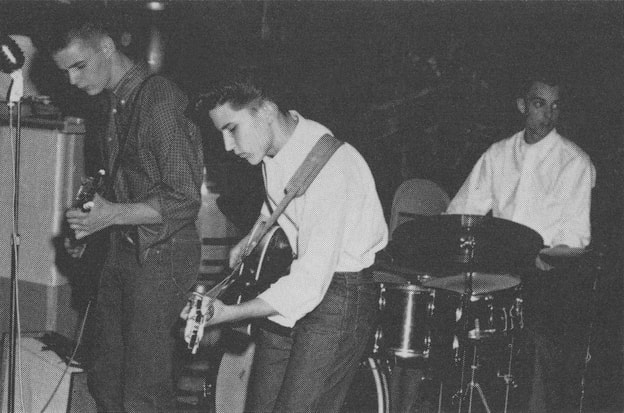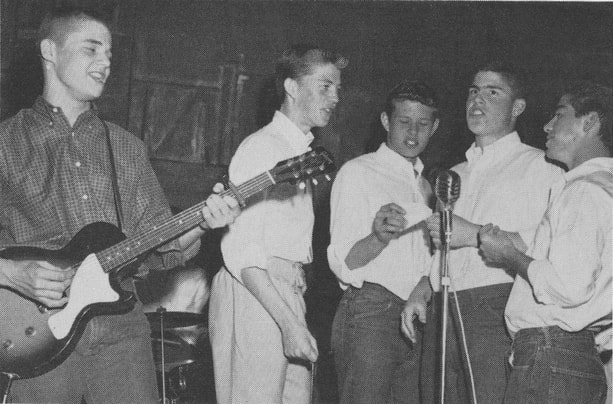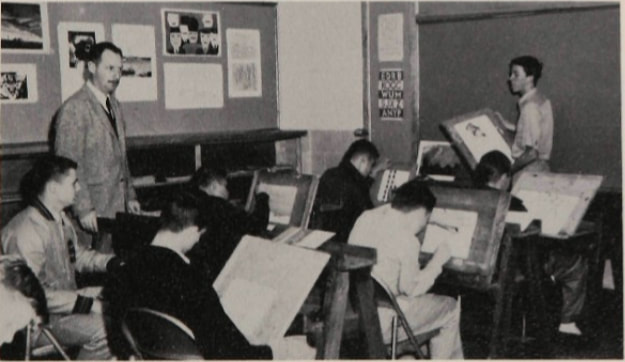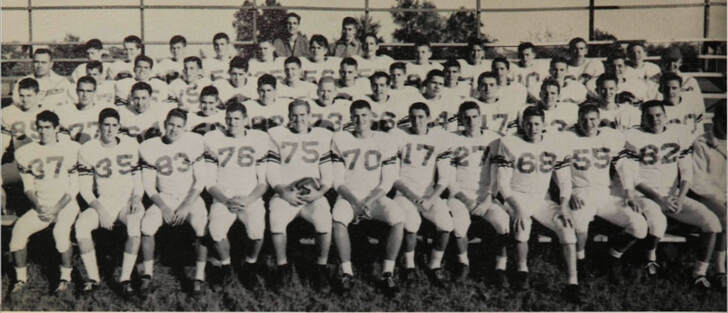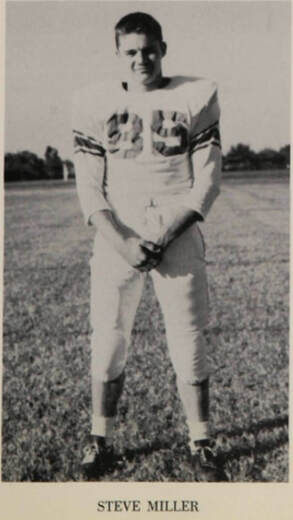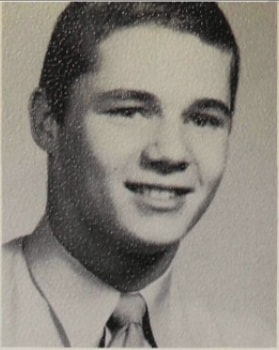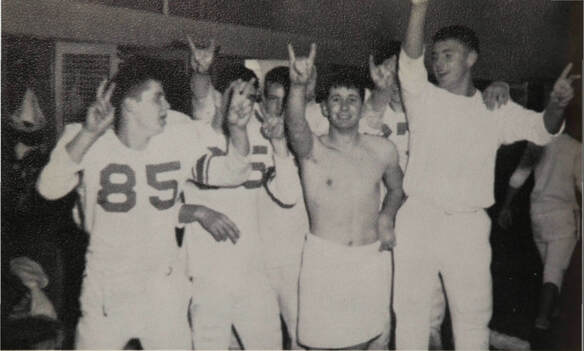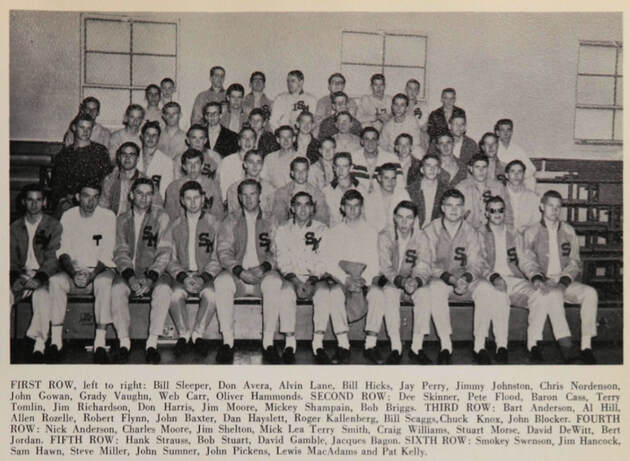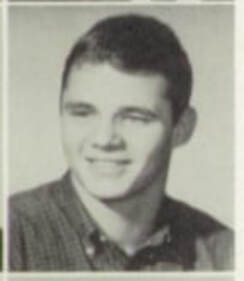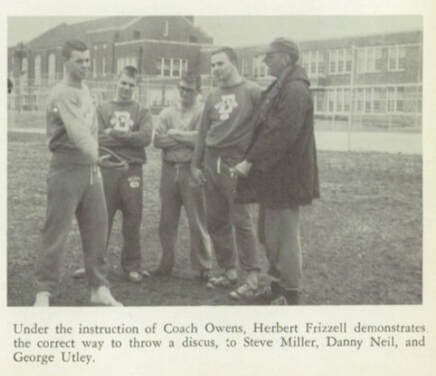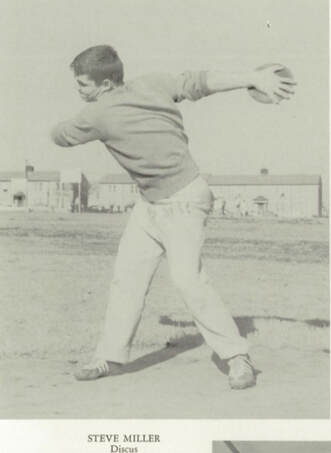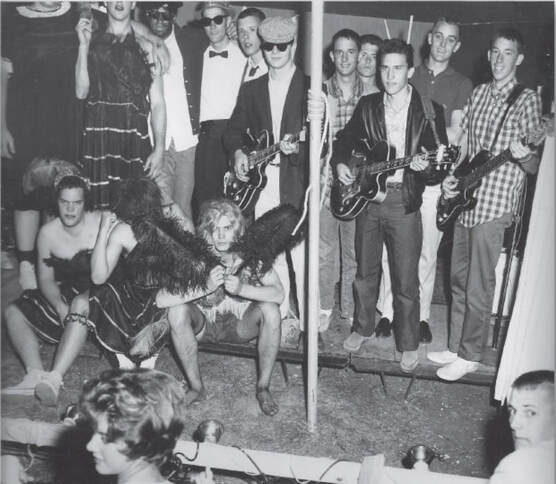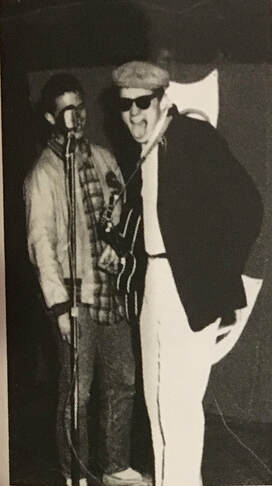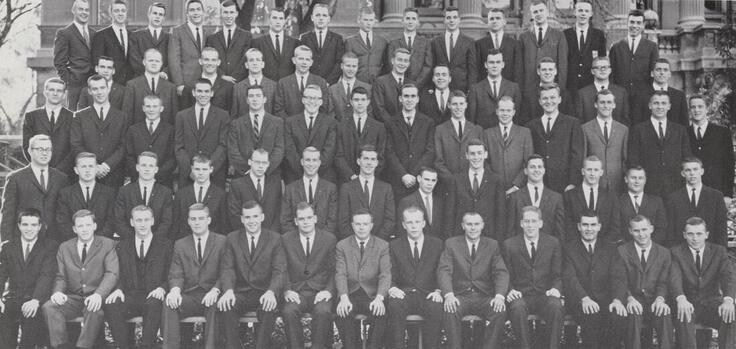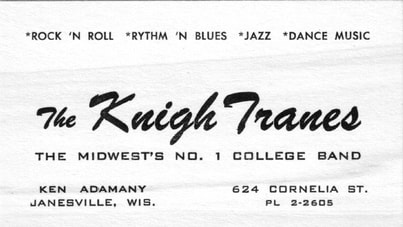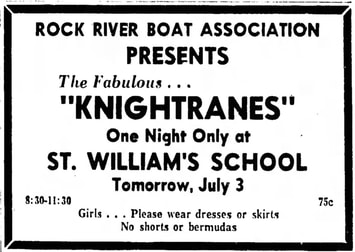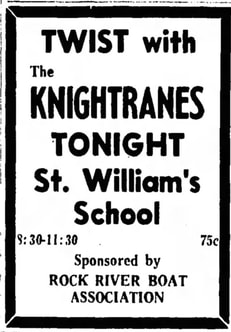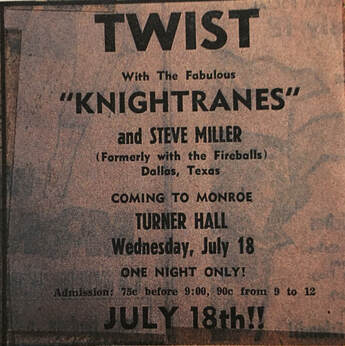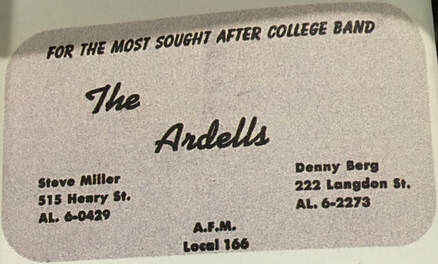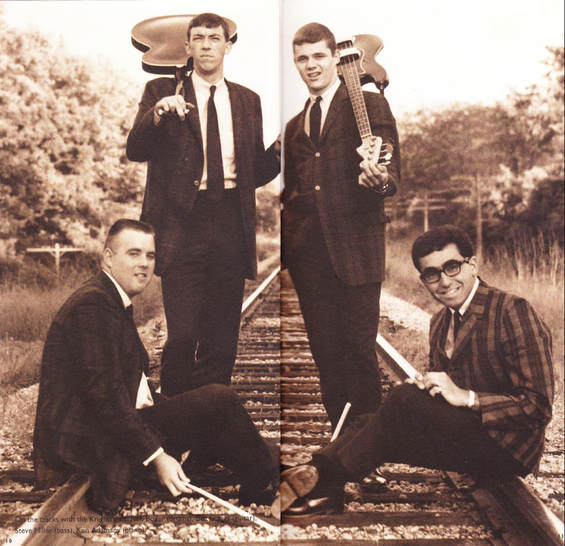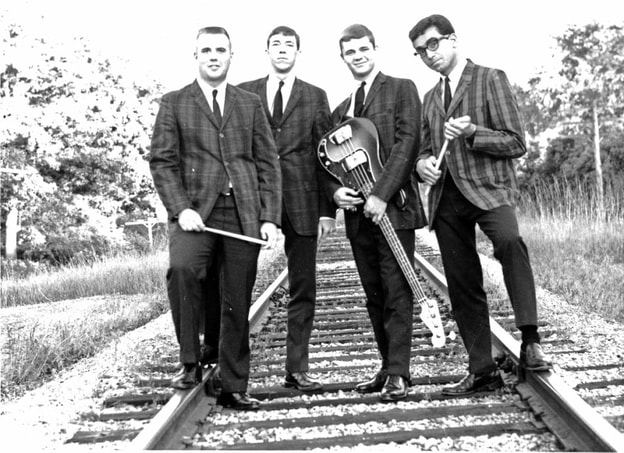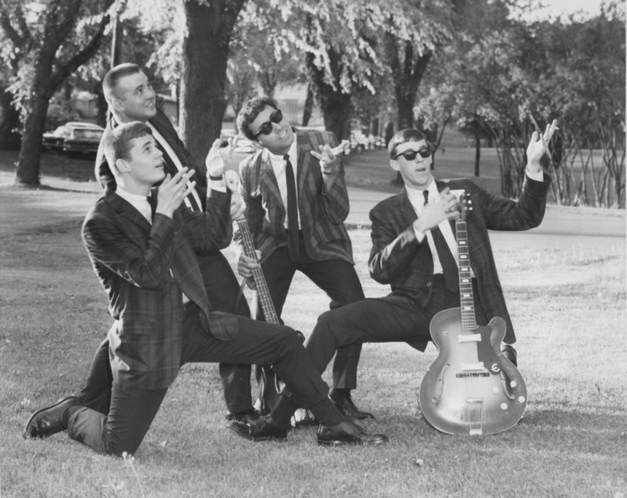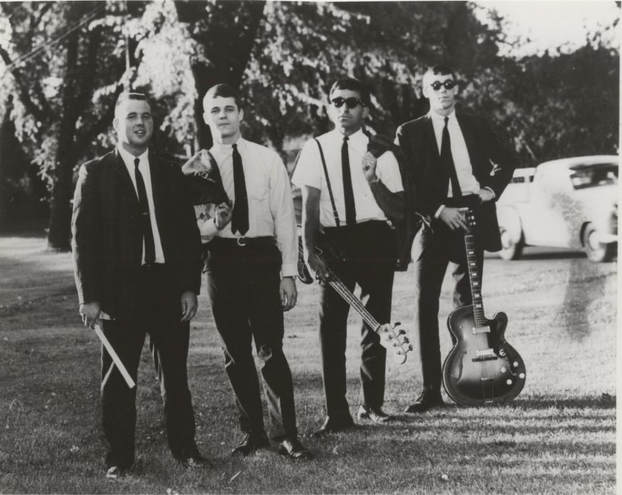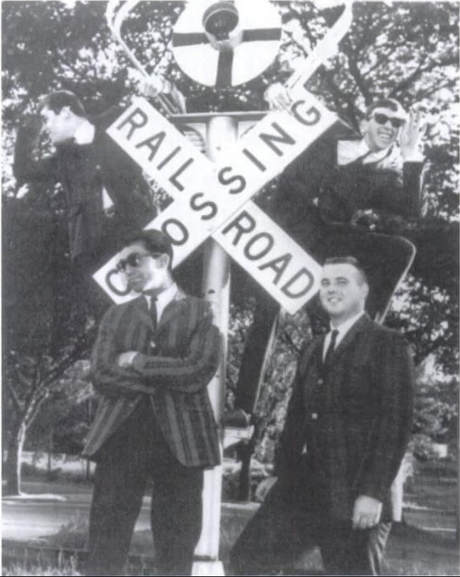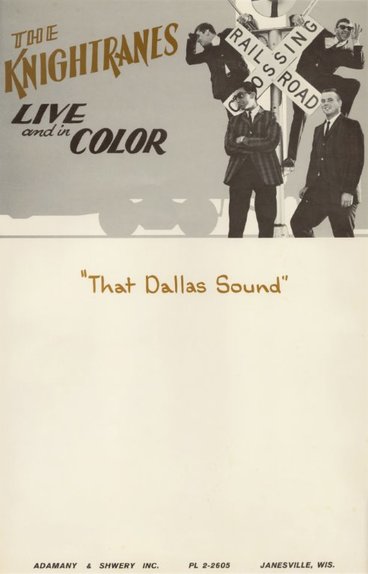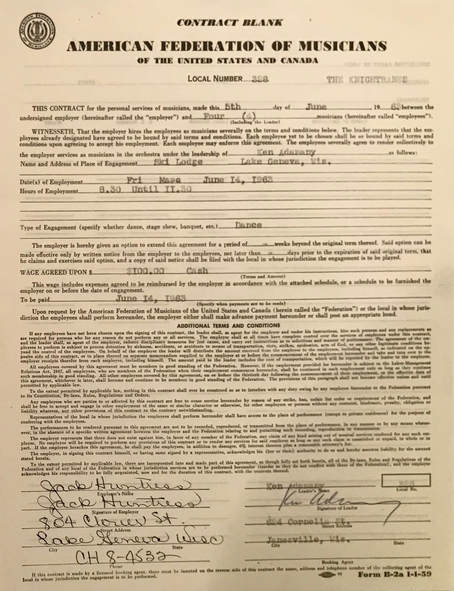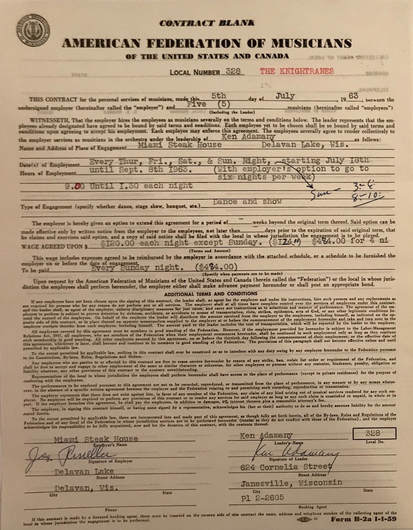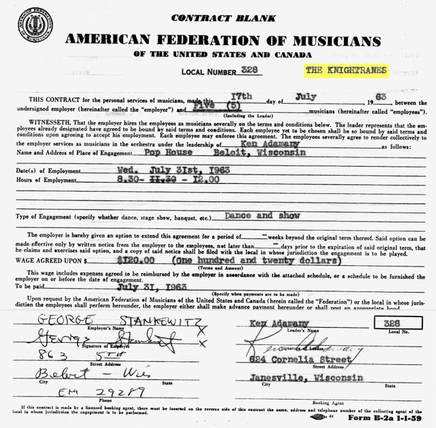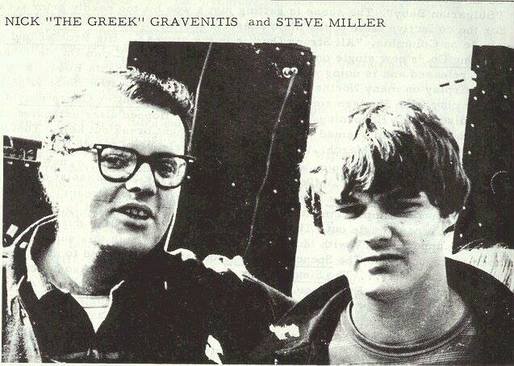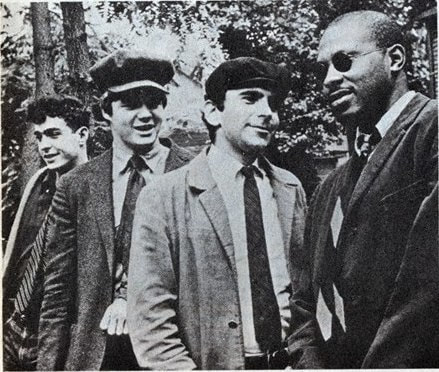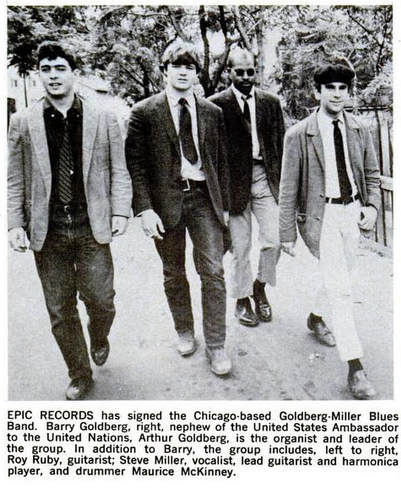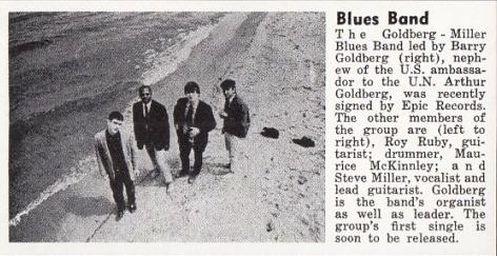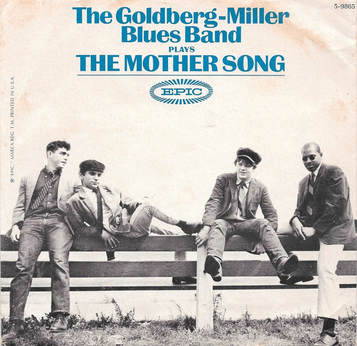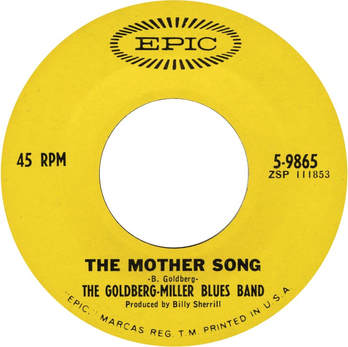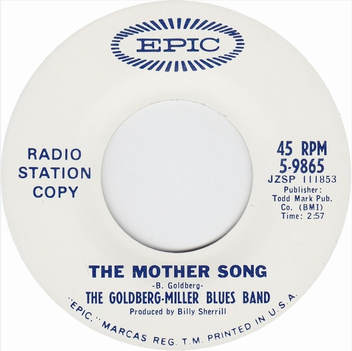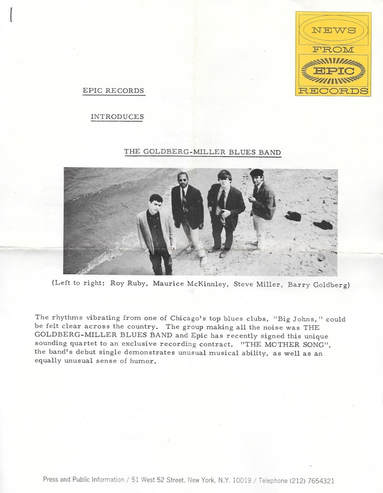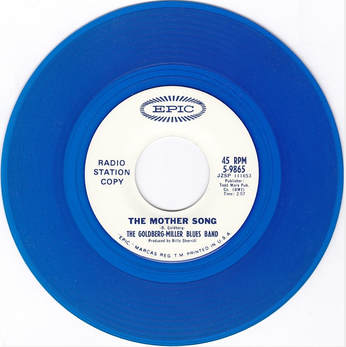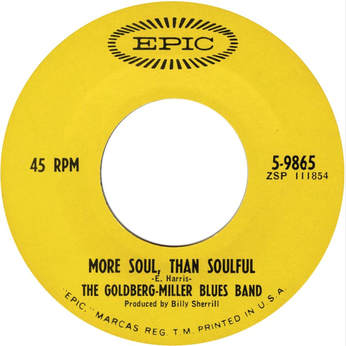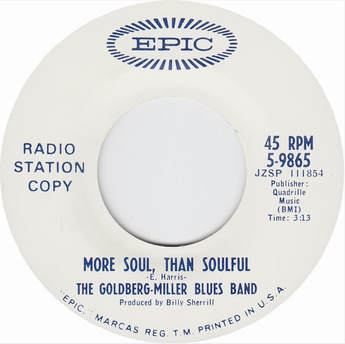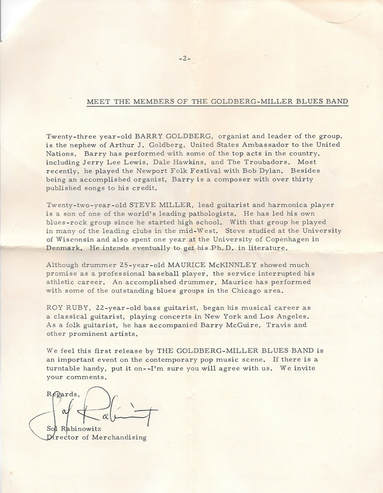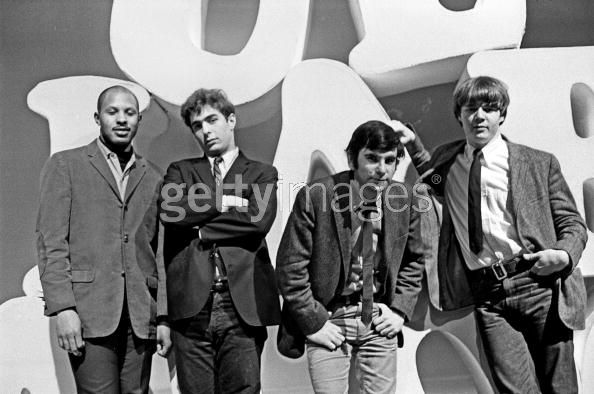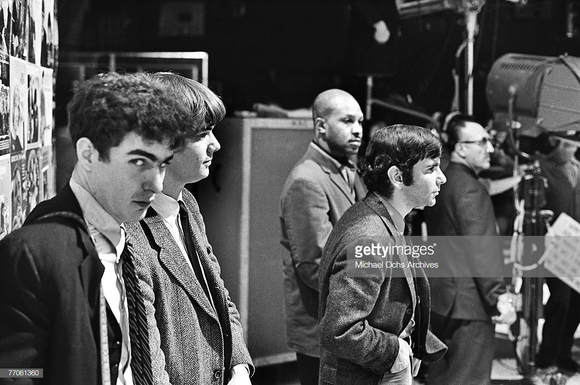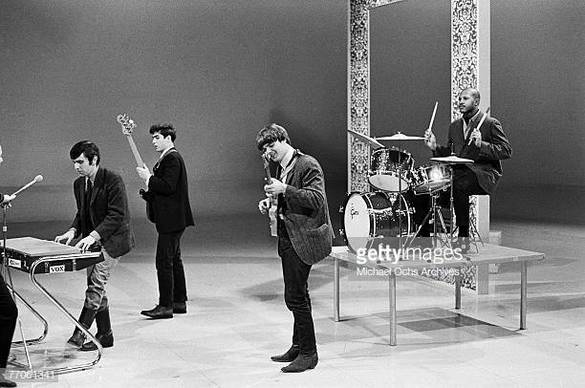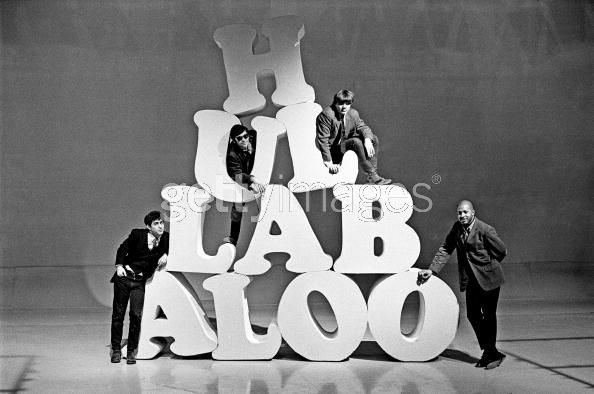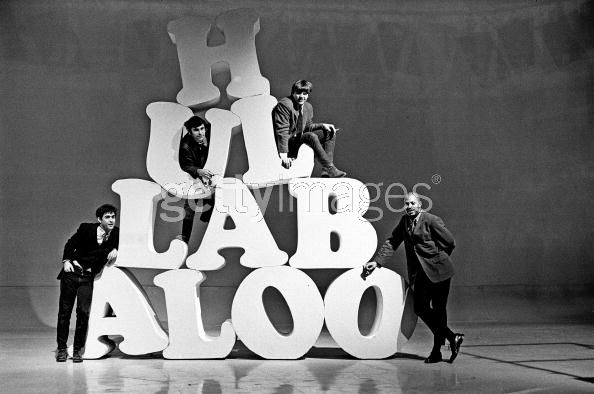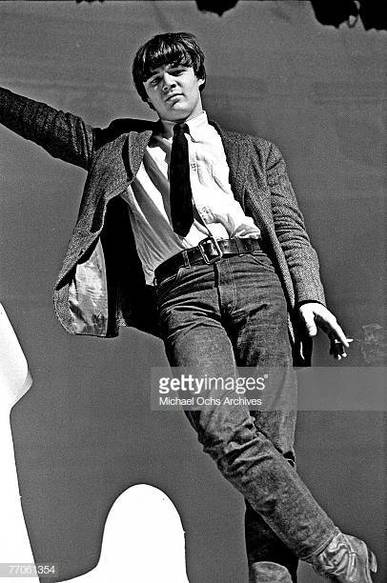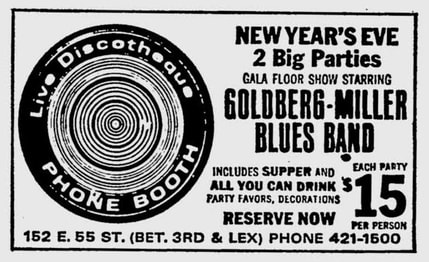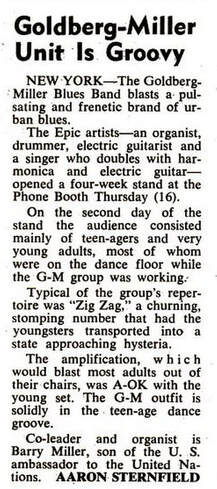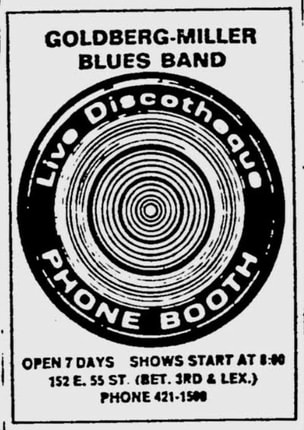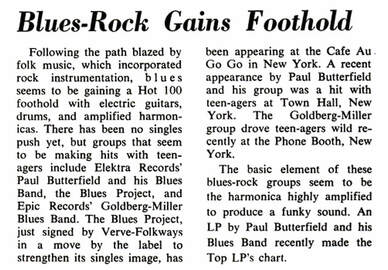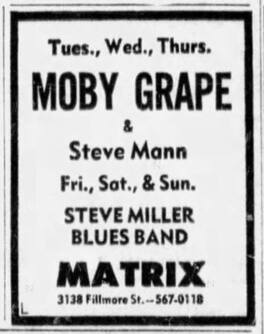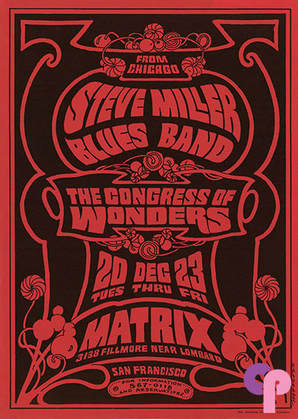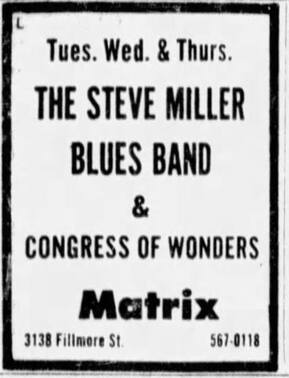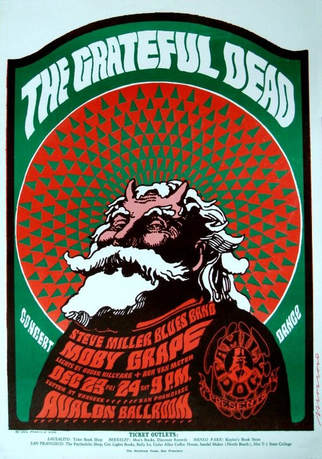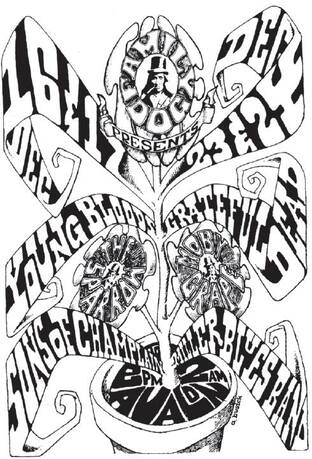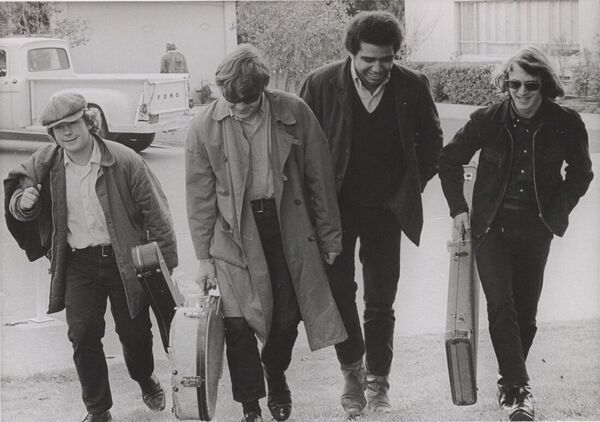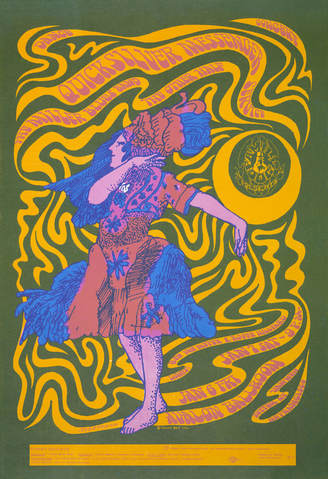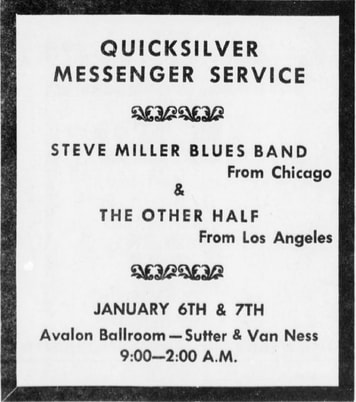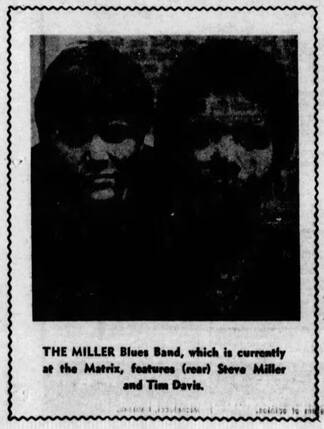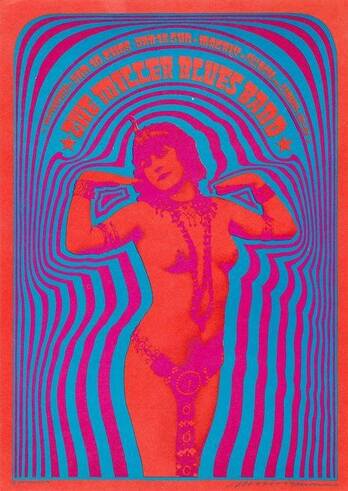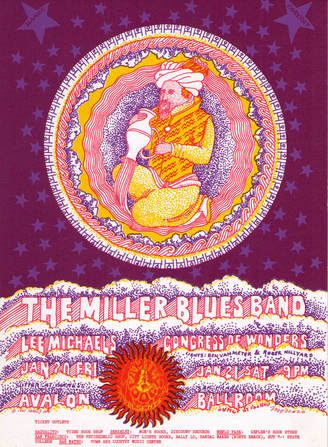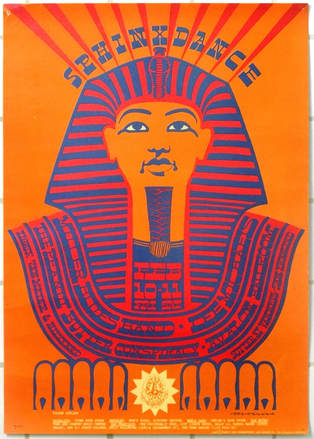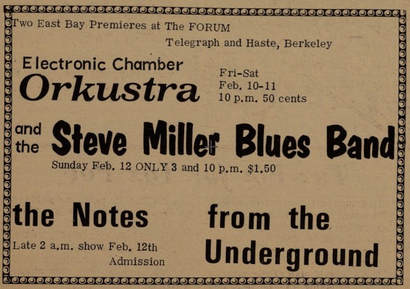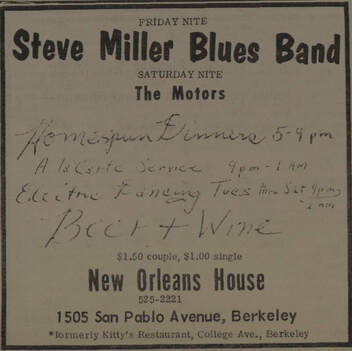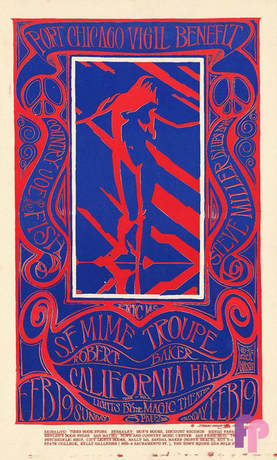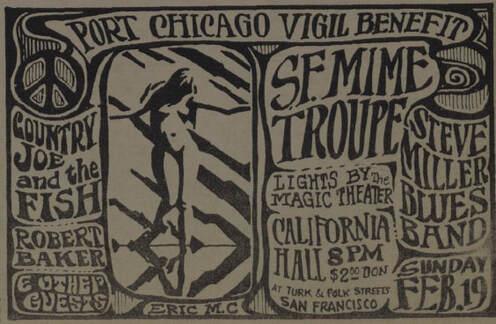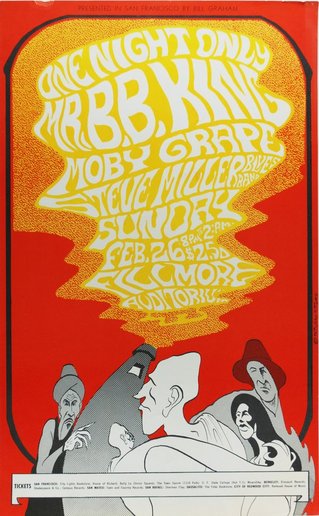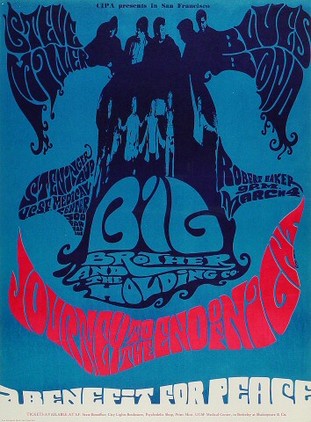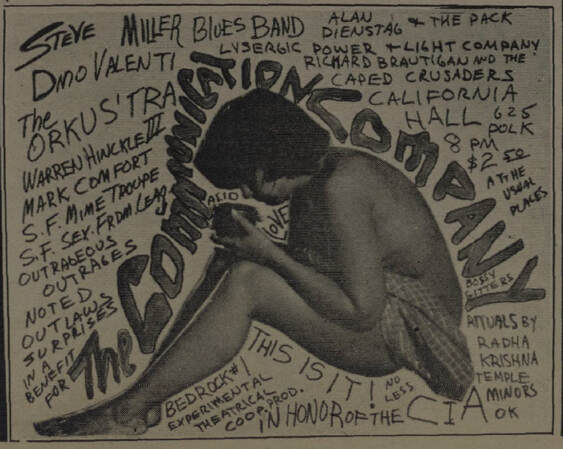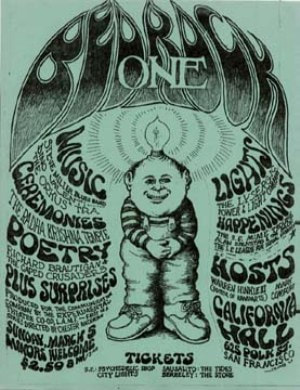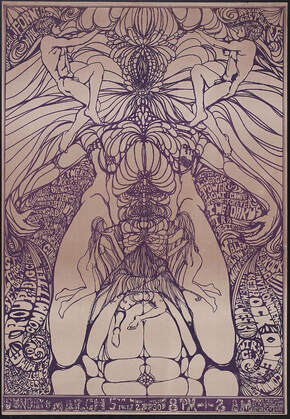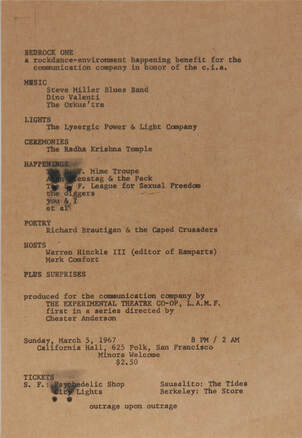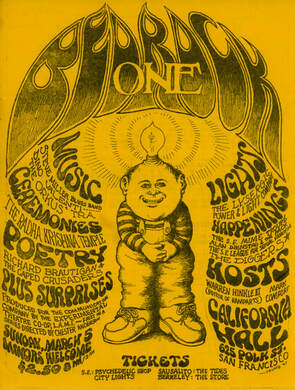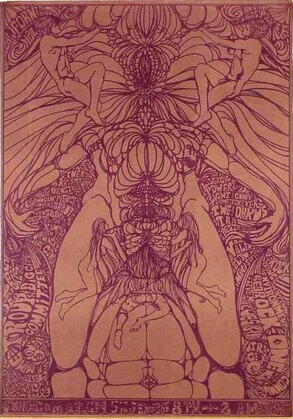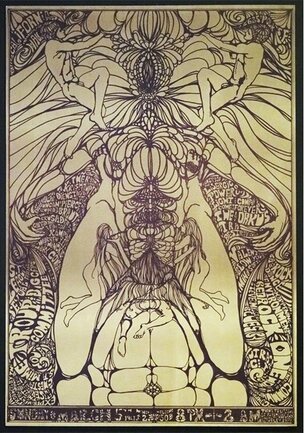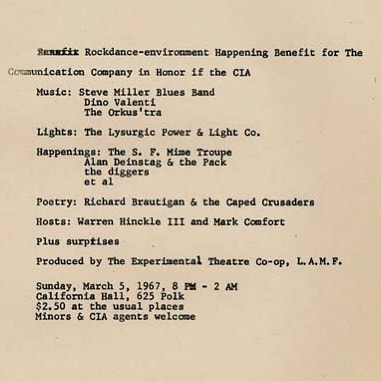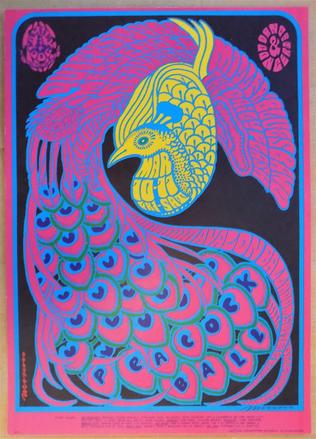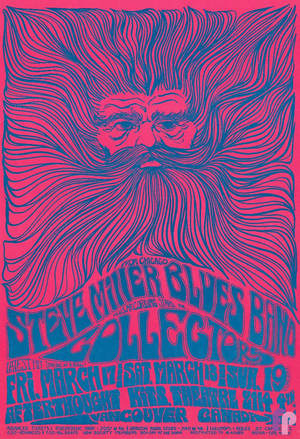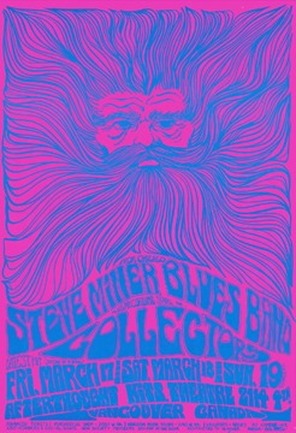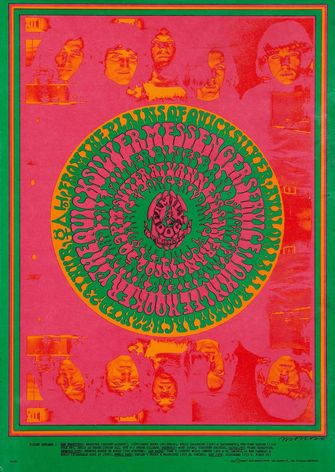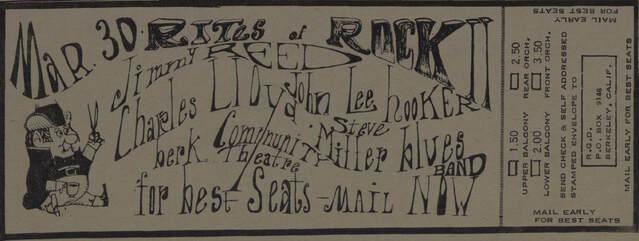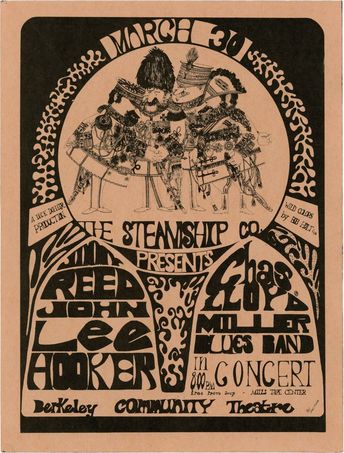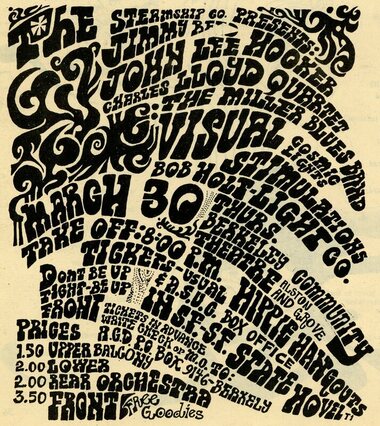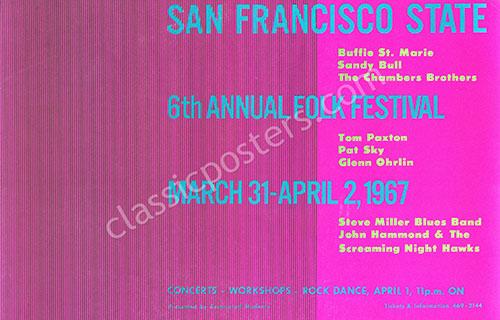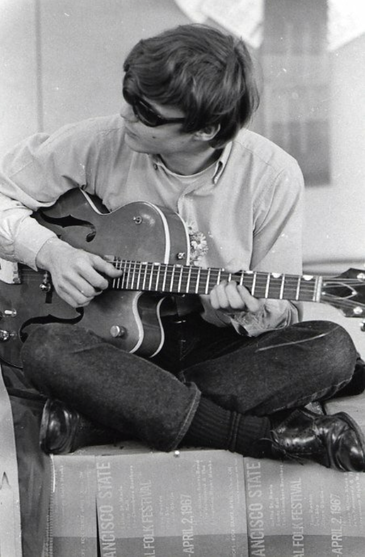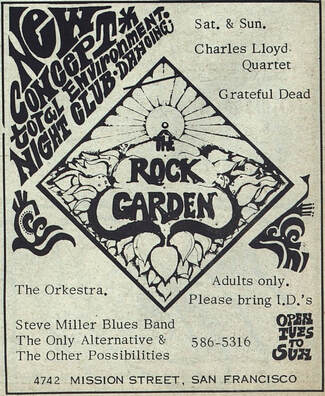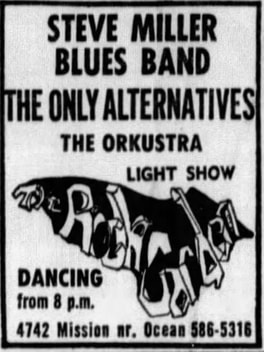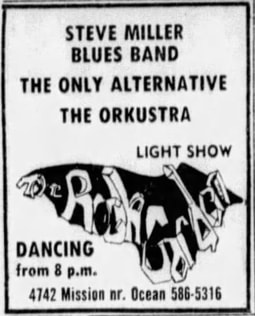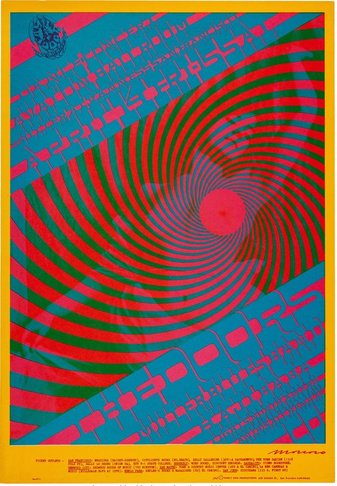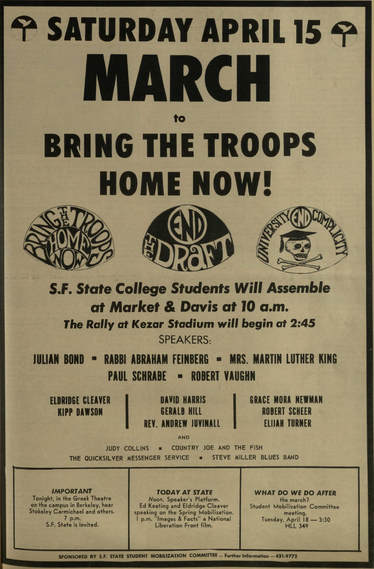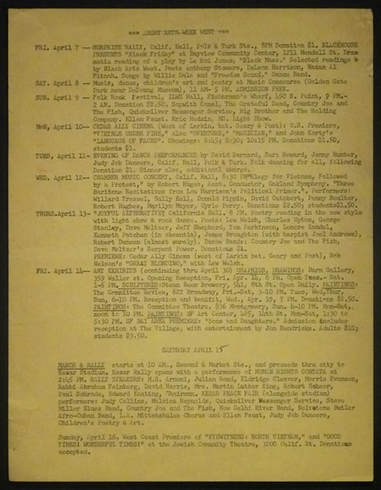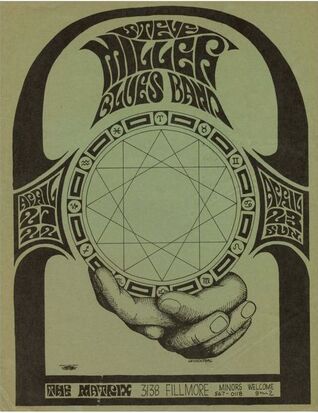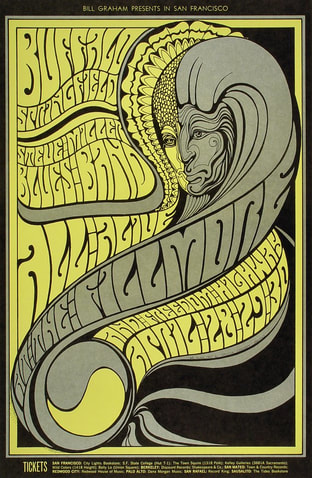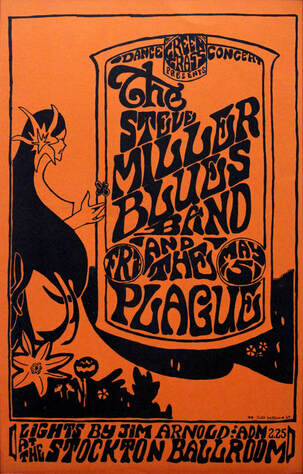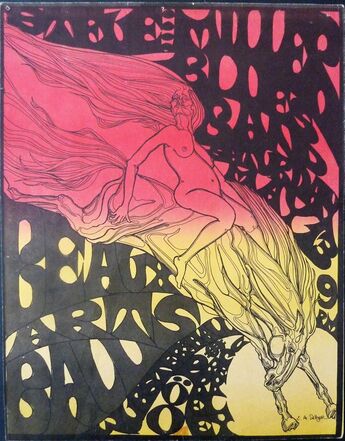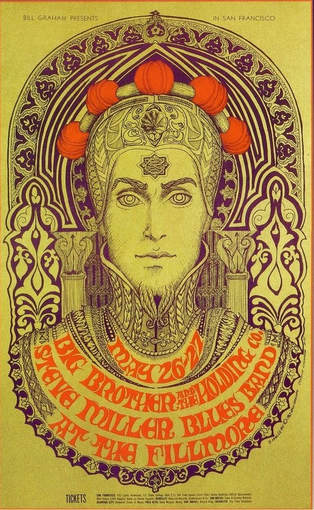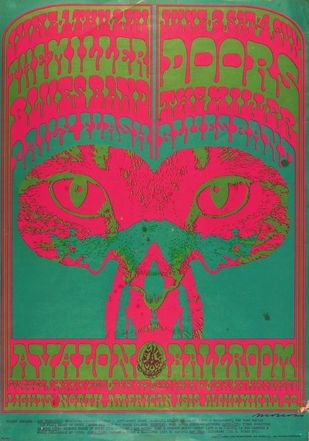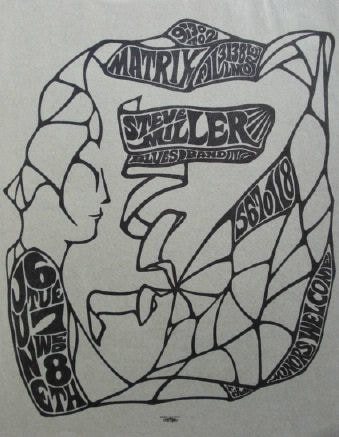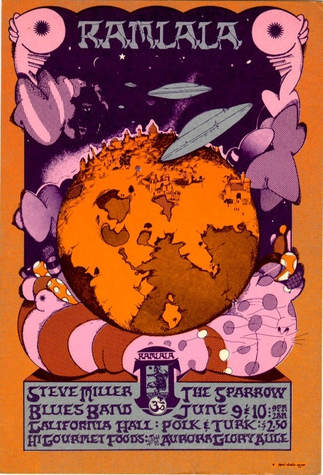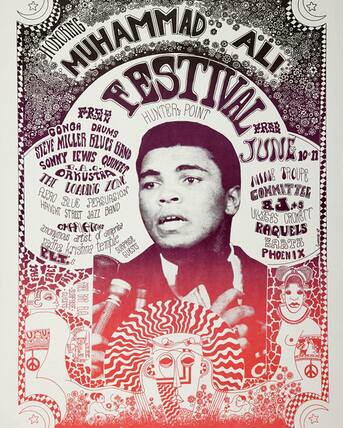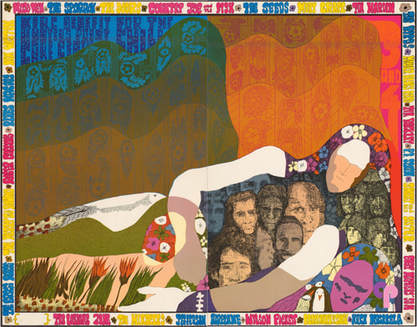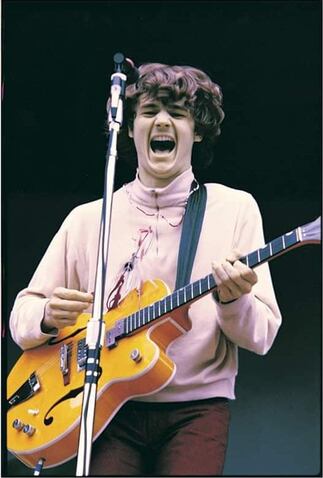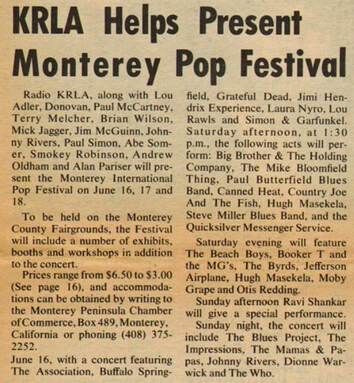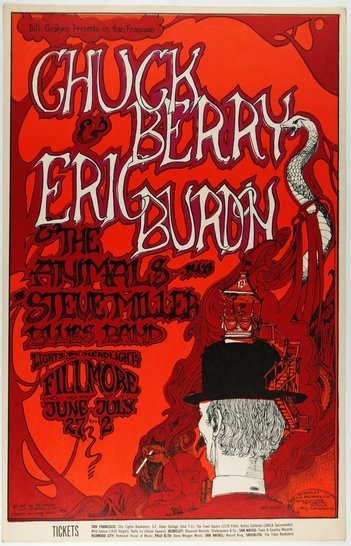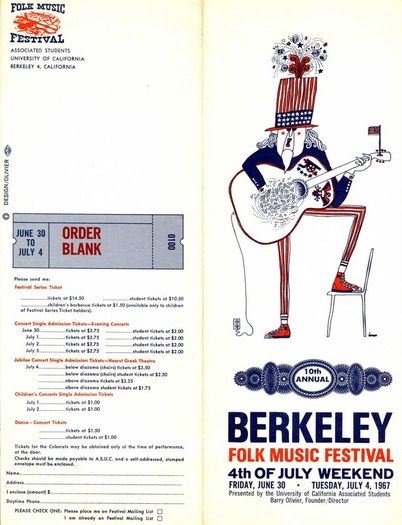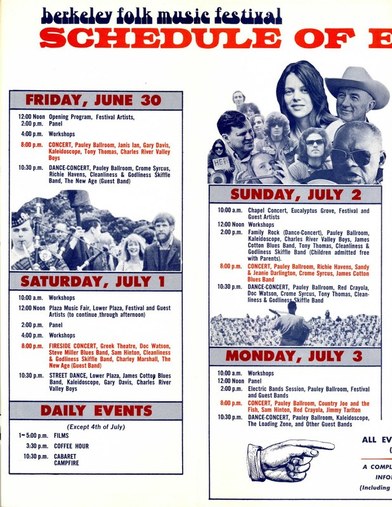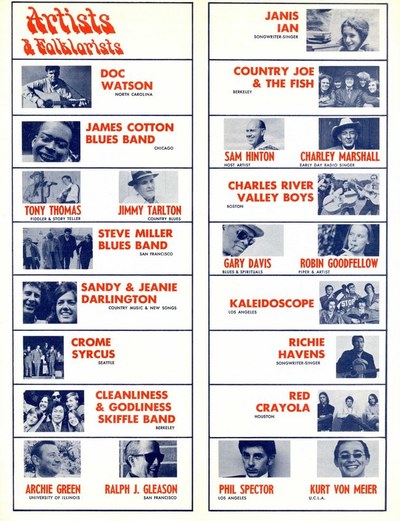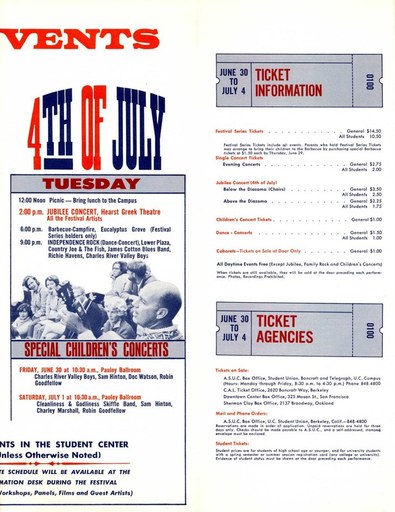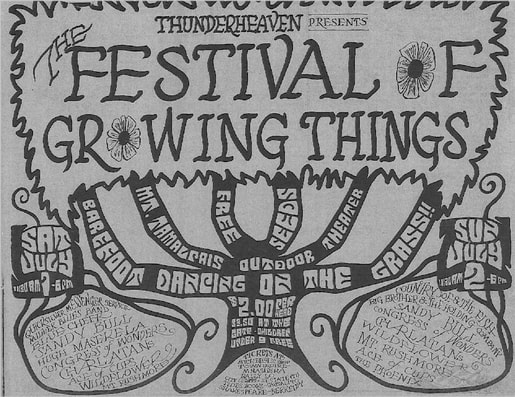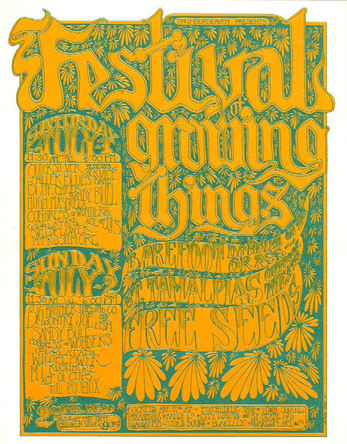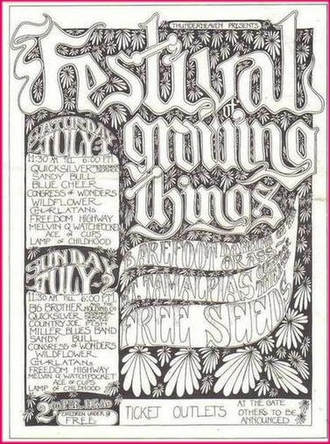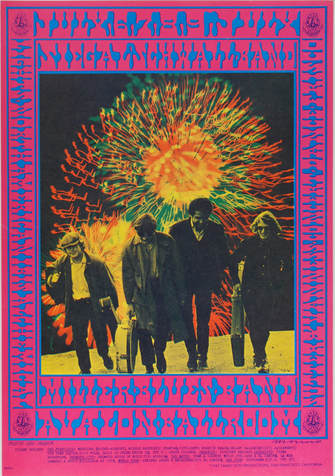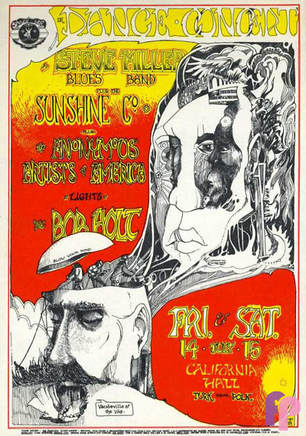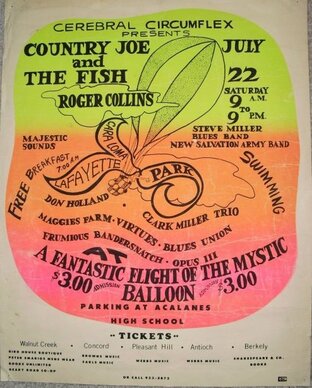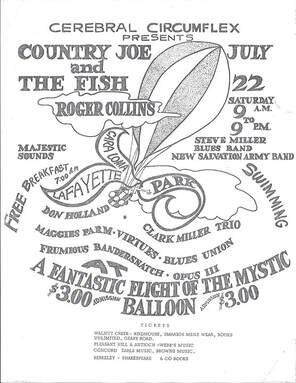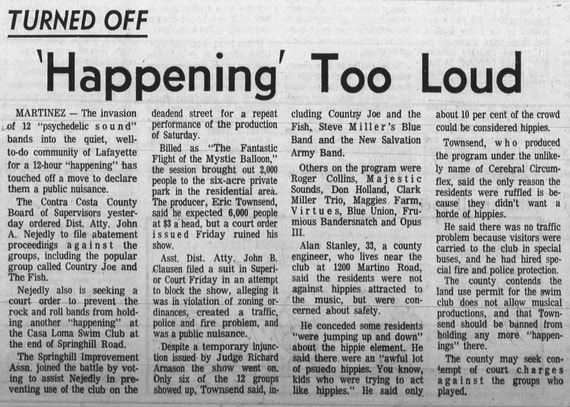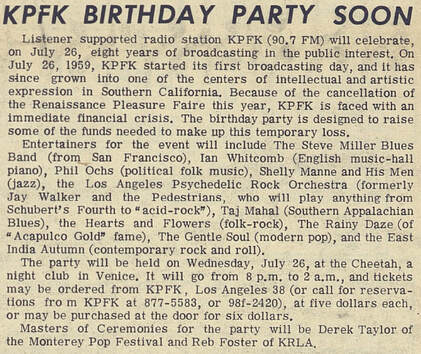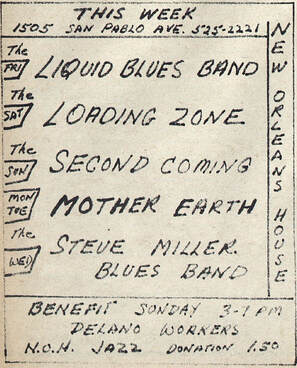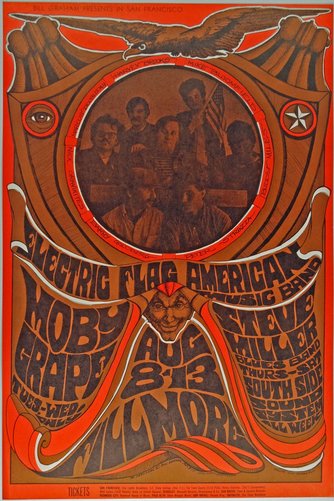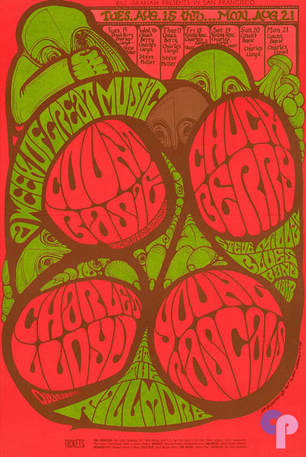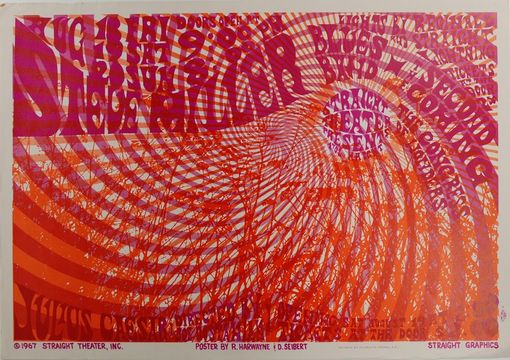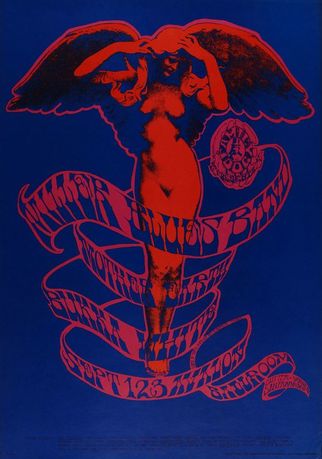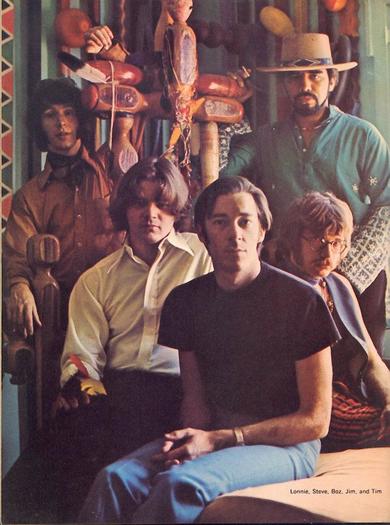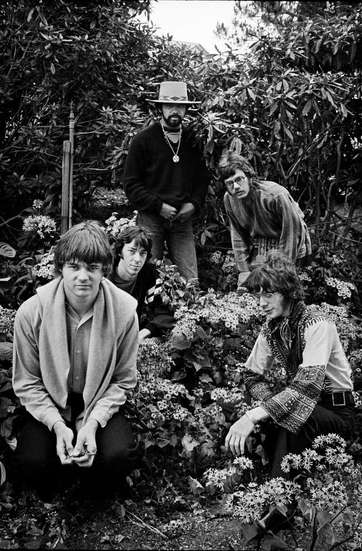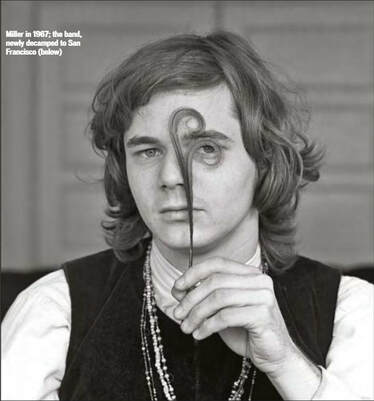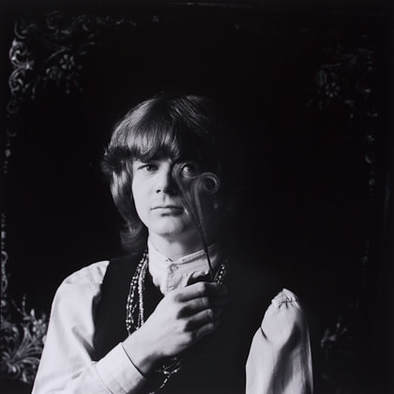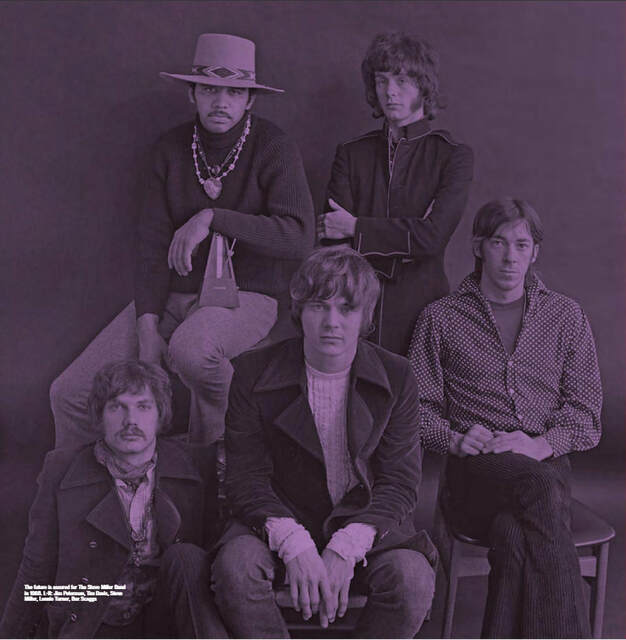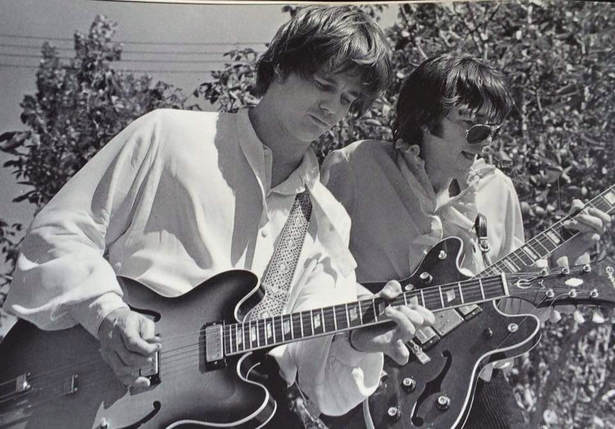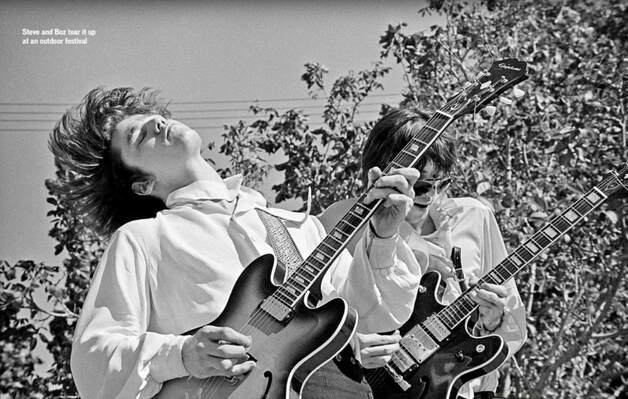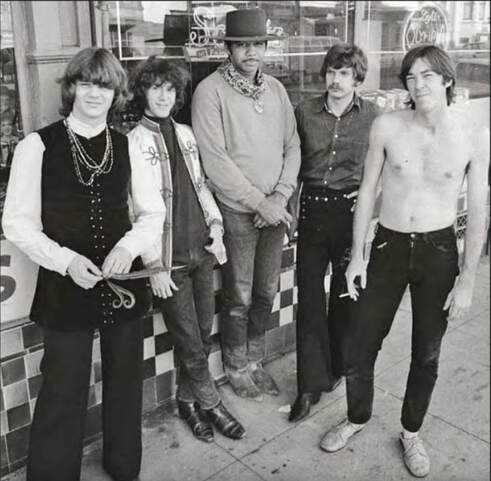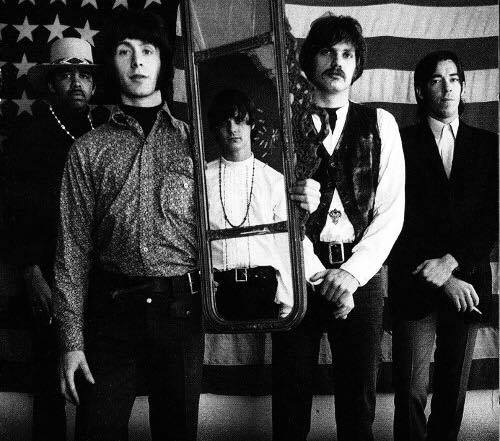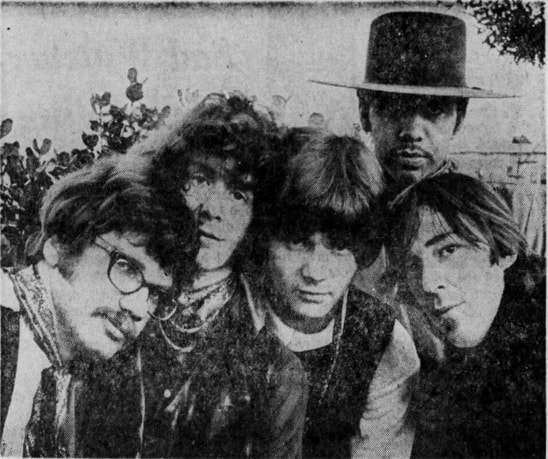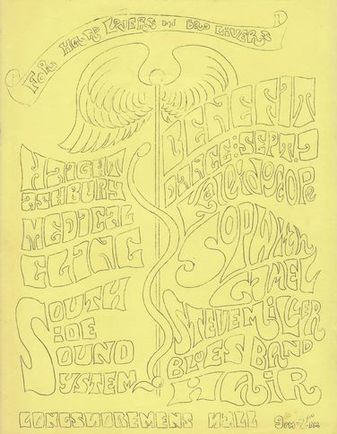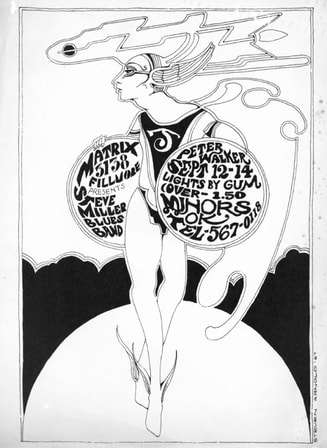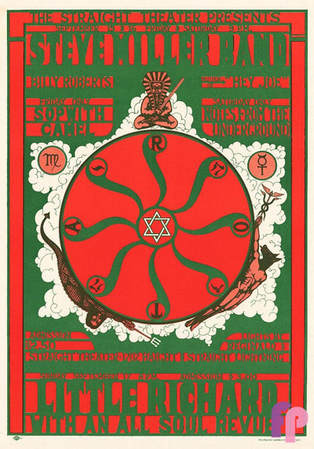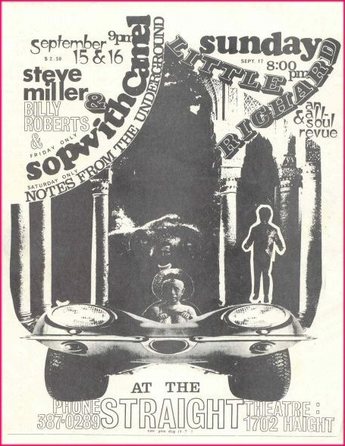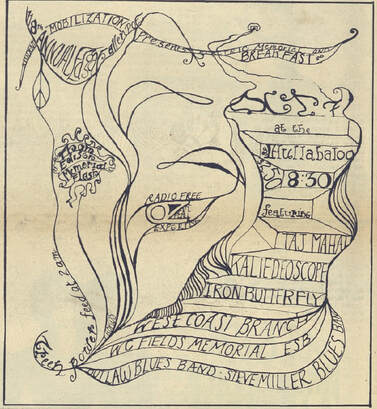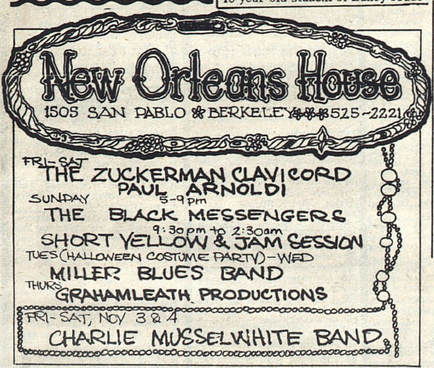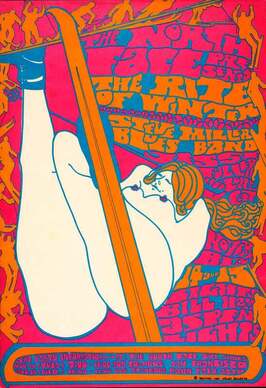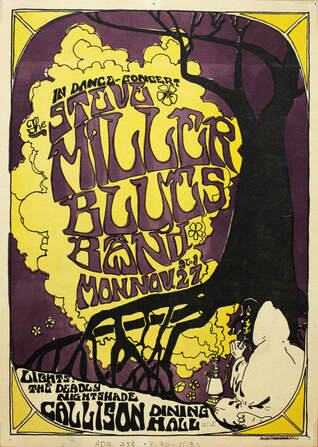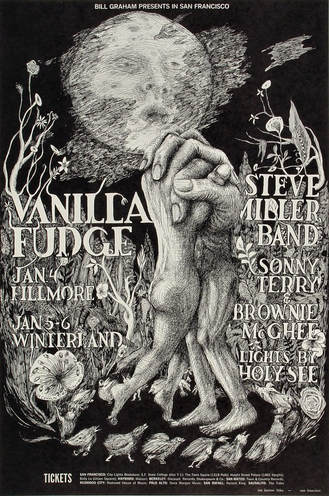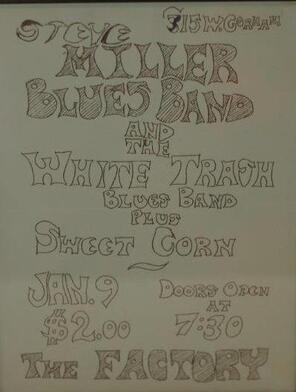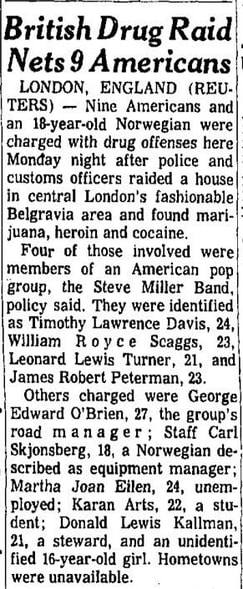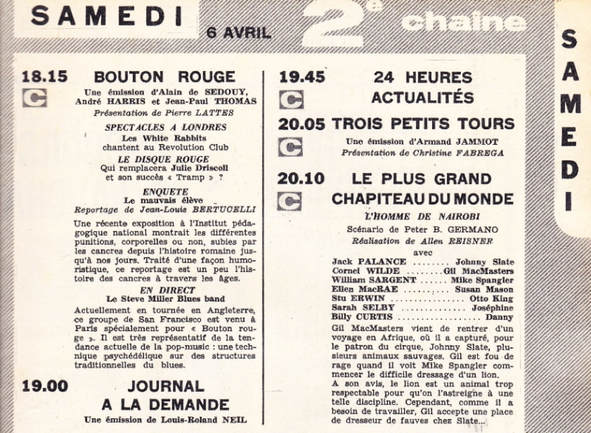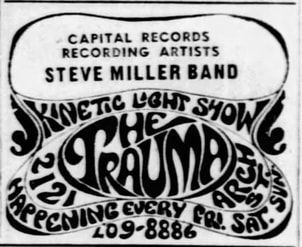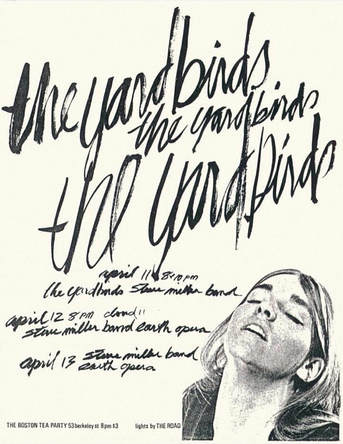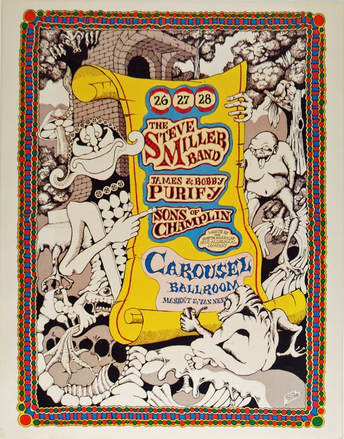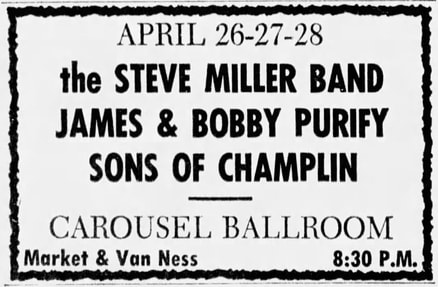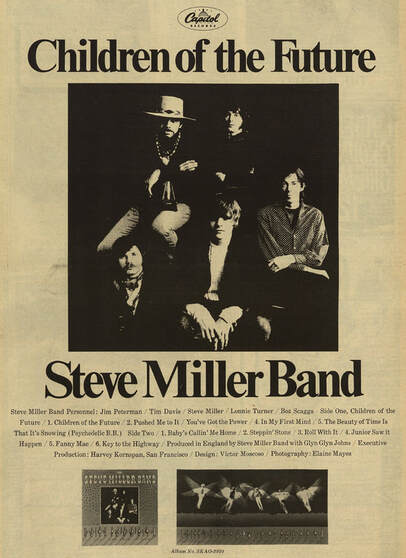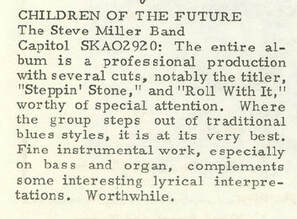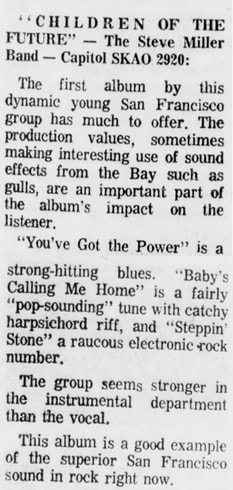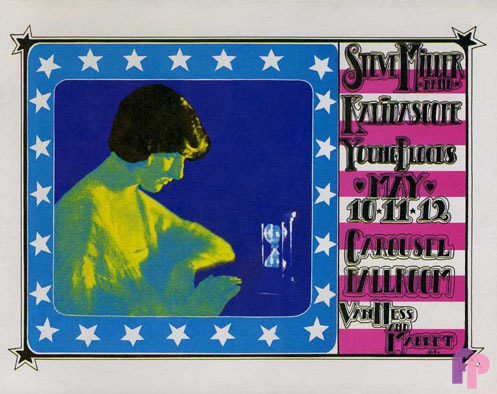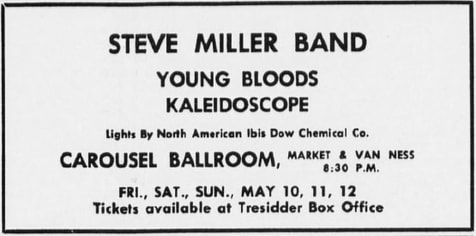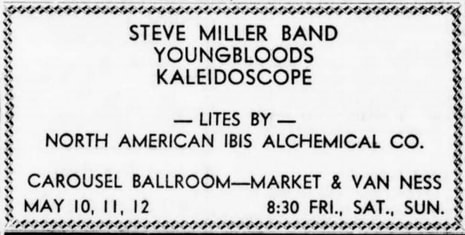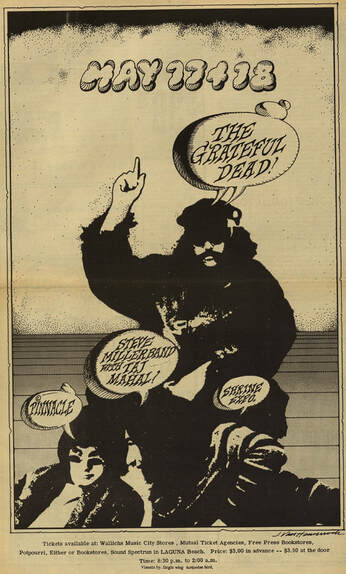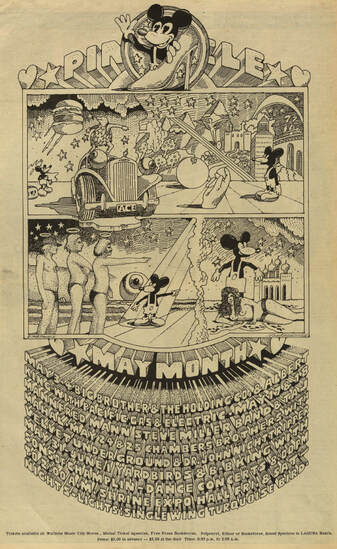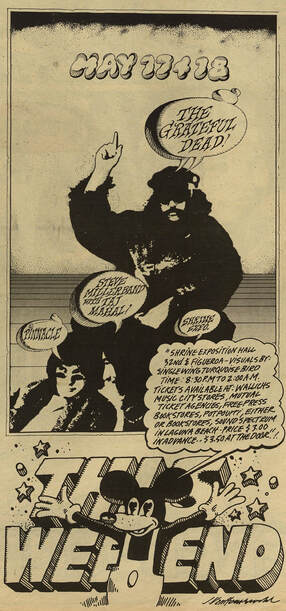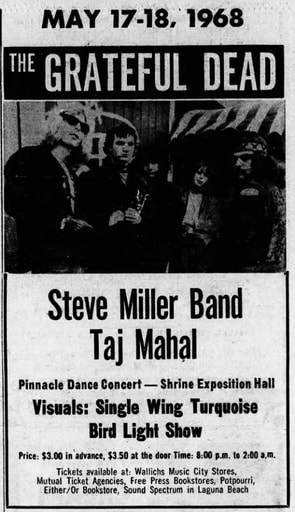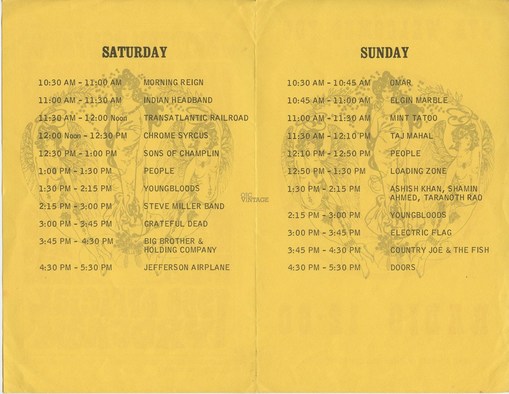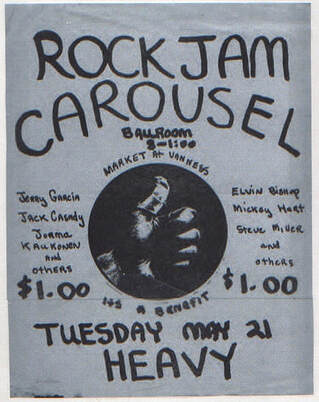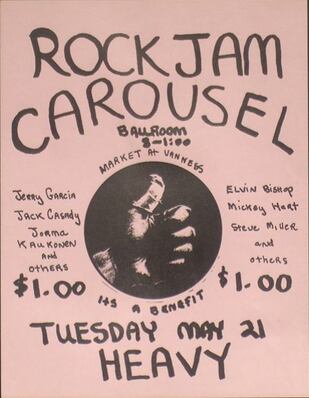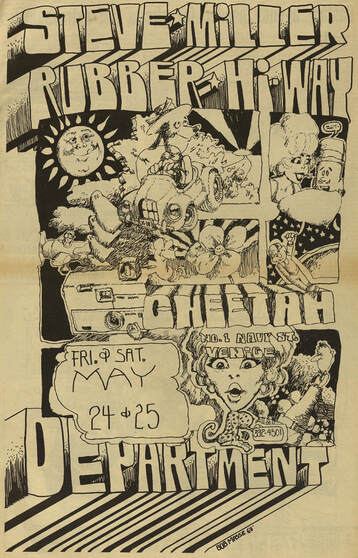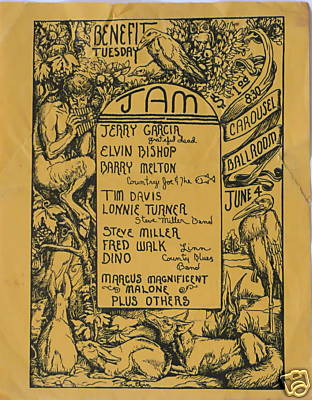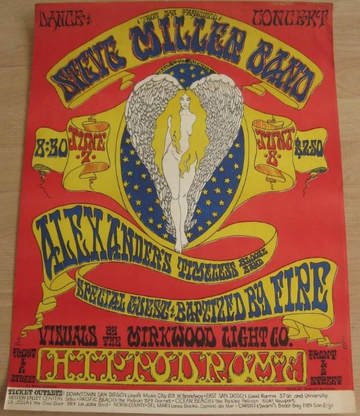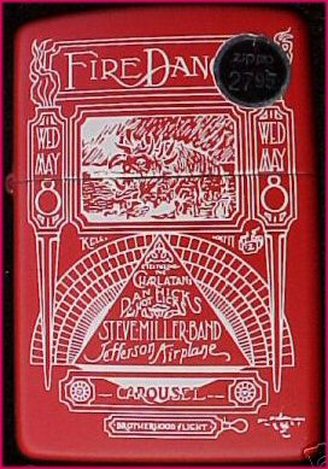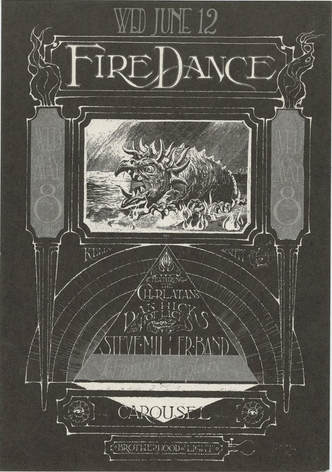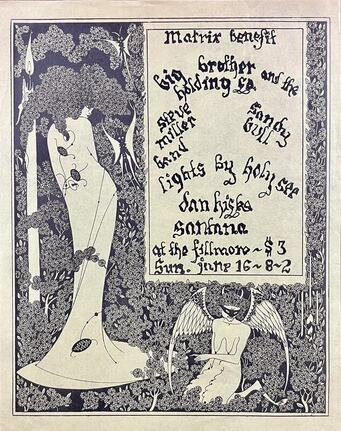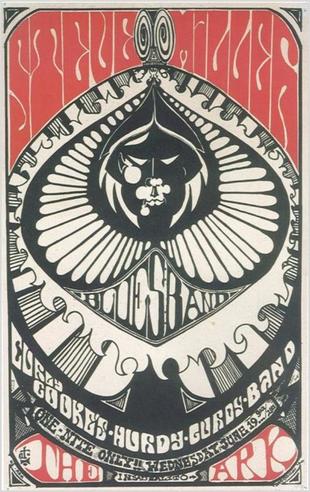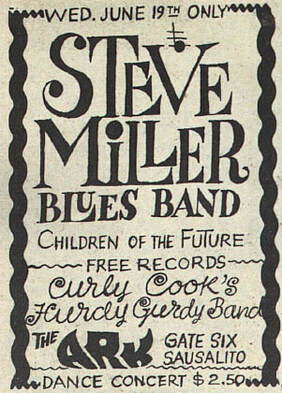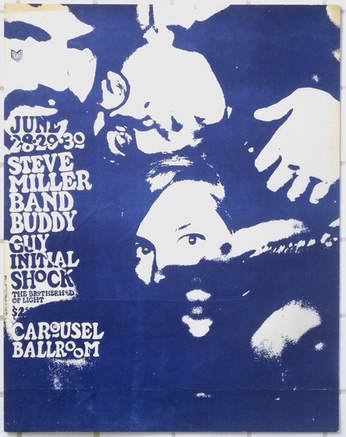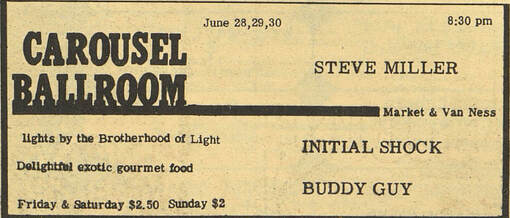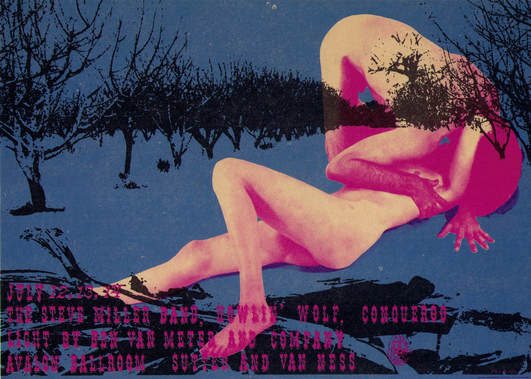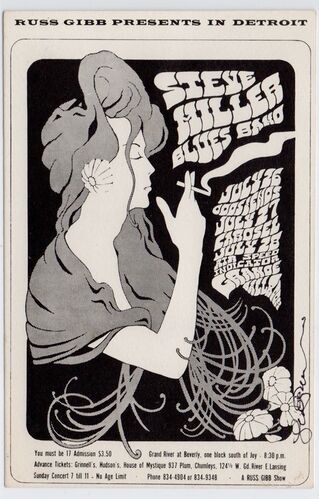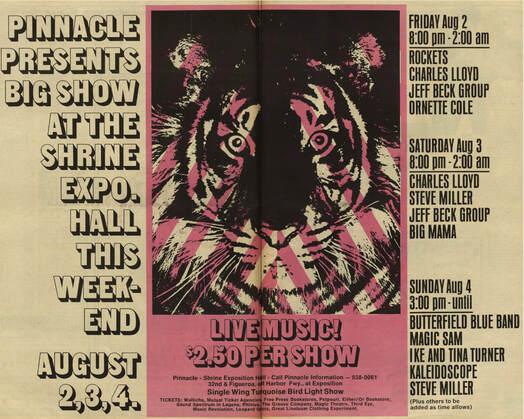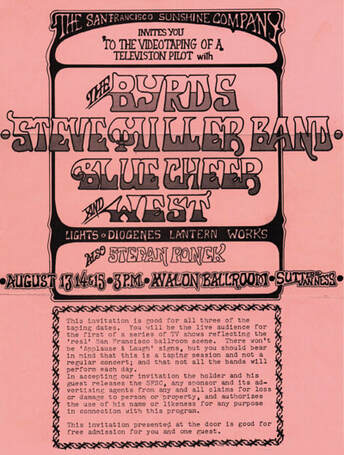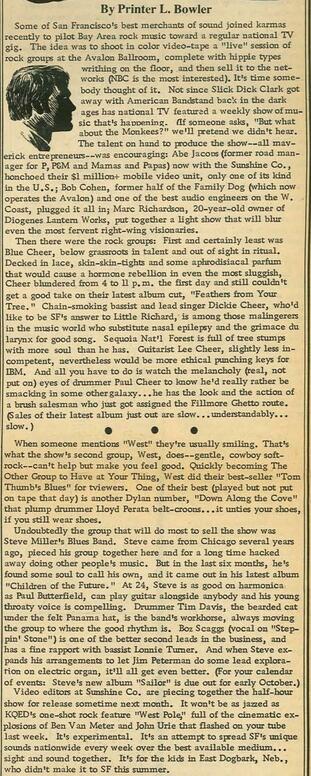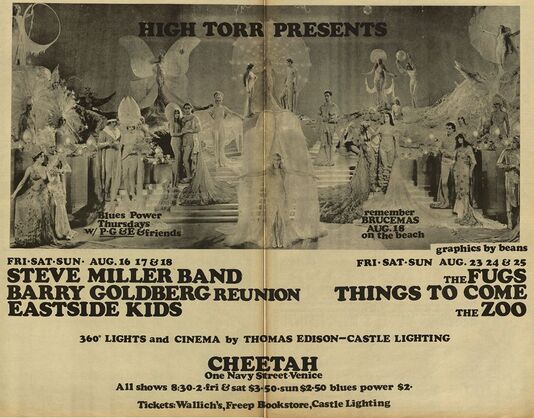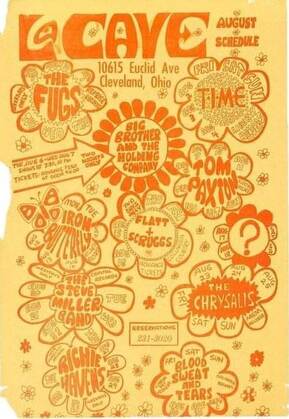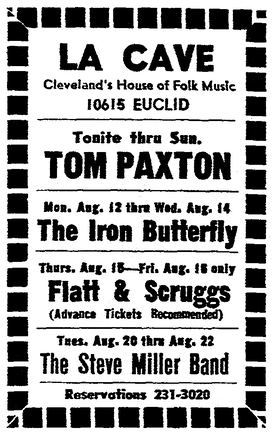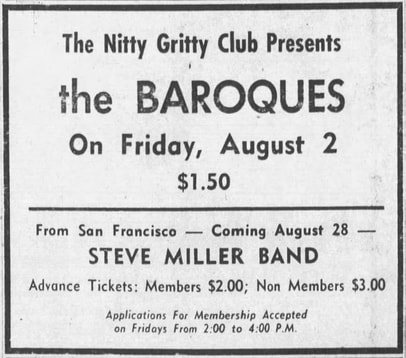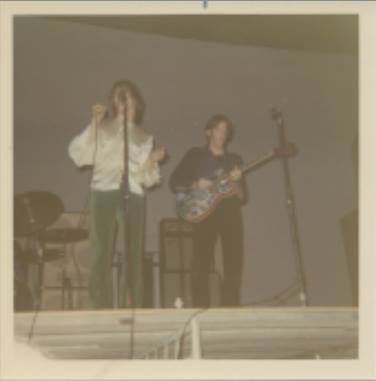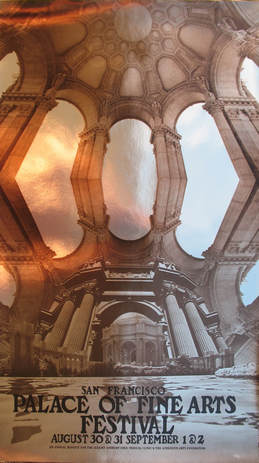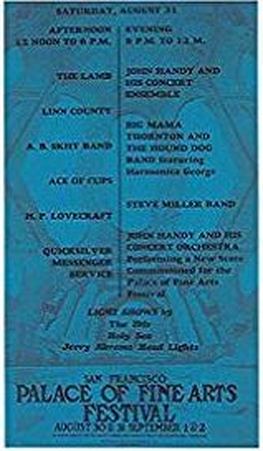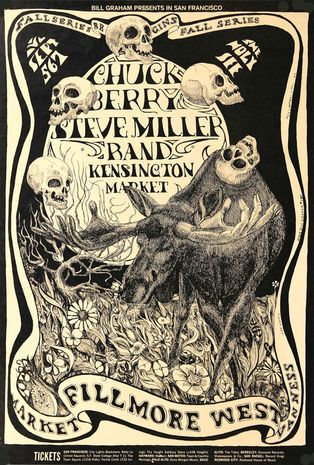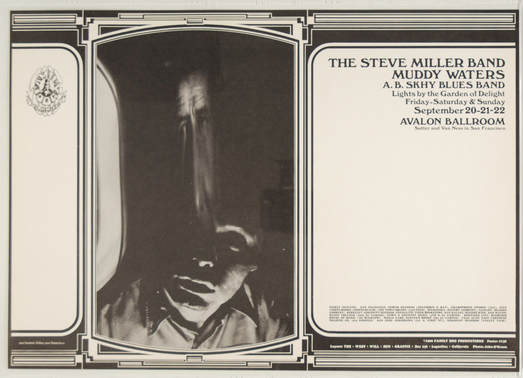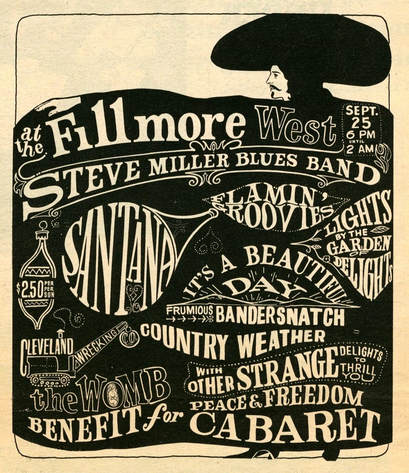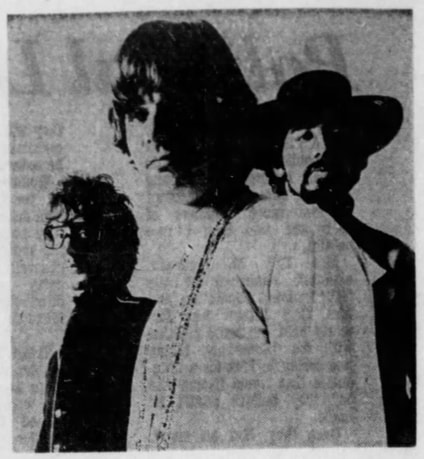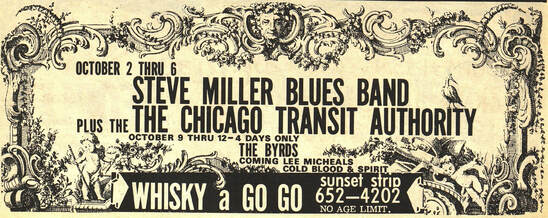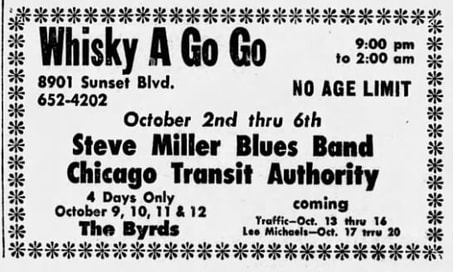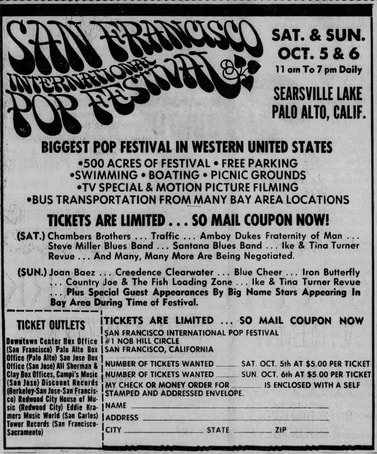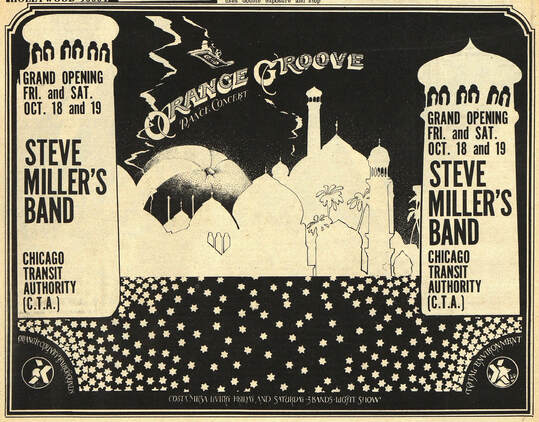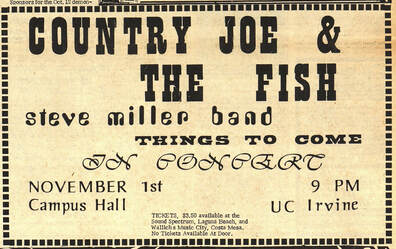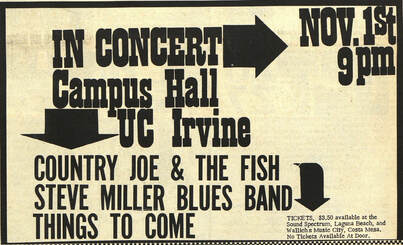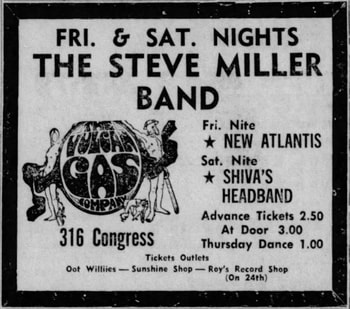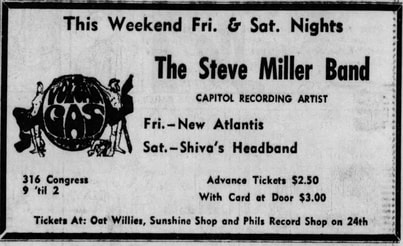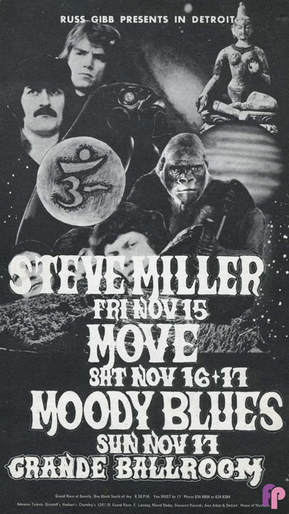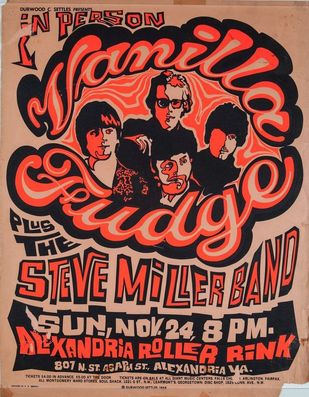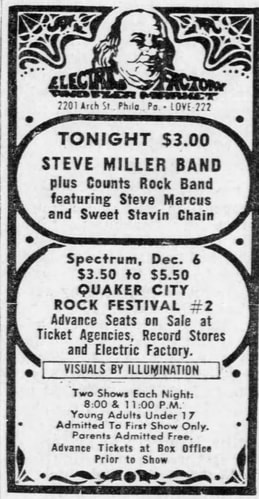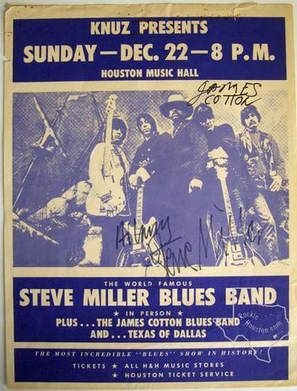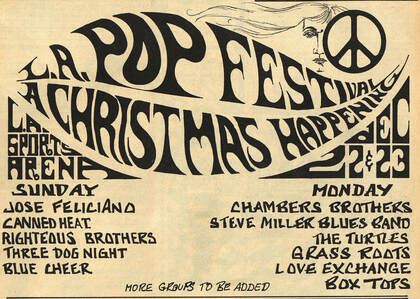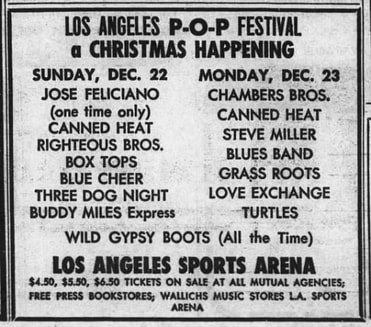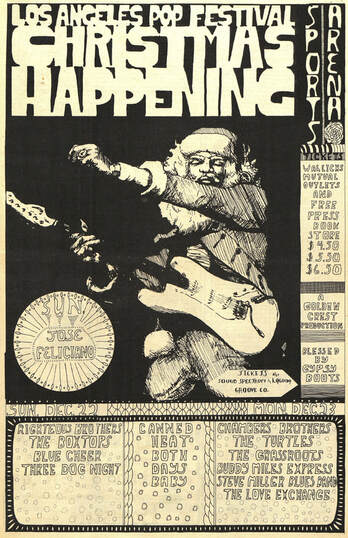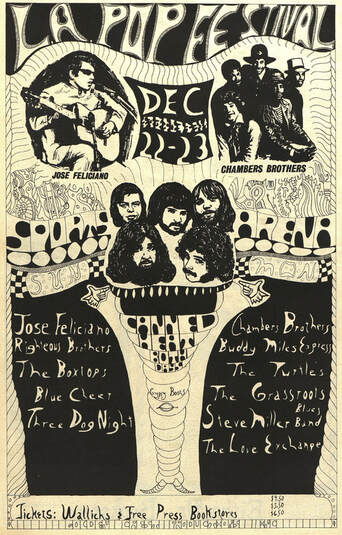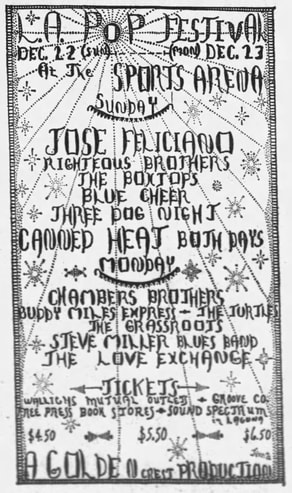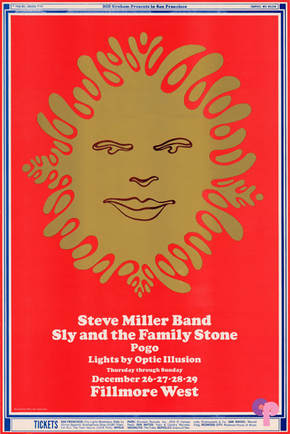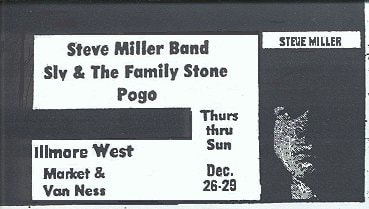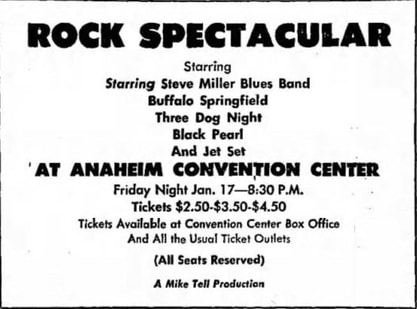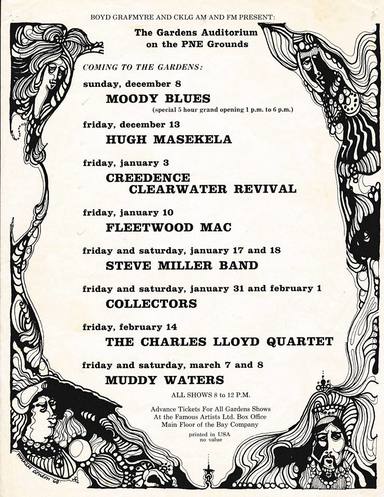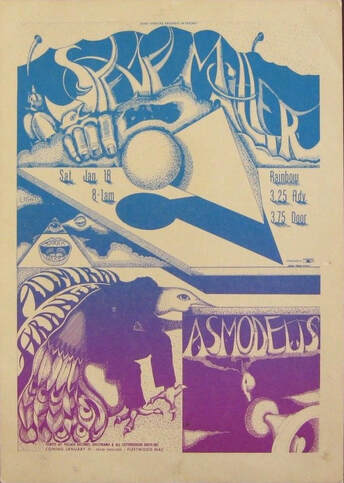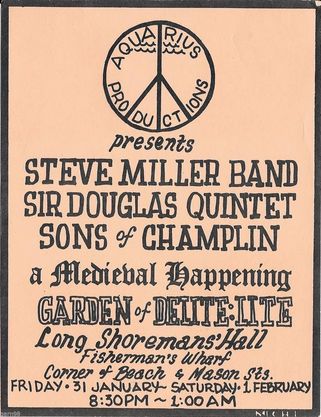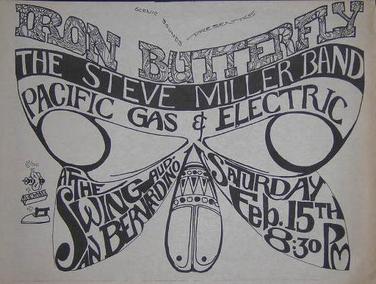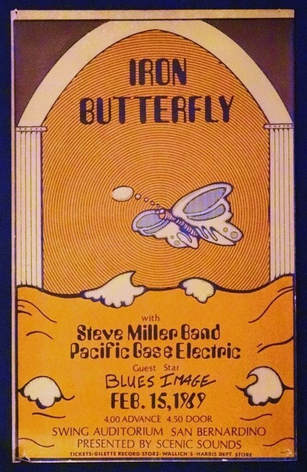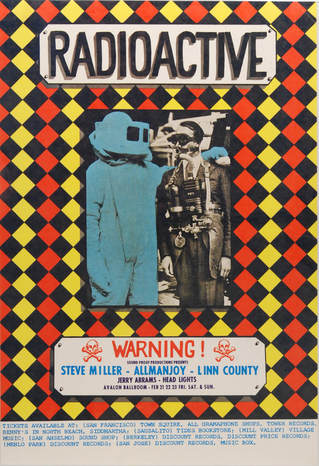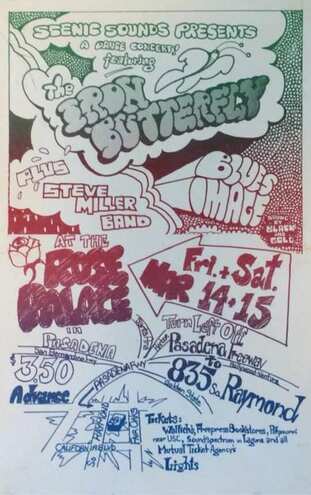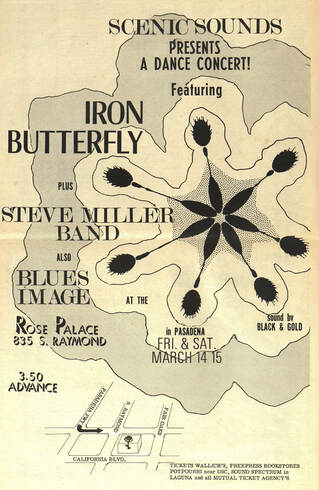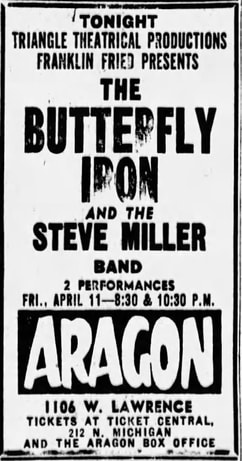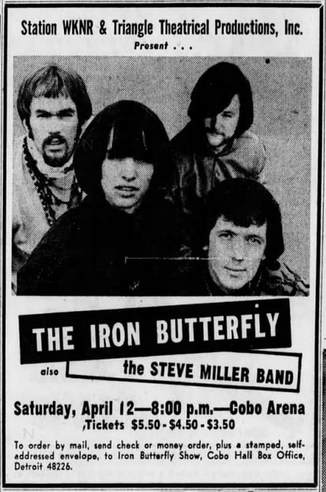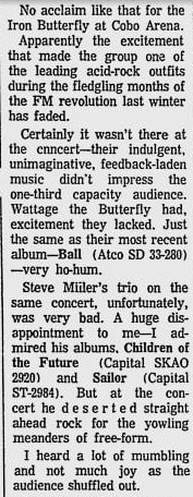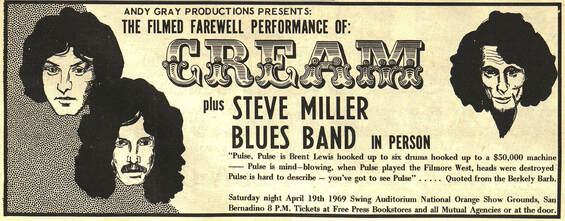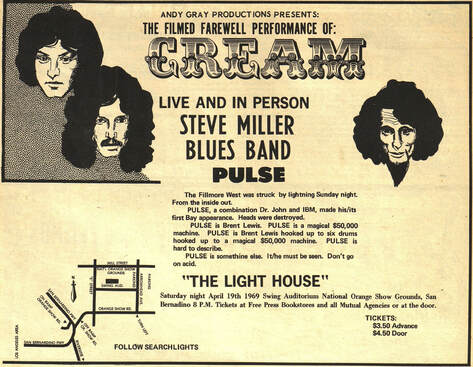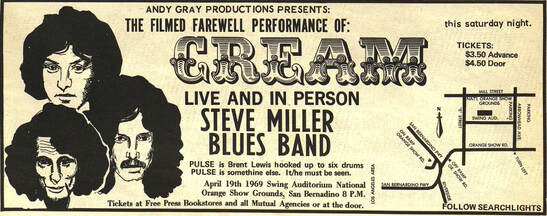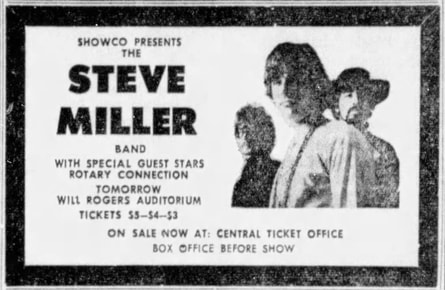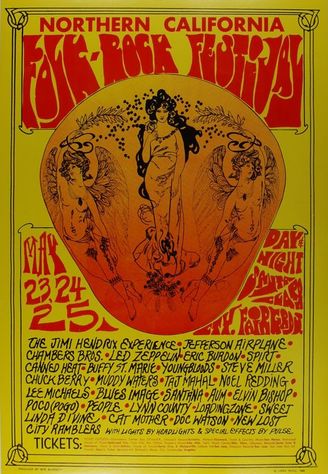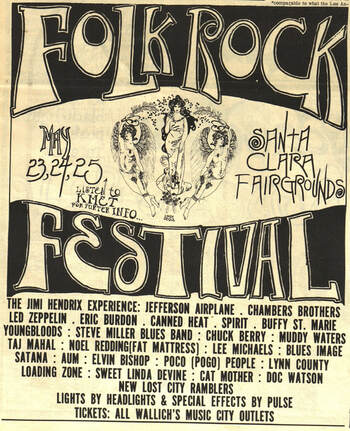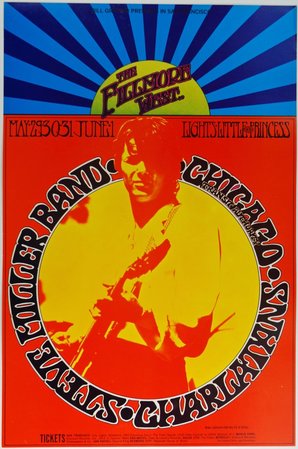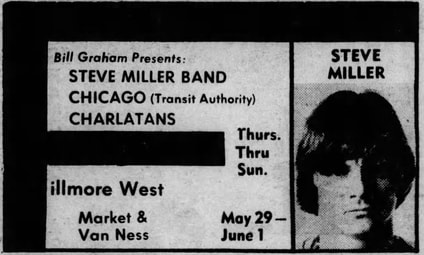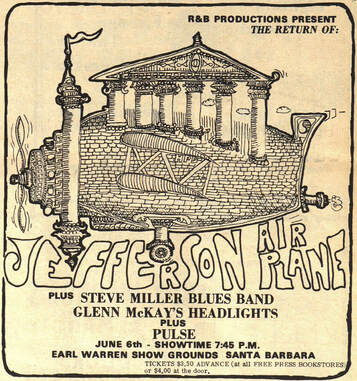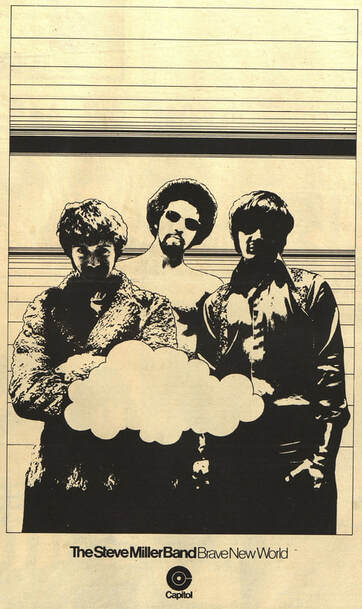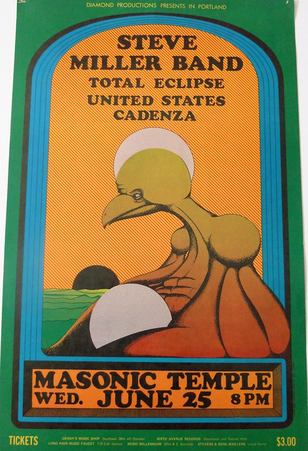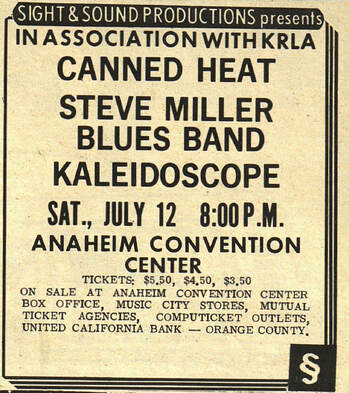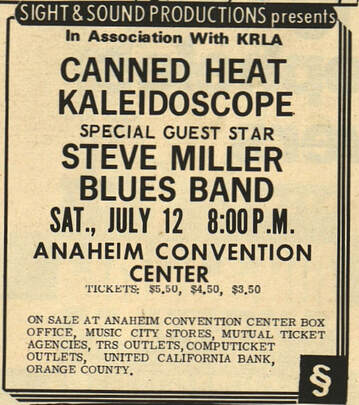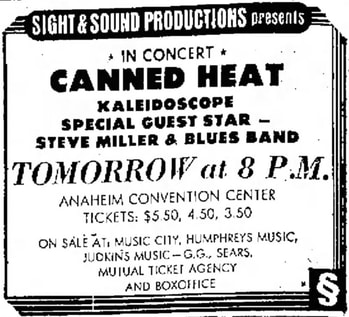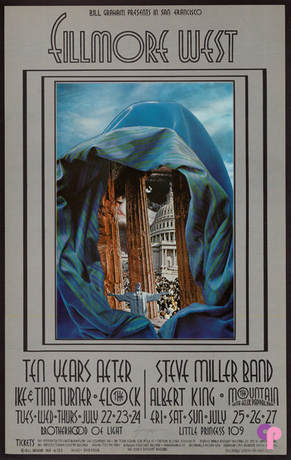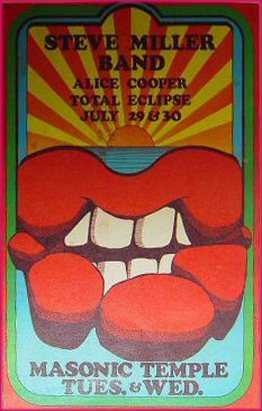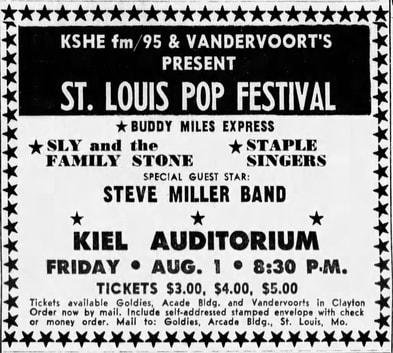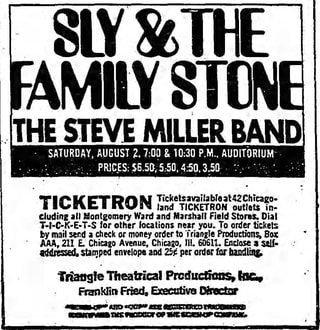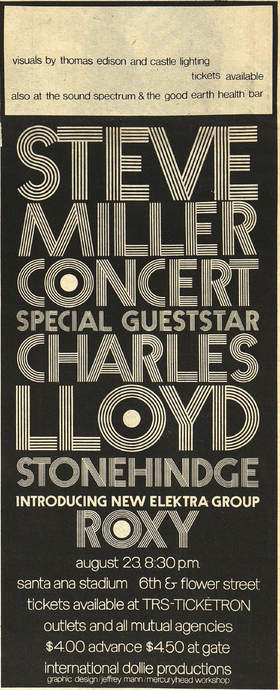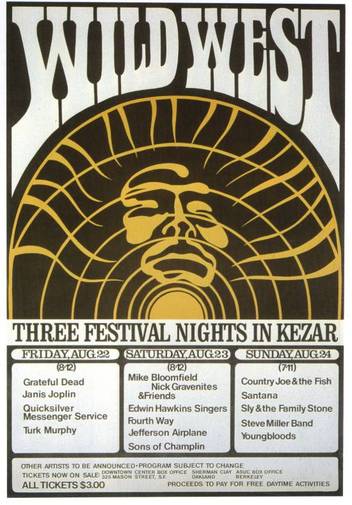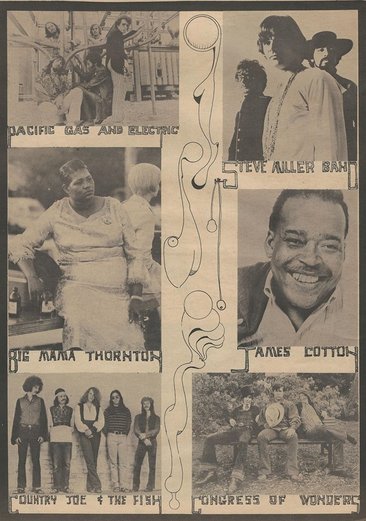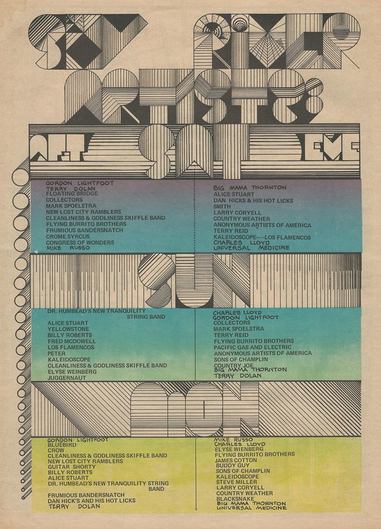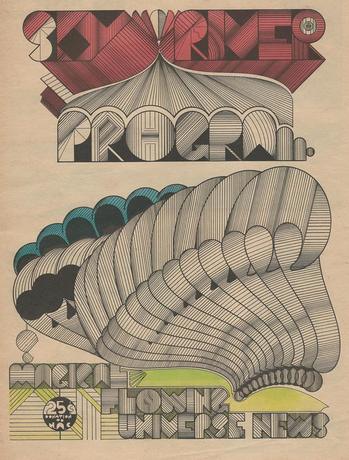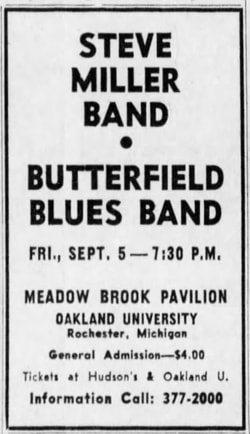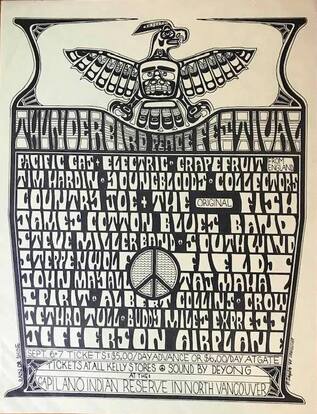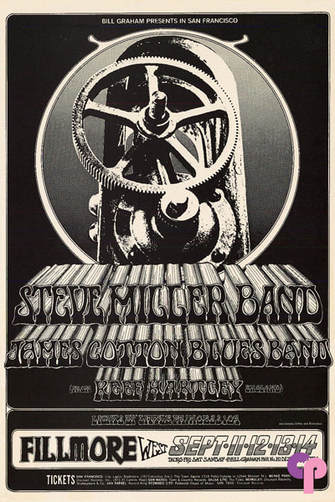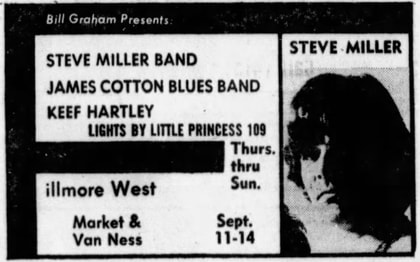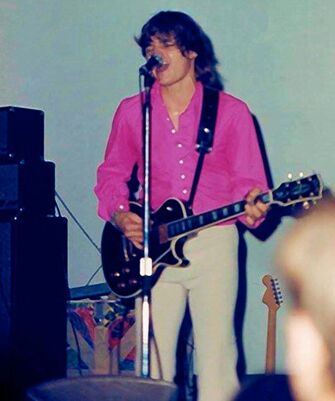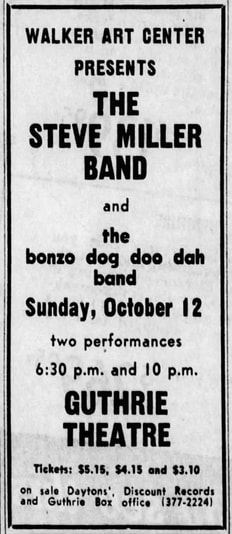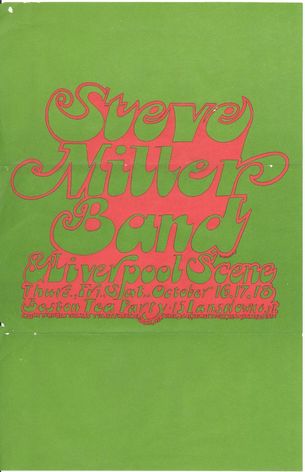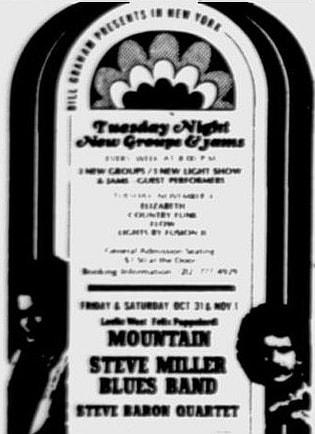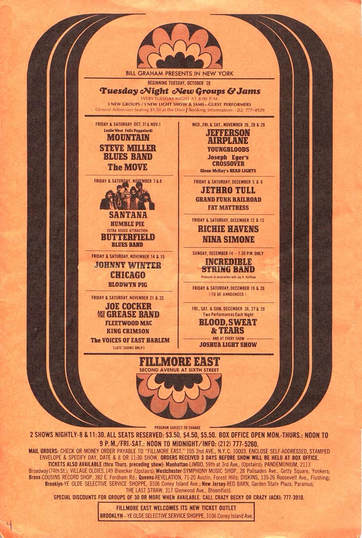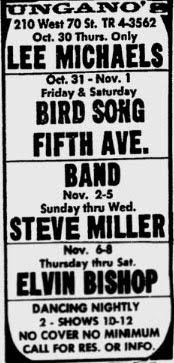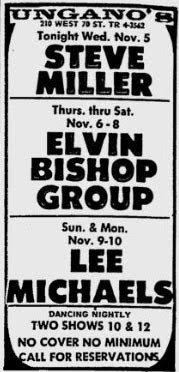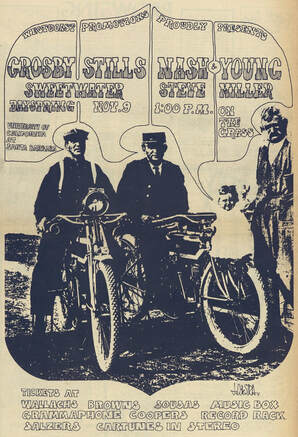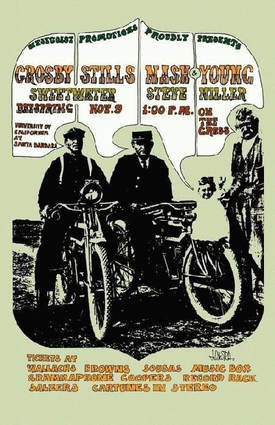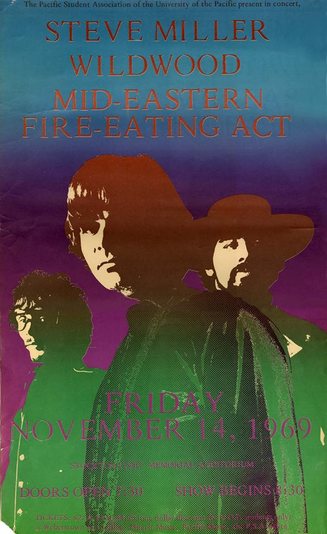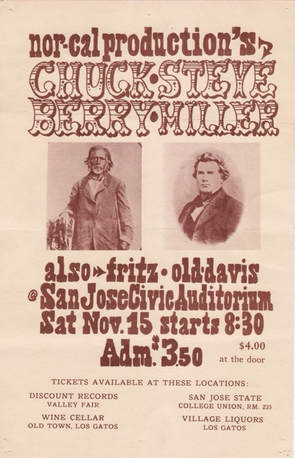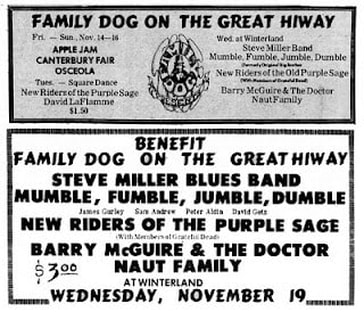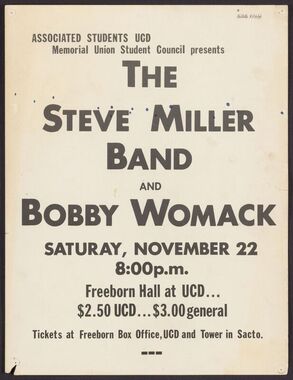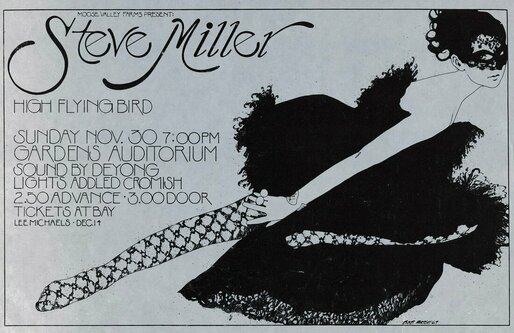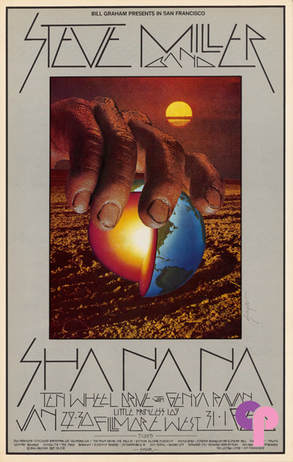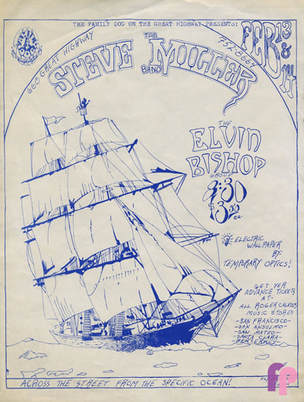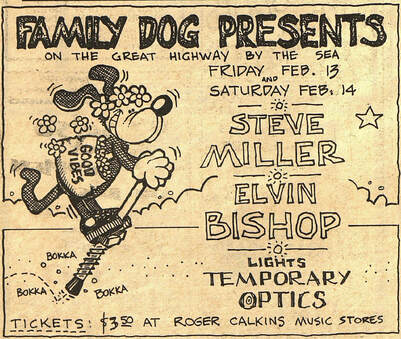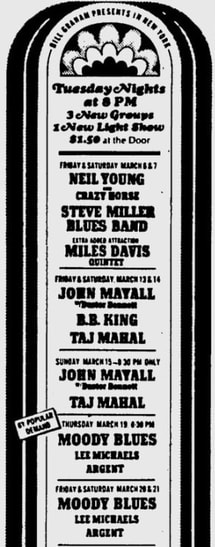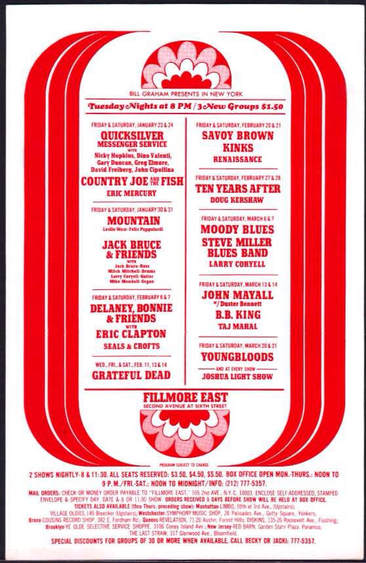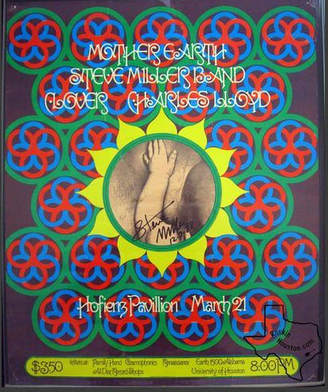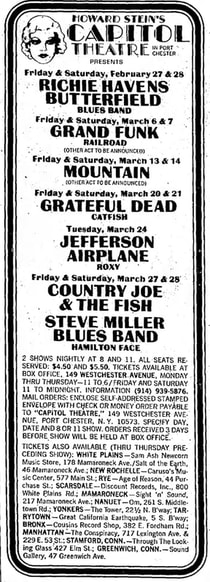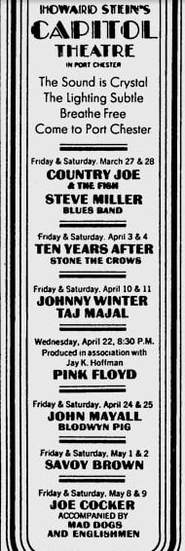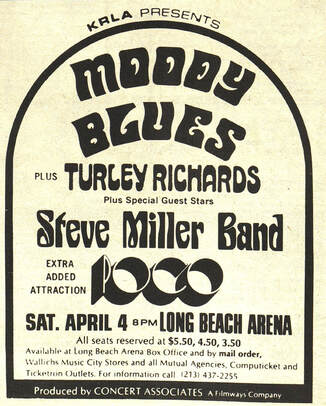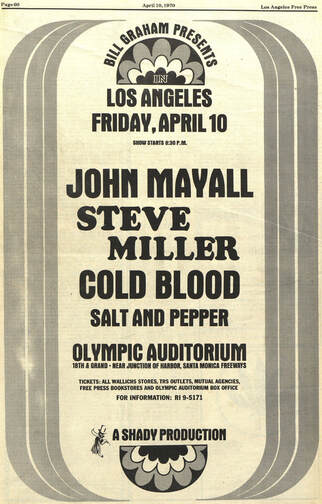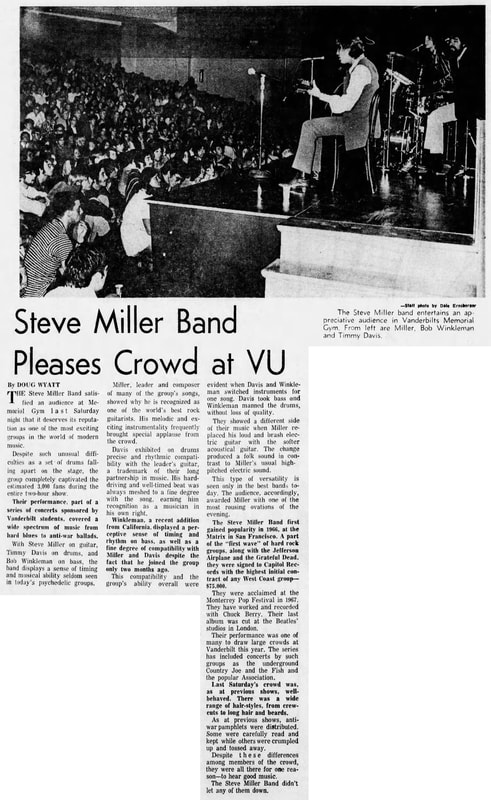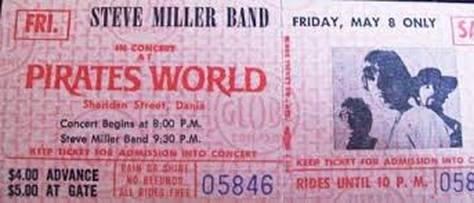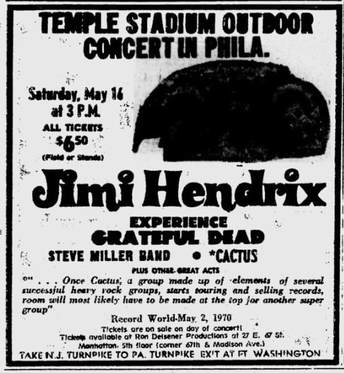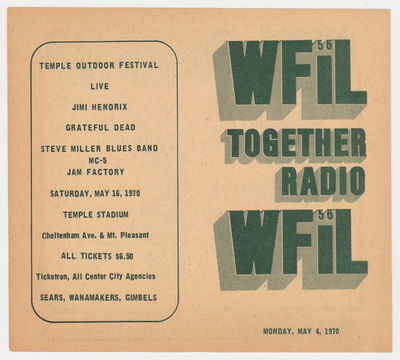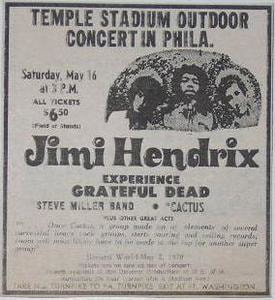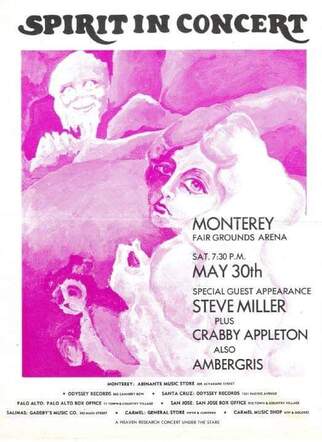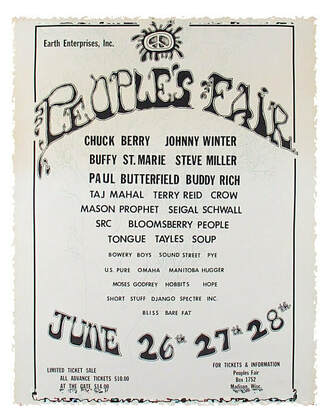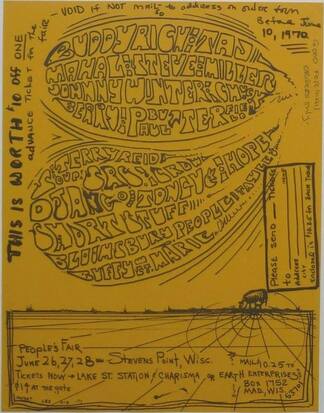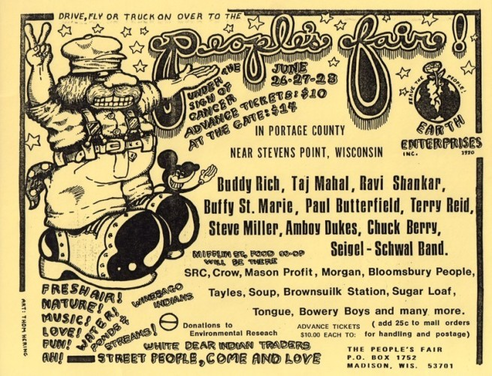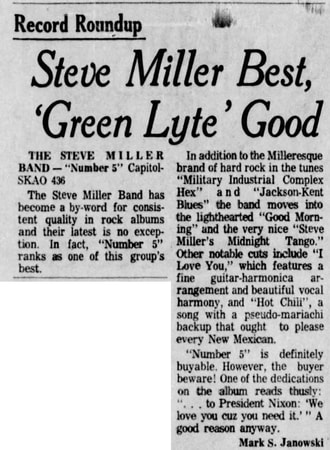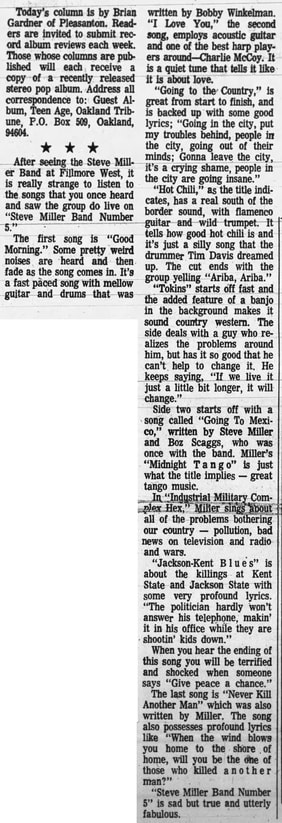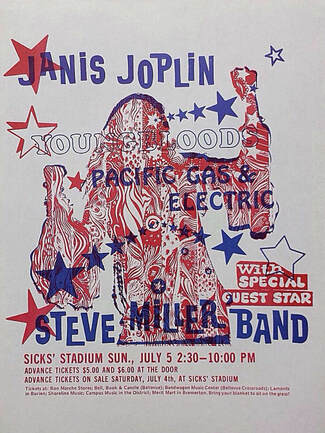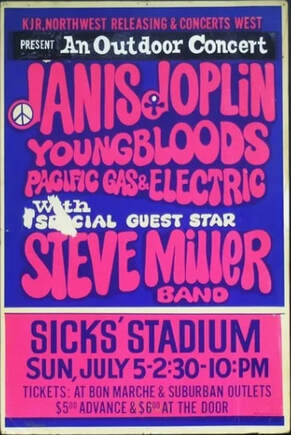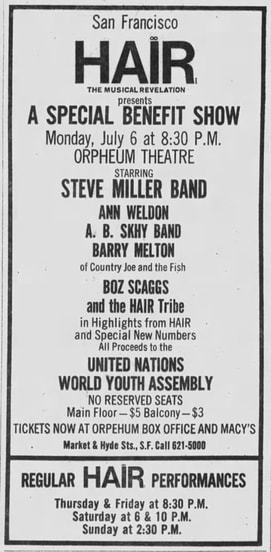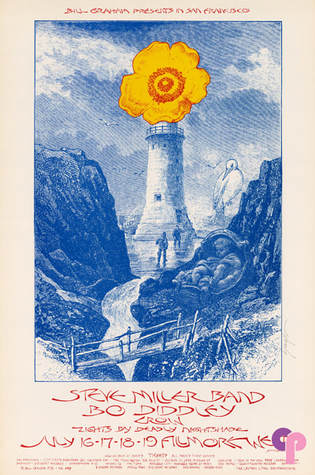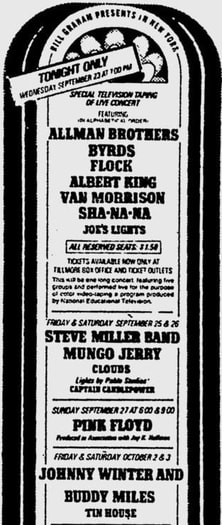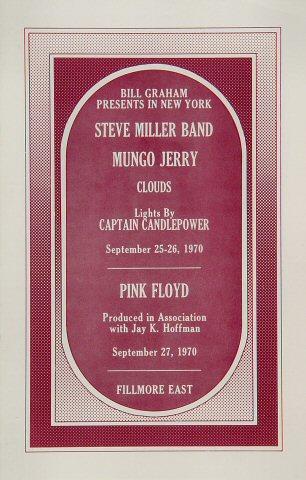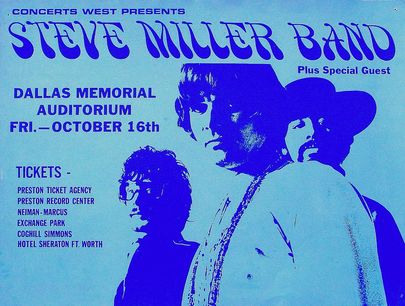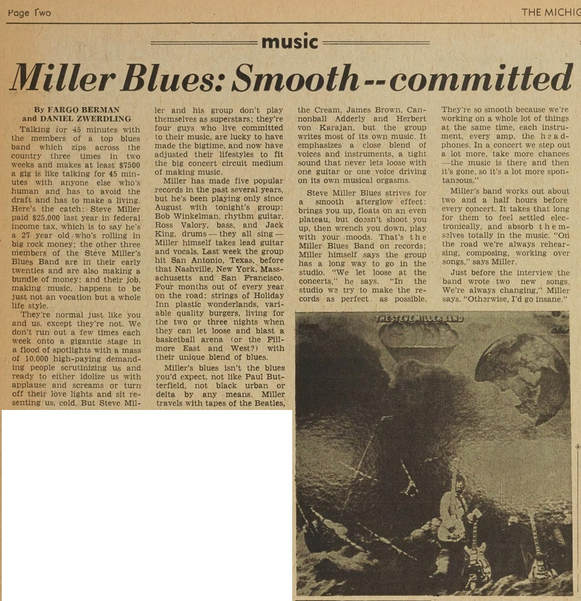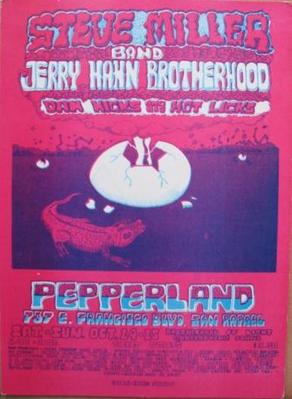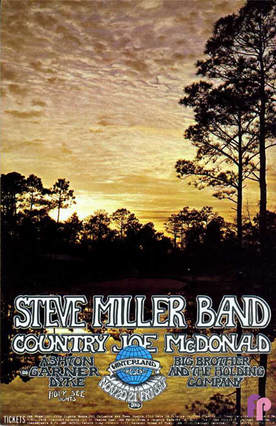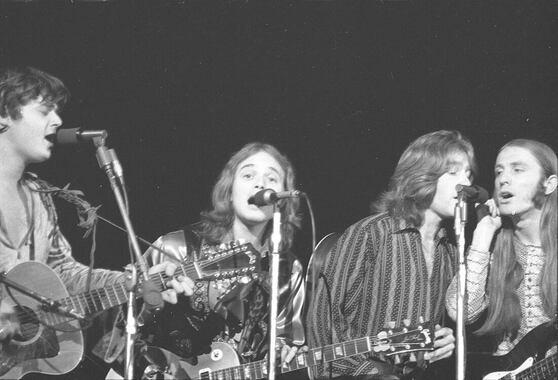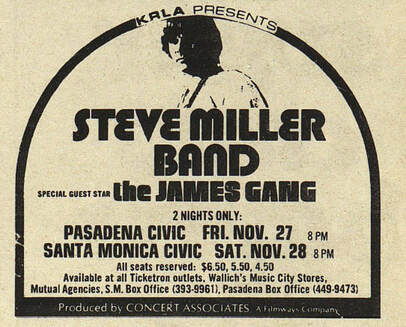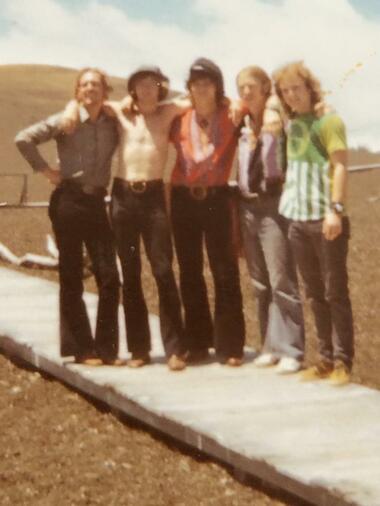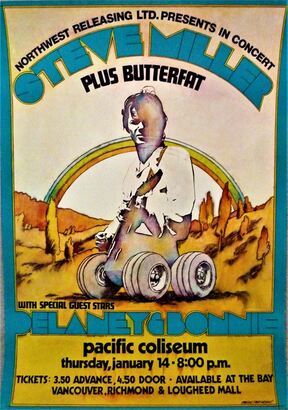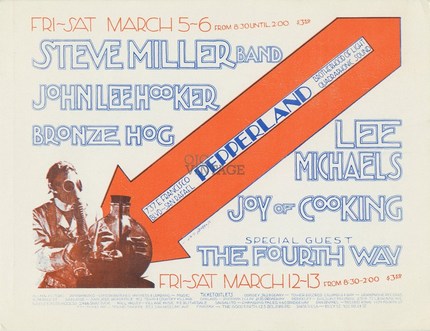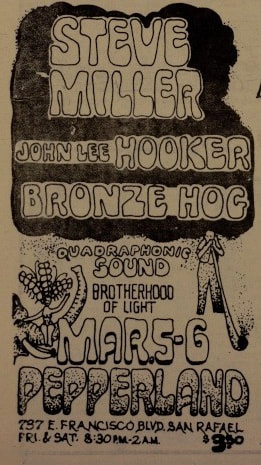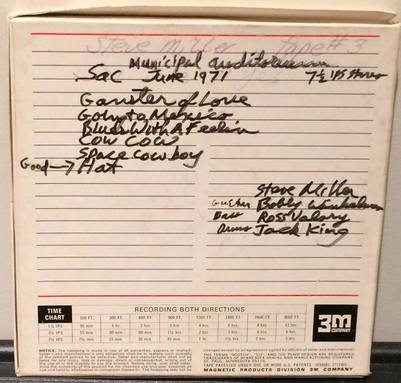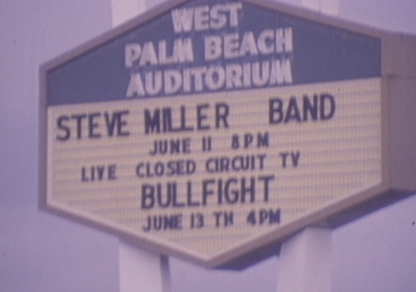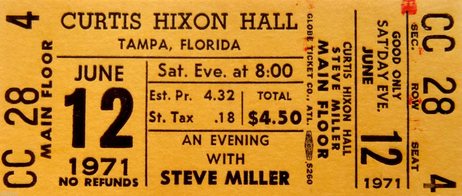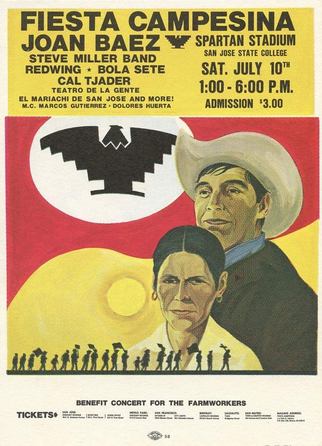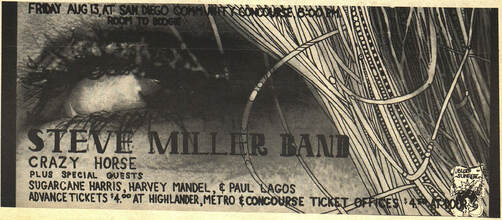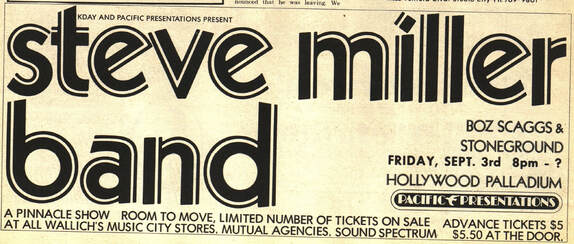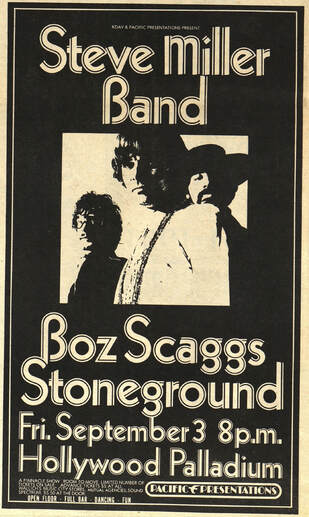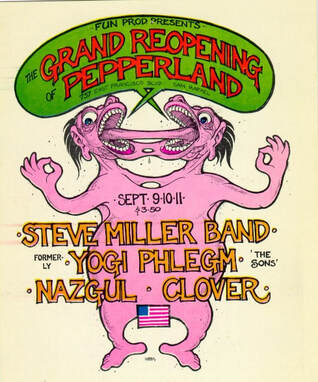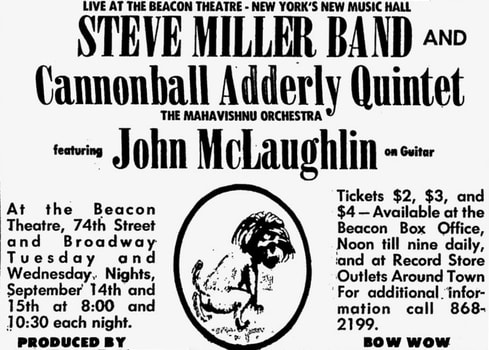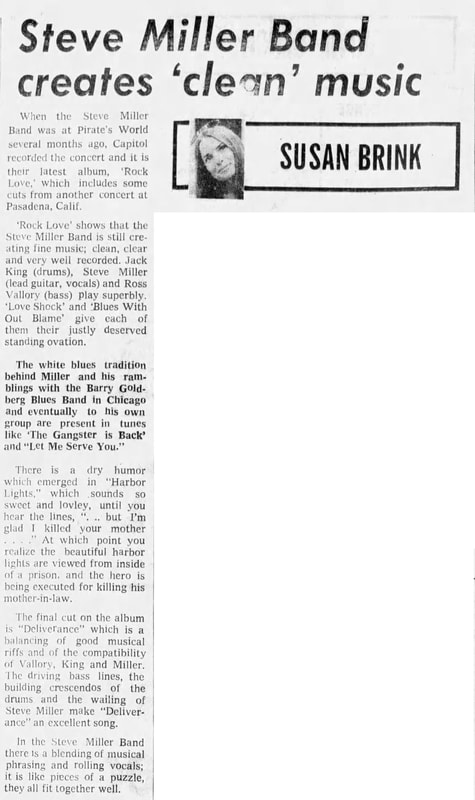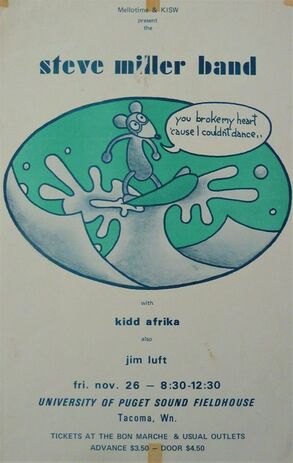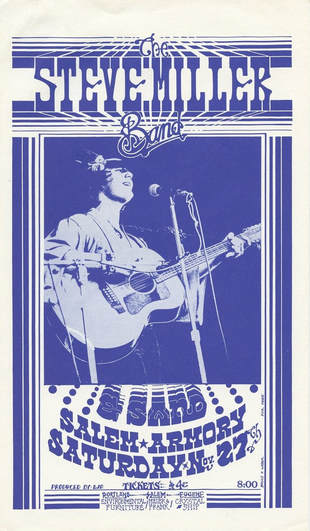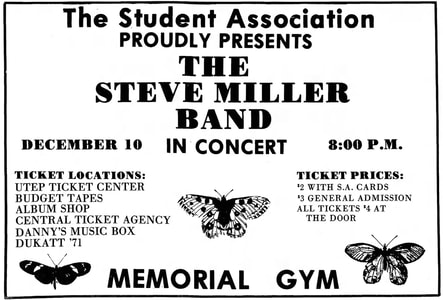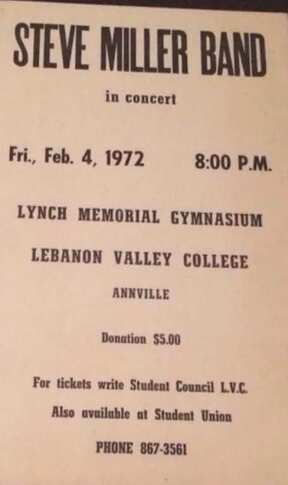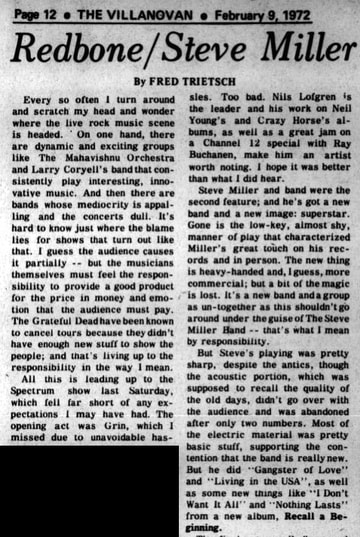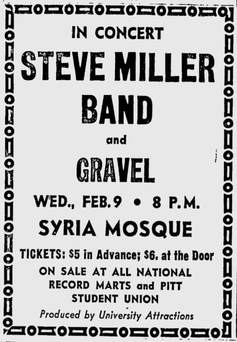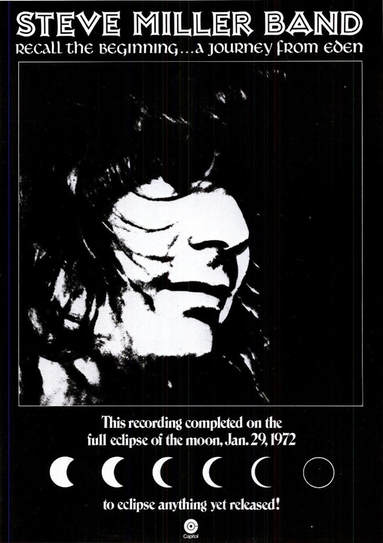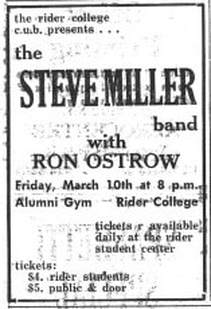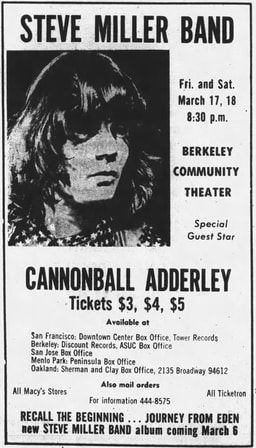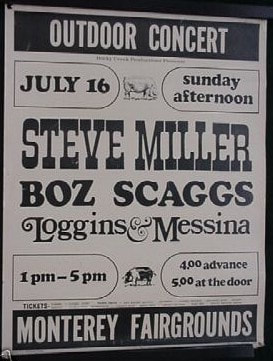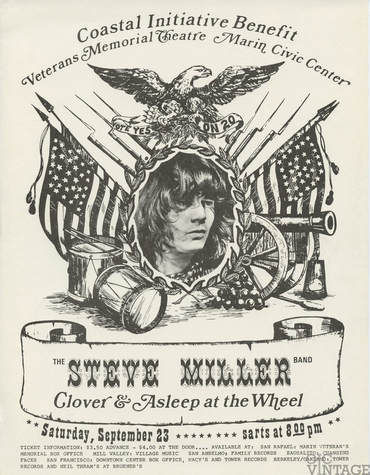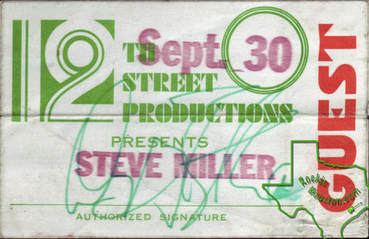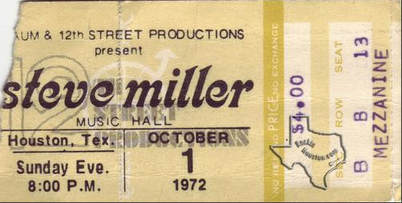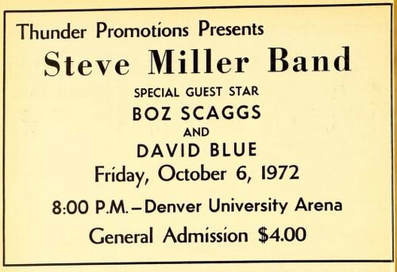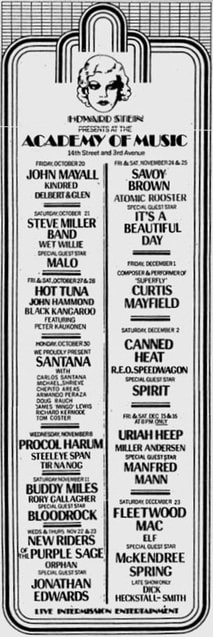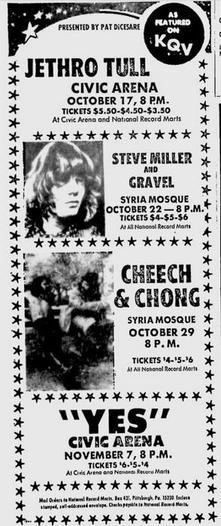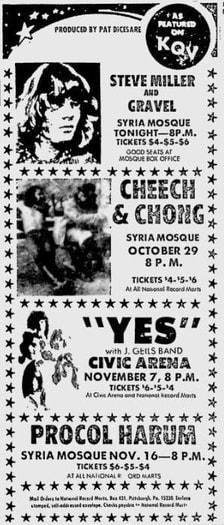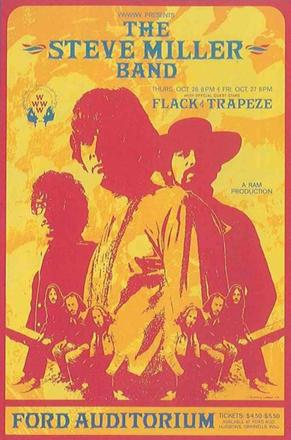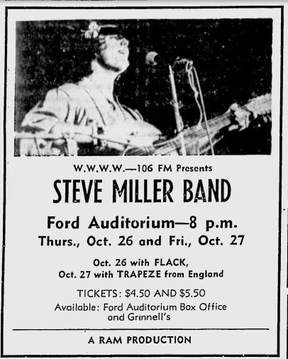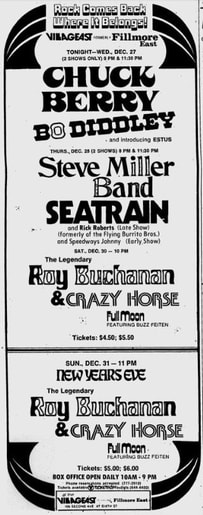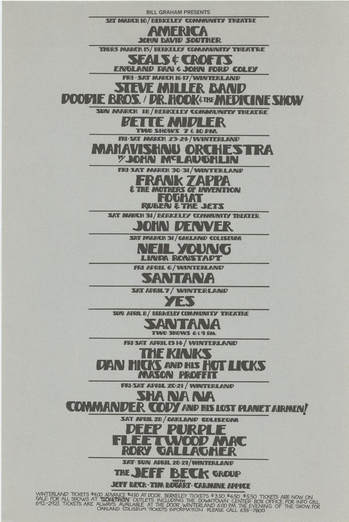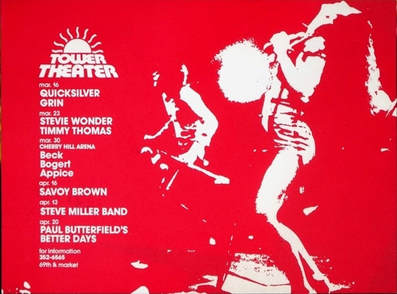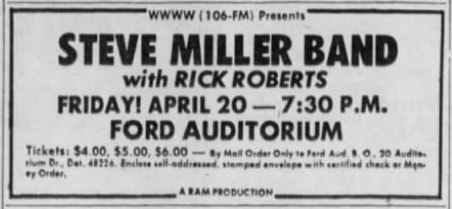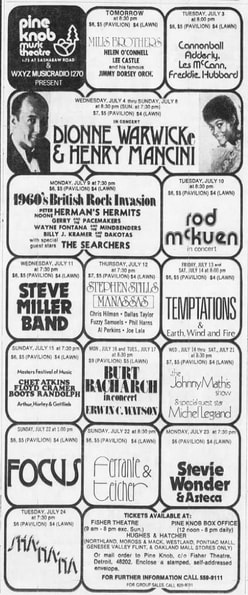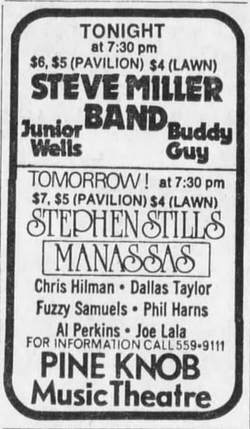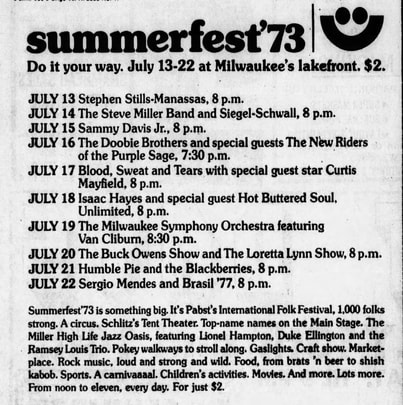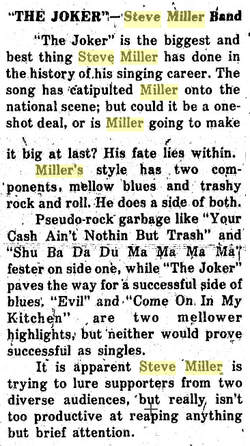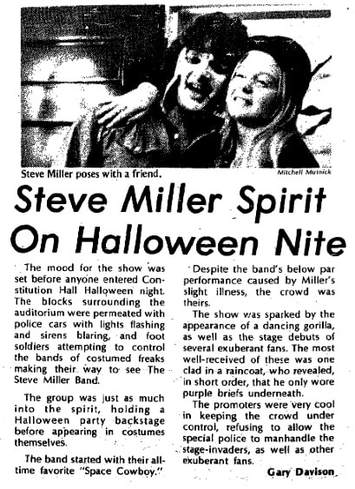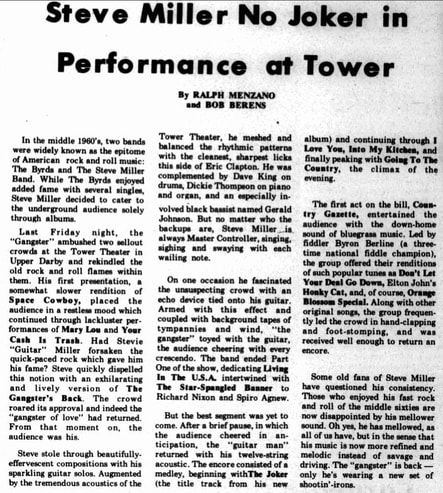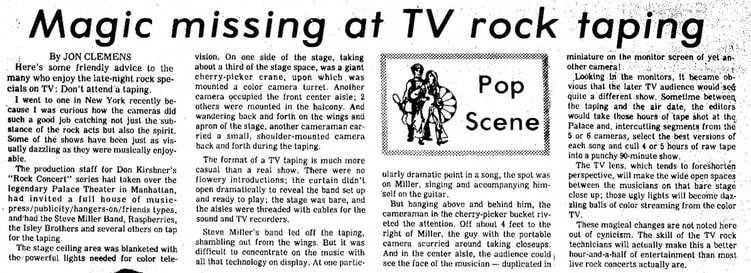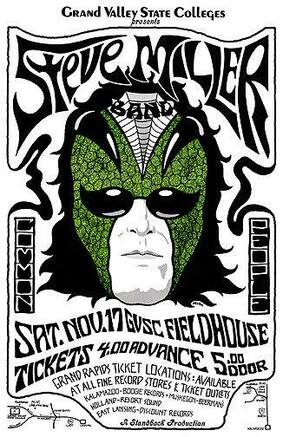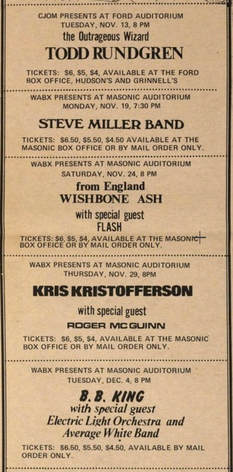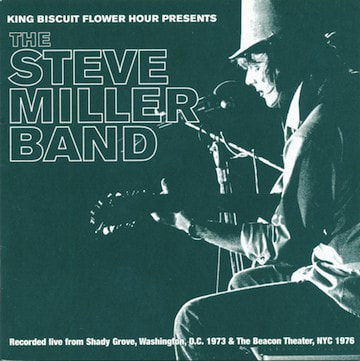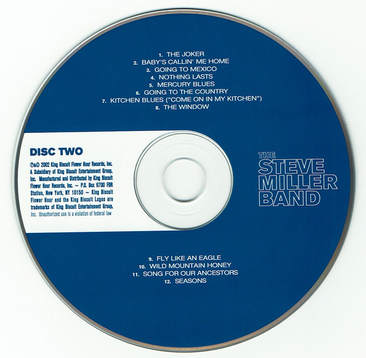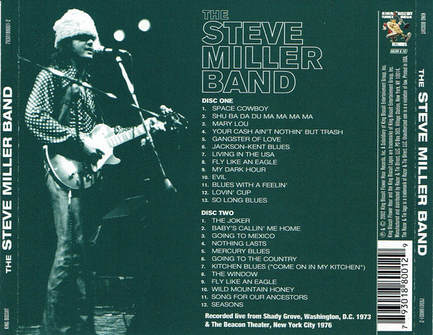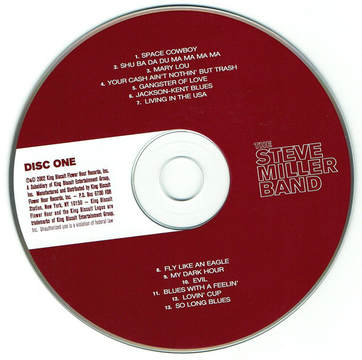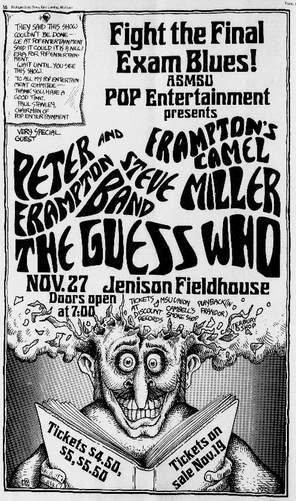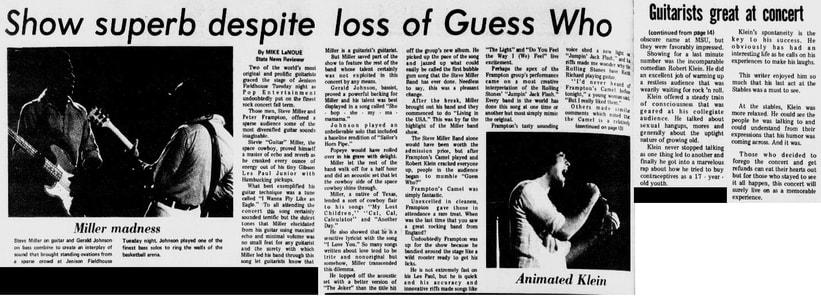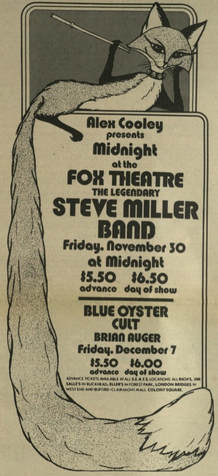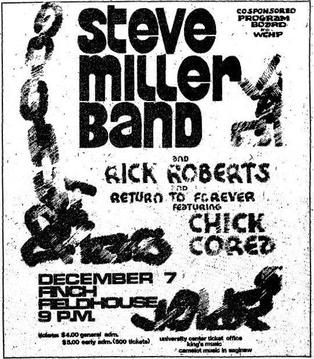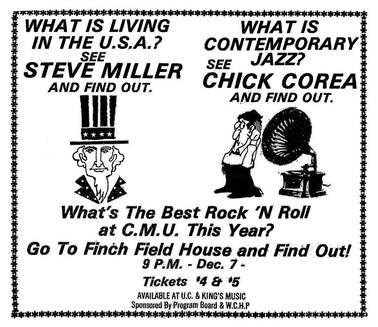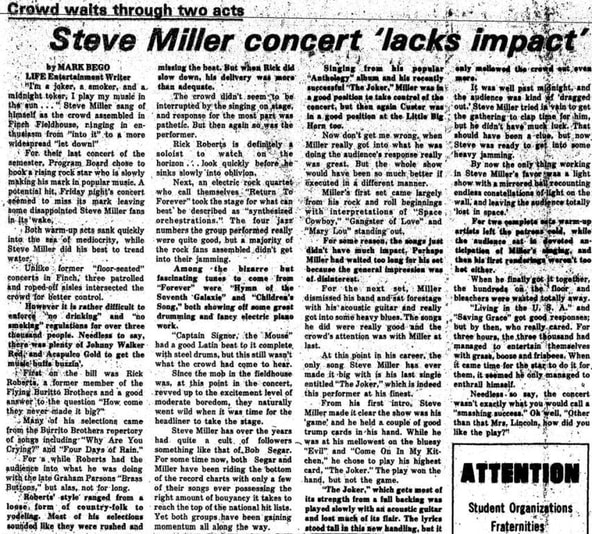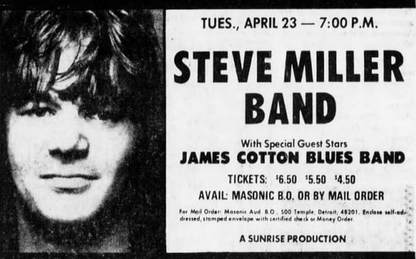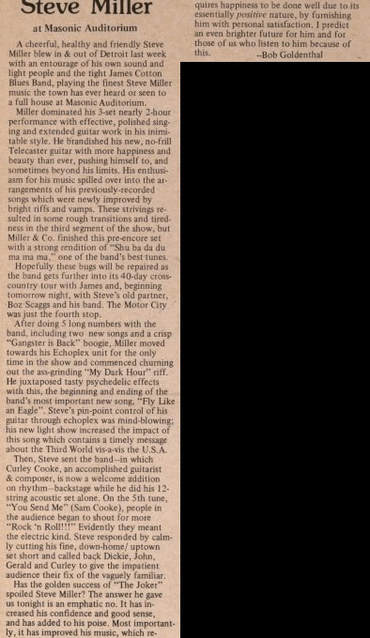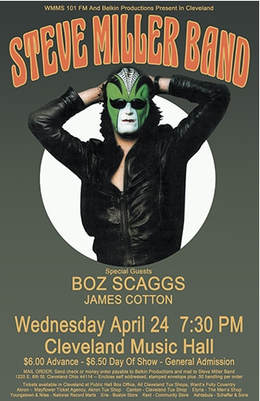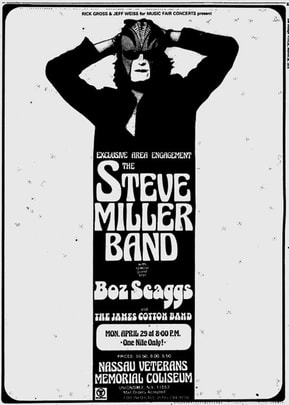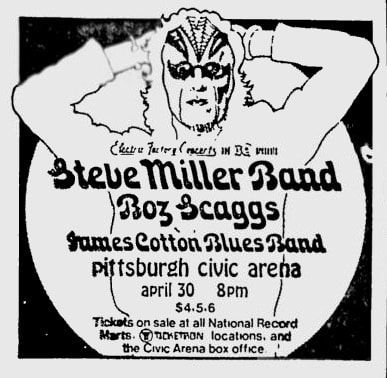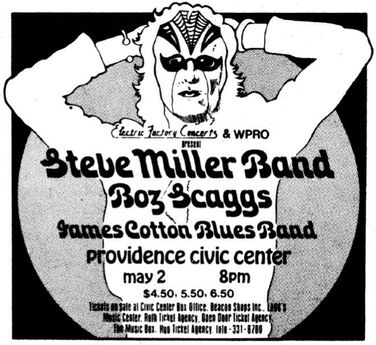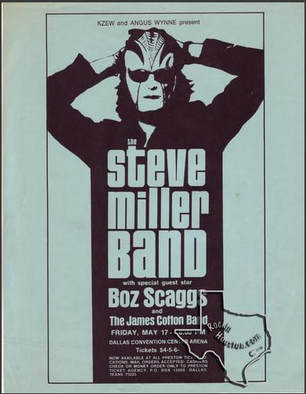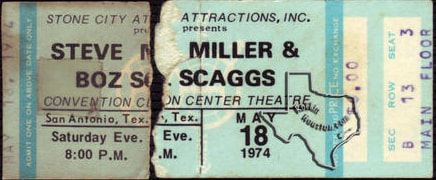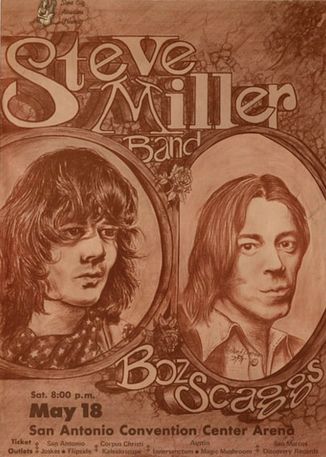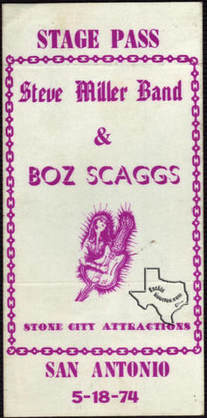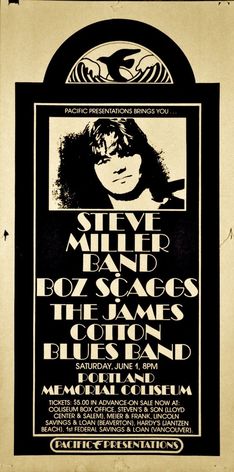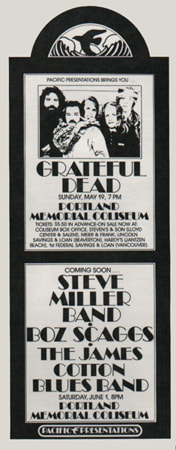If you enjoy what I have put together please consider donating any amount to support and help me to keep this valuable research going. Thanks!!
This day-by-day diary of Steve Miller's live, studio, and private activities is the result of three decades of research and interview work by Bruno Ceriotti, but without the significant contributions by other kindred spirits this diary would not have been possible. So, I would like to thank all the people who, in one form or another, contributed to this timeline: Steve Miller, David Denny, Ken Adamany, Jack King, Jim Peterman, Ben Sidran, Barry Goldberg, Curley Cooke (RIP), Richard Personett, Buddy Miller, Ross Hannan, Corry Arnold, Bob Haydon, Christian McPhate, Joe Jupille, Jos Davidson, Ralph J. Gleason, Greg Vick, Nick Gravenites, Geoff Gould, Jim Salzer, Doug Denslowe, Christopher Hjort, Andy Neill, Matt Kent, Richie Unterberger, John Milward, Jeffrey Mann, Ron Boyer, Peter Vincent, John Swenson, Joe McDonald, Michael Wright, Barry Melton, John Barrett, Faren Miller, Robert Wilonsky, Dietmar Rudolph, Raoul Hernandez, Michael Wright, Max Bell, Barry Miles, Charles Runnels, Paul McCartney, Dan Healy, Susan Masino, Dennis Donley, Susan Brink, Jim Marshall, Colin Hill, Jim Haynie, Judith Sims, Glyn Johns, John A. Greenwald, Rob Frith, Ben Fong Torres, Ben Graham, Nick Warburton, Craig Dalton, Sam Sutherland, Staffan Skjönsberg, Stevie 'Keys' Roseman, Toby Byron, Elaine Mayes, Bill Dowlding, David L Mahler, Jack Notestein, Daniel Zwerdling, Shigemi Sho, Mark S. Janowski, John Sunier, Jim Judkis, Drew Lyon, Bob Brown, Greg Jones, Jeff Jassen (RIP), Signe Toly Anderson (RIP), Jon Clemens, Philip Elwood, Craig Fenton, Rob Fowler, J. Frank Jaworowski, Doug Wyatt, Rolling Stone, Berkeley Barb, San Francisco Good Times, San Francisco Express Times, Great Speckled Bird, Roger Hartstone, Fifth Estate, El Gaucho, Light Into Ashes, The Austin Chronicle, Task Force, Ann Arbor Sun, Ann Arbor Argus, Marmalade Skies, Northwest Passage, East Village Other, Village Voice, The Capital Times, Synapse, RockinHouston.com, Helix, Rebirth, National Times, Billboard, Madison Kaleidoscope, Teenset, The Spectator, Travisty, Miami News, Herald-Taribune, Quicksilver Times, Kaleidoscope Chicago, The Paper, The Kudzu, The Seed, The Pony Express, The Cornell Daily Sun, The Oak Leaf, The Rag, Central Michigan Life, UCLA Daily Bruin, The Daily Gater, The Daily Pennsylvanian, The Michigan Daily, Daily Nexus, The UWM Post, Courier and Freeman, The Long Island Advance, The Pioneer, The Spectrum, Lamron, The Herald, The Farmingdale Observer, Cardinal Points, Press-Republican, The Oswegonian, Teen Set, The Bethpage Tribune, San Francisco Oracle, The Villanovan, Spartan Daily, Record Mirror, Record World, Cash Box, Rock Tour Database, Getty Images, Melody Maker, Dave Niedrich, Mike Delbusso, Splatt Gallery, Cleveland Plain Dealer, Sacramento Rock & Radio Museum, Long Beach Independent, The Sacramento Bee, San Francisco Examiner, The Stanford Daily, San Bernardino Sun, The San Francisco Bay Guardian, Janesville Daily Gazette, The Capital Times, Los Angeles Times, Los Angeles Free Press, Austin American Statesman, Philadelphia Daily News, Racine Journal Times, Delaware County Daily Times, The Tipton (Indiana) Daily Tirbune, The Daily Messenger, The Daily Telegram, The Philadelphia Inquirer, Daily Independent Journal, Chicago Tribune, Fort Worth Star Telegram, St. Louis Post Dispatch, Detroit Free Press, The Minneapolis Star, The Press Democrat, Santa Maria Times, The Bridgeport Post, The Tennessean Sun, Albuqueurque Journal, Oakland Tribune, San Antonio Express-News, Warren Times-Mirror and Observer, Palm Beach Post, Santa Cruz Sentinel, Redlands Daily Facts, The Prospector, The Times Recorder, Salina Journal, Contra Costa Times, Craig Modderno, California State University Sacramento.
Tuesday, October 5, 1943
Steven Haworth Miller (the middle name was after his beloved paternal great-grandmother Mary S. Haworth) was born in Milwaukee, the largest city in the state of Wisconsin. His father George Edward ‘Sonny’ Miller (b. February 27, 1916, Evansville, Indiana - d. June 4, 1990, Rockwall, Texas) was a osteophatic physician and later a pathologist at the local Lakeview Hospital. “My father was a kind of a hipster, and a doctor,” recalls Steve. “[He] had a phenomenal knowledge of music [too], I’m very proud of my dad.” His mother Bertha Leota Attebery (b. February 19, 1917, Gifford, Missouri - d. October 8, 2004, Rockwall, Texas) was a public school teacher who retired to became a housewife after her wedding with Sonny on March 3, 1939, and the birth of their first child George Edward ‘Buddy’ Miller Jr. in 1940. “My mom’s family were all musicians,” also recalls Steve. In fact, Bertha enjoyed playing piano and harmonizing with her older sisters Vada Jean and Ester White since she was a child. Also her older brothers Kenneth Dale and Andrew Paul played guitar and violin respectively (Andrew Paul even played with the Paul Whiteman Orchestra for a while). The Millers lived in a funky old townhouse on East Ogden Avenue (Steve bedroom was on the second floor).
1945/46
“By the time I was two I was singing harmony rounds on Row, Row, Row Your Boat,” Steve recalled to John Swenson in 2018. “My mother and my aunts and my cousins were there so I was singing harmony rounds with them.”
May 1949 (?)
Steve got his first guitar from his uncle Kenneth Dale Attebery. “He came to the house, and he had a little Gibson archtop. A little oval-holed, really sweet little guitar. And that was his guitar,” Steve recalled to Michael Wright in 2010. “He brought it on his visit, and that was the first guitar I ever had my hands on. He was at the house for about four or five days and, because I was interested in the guitar, my older brother wanted to take it away from me. And I wouldn’t let him. My uncle left and I was just terrified that he wasn’t going to leave the guitar. He left really early in the morning. He was a doctor, and he took off and I went running downstairs. And there was the guitar case behind the couch. This velvet case and this sweet, little honey-colored guitar - and he had left it for me.”
Monday, November 14, 1949
The Millers, including six-year-old Steve, attended an evening concert performance by guitar genius and local hero Les Paul. Billed as ‘Mr. Guitar Man Himself Les Paul and His Trio,’ the guitarist was in town to play an extended stay at Jimmy Fazio’s Towne Room, a restaurant and cocktail lounge located inside the Towne Hotel, 725 West 34th Street, just a block and a half away from the Millers home. Born as Lester William Poisfuss in the city of Waukesha, just a short drive from Milwaukee, Paul moved to Chicago when he was nineteen in 1934, then to New York City in 1938, and finally to Hollywood in 1943 where he soon established himself as one of the most innovative and finest guitar men in the country as well as a pioneer in the development of electric guitar and recording technology. As a jazz and blues aficionado, Sonny Miller was obviously a huge fan of the guitarist, so when he heard the news that Les, along with his long-time partner Mary Ford, was in Milwaukee to play near his home, he went down there with his family that Monday night fully intended to meet him and, above all, to offer to recorded him. Recently, in fact, Sonny had became an accomplished amateur recording engineer after he had invested in a Magnecorder, an early pro-quality portable tape recorder. “Tape recorders were brand-new, it was a new thing - German technology,” Steve explained nearly seventy years later to John Swenson (2018). “Les Paul had the second tape recorded available in the United States. When Les and my dad met they were like two of the 20 people in the United States who had tape recorders. They loved each other. My dad would go to record them where they were [playing] at this place called Jimmy Fazio’s Supper Club [sic].” “They were in town for six weeks or so [and] we went every night,” he continued. “As soon as I saw them - it was just like every show Les Paul ever did, it was completely sold out and there were like eight guitarists on stage, a lot of jamming going on. I was just doing what I saw Les do. I knew I wanted to do this as soon as I saw Les and Mary and how much fun they were having.”
Steven Haworth Miller (the middle name was after his beloved paternal great-grandmother Mary S. Haworth) was born in Milwaukee, the largest city in the state of Wisconsin. His father George Edward ‘Sonny’ Miller (b. February 27, 1916, Evansville, Indiana - d. June 4, 1990, Rockwall, Texas) was a osteophatic physician and later a pathologist at the local Lakeview Hospital. “My father was a kind of a hipster, and a doctor,” recalls Steve. “[He] had a phenomenal knowledge of music [too], I’m very proud of my dad.” His mother Bertha Leota Attebery (b. February 19, 1917, Gifford, Missouri - d. October 8, 2004, Rockwall, Texas) was a public school teacher who retired to became a housewife after her wedding with Sonny on March 3, 1939, and the birth of their first child George Edward ‘Buddy’ Miller Jr. in 1940. “My mom’s family were all musicians,” also recalls Steve. In fact, Bertha enjoyed playing piano and harmonizing with her older sisters Vada Jean and Ester White since she was a child. Also her older brothers Kenneth Dale and Andrew Paul played guitar and violin respectively (Andrew Paul even played with the Paul Whiteman Orchestra for a while). The Millers lived in a funky old townhouse on East Ogden Avenue (Steve bedroom was on the second floor).
1945/46
“By the time I was two I was singing harmony rounds on Row, Row, Row Your Boat,” Steve recalled to John Swenson in 2018. “My mother and my aunts and my cousins were there so I was singing harmony rounds with them.”
May 1949 (?)
Steve got his first guitar from his uncle Kenneth Dale Attebery. “He came to the house, and he had a little Gibson archtop. A little oval-holed, really sweet little guitar. And that was his guitar,” Steve recalled to Michael Wright in 2010. “He brought it on his visit, and that was the first guitar I ever had my hands on. He was at the house for about four or five days and, because I was interested in the guitar, my older brother wanted to take it away from me. And I wouldn’t let him. My uncle left and I was just terrified that he wasn’t going to leave the guitar. He left really early in the morning. He was a doctor, and he took off and I went running downstairs. And there was the guitar case behind the couch. This velvet case and this sweet, little honey-colored guitar - and he had left it for me.”
Monday, November 14, 1949
The Millers, including six-year-old Steve, attended an evening concert performance by guitar genius and local hero Les Paul. Billed as ‘Mr. Guitar Man Himself Les Paul and His Trio,’ the guitarist was in town to play an extended stay at Jimmy Fazio’s Towne Room, a restaurant and cocktail lounge located inside the Towne Hotel, 725 West 34th Street, just a block and a half away from the Millers home. Born as Lester William Poisfuss in the city of Waukesha, just a short drive from Milwaukee, Paul moved to Chicago when he was nineteen in 1934, then to New York City in 1938, and finally to Hollywood in 1943 where he soon established himself as one of the most innovative and finest guitar men in the country as well as a pioneer in the development of electric guitar and recording technology. As a jazz and blues aficionado, Sonny Miller was obviously a huge fan of the guitarist, so when he heard the news that Les, along with his long-time partner Mary Ford, was in Milwaukee to play near his home, he went down there with his family that Monday night fully intended to meet him and, above all, to offer to recorded him. Recently, in fact, Sonny had became an accomplished amateur recording engineer after he had invested in a Magnecorder, an early pro-quality portable tape recorder. “Tape recorders were brand-new, it was a new thing - German technology,” Steve explained nearly seventy years later to John Swenson (2018). “Les Paul had the second tape recorded available in the United States. When Les and my dad met they were like two of the 20 people in the United States who had tape recorders. They loved each other. My dad would go to record them where they were [playing] at this place called Jimmy Fazio’s Supper Club [sic].” “They were in town for six weeks or so [and] we went every night,” he continued. “As soon as I saw them - it was just like every show Les Paul ever did, it was completely sold out and there were like eight guitarists on stage, a lot of jamming going on. I was just doing what I saw Les do. I knew I wanted to do this as soon as I saw Les and Mary and how much fun they were having.”
November - December 1949
As mentioned before, the precocious Steve was already singing and pretending playing guitar for about six months before seeing Les Paul. However, it was the meeting with the guitar maestro that would make an especially important impact on the kid’s guitar playing and soon-to-be music career, especially after Paul struck up a friendship with Sonny and became a regular visitor to the Miller home. “He taught me so much,” Steve fondly recalled to John Swenson in 2018. “He taught me my first three chords which were one finger chords, the I-IV-V. He told me when you put out a single you’ve got to send out a package of 100 post cards to every city requesting your tune as if it were from lots of fans. I didn’t know he was a genius. I didn’t know he was kind of inventing the electric guitar. He was just my godfather and this really cool guy who was at the house all the time. Everything Les did is what people do now when they make records. They make them at their house, they use tape echo, Les is really the guy who started all that. He was making his records in his house in the ’40s. He was the first guy who said, ‘This recording studio environment sucks.’ I never thought I was going to be making my own records until I was about 20 years old. I saw what he was doing and just absorbed it.” Once, during a visit, Les even listen to a recording of Steve made by his father around that time. “I was on the second floor of the house, banging on the guitar my uncle had given me, all my little pals were down in the alley behind the house and I was like doing my show,” Steve also explained to John Swenson. “My father snuck in and made a wire recording. I was so mad at him I was absolutely furious that he would sneak in and record me like that. What happened was that Les Paul was visiting [and] my dad wanted to play it for [him]. It was the first time I’d ever heard my voice back and I was like totally freaked. I was extremely embaressed by it so Les paid me a quarter to listen to it and that was like my first paying gig.” “And I learned a lot from Les,” he also recalled to Michael Wright in 2010. “He gave me a bunch of advice. My dad recorded all of that advice. And that’s on my box set*, where I’m like five [sic] years old, going, ‘I hate the way my voice sounds on tape, I’m so embarrassed!” And he says, ‘Oh, you shouldn’t be embarrassed. You’re going to go places, Steve.’ He gave me this pep talk, and I believed him! (laughs) And it’s all recorded. So that’s how I started.” As just mentioned by Steve, both his impromptu performance singing and playing guitar plus Les Paul’s advice to him, were home made recorded by his father Sonny, and both recordings later surfaced, respectively as ‘Child’s Medley’ and ‘Les Paul and Steve (Age 5) [sic],’ on The Steve Miller Band - Box Set released by Capitol Records in 1994.
Thursday, December 29, 1949
During the six weeks Les Paul spent in town he became a mentor for Steve, after the young acolyte proved eager to learn, and a loyal friend for the Millers, so no one seemed surprised when Sonny and his wife Bertha served as the best man and the maid of honor when Les married Mary Ford in a small private ceremony without much fanfare in the Milwaukee County Courthouse on December 29. The newlyweds even spent their honeymoon in Sonny and Bertha’s bedroom before returning home in Hollywood at the end of the year. “He remained a major influence throughout my life,” reflected Steve, who over the years cemented a lifelong friendship with Paul which was interrupted only by the death of the latter on August 12, 2009, nearly sixty years after their first encounter. “I was lucky,” he added to George Varga in 2015. “Les was my godfather and I knew him from 1949 on. Growing up, I was always around adult musicians who played for their entire lives. So that's what I wanted to do, and I always had that in mind.”
1950
Sonny Miller accepted a job as head of the Department of Pathology at the Dallas Osteophatic Hospital (later he also became a consulting pathologist to numerous osteopathic hospitals in Texas), so he and his family moved from Milwaukee to Texas. The Millers went to live into a very open and modern home designed by Sonny himself, and located at 7227 Fisher Road in Lakewood, a neighborhood that afforded the amenities of a prosperous East Dallas. As a part of the construction plans, Sonny added to the house a pool and a large pool house/game room/shop that became affectionately known as ‘The Barn.’ For Steve, this relocation marked another next step in his musical awareness. His father took him out to hear different kinds of performers than typically came to Milwaukee - country luminaries like Okee Jones, Reilly Crabtree, and the immortal Hank Williams, as well as Chuck Berry, the Clovers, Carl Perkins, and Frankie Lymon and the Teenagers, the first of the rock and roll vanguard. “When we got to Texas it was a total shock,” Steve recalls in an interview with John Swenson in 2018. “Number one it was segregated. My parents were hipsters, they loved jazz and blues, they had black friends, which was just not acceptable back then. They accused my father of having race parties and arrested him. There was a huge musical stew going on in Dallas. The Big D Jamboree was on, which was basically an outlier of the Grand Ole Opry. We had Louisiana Hayride from Shreveport. So Elvis would be in Dallas. I saw Carl Perkins in Dallas. They had rhythm and blues shows, they had country music, they had Mexican music, they had Tex-Mex. It was on television. There was a store in downtown Dallas called the McCord music company that was the first music company outside of California that sold Fender instruments and amplifiers. So there were Stratocasters and Telecasters and Fender Bassman amps and concert amps for sale in Dallas. You could turn on television and Freddie King was on television on Saturday afternoon on an R&B show. Or Ernest Tubb. Or Riley Crabtree. Or Hank Williams. All of this music was going on. There were black radio stations, KNOK was a black station, nothing but blues and rhythm and blues, Muddy Waters, Howlin’ Wolf. We had regular pop stations like KLIF. Then we had a DJ named Jim Lowe on WRR, a public station, PBS-style, they had a great blues show on five days a week called Kat’s Karavan. So I’m listening to Jimmy Reed, I’m 11, 12 years old.”
1951 - 1952
Two years after his inspiring encounter with Les Paul, another guitar legend entered in the life of the young Steve and taken him under his wing: T-Bone Walker. The Texas-born bluesman, who suffered of ulcera and was also something of a hypochondriac, used to check himself in and out of hospitals for years, and at some point he became a patient of Sonny Miller. Usually nothing was wrong with him, but during those days, he became one of Sonny’s close friends and every now and then he would show up at the Miller home with a trio and perform for a handful of invited guests. A few moments of one such performance in 1952 also landed on The Steve Miller Band - Box Set and it's a rare, inspiring treat: Walker, legendary for his rendition of ‘Call it Stormy Monday,’ plays guitar like ordinary mortals pour water, and his voice is sweet, sharp, full of swing and soul. His playing became a template for Steve's own style - never in the history of rock and roll did a student have such a gracious, giving teacher. “T-Bone Walker was a patient at the hospital where my dad practiced,” Steve confirms in an interview with John Swenson in 2018. “He introduced himself to T-Bone and they became really good friends. T-Bone became a regular at our house, which was really unusual because it was a segregated city. He’d come over and we’d hang out. He played some gigs which my father recorded. I’ve got 21 songs T-Bone recorded at our house in 1951 and 1952. He was the sweetest man. When he showed up at the house for the first time I knew he was coming because we rented a piano and the carpet was rolled up. I stayed home from school. T-Bone showed up in a flesh-colored Cadillac convertible with real leopard skin seat covers, in a suit, just as sharp and clean and beautiful as he could be. As soon as I saw him I said you’re T-Bone Walker, show me show me show me. I sat right next to him every time he played and that’s how I learned what playing lead guitar was.” “They were great parties - phenomenal,” Steve also recalls in another interview. “T-Bone would bring a piano and a bass player, and he'd come over at 5 p.m., and we'd hang out and have dinner. He taught me how to play guitar with my legs spread apart and behind my back.” “When you listen to the tapes, he and my dad would just talk, and he would just play,” he continues. “Pop would come up with one song, T-Bone would come up with another. I remember one party started at eight at night and ended at six the next morning with breakfast. He was just so great. His singing and phrasing were the best, and no one else came close. Every time I picked up a guitar, I heard T-Bone.”
Saturday, September 1, 1951
Steve’s younger brother James Attebery ‘Jim’ Miller was born at the Dallas Osteophatic Hospital. He passed away in 2004.
Saturday, February 28, 1953
Steve’s younger brother Timothy Miller was born at the Dallas Osteophatic Hospital.
Sunday, March 1, 1953
Steve’s younger brother Timothy, just one day-and-ten hours-old, passed away at 5:15pm at the Dallas Osteophatic Hospital. The cause of the death was a complete interruption of the supply of oxygen to the brain (referred to as cerebral anoxia) due to respiratory failure and prematurity. Funeral service was held two days later, on March 3, at the Crane-Longley Funeral Chapel. Interment followed at Restland Memorial Park cemetery.
September 1955
Steve, as seventh grader, and his older brother Buddy, as tenth grader, enrolled at St. Mark’s School of Texas, a private school for boys from 1st to 12th grade, located at 10600 Preston Road, Dallas. Buddy was a member of the track squad in his first year there.
September 1956 - June 1957
During his second year at St. Mark’s School of Texas, Steve was a member, along with his brother Buddy, of the Re-Marker staff (the ReMarker was the school’s newspaper). Buddy was also a member of the Lettermen’s Club, of the basketball team and of the football team. It was also during his second year at St. Mark’s that Steve met his future bandmates and eight grader like him: Robert Fount ‘Bob’ Haydon (b. 1942, Kensington, Montgomery County, Maryland), who enrolled there at the start of that year in September ‘56, and Arthur Baron Cass III who enrolled there the previous spring of ‘56, just one semester after Steve.
June 1957
At the end of his second year at St. Mark’s School of Texas, Steve received a ‘Second Honor Roll’ award.
September 1957 - June 1958
During his freshman year at St. Mark’s School of Texas, Steve was a member of the football team, The Lions (named after the school logo), along with his brother Buddy (who received an ‘All-Conference and Honorable Mention’ at the end of the season). Buddy also played in the Varsity soccer squad, was a member of the Marksmen yearbook staff, and a member of the Lettermen’s Club. This was the senior year for Buddy, and after graduated in June 1958 he probably attended Brown University in Providence, Rhode Island, the following fall.
September 1957
At the beginning of his freshman year at St. Mark’s, Steve started rehearsing at his parents house with schoolmate drummer Baron Cass. “A rich kid who’d had really great drum lessons, had a really great set of drums and was really good,” recalls Steve about Baron, who that year also played snare drum in the St. Mark’s Band.
UNNAMED DUO (SEPTEMBER 1957 - NOVEMBER 1957 (?))
1) Steve Miller vocals, lead guitar
2) Baron Cass drums
Saturday, October 19, 1957: ‘Freshman Dance,’ Gymnasium, St. Mark’s School of Texas, 10600 Preston Road, Dallas, Texas
“Those lucky enough to attend the dance stepped out of the frosty night air into a summer Hawaiian paradise,” reported the Marksmen yearbook (1958). “Everything was complete down to the leis, palm trees, pillows on the floor, golden moon, fish nets, monkeys and beautiful scenery provided by airline posters. The highlight of the evening was a ‘rock-a-hula’ band straight from the islands. It consisted of Steve Miller [ninth grade], playing his electric guitar, and Baron Cass [ninth grade] on his drums. They played many good Hawaiian numbers, such as: ‘Honky Tonk,’ ‘Suzi Q,’ ‘The Big Noise from Winnetka,’ and arrangements by Jimmy Reed. A good time was had by all and when the dance ended all put on their Alaskan survival jackets and snow shoes to once again step into the raging blizzard!” The dance lasted from 8:30pm to 11:00pm.
“Those lucky enough to attend the dance stepped out of the frosty night air into a summer Hawaiian paradise,” reported the Marksmen yearbook (1958). “Everything was complete down to the leis, palm trees, pillows on the floor, golden moon, fish nets, monkeys and beautiful scenery provided by airline posters. The highlight of the evening was a ‘rock-a-hula’ band straight from the islands. It consisted of Steve Miller [ninth grade], playing his electric guitar, and Baron Cass [ninth grade] on his drums. They played many good Hawaiian numbers, such as: ‘Honky Tonk,’ ‘Suzi Q,’ ‘The Big Noise from Winnetka,’ and arrangements by Jimmy Reed. A good time was had by all and when the dance ended all put on their Alaskan survival jackets and snow shoes to once again step into the raging blizzard!” The dance lasted from 8:30pm to 11:00pm.
November 1957 (?)
Another classmate of Steve and Baron Cass at St. Mark’s, guitarist Bob Haydon, started rehearsing with them every weekend at Steve’s parents house. “We [Steve and I] began talking in study hall about how our fingers hurt from playing the guitar and he invited me to his house one weekend for a practice session,” recalls Bob Haydon in his memoir Kensington in 2017. “Following his own instincts to mold a band, he gently streered me away from ‘I Walk the Line’ or ‘Jimmy Brown the Newsboy’ and introduce me to Jimmy Reed and the straight blues lines of ‘Honky Tonk.’ We got together every weekend at his poolhouse, affectionately known as ‘the barn,’ and a list of songs evolved of mostly original material such as ‘Rockin’ Rs,’ ‘Mr. K,' 'Windmill,’ and ‘Haydon Opus III’ (neither of us remembers anything about these songs but we still have the list).” “We actually felt that our hard work was vindicated when one afternoon Steve and I took a bus to a downtown Sears to look at guitars,” he continues. “We found some hardbody Gibson's that we liked, plugged them into a big Silvertone amp and began playing. Now we were on the 2nd floor and almost immediately a crowd, with a lot of them attracted from the first floor, gathered around us. When the music store manager came over to us, Steve asked if it was okay for us to play and, looking at the people we had drawn to his section, he said, 'Please, keep playing!'” The trio, which called themselves the Marksmen after their school’s yearbook, started building their sound and set list from assorted sources, spanning the soulful vocals of Ray Charles and challenging harmonies of the Four Freshmen. Having learned his lessons from T-Bone Walker, the fourteen-year-old Steve was already a showman, capable of spinning into a split or whipping his guitar behind his head at the peak of a solo. “I got a Les Paul Junior guitar and started a band,” recalls Steve. “My first band started out just like Ricky Nelson did: We got $75 to play 20-minute sets between the dance records at local parties; we did about 500 gigs.” “When I first started playing, there were no rock-and-roll bands [in Dallas],” he continues. “There was just us and the Nightcaps, and we were really in competition with each other. They were a little hipper, because they were older... We got the whole idea for the act from Ozzie and Harriet. They had great music on that show, and they always had stories about Ricky Nelson and James Burton. When we started booking our band, we never told anybody how old we were. We sent out notices to every church and school and country club, played 15-minute intermissions with just drums and guitar. We made $75 for each 15 minutes of work, and we thought we were geniuses. Back then, it was big money. We'd do a couple of shows like that a night. We'd play Jimmy Reed, Bill Doggett, and leave. Eventually, people started wanting rock and roll, and then we'd learn more stuff.” “I started my first band when I was 12 [sic]. And people go, ‘Yeah, right. That’s real cute.’ But no, it was a real band,” Steve also explains to Michael Wright in 2010. “There weren’t any rock and roll bands then. I had mimeographed letters and sent them out to all the sororities and fraternities and country clubs and churches and schools and synagogues - any place where they had music. I said, 'I’ve got a rock and roll band. And I’m booking it. And I’m only going to accept bookings for the next three weeks. After that, I’m not accepting any more bookings this semester.' And I had that band booked for a half a year in three weeks. And I had a really good drummer, who had been taking lessons since he was five years old. And we had a really good band. And we started work.”
THE MARKSMEN #1 (NOVEMBER 1957 (?) - 1960)
1) Steve Miller
2) Baron Cass
3) Bob Haydon vocals, rhythm guitar
1) Steve Miller
2) Baron Cass
3) Bob Haydon vocals, rhythm guitar
Late 1957 or Early 1958: ‘12th Birthday Party,’ unknown home, Lakewood, East Dallas, Dallas, Texas
The Marksmen played their first paying gig (five bucks each) at Steve’s neighbor’s 12th birthday party.
Sunday, unknown date, Late 1957 or Early 1958: Miss Finley's Dance Studio, unknown church, Dallas, Texas
The Marksmen played their first “big” gig at Miss Finley’s Dance Studio located in a church in Dallas. More than 100 kids showed up and it turned into a regular gig every Sunday night.
1958 (?): private party, unknown home, Dallas, Texas
The Marksmen played at a private party (maybe another birthday?) at somewhere house in Dallas. For this gig only they added a 2nd drummer, another classmate named Bill Sleeper (b. 1942), who at that time played with Baron Cass in the St. Mark’s Band.
1958 (?): ‘Teen Fashion Show,’ The Zodiac, Level Six of Neiman Marcus Department Store, 1618 Main Street, Dallas, Texas
The Marksmen biggest break came when Neiman Marcus, which was located in downtown Dallas, invited them to play a fashion show for teenagers in the Zodiac room. “Word of our popularity spread through the local schools and we were pleasantly surprised when Neiman Marcus invited us to provide entertainment for a teen fashion show at their posh downtown store,” confirms Bob Haydon in his memoir Kensington in 2017. “At the end of the performance a crowd of girls gathered around us for booking info.”
1958 (?): ‘National Cheerleaders Convention,’ Umphrey Lee Center, Southern Methodist University campus, 3300 Dyer Street, Dallas, Texas
The Marksmen played in front of 600 screaming girls.
1958 (?): ‘Annual Junior Symphony Ball,’ unknown venue, Dallas, Texas
The Marksmen also backed up the headliner Neil Sedaka.
1958 (?): ‘Fraternity Party,’ unknown venue, University Of Oklahoma campus, 660 Parrington Oval, Norman, Cleveland County, Oklahoma
1958 (?): ‘Fraternity Party,’ unknown venue, University Of Houston campus, Houston, Harris County, Texas
1958
The Marksmen weekend rehearsal at Steve’s parents house in Dallas was recorded and a rock ‘n’ roll instrumental penned by Steve and titled ‘Candy Cain,’ later surfaced on The Steve Miller Band - Box Set (1994).
September 1958 - June 1959
During his sophomore year at St. Mark’s School of Texas, Steve was again a member of the football team, The Lions, wearing No.85. He also played in the basketball ‘B’ team where he played in all the 20 games of the season (10 wins and 10 losses) averaging 4.3 points (4th scording leader on a team of 10 players). Last but not least, he also joined the Art Department under Mr. Arthur Douglas.
1959 (?): The 90th Floor, 2502 McKinney Avenue at Fairmont Street, Dallas, Texas
According to Steve, his first “professional gig” (apparently as solo performer not with the Marksmen) was at a 200-person-capacity nightclub converted from a warehouse, owned by Dick and Kiz Harp, a husband-and-wife piano-and-vocals duo. The couple called the venue ‘90th Floor’ after a less-known Cole Porter song they perfomed.
Saturday, March 7, 1959: ‘Sophomore Dance,’ Gymnasium, St. Mark’s School of Texas, 10600 Preston Road, Dallas, Texas
“The theme, ‘The Roaring Twenties,’ was well illustrated in both the decorations and costumes of those in attendance,” reported the Marksmen yearbook (1959). “The guests entered through a long corridor and stepped down into a ‘spekeasy.’ The decorations involved the use of sets from the play, Journey’s End, and a bar, from which root-beer, pretzels, and peanuts were served. Midway through the dance, the music, provided by Hugh Flower [and his Orchestra], was interrupted for an intermission in which the Sophomores presented their entertainment for the evening. The high spot of the evening was the music presented by the Marksmen (Steve Miller, Baron Cass, and Bob Haydon). At 11:30, the scene faded as the dance broke up, with only the memories of what may be the best dance for some time to remain in the mindsof those who were there.” By the way, although not mentioned in the above review of the event, a photo in the yearbook showed the Marksmen on stage backing up an unidentified vocal quartet.
September 1959 - June 1960
During his junior year at St. Mark’s School of Texas, Steve was again a member of the football team, The Lions, wearing No.85. He was also again in the Art Class and there he became friends of another two future bandmates, Bill ‘Boz’ Scaggs and Rodger Gaulding. “The Art Class, instructed by Mr. Arthur Douglas, attended by budding artists from grades seven through eleven, and held comfortably, in the new Fine Arts Building, has enjoyed total success,” reported the Marksmen yearbook (1960). “Meeting during its members’ homeroom periods, this year’s class has allowed its students to pursue their own individual interests; its teacher giving enlightening advice to the struggling artist so as to produce the maximum achievement. Junior Steve Miller, reliable veteran of the course, has produced work with his characteristic verve. Classmate Jim Adler has enjoyed similar success. Sophomores Rodger Gaulding and Bill Scaggs have likewise been praised by their teacher, and Scaggs is even said to possess the ‘unlimited potential of a future artist.’ Freshmen Tony Briggs, Doug Owen, and Craig Williams and novices Pete Maxon and Howard Crow have also received commendations for their work.”
Saturday, November 14, 1959: ‘Junior Dance,’ Gymnasium, St. Mark’s School of Texas, 10600 Preston Road, Dallas, Texas
“As the fiery sun set in the golden west, and the lonesome call of coyotes echoed over the St. Mark’s campus, folks from all over found these parts, prettied up in their best Western duds, began assemblin’ for the rip-roarin’ shindig fixed up by the Junior Class,” reported the Marksmen yearbook (1960). “That cool evening of November 14 saw the gym done over as a saloon (straight from that silver-screened box in every living room), complete with bartenders. Drinks, soft, were on the house, and music for the get-together was furnished by the High Hats. Highlight of the evening came with intermission entertaintment. With just about everyone getting into act, the juniors put on exhibitions of skill and talent, featuring the world-famous Peter G. Flood, the man with a wrist of lightning and a whip as sure as a Colt 45, assisted by a fearless companion. The entertainment was climaxed by an authentic revival of American aboriginal music by the Marksmen Trio. The evening ended and friends departed, full of the spirit of the old wild west, and the stars shone bright - deep in the heart of Texas.”
1960
The Marksmen trio became a sextet after the addition of Steve’s older brother Buddy on bass (“I taught [him] to play bass so he could drive us to our gigs, and we never looked back,” explains Steve), plus Steve’s art classmates Rodger Dorman Gaulding (b. 1944) on bass voice and harmonica, and William Royce ‘Bill’ Scaggs, aka ‘Boz’ (b. Thursday, June 8, 1944, Canton, Stark County, Ohio) on vocals and tambourine, formerly of the Bacchanal Trio. With this new lineup the band started playing all over Texas, Oklahoma, and Louisiana, and also recorded a lot of home made reel-to-reel tapes. “We had four singers, including Boz, and we did Beach Boys pop-rock harmonies on top of white blues, which was rock and roll,” explains Steve. “I had this cool band, and a bunch of guys really dug the band. When we showed up and played, the place moved. It wasn't some bullshit band. There's not a nightclub in the world we couldn't have paralyzed.”
THE MARKSMEN #2 (1960 - 1960/61)
1) Steve Miller
2) Bob Haydon
3) Baron Cass
4) Buddy Miller bass
5) Boz Scaggs vocals, tambourine
6) Rodger Gaulding bass voice, harmonica
September 1960
Steve Miller and Bob Haydon were kicked out of St. Mark’s School of Texas. “The felt that we did not represent the school because we were a band,” explains Steve. “They didn't care for rock 'n' roll, and I had real long hair.” At that point, Haydon enrolled at Highland Park High School in University Park (where he graduated in 1962), while Steve attended the local Woodrow Wilson High School, 100 South Glasgow Drive, Dallas.
September 1960 - June 1961
During his senior year at Woodrow Wilson High School, Steve was a member of the Wildcats, the track and field team. He was also a member of the Key Club, an all-boy organization who encouraged members to served school and others, sponsored by Mr. Dale McNeill since 1957. Last but not least, he was also an aspiring journalist member of the Press Club. “The smell of newspaper ink, the precise setting of type, the creating of headlines, and the many periods spent in copy reading all brings to mind a vivid picture of the Press Club,” reported the Crusader, the school yearbook (1961). “This organization, under the sponsorship of Mr. Albert Johnston, is dedicated primarily to the betterment of the WOODROW WILSON NEWS and other Wilson publications. Although anyone interested in journalism may join this club, most of its members consist of journalism students. The purpose of the club is to acquaint members with all phases of journalism, including writing, photography, and the mechanics of the print shop. Besides making a field trip to the Reilley Printing Company, the company that print the WOODROW WILSON NEWS, the club has had various guest speakers and ex-students who are now on college newspaper staffs.”
1960/61
Buddy Miller, now married and busy with his university studies, left the Marksmen and at that point Boz Scaggs took over the bass role in the band (needless to say, it was Steve was taught Boz how to play that instrument, and also guitar around the same time).
THE MARKSMEN #3 (1960/61 - SEPTEMBER 1961)
1) Steve Miller
2) Bob Haydon
3) Baron Cass
4) Rodger Gaulding
5) Boz Scaggs now also on bass
1960/61: LouAnn's, 5218 Greenville Avenue at Lovers Lane, Dallas, Texas
The Marksmen also backed up the headliner Jimmy Reed. “I had played with Jimmy Reed in Texas,” confirms Steve to Michael Wright in 2010. “Jimmy was one of my very biggest influences. I mean, when I was 14 [sic] years old, my band backed up Jimmy Reed.”
1961: ‘Fraternity Party,’ unknown venue, Southern Methodist University campus, Dallas, Texas
The Marksmen also backed up the headliner Jimmy Reed. “I had played with Jimmy Reed in Texas,” confirms Steve to Michael Wright in 2010. “Jimmy was one of my very biggest influences. I mean, when I was 14 [sic] years old, my band backed up Jimmy Reed.”
1961: ‘Fraternity Party,’ unknown venue, Southern Methodist University campus, Dallas, Texas
June 1961
Steve graduated at the Woodrow Wilson High School. In the Crusader, the school yearbook, the staff says: “Special thanks are given to… and Steve Miller, who has written much of the copy for the athletic section.”
September 1961
Steve left the Marksmen (which continued with a new lead guitar played named Doug Simril) and moved from Dallas to Madison, Dane County, Wisconsin, to pursued studies in comparative literature at the local University of Wisconsin-Madison. There, he pledged the Chi Psi fraternity and lived in the Chi Psi Lodge on fraternity row near Langdon Street. The Chi Psi Lodge, referred to as ‘The Lodge’ and located on Lake Mendota, was one of the oldest fraternity houses on campus. At his induction speech for the Rock and Roll Hall of Fame in 2016, Miller stated that during his time in Madison he was also a member of the Student Non-Violent Coordinating Committee and a freedom rider in the war protest. For the record, fellow student and future bandmate Ben Sidran points out that, “I do not believe Steve was ever part of SDS or a freedom rider. Sometimes he likes to make things up.”
September 1961
Steve formed a campus band called the Ardells, with whom he played a version of Texas shuffle blues that hadn’t been heard in the upper Midwest until now. The band also featured a former Unviersity of Wisconsin-Madison student named Jos Davidson on rhythm guitar and bass (it was Steve who taught him to play both instruments), a local sixteen-year-old high school piano player, the late Brian Friedman, and Ron ‘Ronnie’ Boyer, a Texas-born drummer who had a day job as a manager at Kelly's, a fast food restaurant which was just off the West Betline Highway, out on the edge of town. “I went up to the University of Wisconsin. They didn’t have any bands. They were still dance bands. So we started a rock and roll band there,” recalls Steve to Michael Wright in 2010. The band played mostly the University party circuit, plus a few gigs in local clubs in Madison, and a couple of concerts at the Dane County Fairgrounds, 3310 Latham Drive, Madison. The first time they played together, however, was on the patio of Kelly's. “We played until the cops shut us down,” recalls Ronnie Boyer.
THE ARDELLS #1 (SEPTEMBER 1961 - JUNE 1962)
1) Steve Miller lead vocals, lead guitar, harp
2) Jos Davidson rhythm guitar, bass
3) Brian Friedman piano
4) Ronnie Boyer drums
June 1962
The Ardells went on hiatus for the summer and Steve and Ronnie Boyer joined The Knightranes, a famous rock 'n' roll, rhythm 'n' blues and modern jazz band based in Janesville, Rock County, Wisconsin, which at the time featured the band's leader, manager and jack of all trades Ken Adamany on electric piano and organ, Dennis 'Denny' Berg on vocals, rhythm guitar and bass, plus Jerry Leyendecker who played sax from time to time. Their slogan was, "We're the Knightranes, we never come late, and we always pull out on time," Ronnie Boyer recalls. "I think Steve got put on social probation at school for some of that stuff."
The Ardells went on hiatus for the summer and Steve and Ronnie Boyer joined The Knightranes, a famous rock 'n' roll, rhythm 'n' blues and modern jazz band based in Janesville, Rock County, Wisconsin, which at the time featured the band's leader, manager and jack of all trades Ken Adamany on electric piano and organ, Dennis 'Denny' Berg on vocals, rhythm guitar and bass, plus Jerry Leyendecker who played sax from time to time. Their slogan was, "We're the Knightranes, we never come late, and we always pull out on time," Ronnie Boyer recalls. "I think Steve got put on social probation at school for some of that stuff."
THE KNIGHTRANES #? (JUNE 1962 - SEPTEMBER 1962)
1) Steve Miller vocals, lead guitar, harp
2) Denny Berg vocals, rhythm guitar, bass
3) Ronnie Boyer drums
4) Ken Adamany electric piano, organ Hammond B-3
+
5) Jerry Leyendecker sax (sat-in from time to time)
Friday, June 29 - Saturday, June 30, 1962: Frank and Mike's, South Beloit, Winnebago County, Illinois
The Knightranes auditioned and became the house band every Fridays and Saturdays.
Tuesday, July 3, 1962: St. William Catholic School, 1822 Ravine Street, Janesville, Rock County, Wisconsin
The show, which lasted from 8:30pm to 11:30pm, was presented by Rock River Boat Association. Tim Davis, future drummer of The Knightranes and The Steve Miller Band, was in attendance and started to pick up on Ronnie Boyer's style.
Friday, July 6 - Saturday, July 7, 1962: Frank and Mike's, South Beloit, Winnebago County, Illinois
Saturday, July 7, 1962: Smith Student Union, Beloit College campus, 700 College Street, Beloit, Rock County, Wisconsin (afternoon show)
Wednesday, July 11, 1962: Sherwood Lodge, just south of Kiddieland Park, Forest Hills Road, Rockford, Winnebago County, Illinois
Ronnie Boyer did not played with The Knightranes tonight because sometimes he worked late and could not make the drive on time, so a local drummer and future actor named Gary Burghoff filled in for him.
Friday, July 13 - Saturday, July 14, 1962: Frank and Mike's, South Beloit, Winnebago County, Illinois
Wednesday, July 18, 1962: Turner Hall of Monroe, 1217 17th Avenue, Monroe, Green County, Wisconsin
The band was advertised as 'Twist with The Fabulous Knightranes and Steve Miller (Formerly with the Fireballs) Dallas, Texas'. One show, from 9:00pm to 12 midnight.
Friday, July 20 - Saturday, July 21, 1962: Frank and Mike's, South Beloit, Winnebago County, Illinois
Sunday, July 22, 1962: Riverside Park, Janesville, Rock County, Wisconsin
Friday, July 27 - Saturday, July 28, 1962: Frank and Mike's, South Beloit, Winnebago County, Illinois
Thursday, August 2, 1962: Club Pop House (aka The Pop House), 154-158 Portland Avenue and 5th Street , Beloit, Rock County, Wisconsin
Friday, August 3 - Saturday, August 4, 1962: Frank and Mike's, South Beloit, Winnebago County, Illinois
Monday, August 6, 1962: Majestic Hills (Ski Lodge), Lake Geneva, Walworth County, Wisconsin
Wednesday, August 8, 1962: Teen Canteen, Stoughton, Dane County, Wisconsin
Friday, August 10 - Saturday, August 11, 1962: Frank and Mike's, South Beloit, Winnebago County, Illinois
Jerry Leyendecker played with The Knightranes on both nights.
Monday, August 13, 1962: Majestic Hills (Ski Lodge), Lake Geneva, Walworth County, Wisconsin
Friday, August 17 - Saturday, August 18, 1962: Frank and Mike's, South Beloit, Winnebago County, Illinois
Jerry Leyendecker played with The Knightranes on Friday night.
Wednesday, August 22, 1962: St. William Catholic School, 1822 Ravine Street, Janesville, Rock County, Wisconsin
Friday, August 24 - Saturday, August 25, 1962: Frank and Mike's, South Beloit, Winnebago County, Illinois
Friday, August 31, 1962: Frank and Mike's, South Beloit, Winnebago County, Illinois
Saturday, September 1, 1962: Madison Turners Hall, 3001 South Stoughton Road, Madison, Dane County, Wisconsin
Jerry Leyendecker played with The Knightranes tonight.
Sunday, September 2 - Monday, September 3, 1962: The Last Resort, Fox Lake, Lake County, Illinois
The Knightranes auditioned on Sunday afternoon and were hired on the spot to play there on Monday and also the next weekend. Jerry Leyendecker played with the band on both days, while Ronnie Boyer did not played on Monday because he was late again, so a local drummer named Harry Johnson filled in for him. Also on the bill: Eddy Clearwater and his Blues Band (2).
Friday, September 7 - Sunday, September 9, 1962: The Last Resort, Fox Lake, Lake County, Illinois
Jerry Leyendecker played with The Knightranes on all the three nights, while Ronnie Boyer did not played on Sunday because he was late, so Harry Johnson filled in for him again.
Friday, September 14 , 1962: Fond du Lac School District Recreation Department, 85 Morningside Drive, Fond du Lac, Wisconsin
Jerry Leyendecker played with The Knightranes tonight.
Saturday, September 15 , 1962: The Rail, 2407 Jackson Street, Oshkosh, Winnebago County, Wisconsin
Jerry Leyendecker played with The Knightranes tonight.
September 1962
Steve and Ronnie Boyer resumed The Ardells after the summer. Jos Davidson and Brian Friedman were no longer with them (Jos returned home to Chicago and went to play bass with Michael Bloomfield, and The Siegel-Schwall Band, while Brian also moved to Chicago where he played with Michael Bloomfield in a band called The Group). The pair were replaced by another student of the University of Wisconsin-Madison, a singer and rhythm guitarist named Denny Berg, and by Steve's old friend and bandmate Boz Scaggs on vocals and bass. Boz had graduate from St. Mark's that summer and at Steve's invitation he moved to Madison to pursued studies at the University Wisconsin-Madison too. Boz also pledged the Chi Psi fraternity although Steve was no longer with them for his second year there. “Boz played my bass in The Ardells,” recalls Buddy Miller. “I sent my Bassman Fender amp and Fender Precision bass to Steve at the University of Wisconsin (his amp had been thrown in a creek during a drunken frat party). I was married and still in college when this happened. I wrapped my bass and amp in brown paper and shipped it to Madison via Air Express in 1963 [sic]. Later Ross Valory (Steve Miller Band, Journey) also played my bass for about 5 years. My bass was in the Fender Museum for about 5 years until Steve returned it to me. My amp is still there.”
THE ARDELLS #2 (SEPTEMBER 1962 - OCTOBER 1962)
1) Steve Miller
2) Ronnie Boyer
3) Denny Berg vocals, rhythm guitar
4) Boz Scaggs vocals, bass
September or October 1962: Lakefront Gateway, from the north end of Lake Street west past the Memorial Union, University of Wisconsin-Madison campus, Madison, Dane County, Wisconsin
The Ardells' future piano player Ben Sidran saw the band performed live for the first time. “Passing by the lakefront one crisp autumn afternoon, I heard a four-piece band playing a rocking groove that reminded me of the kind of shuffle Louis Jordan would play, but with more raw energy, more like ther boogie-woogie I loved as a kid,” recalls Ben Sidran in his memoir A Life in the Music (2003). “I rode my motor scooter right up to the edge of the stage and watched the band. They sang like angels. The two guitar players and the bass player had great vocals harmonies worked out. This was before the Beatles, and nobody had ever heard anything quite like it. The music they were playing was rough, urban, totally different from the Dave Van Ronk and aLeadbelly being played by the New York crowd. This was Southern comfort, party music. The band was really working the audience. The lead singer was just hammering the kids twisting in front of the stage; he was laughing, having a ball, insulting the guys, hitting on their girlfriends right in front of them, and everybody seemed to be loving it. They sang 'Work With Me Annie,' 'Money,' 'Louie Louie,' 'Kansas City,' 'Fanny Mae,' 'Who Do You Love?,' 'Oo Poo Pah Doo,' 'Oh Charlena,' 'Got My Mojo Workin,' 'Long Tall Texan.' It just kep coming, no intellectual pretensions, just good old animal magnetism. The more I heard them, the more I liked them. The clincher was they wore matching blazers and had no piano player. I hung around and talked to them afterwards. Who were these cowboys? They called themselves The Ardells, and they could make Joe Dee's 'Peppermint Twist' sound like authentic music.”
October 1962
The Ardells added the aforementioned piano player Ben Sidran (b. Ben Hirsh Sidran (formerly Sidransky), Saturday, August 14, 1943, Chicago, Cook County, Illinois), formerly of Ben Sidran Trio, and The Natural Five. “At the time, I was making $35 a night leading my own little jazz trio, and when I joined the Ardells a few months later, I often got paid $50 a night just to have a ball,” recalls Ben Sidran in his memoir A Life in the Music (2003). “This lesson was not lost on me. From then on, I played at every fraternity and sorority house in town, and at most of the clubs within a hundred miles. Some nights, we roared through the Wisconsin back roads in Steve's VW microbus, listening to WLAC from Nashville, Tennessee, to Jimmy Reed and John R, 'White Rose petroleum Jelly, poppa likes it 'cause it's easy on the pocketbook, momma likes it 'cause it don't stain the sheets…' I learned there and then, in Leadbelly's phrase, that 'the blues is a feeling, and when it hits you, it's the real news.' With the Ardells, I discovered the power of laying down a simple groove and watching people step out of themselves. It's what happens when you take your heartbeat and project it into a room full of people. When you get into that hypnotic space, a lot of magic can happen.” By the way, shortly after Steve moved into a rooming house at 515 North Henry Street, right next door to the rooming house where Ben lived at the time at 509 North Henry Street. The Chi Psi Lodge where Steve had been living was just around the corner on Langdon Street, but it wouldn't allow girls into the rooms, so he jumped ship. “From the beginning, Steve and I each seemed to have something the other wanted,” continues Ben. “I was completely taken with the strength and purity of his voice and his ability to connect to the people, those rocking shuffles that he just threw off with ease. He, on the other hand, was fascinated with my access to a bohemian underground. We spent a lot of hours talking and playing records for each other. He introduced me to Jesse Hill and Earnie K. Doe and Jimmy Reed, and I played him Horace Silver and Art Blakey and Charles Mingus. All of this music was actually connected through the blues, and it was not difficult for us to find common ground. It was only years later, after the record industry had taken over and sliced up the audience into a hundred little demographic strips that Steve and I, along with so many others, lost the ability, or the desire, to communicate. At the time, Steve thought smoking pot was immoral, but he acted as though it was simply uncool. It's hard to imagine the guy who would later immortalize the line, ‘I’m a joker, I'm a smoker, I'm a midnight toker,’ being so against getting high, but he was. Pot was anathema to frat boys back then. It was somehow too dangerous, or decadent. One night, Steve and I were listening to music in my room, and when I went into my closet to get something, as a pranl, or just to make me paranoid, he locked the closet door behind me. ‘Now how do you like smoking that shit? he called out. I just opened the door to the little refrigerator I kept in the closet, and by the glow of a ten-watt bulb, I had my own little picnic. I said, ‘Oh please, Steve, don't throw me in that briar patch!’”
September or October 1962: Lakefront Gateway, from the north end of Lake Street west past the Memorial Union, University of Wisconsin-Madison campus, Madison, Dane County, Wisconsin
The Ardells' future piano player Ben Sidran saw the band performed live for the first time. “Passing by the lakefront one crisp autumn afternoon, I heard a four-piece band playing a rocking groove that reminded me of the kind of shuffle Louis Jordan would play, but with more raw energy, more like ther boogie-woogie I loved as a kid,” recalls Ben Sidran in his memoir A Life in the Music (2003). “I rode my motor scooter right up to the edge of the stage and watched the band. They sang like angels. The two guitar players and the bass player had great vocals harmonies worked out. This was before the Beatles, and nobody had ever heard anything quite like it. The music they were playing was rough, urban, totally different from the Dave Van Ronk and aLeadbelly being played by the New York crowd. This was Southern comfort, party music. The band was really working the audience. The lead singer was just hammering the kids twisting in front of the stage; he was laughing, having a ball, insulting the guys, hitting on their girlfriends right in front of them, and everybody seemed to be loving it. They sang 'Work With Me Annie,' 'Money,' 'Louie Louie,' 'Kansas City,' 'Fanny Mae,' 'Who Do You Love?,' 'Oo Poo Pah Doo,' 'Oh Charlena,' 'Got My Mojo Workin,' 'Long Tall Texan.' It just kep coming, no intellectual pretensions, just good old animal magnetism. The more I heard them, the more I liked them. The clincher was they wore matching blazers and had no piano player. I hung around and talked to them afterwards. Who were these cowboys? They called themselves The Ardells, and they could make Joe Dee's 'Peppermint Twist' sound like authentic music.”
October 1962
The Ardells added the aforementioned piano player Ben Sidran (b. Ben Hirsh Sidran (formerly Sidransky), Saturday, August 14, 1943, Chicago, Cook County, Illinois), formerly of Ben Sidran Trio, and The Natural Five. “At the time, I was making $35 a night leading my own little jazz trio, and when I joined the Ardells a few months later, I often got paid $50 a night just to have a ball,” recalls Ben Sidran in his memoir A Life in the Music (2003). “This lesson was not lost on me. From then on, I played at every fraternity and sorority house in town, and at most of the clubs within a hundred miles. Some nights, we roared through the Wisconsin back roads in Steve's VW microbus, listening to WLAC from Nashville, Tennessee, to Jimmy Reed and John R, 'White Rose petroleum Jelly, poppa likes it 'cause it's easy on the pocketbook, momma likes it 'cause it don't stain the sheets…' I learned there and then, in Leadbelly's phrase, that 'the blues is a feeling, and when it hits you, it's the real news.' With the Ardells, I discovered the power of laying down a simple groove and watching people step out of themselves. It's what happens when you take your heartbeat and project it into a room full of people. When you get into that hypnotic space, a lot of magic can happen.” By the way, shortly after Steve moved into a rooming house at 515 North Henry Street, right next door to the rooming house where Ben lived at the time at 509 North Henry Street. The Chi Psi Lodge where Steve had been living was just around the corner on Langdon Street, but it wouldn't allow girls into the rooms, so he jumped ship. “From the beginning, Steve and I each seemed to have something the other wanted,” continues Ben. “I was completely taken with the strength and purity of his voice and his ability to connect to the people, those rocking shuffles that he just threw off with ease. He, on the other hand, was fascinated with my access to a bohemian underground. We spent a lot of hours talking and playing records for each other. He introduced me to Jesse Hill and Earnie K. Doe and Jimmy Reed, and I played him Horace Silver and Art Blakey and Charles Mingus. All of this music was actually connected through the blues, and it was not difficult for us to find common ground. It was only years later, after the record industry had taken over and sliced up the audience into a hundred little demographic strips that Steve and I, along with so many others, lost the ability, or the desire, to communicate. At the time, Steve thought smoking pot was immoral, but he acted as though it was simply uncool. It's hard to imagine the guy who would later immortalize the line, ‘I’m a joker, I'm a smoker, I'm a midnight toker,’ being so against getting high, but he was. Pot was anathema to frat boys back then. It was somehow too dangerous, or decadent. One night, Steve and I were listening to music in my room, and when I went into my closet to get something, as a pranl, or just to make me paranoid, he locked the closet door behind me. ‘Now how do you like smoking that shit? he called out. I just opened the door to the little refrigerator I kept in the closet, and by the glow of a ten-watt bulb, I had my own little picnic. I said, ‘Oh please, Steve, don't throw me in that briar patch!’”
THE ARDELLS #3 (OCTOBER 1962 - EARLY 1963 (?))
1) Steve Miller
2) Ronnie Boyer
3) Denny Berg
4) Bob Scaggs
5) Ben Sidran piano
Tuesday, October 23, 1962
A rehearsal tape recording of The Ardells survived and two songs, 'Blues Jam' and a cover of The Sevilles' 'Charlena', appeared on Ben Sidran's official website.
Fall 1962
Ronnie Boyer's favorite musical memories with The Ardells were the jobs they had on the University of Wisconsin-Madison campus. "The jobs on campus in the fall during football season before and after the games were always a riot," Boyer recalls. "The beer was flowing, everyone was getting pretty nuts, those were great parties. Everybody danced and everyone had fun. They were easy jobs: everybody was in love with that band because we did such different things."
1962/63: 'Fraternity Party', old barn, Northwestern University campus, 633 Clark Street, Evanston, Cook County, Illinois
"Joe Baldwin, a local singer who booked the gig for his own band, The Diablos, had double-booked himself that night," Ben Sidran recalls in his autobiography A Life in the Music in 2003, "so Steve and I and some other guys drove the hundred miles to the Chicago suburb and pretended to be Joe Baldwin and The Diablos. We carried our instruments up a ladder into the loft of an old barn where the fraternity brothers had cleared out a space for a dance floor and set up beside a huge tub of white lightning (lab alchool and Kool Aid.) Before the night was over, some of the sorority sisters had misplaced their clothes, some of the brothers had fallen out of the loft, and Joe Baldwin and The Diablos were forever banned from Northwestern University."
A rehearsal tape recording of The Ardells survived and two songs, 'Blues Jam' and a cover of The Sevilles' 'Charlena', appeared on Ben Sidran's official website.
Fall 1962
Ronnie Boyer's favorite musical memories with The Ardells were the jobs they had on the University of Wisconsin-Madison campus. "The jobs on campus in the fall during football season before and after the games were always a riot," Boyer recalls. "The beer was flowing, everyone was getting pretty nuts, those were great parties. Everybody danced and everyone had fun. They were easy jobs: everybody was in love with that band because we did such different things."
1962/63: 'Fraternity Party', old barn, Northwestern University campus, 633 Clark Street, Evanston, Cook County, Illinois
"Joe Baldwin, a local singer who booked the gig for his own band, The Diablos, had double-booked himself that night," Ben Sidran recalls in his autobiography A Life in the Music in 2003, "so Steve and I and some other guys drove the hundred miles to the Chicago suburb and pretended to be Joe Baldwin and The Diablos. We carried our instruments up a ladder into the loft of an old barn where the fraternity brothers had cleared out a space for a dance floor and set up beside a huge tub of white lightning (lab alchool and Kool Aid.) Before the night was over, some of the sorority sisters had misplaced their clothes, some of the brothers had fallen out of the loft, and Joe Baldwin and The Diablos were forever banned from Northwestern University."
JOE BALDWIN AND THE DIABLOS (1962/63)
1) Steve Miller vocals, lead guitar
2) Ben Sidran piano
3) ????? plus others unknown
Early 1963 (?)
Ben Sidran and Denny Berg leave The Ardells, so Boz Scaggs "replaced" Denny switching from bass to rhythm guitar, while a fellow University of Wisconsin-Madison student named Gary A. Gerlach joined on bass in Boz's place. No one replace Ben Sidran who, in the meantime, became a famous jazz man but also continually popped up in Miller's own career over the years, playing as sessionman in a lot of the latter's albums.
Ben Sidran and Denny Berg leave The Ardells, so Boz Scaggs "replaced" Denny switching from bass to rhythm guitar, while a fellow University of Wisconsin-Madison student named Gary A. Gerlach joined on bass in Boz's place. No one replace Ben Sidran who, in the meantime, became a famous jazz man but also continually popped up in Miller's own career over the years, playing as sessionman in a lot of the latter's albums.
THE ARDELLS #4 (EARLY 1963 (?) - JUNE 1963)
1) Steve Miller
2) Ronnie Boyer
3) Bob Scaggs now on rhythm guitar
4) Gary A. Gerlach bass
1) Steve Miller
2) Ronnie Boyer
3) Bob Scaggs now on rhythm guitar
4) Gary A. Gerlach bass
February 1963
Steve, Denny, Ronnie and Boz resumed to play with Ken Adamany as The Knightranes.
Steve, Denny, Ronnie and Boz resumed to play with Ken Adamany as The Knightranes.
THE KNIGHTRANES #? (FEBRUARY 1963 - SEPTEMBER 1963)
1) Steve Miller
2) Ronnie Boyer
3) Ken Adamany
4) Boz Scaggs
+
5) Jerry Leyendecker
6) Denny Berg (sat-in from time to time)
Friday, February 8 - Saturday, February 9, 1963: Frank and Mike's, South Beloit, Winnebago County, Illinois
Danny Berg played with The Knightranes on both nights.
Tuesday, March 19, 1963: Union Labor Temple Association, 1605 Center Avenue, Janesville, Rock County, Wisconsin
Danny Berg played with The Knightranes tonight.
Sunday, May 19, 1963: ‘Bean Feed,’ Wisconsin Center Lawn, 702 Langdon Street, Madison, Dane County, Wisconsin
The student campaign to raised funds for the Elvehjem Art Center sponsored an all-campus bean feed today from 4pm to 8pm, on the Wisconsin Center lawn. Beans and hot dogs were sold for $1 a plate by six Badger Beauties in the parking lot behind the center. Three musical groups - a dixieland band (4pm to 5pm), Steve Miller and The Ardells (5pm to 7pm), and the Delta Gamma Combo (7pm to 8pm) - provided entertainment. Feed officials hope the dinner will add $1,000 to the $10,000 already contributed by students to the art center fund.
Wednesday, May 29, 1963: St. William Catholic School, 1822 Ravine Street, Janesville, Rock County, Wisconsin
June 1963
The Ardells went again on hiatus for the summer, and Steve, Ronnie and Boz continued to play with The Knightranes.
Saturday, June 8, 1963: Waushara Resort, Wautoma, Waushara County, Wisconsin
Denny Berg filled in for Steve Miller tonight.
Friday, June 14, 1963: Majestic Hills (Ski Lodge), Lake Geneva, Wisconsin
One show, from 8:30pm to 11:30pm.
Saturday, June 15 , 1963: The Rail, 2407 Jackson Street, Oshkosh, Winnebago County, Wisconsin
Monday, June 17 , 1963: Turner Hall, 301 South 4th Street, Watertown, Jefferson County, Wisconsin
Tuesday, June 18 , 1963: St. Joseph's School, 310 2nd Street, Baraboo, Sauk County, Wisconsin
Wednesday, June 19, 1963: Club Pop House (aka The Pop House), 154-158 Portland Avenue and 5th Street , Beloit, Rock County, Wisconsin
Thursday, June 20, 1963: Turner Hall of Monroe, 1217 17th Avenue, Monroe, Green County, Wisconsin
Friday, June 21 - Saturday, June 22, 1963: Miami Steak House, Delavan Lake, Walworth County, Wisconsin
Wednesday, June 26, 1963: E.S.B.M.A. (East Side Business Men's Association), 3735 Monona Drive, Madison, Dane County, Wisconsin
Thursday, June 27, 1963: Tebala Shrine Temple, 7910 Newburg Road, Rockford, Winnebago County, Illinois
Denny Berg played with The Knightranes tonight.
Friday, June 28, 1963: Miami Steak House, Delavan Lake, Walworth County, Wisconsin
Saturday, June 29, 1963: Club Raveno (aka The Raveno), Highway 114, 3 miles west of Neenah, WInnebago County, Wisconsin
Wednesday, July 3 - Saturday, July 6, 1963: Miami Steak House, Delavan Lake, Walworth County, Wisconsin
Wednesday, July 10, 1963: Rollin' Wheels Roller Rink, Twin Lakes, Kenosha County, Wisconsin
Thursday, July 11, 1963: Swing Inn, Oconomowoc, Waukesha County, Wisconsin
Denny Berg played with The Knightranes tonight.
Friday, July 12, 1963: Turner Hall of Monroe, 1217 17th Avenue, Monroe, Green County, Wisconsin
Wednesday, July 17, 1963: St. William Catholic School, 1822 Ravine Street, Janesville, Rock County, Wisconsin
Thursday, July 18 - Sunday, July 21, 1963: Miami Steak House, Delavan Lake, Walworth County, Wisconsin
The Knightranes (with Denny Berg) played here as house band every Thursday, Friday, Saturday, and Sunday, from July 18 to September 8. They played one show from 9:00pm to 1:30pm from Thursday to Saturday, while on Sunday they played two shows, one from 3:00pm to 6:00pm and the other from 8:00pm to 10:00pm.
Tuesday, July 23, 1963: Waterloo Firemen's Park, 500 Park Avenue, Waterloo, Jefferson County, Wisconsin
Thursday, July 25 - Sunday, July 28, 1963: Miami Steak House, Delavan Lake, Walworth County, Wisconsin
Wednesday, July 31, 1963: Club Pop House (aka The Pop House), 154-158 Portland Avenue and 5th Street , Beloit, Rock County, Wisconsin
One show, from 8:30pm to 12 midnight.
Thursday, August 1 - Sunday, August 4, 1963: Miami Steak House, Delavan Lake, Walworth County, Wisconsin
Thursday, August 8 - Sunday, August 11, 1963: Miami Steak House, Delavan Lake, Walworth County, Wisconsin
Thursday, August 15 - Sunday, August 18, 1963: Miami Steak House, Delavan Lake, Walworth County, Wisconsin
Tuesday, August 20, 1963: 'Private Party', unknown venue, Lake Geneva, Walworth County, Wisconsin
Tim Davis filled in for Ronnie Boyer tonight. Also Denny Berg played again with The Knightranes as guest tonight.
Thursday, August 22 - Sunday, August 25, 1963: Miami Steak House, Delavan Lake, Walworth County, Wisconsin
Thursday, August 29 - Sunday, September 1, 1963: Miami Steak House, Delavan Lake, Walworth County, Wisconsin
Thursday, September 5 - Sunday, September 8, 1963: Miami Steak House, Delavan Lake, Walworth County, Wisconsin
September 1963
Steve did not resumed The Ardells again after the summer because, in the meantime, Boz Scaggs returned home in Texas where he ended up for a little while in the U.S. Army in San Antonio (but in his off hours he hit Austin where, after his discharge, he formed a rhythm 'n' blues trio called The Wigs), while Gary A. Gerlach and Ronnie Boyer both retired from the music business, with Gary that became a circuit court judge in Milwaukee and Ronnie that would eventually runs The Village Green, a bar and tavern in Middleton, Wisconsin, along with his wife and children.
1963/64: unknown venue, Madison, Dane County, Wisconsin
Advertised as 'Steve Miller and his New Music', Steve doing a solo gig somewhere in Madison. "I remember doing a show in Madison and on the same bill was Steve Miller and his New Music," Nick 'The Greek' Gravenites confirms. "When it was time for Steve's show, he came out on stage with three guitars, two tape recorders, and a microphone for his voice. He started up his tape recorders playing pre-recorded tracks and he picked up his guitar and started to play and sing, up there all by his lonesome."
June 1964
Steve did not resumed to play for The Knightranes that summer because he decided to spending it writing songs back home in Dallas.
September 1964: ‘Dance,’ unknown country club, Dallas, Texas
While in Dallas, Steve played as guest with his old band the Marksmen tonight.
THE MARKSMEN #4 (SEPTEMBER 1964)
1) Bob Haydon rhythm guitar
2) Baron Cass bass
3) Rodger Gaulding vocals
4) Charles Hyman drums
5) Doug Simril lead guitar
+
6) Steve Miller vocals, lead guitar
September 1964
Steve left home again and moved to Copenhagen, Denmark, to spend his first semester as a senior studying literature at the local University of Copenhagen.
January 1965
After the first semester, Steve left University of Copenhagen just six credits short of a comparative literature degree when after returning home in the US, he had an epiphany. "I was going to get a comparative literature degree, get a masters degree in literature, and teach it," Steve recalls. "But after one year [sic] in Europe, I came back and everything looked different to me. Comparative lit was just non fun at all! I really didn't want to teach creative writing and comparative literature - it's all bullshit." On his way home to Dallas, he took a few days to relax in Chicago, Illinois. His timing couldn't have been better because shortly after blowing into town, he caught the Paul Butterfield Blues Band at a club gig (possibly at the Big John's) and started to sense the blues in the Windy City breeze.
Early/Spring 1965: The Burning Bush, West North Avenue at North Wells Street, Near North Side, Chicago, Cook County, Illinois
Steve left home again and moved to Chicago. "I called him in Dallas and told him that we were opening a new club in Chicago and if he wanted to play there, he was more than welcome to play any kind of music he wanted," the venue's co-owner and Steve's old friend Nick 'The Greek' Gravenites recalls. "Steve took me up on the offer and returned to Chicago and formed a new music group to play at the Burning Bush." "I thought that maybe there was a chance for me [in Chicago],” Steve Miller confirms. "After that one year [sic] in Denmark where I wasn't playing at all and was really depressed about it, I just had to play music. Well, my dad looked at me with a look like he was going to hit me with a two-by-four, of course, because he'd just paid for a lot of college education, but my mother said, ‘That's a great idea. You're young, you're not married. Why don't you go to Chicago and see if you can make it?’ It was like a getting a green card - I went right to Chicago." "So I headed to Chicago and it was amazing," Steve adds, "because Muddy Waters was there, and Howling Wolf was there, and Junior Wells and Buddy Guy," Steve confirms. "It was just a whole list of great blues performers that I had grown up with in Texas. It was like graduate school for music. It was adults playing adult music.” Anyway, to play at the above mentioned Burning Bush, Steve need a band, so he subsequently formed The World War Three Blues Band. "Steve had a crazy band, and the two musicians I remember best were the drummer and singer, Andrew Jeffries, and the sax player, Richard Corpolongo," Nick Gravenites also recalls. "Andrew Jeffries had a great drum style and he was a superior blues singer. Richard Corpolongo was a brilliant and inspirational musician. Andrew also formed another band with the guitar player, Doug Jones, to play at the Burning Bush, and everybody had a great time with Doug because he was so funny and easy-going and talented. He used to sing the Willie Mabon song, 'Got to Get Some,' and he'd signify on everyone in the club. Andrew was a B.B. King clone singer, (how many bluesmen started their careers as B.B. King clones?) and he used that high B.B. falsetto scream to great effect."
Steve left home again and moved to Copenhagen, Denmark, to spend his first semester as a senior studying literature at the local University of Copenhagen.
January 1965
After the first semester, Steve left University of Copenhagen just six credits short of a comparative literature degree when after returning home in the US, he had an epiphany. "I was going to get a comparative literature degree, get a masters degree in literature, and teach it," Steve recalls. "But after one year [sic] in Europe, I came back and everything looked different to me. Comparative lit was just non fun at all! I really didn't want to teach creative writing and comparative literature - it's all bullshit." On his way home to Dallas, he took a few days to relax in Chicago, Illinois. His timing couldn't have been better because shortly after blowing into town, he caught the Paul Butterfield Blues Band at a club gig (possibly at the Big John's) and started to sense the blues in the Windy City breeze.
Early/Spring 1965: The Burning Bush, West North Avenue at North Wells Street, Near North Side, Chicago, Cook County, Illinois
Steve left home again and moved to Chicago. "I called him in Dallas and told him that we were opening a new club in Chicago and if he wanted to play there, he was more than welcome to play any kind of music he wanted," the venue's co-owner and Steve's old friend Nick 'The Greek' Gravenites recalls. "Steve took me up on the offer and returned to Chicago and formed a new music group to play at the Burning Bush." "I thought that maybe there was a chance for me [in Chicago],” Steve Miller confirms. "After that one year [sic] in Denmark where I wasn't playing at all and was really depressed about it, I just had to play music. Well, my dad looked at me with a look like he was going to hit me with a two-by-four, of course, because he'd just paid for a lot of college education, but my mother said, ‘That's a great idea. You're young, you're not married. Why don't you go to Chicago and see if you can make it?’ It was like a getting a green card - I went right to Chicago." "So I headed to Chicago and it was amazing," Steve adds, "because Muddy Waters was there, and Howling Wolf was there, and Junior Wells and Buddy Guy," Steve confirms. "It was just a whole list of great blues performers that I had grown up with in Texas. It was like graduate school for music. It was adults playing adult music.” Anyway, to play at the above mentioned Burning Bush, Steve need a band, so he subsequently formed The World War Three Blues Band. "Steve had a crazy band, and the two musicians I remember best were the drummer and singer, Andrew Jeffries, and the sax player, Richard Corpolongo," Nick Gravenites also recalls. "Andrew Jeffries had a great drum style and he was a superior blues singer. Richard Corpolongo was a brilliant and inspirational musician. Andrew also formed another band with the guitar player, Doug Jones, to play at the Burning Bush, and everybody had a great time with Doug because he was so funny and easy-going and talented. He used to sing the Willie Mabon song, 'Got to Get Some,' and he'd signify on everyone in the club. Andrew was a B.B. King clone singer, (how many bluesmen started their careers as B.B. King clones?) and he used that high B.B. falsetto scream to great effect."
THE WORLD WAR THREE BLUES BAND (EARLY/SPRING 1965 - SUMMER 1965 (?))
1) Steve Miller vocals, lead guitar, harmonica
2) Andrew Jeffries vocals, drums
3) Richard 'Rich' Corpolongo sax
4) 'Little Hart' McNee baritone sax
5) Doug Jones rhythm guitar
6) ????? plus other/s unknown
Summer 1965 (?): The Jabberwock, 2901 Telegraph Avenue at Russell Street, Berkeley, Alameda County, California
The World War Three Blues Band broke up, and Steve made a scouting trip to the Bay Area. Since there weren't many bohemian proto-hippie musicians yet, it's not surprising that Miller found himself staying at a house full of scuffling musicians near Telegraph Avenue and Russell Street in Berkeley, on the east shore of San Francisco Bay, in northern Alameda County. The house was behind a folk club and coffee house called The Jabberwock. Some of the musicians who lived in the house had a jub band called The Instant Action Jug Band, so named because they could spring into action at any time when the Jabberwock had no other performers. The membership was kind of fluid, since if anyone had another gig or a date they didn't play. According to Joe McDonald and Barry Melton, the future founders of Country Joe And The Fish, Miller not only stayed with them, but actually played with the Instant Action Jug Band as well. Miller was sold and he made plans to return to Berkeley.
The World War Three Blues Band broke up, and Steve made a scouting trip to the Bay Area. Since there weren't many bohemian proto-hippie musicians yet, it's not surprising that Miller found himself staying at a house full of scuffling musicians near Telegraph Avenue and Russell Street in Berkeley, on the east shore of San Francisco Bay, in northern Alameda County. The house was behind a folk club and coffee house called The Jabberwock. Some of the musicians who lived in the house had a jub band called The Instant Action Jug Band, so named because they could spring into action at any time when the Jabberwock had no other performers. The membership was kind of fluid, since if anyone had another gig or a date they didn't play. According to Joe McDonald and Barry Melton, the future founders of Country Joe And The Fish, Miller not only stayed with them, but actually played with the Instant Action Jug Band as well. Miller was sold and he made plans to return to Berkeley.
THE INSTANT ACTION JUG BAND (SUMMER 1965 (?))
1) Joe McDonald vocals, guitar
2) Barry Melton vocals, guitar
3) Steve Miller vocals, guitar
4) Toby Lightheiser vocals
5) Carl Shrager vocals, washboard
6) Carvel Bass guitar
7) Larry Hanks vocals, guitar, mouth harp
8) Richard Saunders vocals, washtub bass
9) Bruce Barthol vocals, guitar
10) Paul Armstrong tambourine
11) Annie Johnston vocals, guitar
12) Alice Stuart vocals, guitar
13) Deidre Lundberg banjo
14) Perry Lederman vocals, guitar
15) Jon Lundberg guitar, jug, kazoo
16) Phil Marsh vocals, guitar
17) Dan Paik vocals, guitar
1) Joe McDonald vocals, guitar
2) Barry Melton vocals, guitar
3) Steve Miller vocals, guitar
4) Toby Lightheiser vocals
5) Carl Shrager vocals, washboard
6) Carvel Bass guitar
7) Larry Hanks vocals, guitar, mouth harp
8) Richard Saunders vocals, washtub bass
9) Bruce Barthol vocals, guitar
10) Paul Armstrong tambourine
11) Annie Johnston vocals, guitar
12) Alice Stuart vocals, guitar
13) Deidre Lundberg banjo
14) Perry Lederman vocals, guitar
15) Jon Lundberg guitar, jug, kazoo
16) Phil Marsh vocals, guitar
17) Dan Paik vocals, guitar
August 1965
Supposedly right after he returned to Chicago from California, Steve formed a new blues band called The Goldberg-Miller Blues Band with Barry Goldberg (b. Barry Joseph Goldberg, Friday, December 25, 1942, Chicago) on vocals and organ, formerly of Denny Lee & The Ramblers, Robbie & The Troubadours, and backup organist for rock, folk and blues acts such as Jerry Lee Lewis, Dale Hawkins, Bobby Vee, Bob Dylan, Muddy Waters, Otis Rush, and Howlin' Wolf, Maurice McKinley (b. 1940) on drums, a former professional baseball player who interrupted his athletic career after he received his draft notice, and Roy Ruby (b. 1943 - d. 1973) on bass, a former classical guitarist and then a former backup bassist and guitarist for folk and blues acts such as Barry McGuire, Travis Rivers, and Michael Bloomfield. "After I returned to Chicago from playing with Bob Dylan in Newport," Barry Goldberg recalls, "I was walking down Wells Street in Old Town Chicago, when I heard this amazing guitar playing in a store front club. I went in, and it was Steve Miller. I knew Big John's was looking for a band to replace Butterfield, and asked Steve if he wanted to start a band with me. We hit it off right away, and had some greatest musical moments together". "In Chicago I joined up with local musician Barry Goldberg, and we competed directly for gigs with Howlin' Wolf, Muddy Waters and Paul Butterfield," Steve Miller confirms. "There were like five clubs - Silvio's, the Peppermint Lounge, Big John's and a couple of others. It was like graduate school for music - great for your chops, working every day and these guys were adults playing real serious music. But it did not take me long to realize that playing in clubs wasn't really the life I wanted. We would play from 9 at night until 4 in the morning, six nights for $125 a week."
Supposedly right after he returned to Chicago from California, Steve formed a new blues band called The Goldberg-Miller Blues Band with Barry Goldberg (b. Barry Joseph Goldberg, Friday, December 25, 1942, Chicago) on vocals and organ, formerly of Denny Lee & The Ramblers, Robbie & The Troubadours, and backup organist for rock, folk and blues acts such as Jerry Lee Lewis, Dale Hawkins, Bobby Vee, Bob Dylan, Muddy Waters, Otis Rush, and Howlin' Wolf, Maurice McKinley (b. 1940) on drums, a former professional baseball player who interrupted his athletic career after he received his draft notice, and Roy Ruby (b. 1943 - d. 1973) on bass, a former classical guitarist and then a former backup bassist and guitarist for folk and blues acts such as Barry McGuire, Travis Rivers, and Michael Bloomfield. "After I returned to Chicago from playing with Bob Dylan in Newport," Barry Goldberg recalls, "I was walking down Wells Street in Old Town Chicago, when I heard this amazing guitar playing in a store front club. I went in, and it was Steve Miller. I knew Big John's was looking for a band to replace Butterfield, and asked Steve if he wanted to start a band with me. We hit it off right away, and had some greatest musical moments together". "In Chicago I joined up with local musician Barry Goldberg, and we competed directly for gigs with Howlin' Wolf, Muddy Waters and Paul Butterfield," Steve Miller confirms. "There were like five clubs - Silvio's, the Peppermint Lounge, Big John's and a couple of others. It was like graduate school for music - great for your chops, working every day and these guys were adults playing real serious music. But it did not take me long to realize that playing in clubs wasn't really the life I wanted. We would play from 9 at night until 4 in the morning, six nights for $125 a week."
THE GOLDBERG-MILLER BLUES BAND (AUGUST 1965 - JANUARY ??, 1966)
1) Steve Miller vocals, guitar, harmonica
2) Barry Goldberg organ, vocals
3) Roy Ruby bass
4) Maurice McKinley drums
1) Steve Miller vocals, guitar, harmonica
2) Barry Goldberg organ, vocals
3) Roy Ruby bass
4) Maurice McKinley drums
August - December 1965 (?): Big John's, 1638 North Wells Street, Old Town, Chicago, Cook County, Illinois
The Goldberg-Miller Blues Band took over Paul Butterfield Blues Band's old gig at Big John's and they kept the place hot. Steve's old friend and bandmate Ben Sidran spent several weekends in Chicago with Steve at that time, and saw the band playing there. One night the band also did a big late night jam there with Muddy Waters, Otis Spann, and James Cotton as special guests! Last but not least, an A&R scout from Los Angeles-based Epic Records, who was in Chicago because there was a convention in town, won over after hearing them at Big John’s and offered them a deal with the label. "Barry Goldberg and I’d had this blues band, and everybody loved us and we loved everybody," Steve Miller recalls in an interview with Michael Wright in 2010. "Barry was the guy who played keyboards in the Electric Flag, and Dylan wanted Barry to play with him. Barry was a great songwriter, wrote a lot of tunes for the Four Tops, phenomenal organ player. Just a great musician. We hooked up and we started our blues band. And he had this weasel manager. Old school kind of guy. There was a big record convention in town, and we were playing this sort of showcase gig, and we signed, I think, with Epic Records, and we were given a day and a half to record our album. It was real old school."
Wednesday, September 29, 1965: unknown recording studio, Chicago, Cook County, Illinois
The Goldberg-Miller Blues Band recorded five songs: Barry Goldberg's 'The Mother Song', Eddie Harris' More Soul, Than Soulful', Jimmy Reed's 'Go On To School', 'I Shoulda Quit You', and 'I Long For You'. The session was produced by Billy Sherrill. "I remember the first time I went into a studio to cut a record, in Chicago," Steve Miller recalls in an interview with Judith Sims in 1968. "The engineers were just finishing up the mix on a polka number, and they hated us. They didn't want to know from rock and roll - they were about 60 - and that's when I decided I'd better learn engineering." "The first [recording] experience was just horrible," Steve adds in another interview with Michael Wright in 2010. "You know, a day and a half to make a record. And the president of the record company interrupted the session and said, 'By the way, boys, I want you to cut some Jerry Lee Lewis tunes. And do this and do that.' And we’re going, 'Get out of here…What?' So I learned everything from that experience and got out of that deal." Anyway, 'The Mother Song' and 'More Soul, Than Soulful' were released a month later as the band's first and only single, while 'Go On To School' was released only in 1994 in 'The Steve Miller Band - Box Set' anthology album (where it was wrongly titled 'Met A Little Girl On Her Way To School'). The other two tracks remain unissued so far.
Friday, October 29, 1965
The Goldberg-Miller Blues Band's first and only single, 'The Mother Song / More Soul, Than Soulful' (Epic 5-9865), was released only in the US.
Saturday, November 27, 1965: unknown recording studio, Chicago, Cook County, Illinois
Steve on slide guitar and Maurice McKinley on drums played as sessionmen on a cover of Bob Dylan's 'Quit Your Low Down Ways' recorded by a then still unknown local folksinger called George Edwards, future founder and leader of the psychedelic band H.P. Lovecraft, for Dunwich Records. The song remain unissued at the time and was released only in 1971 in the US, credited to George Edwards and Friends, on a obscure Various Artists compilation album titled 'Early Chicago Volume 1' (Happy Tiger Records HT-1017).
Friday, December 10, 1965: 'Hullabaloo,’ NBC TV Show, Studio 8H, NBC Studios, 30 Rockefeller Plaza, Rockefeller Center, Midtown Manhattan, New York City, New York (filmed date)
Lip-synched ‘The Mother Song,’ the Goldberg-Miller Blues Band earned a guest shot on Hullabaloo, an American musical variety television series that aired in color on NBC network every Monday from 6:30pm to 7:00pm. This episode was broadcasted on Monday, December 13, and was hosted by the trendy Man From U.N.C.L.E. actor Robert Vaughn (who sang a song too), and The Supremes, The Four Tops, Pete Matz and His Orchestra, and The Serendipity Singers also appeared. It was an experience that still brings a chuckle. While killing time between rehearsing and taping, Miller and Goldberg jammed with the Four Tops on the Hullabaloo stage. Fully awestruck at the time, Steve still amps up to recount the experience today. “It was phenomenal! It was very, very interesting because it was big time national TV…. and big time national TV was really big time and really national. There were three channels and that was it, and this was the music show and to be on it was great, “ he laughs as he continues. “And then the experience was really bizarre, because the host was Robert Vaughn (star of The Man From U.N.C.L.E.), and he couldn’t sing, and he couldn’t dance, and all he did was wore a tuxedo and looked that way, and talked that way. They rehearsed (the show) from Tuesday to…I don’t know… I think we rehearsed for three days. Then did the show. And they just about had to hold him up and walk him through his part. The Supremes were two and a half days late, and showed up at the last minute and made an entrance that was unbelievable. About 50 people came through the door and the Supremes were dressed like they were in a movie called Diva La Roma [actually La Dolce Vita], and walked out with photographers all around them and just stopped everything. And everybody was just knocked out. They went upstairs to the costume department and came back like an hour and a half later dressed like ‘the Supremes on television.’ And it was amazing.”
Thursday, December 16 - Thursday, January 13, 1966: Phone Booth, 152 East 55th Street, b/w 3rd Avenue and Lexington Avenue, East Greenwich Village, Manhattan, New York City, New York
The momentum from Hullabaloo carried the Goldberg-Miller Blues Band eastward, where they replaced the Young Rascals as house band (shows started at 8:00pm) at the Phone Booth, a hot Manhattan live discotheque. Miller drank in the sounds and sights of yet another new scene, chasing down sets by Bob Dylan, the Lovin’ Spoonful, and other trendsetters on his nights off. Apparently some of these shows were recorded by Epic Records for a live album that sadly was never released.
1965: unknow venue, Chicago, Cook County, Illinois
Steve Miller sat-in with Muddy Waters' band once. "I remember the first time I ever played with Muddy Waters," Steve confirms in an interview with Michael Wright in 2010. "You know, hanging around, hanging around, hanging around…and it’s about two o’clock in the morning and he finally let me up on the stage. So I go up and I play with Muddy. And rather than just standing there in the back and being real quiet, I mean I was there. You know, most people won’t get up on stage with Jeff Beck. (Expletive), I’ll turn my amp up to ten and go, 'Let’s go!' Just no brains. None whatsoever. And I got up and was just playin’ all over Muddy Waters’ stuff. And I did about three songs and they were kinda looking at me like, 'Who is this kid?' And then he says, 'Let’s have a big round of applause for - What’s your name?' (laughs)"
January ??, 1966
The excitement of the Phone Booth gig made it all the more of a letdown when Steve went back to Chicago to find the blues scene suddenly and inexplicably expired. Looking for answers, he rushed to his manager’s office, only to find it shut down. With that, Steve decided to quit the band while Barry, Roy and Maurice replaced him with Harvey Mandel and Charlie Musselwhite on lead guitar and harmonica respectively, and continued to play as The Barry Goldberg Blues Band.
February - March 1966
Steve played rhythm guitar in Buddy Guy's band. "I ended up being the rhythm guitar player in Buddy Guy’s band," Steve confirms in an interview with Michael Wright in 2010. "The rule in Buddy Guy’s band was you had to have one shot of bourbon before each set. And in Chicago, we’d work from nine at night until four in the morning. (mock soused) And after about three weeks of that I just went, “Buddy, I can’t…I can’t do this anymore, Buddy...” (laughs) I decided that I really needed to get out of the nightclub business and go to California, because we were hearing about what was going on at the Fillmore and stuff like that. The last gig I ever did in Chicago, it was like 'Goodbye, Steve. You’re going to California.' And all the nightclubs got together on Wells Street."
March 1966
Supposedly on his way home to Texas to collect his thoughts, Steve took a few days to relax in Madison. "In March, Steve Miller came up from Chicago and brought with him some of the good pot he was now smoking," Ben Sidran recalls in his autobiography A Life in the Music in 2003. "After we shared a joint, I asked him if he had ever tried LSD. He had not. I described what it was like, told him that you could learn a lot about yourself, and that could be both good and bad. I told him that I had mixed emotions about it, but if he wanted some, I could arrange it. It was each one teach one, and I assured him that if he wanted to try it, I would stat with him all the way. When he said yes, I handed him a glass of orange juice and a small white pill. I went to the record collection and started sequencing the trip. To start off, I put on The Staple Singers' 'Motherless Children.' Then Mingus' 'Self Portrait In Three Colors.' For twelve hours, I took him through the stages of the ego dying, of fear, grief, remorse and acceptance. At six o'clock the next morning, we walked down State Street and there, in the pale dawn, we heard the first robin of spring, perched hin on a blinking red light, singing his heart out."
March - September 1966
Back in Texas, Steve took a job as janitor in a jingle recording studio owned by Jack Maxon in Fort Worth, Tarrant County. "When I went to Texas, I got a job as a janitor at Jack Maxon's Fort Worth studio - he's the guy that started Showco," Steve confirms. "When there was downtime between the jingle sessions going on, they would let me use the multi-track machine as part of my pay. [So] I'd get in there and do multitracking like I'd seen Les [Paul] and Mary [Ford] do. I did harmony parts myself, bass parts and so on. That is how I learned how to write and make music. I did most of my writing when I wasn’t working.” In the meantime, rumors were spreading of something going on out in San Francisco - an emergent music scene unlike any other, based as much on lifestyle as on performance. When he made a scouting trip to the Bay Area a year earlier, he visited SF too, but he found the local scene fun but unprofessional at the time. Now, however, things seems pretty much changed, so he decided to moved there as soon as possible. "Steve was then busy making eight-track stereo tapes with all the instrumentation and vocals done himself. He expected to take the tapes to California and use them as an entry into the California rock scene," Bob Brown of the Conqueroo confirms.
May 1966
"In May, I got a phone call from Steve Miller," Ben Sidran recalls in his autobiography A Life in the Music in 2003. "He was moving to San Francisco and he wanted me to join him. 'Man,' he said, 'most of the bands out there, they don't even know how to play, and they're making a lot of money.' Within days, a tape arrived in the mail with a letter, 'Here are some of the tunes I've been working on,' he wrote. 'I know joining my group would be in some senses a step down for you, but I also believe it would give you an opportunity to grow into a much more serious musician… God knows where you would end up.' He was right of course. He was right, of course. I was playing at being a musician and he was making the commitment, and God only knew where it would lead me if I joined him. But by then, my life had become consumed by a more far-reaching fire, and music was only one part of it; meaning was the ultimate goal. I wanted to learn to read the trees, to understand music from the inside, to synthetize the study of languare with the socio-politics of jazz. Listening to the music on Steve's tape, I realized how little rock and roll had to do with my ultimate goal."
Wednesday, September 21, 1966 (?)
Steve drifted to Austin with hopes of studying music at the local University of Texas. When his application to the school was turned down, Miller took that as a hint to break completely with his past. “It was the goofiest college I'd ever been to. I'd been to the University of Wisconsin for four years and the University of Copenhagen,” recalls Steve to Raoul Hernandez in 2016. “I'd finished my run in Chicago and wanted to continue my education and because I was a resident of Texas I could go to the University of Texas very inexpensively. So I went down to Austin and enrolled in school, and then tried to enter the music department. They let me take an advanced composition course; I was working on electronic music. I was listening to [German composer Karlheinz] Stockhausen and doing a lot of that. I was allowed to take an advanced composition course, but they wouldn't teach me how to read or write music. They said, ‘You can't enter music school.’” At that point, Steve rented a farm in the country and, although there were no local engagements as such, he did play with local rock band the Conqueroo a time or two. “So I hung around for three weeks,” he continues. “The music scene was good, but it was a little early. Just the brief time I was there I had some jams with some jazz guys. I can't really tell you who - maybe it was the 13th Floor Elevators (laughs) [actually the Conqueroo, ed.] I had come from Chicago where I had done the blues deal, so I knew what was happening.”
THE CONQUEROO #1 (SEPTEMBER or OCTOBER 1966)
1) ‘Fat Charlie’ Pritchard vocals, lead guitar, bass
2) Ed ‘Super Spade’ Guinn vocals, bass, keyboards, woodwind
3) Bob Brown vocals, rhythm guitar
4) Tom Bright drums
5) Bill Carr vocals, harmonica
6) Wally Stopher rhythm guitar, keyboards
+
7) Steve Miller guitar (sat-in for a gig or two)
1) ‘Fat Charlie’ Pritchard vocals, lead guitar, bass
2) Ed ‘Super Spade’ Guinn vocals, bass, keyboards, woodwind
3) Bob Brown vocals, rhythm guitar
4) Tom Bright drums
5) Bill Carr vocals, harmonica
6) Wally Stopher rhythm guitar, keyboards
+
7) Steve Miller guitar (sat-in for a gig or two)
Wednesday, October 12, 1966 (?)
After spending three weeks in Austin, Steve moved on to San Francisco, California. “I just woke up one morning and said, ‘Fuck this,’ sold all my books, put a bed in the back of my Volkswagen bus, drove to the highway, flipped a coin, and headed left – to the West Coast,” recalls Steve to Raoul Hernandez in 2016. “I put a bed in the Volkswagon bus I'd had since high school, loaded in my amplifier, my tape recorder, my tapes, my guitar and I just sort of went out to the highway, and it was either east to New York or west to California,” Miller adds in another interview. “I wanted to get the hell out of nightclubs, [so] I moved to San Francisco to play real music and not have to do it for a bunch of druggies and boozers in a nightclub. It was basically the only place in the country where you could go and play to an audience of 1500 or 2000 people, and not to a bunch of drunks in a bar, which is all [I was] doing.”
Sunday, October 16, 1966
Steve arrived in San Francisco. On his very first day in town, he pulled out his last five bucks in his pocket for a ticket to see old friend Paul Butterfield play an afternoon show at the Bill Graham's Fillmore Auditorium with Jefferson Airplane, and Big Mama Thornton. "The first night [sic] I was there, I saw Butterfield play with the Airplane," Steve recalls. "Butterfield was incredible and the Airplane were, like, giving flowers to the first girl singer [Signe Toly Anderson] ’cause she was leaving. They had just that night [sic] brought [their new girl singer] Grace Slick into their band. It was a social trip, but they weren’t playing any music. But everybody loved them and stuff. They were a lousy band and I’m sure they’d admit it too. It took me awhile to realize that it was a social phenomenon, it was not really a musical trip.” "That night [sic] at The Fillmore, my eyes were like saucers. It was a place with 1,500 people in there and it was all about music," he adds. "It wasn't a place where drunks and mafia guys were beating each other up, which was what the nightclub business in Chicago was about." At one point, during the Paul Butterfield Blues Band's performance, Paul invited his old Chicago colleague to jam on a couple of songs, so Miller took to the stage and played with an intensity that roused the beatific crowd into an ovation. Impulsively, he ventured over the microphone and announced that he had decided to stick around and join the local action; when this provoked an even bigger reaction, Miller decided this actually wouldn’t be such a bad idea. "Paul invited me up on to stage to jam and announced that I was Steve Miller, and I announced I was moving to San Francisco and got a big cheer, a big round of applause," Steve confirms. "I called up my pals back in Chicago and said ‘get out here right now, we’re putting a band together,’ and that’s exactly what we did."
Late October - November 1966: The Jabberwock, 2901 Telegraph Avenue at Russell Street, Berkeley, Alameda County, California
Steve, who in the meantime had moved to Berkeley where he had already lived a year earlier, sits in at The Jabberwock on perhaps three or four occasions, with Country Joe and The Fish, a psychedelic rock band led by his old friends 'Country Joe' McDonald and Barry 'The Fish' Melton.
COUNTRY JOE AND THE FISH #5 (LATE OCTOBER 1966 - NOVEMBER 1966)
1) 'Country Joe' McDonald vocals, guitar
2) Barry 'The Fish' Melton vocals, guitar
3) John Francis Gunning drums
4) Bruce Barthol bass
5) David Bennett Cohen organ, guitar
+
6) Steve Miller guitar (sat-in as guest on three or four gigs)
1) 'Country Joe' McDonald vocals, guitar
2) Barry 'The Fish' Melton vocals, guitar
3) John Francis Gunning drums
4) Bruce Barthol bass
5) David Bennett Cohen organ, guitar
+
6) Steve Miller guitar (sat-in as guest on three or four gigs)
November 1966
Steve made a phone call to his old friend and bandmate Ken Adamany in Wisconsin, requesting musicians from a local band he managed, Tim Davis and The Chordairs. to come out and join him on the West Coast. Steve managed to scrape up five hundred dollars (apparently from promoter Chet Helms for a future weekend engagement at his Avalon Ballroom in San Francisco) and wired it to Adamany, who sent out the above mentioned band, which at that time was a trio featured bassist Richard 'Rich' Personett (b. 1947, Wisconsin), drummer Timothy Lawrence 'Tim' Davis (b. Monday, November 29, 1943, Milwaukee, Wisconsin - d. Tuesday, September 20, 1988, from complications from diabetes), and guitarist James Patrick Cooke, aka 'Curley' ("Steve game me that nickname," Curley recalls. "He thought I looked like a guy who should own a place called Curley's Bar and Grill. I was pretty bulbous when I showed up in the Bay Area.") (b. Sunday November 12, 1944, Wausau, Marathon County, Wisconsin - d. Monday, May 16, 2011, Tacoma, Washington, after a two year battle with lung cancer). Adamany said the musicians ran out of money and he had to wire them more when they reached Las Vegas. "Long story short it was the fall of 1966 when we ended up with Miller (Cooke, Timmy and I) after getting a call from him when we were playing in Rock Island, Illinois," Rich Personett recalls. "That's when our journey started. We were living with some Berkeley college students and not sure what arrangement exactly that Steve had made with them. He was focused and very proactive about getting his band going. Very driven guy, obviously, as he was the one with the vision." "We were in Rock Island, Illinois, when we got the call from Steve, saying SF was popping and we should come out and join him," Curley Cooke confirms. "We did it - packed up a station wagon and drove out. Steve actually knew me as a bass player and wanted me on that, but I was a guitar player - who was growing at that time, so he got what he got. When we arrived in SF, we stayed at [singer and future founding member of Mother Earth] Tracy Nelson's house [at 1921 Oregon Street] in Berkeley. Steve and Tracy were a couple, and a fun and crazy one at that. We were all dead broke - and somehow ended up sleeping on the benches at the UC Berkeley campus and rehearsing there." As Curley confirmed, Steve and Tracy Nelson had been an item for a while, and Nelson's heart-wrenching signature song, 'Down So Low', was written about their break-up.
Thursday, November 24, 1966
Steve, Curley, Rich and Tim spend their first and only Thanksgiving together. "I do remember buying the band Thanksgiving dinner," Rich Personett recalls. "We were all pretty broke, but I happened to have a little cash and after all it was Thanksgiving! It certainly wasn't a high class joint, maybe more of a soup kitchen and don't think it was a lot of money."
Friday, November 25 - Sunday, November 27, 1966: unlocked basement beneath the Architecture Library, Wurster Hall, UC Berkeley (University of California, Berkeley) campus, Berkeley, Alameda County, California
Steve, Curley, Rich and Tim started rehearsing together after hours over Thanksgiving weekend into an unlocked basement beneath the Architecture Library, Wurster Hall, on the southest corner of the main UC Berkeley campus. "Our rehearsals in the basement of that library I can remember pretty well," Rich Personett recalls. "We must have been sleeping all day because we were in there all night." Steve assembled a band whose sound would be as eclectic as anything else in San Francisco, but whose professionalism owed more to the real world of hard-core gigs than from the addled aesthetic of psychedelia. When not leading them through arrangements of songs he had been writing in Dallas that summer (according to Steve he rapidly had a band that knew 25 tunes, "in tune and tight."), Miller grabbed some shuteye in his van or, on especially cold nights, in an attic at a friend’s house, and then rose the next day for another round of practice. Finally, the group was ready in every respect but for their name. What would it be? Another spew of hippie glossolalia? Not at all. At the suggestion of his old Chicago pal Buddy Guy, Miller decided to keep it simple, and the Steve Miller Blues Band was born. "Right before I moved out to San Francisco, I played in Buddy Guy's band," Steve confirms. "I had a talk with him on a bar stool one night, and said, 'Well, Buddy, I'm gonna go out to San Francisco and see if I can make it out there.' He was going, 'Steve, let me give you some advice. Call it the Steve Miller Band because you're gonna have lots of different guys come and go in your band, and you don't want everyone to get all upset when you fire your bass player. [So] don't call yourselves the Foghorns or something. Call it the Steve Miller Band and you'll do great.' It turned out to be really good advice."
THE STEVE MILLER BLUES BAND #1 (NOVEMBER 25, 1966 - DECEMBER 24, 1966)
1) Steve Miller lead vocals, backing vocals, lead electric and acoustic guitars, harmonica, bass, piano
2) Curley Cooke rhythm guitar
3) Tim Davis drums, lead vocals, backing vocals
4) Rich Personett bass
1) Steve Miller lead vocals, backing vocals, lead electric and acoustic guitars, harmonica, bass, piano
2) Curley Cooke rhythm guitar
3) Tim Davis drums, lead vocals, backing vocals
4) Rich Personett bass
Friday, November 25 and/or Saturday, November 26 and/or Sunday, November 27
Steve and the newly in town Curley, Tim and Rich saw Moby Grape, Jefferson Airplane, and James Cotton Chicago Blues Band performed at the Fillmore Auditorium in San Francisco. "That was my introduction to the whole San Fran scene," Rich Personett recalls. "And the Fillmore, for the most part, was the biggest scene. I believe, as a band, we were in and out of the Fillmore a lot in those days checking out the bands. I remember meeting tons of musicians back stage, but at the time everyone was just another band looking for a gig and that is pretty much a blur. Some of the people I met were probably destined for fame but can't tell you precisely who those people were. It seems like I may have met a couple people from the Dead, maybe the Airplane or Quicksilver. Did James Cotton Blues Band play there during that time? For some reason I have a memory of that. I also remember seeing Moby Grape and was more impressed with them than anything I had heard out there at that point." "I remember on one of our trips to the Fillmore someone broke into my car and stole clothes and Curley's guitar," he adds. "I think they hit all the cars on that street and I remember having to file a police report right there on the spot. I had a bunch of mod clothes from that era and remember Curley chuckling when I was trying to describe this stuff to the cop. The cop was probably rolling his eyes and ya, like we were ever going to get anything back! I believe I collected some insurance money for that. I don't remember what Curley was using for a guitar after that. That was really a bummer because we didn't have much to start with anyway." "We had everything we owned stolen right by the original Fillmore Auditorium - ate mission food, etc. - a real blues story indeed," Curley Cooke confirms.
Friday, December 2 or Saturday, December 3, 1966: 'Dance Concert', Avalon Ballroom, 1268 Sutter Street at Van Ness Street, Polk Gulch, San Francisco, California
The Steve Miller Blues Band's debut gig was when they did a non-billed audition one afternoon at the Family Dog's Avalon Ballroom, before an evening dance concert headlined by Buffalo Springfield, along with the Daily Flash, and Congress of Wonders. "I remember them setting up on the floor in front of the stage while we were doing a sound check and auditioned for Chet Helms," confirms Doug Hastings of the Daily Flash. "They playing a couple of blues tunes very well, and they got hired." "I remember hearing Buffalo Springfield rehearsing 'For What It's Worth' that day," recalls Rich Personett.
Sunday, December 4 or 11, 1966: 'Dance Concert', Fillmore Auditorium, 1805 Geary Boulevard at Fillmore Street, Fillmore District, San Francisco, California
The Steve Miller Blues Band's second public gig was when they did another non-billed audition, this time at Bill Graham's Fillmore Auditorium, during one of their Sundays afternoon shows that lasted from 2:00pm to 7:00pm and were kiddies free! If the band played on December 4, the show was headlined by Love, along with Moby Grape and Lee Michaels, while if they played on December 11, the show was headlined by the Grateful Dead, along with Big Mama Thornton and Tim Rose. "It was my job to set up all the local bands who wanted to audition and get them to come in on Sunday and play for nothing," recalls Fillmore's manager Jim Haynie in the book Bill Graham Presents: My Life Inside Rock and Out (1992). "Sunday afternoon was a dollar to get in, and Bill Graham liked that. He liked mothers bringing their kids. We would fill the floor with balloons, and a lot of times we would have popcorn for them. The kids would just run around, and the moms would dance like crazy, and these tryout bands would be up there trying out." "Miller was already talking with Bill Graham and the first [sic] gig we did was at the Fillmore and I do believe you are right that was an audition," confirms Rich Personett. "I remember the Fillmore because that was a big deal for us. I also remember meeting Bill Graham either before we played there or at the time we were getting ready to play that gig. I had a small Fender Bassman amp and when we played the Fillmore, that thing was just not cutting it all. The speakers were so so over-driven it sounded like I was playing thru a Fuzztone. It was awful!"
December 1966
As December wore on, Steve began to run out of money so "he sold a couple of 4 tracks he owned and that gave us enough money to rent a real low income house in Albany, [Alameda County], CA - just a few blocks from the New Orleans House - a great club - where we [later] rehearsed and played at," Curley Cooke recalls. "I remember him dressing up in a business suit and finding a little house for us later on Hillegass Avenue in Berkeley," Rich Personett also recalls. "He was afraid to tell the landlord that he was about to move a bunch of musicians in there so he was playing it very straight. We all got quite a kick out of that. He pulled it off though. I remember him and Curley jamming a lot at both these places and it was always about the music. I remember him telling some great stories about going to the Univ of WI and also working in a studio (in Texas) where they let him go in late at night when they went home and that's when he started fooling around with their multitrack machines. He shared some stuff with us that he had done where he did all the voices (like a group conversation) and it was pretty funny stuff. Funny guy. Had a great sense of humor and was interesting to listen to." So, according to Curley the new house where they lived was in Albany, while according to Rich it was on Hillegass Avenue in Berkeley. According to other sources, however, the new house was actually on College Avenue in Berkeley (for a rent of $125 a month) and to celebrate Miller took his band to dinner and a movie. Who's right?
Friday, December 16 - Sunday, December 18, 1966: The Matrix, 3138 Fillmore Street, Marina District, San Francisco, California
One show a day, from 9:30pm to 2am. Also on the bill was Steve Mann, an astonishing fingerpicking blues guitarist, a successful session musician and a personal mess, with numerous health problems. "I remember another guy [Steve Mann] playing a single up there that night and he ended up crying because he bombed," Rich Personett recalls. "It seems our band was trying to console him if I recall."
Steve and the newly in town Curley, Tim and Rich saw Moby Grape, Jefferson Airplane, and James Cotton Chicago Blues Band performed at the Fillmore Auditorium in San Francisco. "That was my introduction to the whole San Fran scene," Rich Personett recalls. "And the Fillmore, for the most part, was the biggest scene. I believe, as a band, we were in and out of the Fillmore a lot in those days checking out the bands. I remember meeting tons of musicians back stage, but at the time everyone was just another band looking for a gig and that is pretty much a blur. Some of the people I met were probably destined for fame but can't tell you precisely who those people were. It seems like I may have met a couple people from the Dead, maybe the Airplane or Quicksilver. Did James Cotton Blues Band play there during that time? For some reason I have a memory of that. I also remember seeing Moby Grape and was more impressed with them than anything I had heard out there at that point." "I remember on one of our trips to the Fillmore someone broke into my car and stole clothes and Curley's guitar," he adds. "I think they hit all the cars on that street and I remember having to file a police report right there on the spot. I had a bunch of mod clothes from that era and remember Curley chuckling when I was trying to describe this stuff to the cop. The cop was probably rolling his eyes and ya, like we were ever going to get anything back! I believe I collected some insurance money for that. I don't remember what Curley was using for a guitar after that. That was really a bummer because we didn't have much to start with anyway." "We had everything we owned stolen right by the original Fillmore Auditorium - ate mission food, etc. - a real blues story indeed," Curley Cooke confirms.
Friday, December 2 or Saturday, December 3, 1966: 'Dance Concert', Avalon Ballroom, 1268 Sutter Street at Van Ness Street, Polk Gulch, San Francisco, California
The Steve Miller Blues Band's debut gig was when they did a non-billed audition one afternoon at the Family Dog's Avalon Ballroom, before an evening dance concert headlined by Buffalo Springfield, along with the Daily Flash, and Congress of Wonders. "I remember them setting up on the floor in front of the stage while we were doing a sound check and auditioned for Chet Helms," confirms Doug Hastings of the Daily Flash. "They playing a couple of blues tunes very well, and they got hired." "I remember hearing Buffalo Springfield rehearsing 'For What It's Worth' that day," recalls Rich Personett.
Sunday, December 4 or 11, 1966: 'Dance Concert', Fillmore Auditorium, 1805 Geary Boulevard at Fillmore Street, Fillmore District, San Francisco, California
The Steve Miller Blues Band's second public gig was when they did another non-billed audition, this time at Bill Graham's Fillmore Auditorium, during one of their Sundays afternoon shows that lasted from 2:00pm to 7:00pm and were kiddies free! If the band played on December 4, the show was headlined by Love, along with Moby Grape and Lee Michaels, while if they played on December 11, the show was headlined by the Grateful Dead, along with Big Mama Thornton and Tim Rose. "It was my job to set up all the local bands who wanted to audition and get them to come in on Sunday and play for nothing," recalls Fillmore's manager Jim Haynie in the book Bill Graham Presents: My Life Inside Rock and Out (1992). "Sunday afternoon was a dollar to get in, and Bill Graham liked that. He liked mothers bringing their kids. We would fill the floor with balloons, and a lot of times we would have popcorn for them. The kids would just run around, and the moms would dance like crazy, and these tryout bands would be up there trying out." "Miller was already talking with Bill Graham and the first [sic] gig we did was at the Fillmore and I do believe you are right that was an audition," confirms Rich Personett. "I remember the Fillmore because that was a big deal for us. I also remember meeting Bill Graham either before we played there or at the time we were getting ready to play that gig. I had a small Fender Bassman amp and when we played the Fillmore, that thing was just not cutting it all. The speakers were so so over-driven it sounded like I was playing thru a Fuzztone. It was awful!"
December 1966
As December wore on, Steve began to run out of money so "he sold a couple of 4 tracks he owned and that gave us enough money to rent a real low income house in Albany, [Alameda County], CA - just a few blocks from the New Orleans House - a great club - where we [later] rehearsed and played at," Curley Cooke recalls. "I remember him dressing up in a business suit and finding a little house for us later on Hillegass Avenue in Berkeley," Rich Personett also recalls. "He was afraid to tell the landlord that he was about to move a bunch of musicians in there so he was playing it very straight. We all got quite a kick out of that. He pulled it off though. I remember him and Curley jamming a lot at both these places and it was always about the music. I remember him telling some great stories about going to the Univ of WI and also working in a studio (in Texas) where they let him go in late at night when they went home and that's when he started fooling around with their multitrack machines. He shared some stuff with us that he had done where he did all the voices (like a group conversation) and it was pretty funny stuff. Funny guy. Had a great sense of humor and was interesting to listen to." So, according to Curley the new house where they lived was in Albany, while according to Rich it was on Hillegass Avenue in Berkeley. According to other sources, however, the new house was actually on College Avenue in Berkeley (for a rent of $125 a month) and to celebrate Miller took his band to dinner and a movie. Who's right?
Friday, December 16 - Sunday, December 18, 1966: The Matrix, 3138 Fillmore Street, Marina District, San Francisco, California
One show a day, from 9:30pm to 2am. Also on the bill was Steve Mann, an astonishing fingerpicking blues guitarist, a successful session musician and a personal mess, with numerous health problems. "I remember another guy [Steve Mann] playing a single up there that night and he ended up crying because he bombed," Rich Personett recalls. "It seems our band was trying to console him if I recall."
Tuesday, December 20 - Friday, December 23, 1966: The Matrix, 3138 Fillmore Street, Marina District, San Francisco, California
One show a day, from 9:30pm to 2am. Also on the bill: The Congress of Wonders.
Friday, December 23 - Saturday, December 24, 1966: 'Dance Concert', Avalon Ballroom, 1268 Sutter Street at Van Ness Street, Polk Gulch, San Francisco, California
Also on the bill: The Grateful Dead, Moby Grape. Lights by Roger Hillyard & Ben Van Meter. These shows, which lasted from 9:00pm to 2:00am each day, were promoted by the Family Dog, a production company founded earlier that year by Big Brother and The Holding Company's manager, the great late Chet Helms.
Sunday, December 25, 1966 - Thursday, January 5, 1967
Rich Personett received his draft notice and had no option to quit the band. "By the end of the year I had received my draft notice forwarded by my parents and had to head back to the Milwaukee induction center to face a physical," Rich Personett confirms. "I knew I was too healthy to beat the draft and dreaded making the call to Miller saying it was over for me. It was definitely early January of 1967 when I was on my way to basic training in Fort Leonard Wood in the Missouri Ozarks. What a bitch! My dad literally had to drive thru a blizzard to get me there on time. God rest his soul. I'll tell you something. It was a tough thing getting all my hair shaved off in the middle of winter knowing those guys were playing in the sunshine on the west coast. Miller was my introduction to California that's for sure! I fell in love with that weather immediately!" "I think by later that same year [actually a year later in 1968] I was at Fort Gordon [a U.S. Army installation located next to] Augusta, Georgia, listening to the first Steve Miller album, Children of the Future," he adds. "Ha. That was about the time I was really sweating out the possibility I would go to [Viet] Nam, but I stayed stateside." At that point Steve brought in Leonard Lewis 'Lonnie' Turner (b. Monday, February 24, 1947, Berkeley - d. Sunday, April 28, 2013), whom he'd met at The Jabberwock in Berkeley some time before, when the latter was the bass player of a local band called Second Coming. "Rich Personett got the service bug, left us, and went into the Army," Curley Cooke confirms, "and that's when we looked for a bass player and found Lonnie Turner, who turned out to be just great. He was also a heck of a ragtime guitar player."
THE STEVE MILLER BLUES BAND #2 (JANUARY 6, 1967 - JUNE 12, 1967)
1) Steve Miller
2) Curley Cooke
3) Tim Davis
4) Lonnie Turner bass, backing vocals, guitar
1) Steve Miller
2) Curley Cooke
3) Tim Davis
4) Lonnie Turner bass, backing vocals, guitar
Friday, January 6 - Saturday, January 7, 1967: 'Dance Concert', Avalon Ballroom, 1268 Sutter Street at Van Ness Street, San Francisco, California
The band was billed as The Miller Blues Band on the poster, but as Steve Miller Blues Band on the ad. Also on the bill: The Other Half, Quicksilver Messenger Service. Lights by Ben Van Meter and Roger Hillyard. These shows, from 9:00pm to 2:00am each day, were promoted by Family Dog. Randy Holden, lead guitarist of The Other Half, was invited to jam on-stage with The Steve Miller Blues Band on at least one set in each of the shows.
Tuesday, January 10 - Sunday, January 15, 1967: The Matrix, 3138 Fillmore Street, Marina District, San Francisco, California
The band was billed as The Miller Blues Band on the poster. Also on the bill: Steve Mann. Steve Miller's old friend Paul Butterfield sitting in with the band on Thursday, January 12, and played harmonica on the song 'Blues With A Feeling' (a tape of the show survive). One show each day, from 9:30pm to 2:00am.
Friday, January 20 - Saturday, January 21, 1967: 'Dance Concert', Avalon Ballroom, 1268 Sutter Street at Van Ness Street, Polk Gulch, San Francisco, California
The band was billed as The Miller Blues Band on the poster and the ad. Also on the bill: Lee Michaels, Congress of Wonders. Lights by Ben Van Meter & Roger Hillyard. These shows, which started at 9:00pm each day, were promoted by Family Dog.
Sunday, January 22, 1967
Steve Miller saw Big Brother and The Holding Company performed at The Matrix (also on the bill: Paul Arnoldi, and possibly Lisa Bachelis). That evening he met by chance Jerry Kruz, a Canadian promoter who had just arrived in San Francisco to book local bands for the Kitsilano Theatre in Vancouver. "I met Steve Miller, who introduced himself as an up-and-coming blues player," Jerry Kruz confirms in his book The Afterthought: West Coast Rock Posters and Recollections from the ‘60s in 2014. "His band had done the Matrix the previous week, so he gave me a poster that was still hanging up at the club. He offered to sign it, [but] I said no. I gave this poster to [my girlfriend] Julie. I obviously did not have a good appreciation for the value of an autograph. It could have had something to do with being eighteen years old and my huge ego. I would meet Steve later in the week and come to an agreement to book him for my dance hall. Steve told me to call his band the Steve Miller Blues Band from Chicago. When I asked why not San Francisco he said I would draw more people if I said he was from Chicago. We agreed on a date [March 17-19] and negotiated a fee of $500, as that is what I had paid the Grateful Dead [a year earlier]."
Tuesday, January 24 - Sunday, January 29, 1967: The Matrix, 3138 Fillmore Street, Marina District, San Francisco, California
One show each day, from 9:30pm to 2:00am. Also on the bill: Robert Baker. A live tape of Miller Band's performance circulates with the date of January 27, 1967.
Friday, February 10 - Saturday, February 11, 1967: 'Sphinx Dance', Avalon Ballroom, 1268 Sutter Street at Van Ness Street, Polk Gulch, San Francisco, California
The band was billed as Miller Blues Band on the poster and the ad. These shows, which started at 9:00pm each day, were promoted by Family Dog. Also on the bill: Lee Michaels, The Peanut Butter Conspiracy. Lights by Ben Van Meter & Roger Hillyard.
Sunday, February 12, 1967: The Forum, 2455 Telegraph Avenue at Haste Street, Berkeley, Alameda County, California
Two shows, 3:00pm and 10:00pm.
Friday, February 17, 1967: New Orleans House, 1505 San Pablo Avenue, Berkeley, Alameda County, California
Saturday, February 18 - Sunday, February 19, 1967: The Matrix, 3138 Fillmore Street, Marina District, San Francisco, California
Also on the bill: Fred Roth (18-19), The Only Alternative and His Other Possibilities (18), Big Brother and The Holding Company (19). "The Steve Miller Blues Band was at the Matrix recently and I heard a fine set," music critic Ralph J. Gleason recalled in an article published in the San Francisco Chronicle on March 29. "The band swings mightily. Miller is a gifted and exciting guitarist and the drummer, Tim Davis, who is also a good singer, moves the group along with authority.
Sunday, February 19, 1967: 'Port Chicago Vigil Benefit', California Hall, 625 Polk Street, San Francisco, California
Also on the bill: Country Joe and The Fish, S.F. Mime Troupe, Robert Baker, Eric (MC), and other guests. Lights by The Magic Theater. One show, from 8:00pm to 2:00am.
Sunday, February 26, 1967: Fillmore Auditorium, 1805 Geary Boulevard at Fillmore Street, Fillmore District, San Francisco, California
Also on the bill: Mr. B.B. King, Moby Grape. This show, which lasted from 8:00pm to 2:00am, was promoted by Presented in San Francisco by Bill Graham.
Saturday, March 4, 1967: 'Journey To The End Of Night - A Benefit For Peace - Dance Concert', Steninger Auditorium, Medical Center, UCSF (University of California, San Francisco) campus, 505 Parnassus Avenue at 2nd Avenue, San Francisco, California
Also on the bill: Big Brother and The Holding Company, Robert Baker. The show was presented by CIPA and started at 9:00pm.
Sunday, March 5, 1967: 'Bedrock One - a rockdance-enviroment happening benefit for the communication company in honor of the c.i.a.', California Hall, 625 Polk Street, San Francisco, California
The show, which lasted from 8:00pm to 2:00am, was produced for the Communication Company (a sort of "newspaper" and printing press that printed a lot of broadsides in the Haight on behalf of The Diggers) by The Experimental Theatre Co-Op and L.A.M.F. The show was the first in a series directed by Chester Anderson. Also on the bill: The Orkustra, Dino Valenti, Richard Brautigan & The Caped Crusaders, The San Francisco Mime Troupe, The Committee, The San Francisco League For Sexsual Freedom, Duncan Pierce, Alan Dienstag & The Pack, The Diggers (canceled), Warren Hinckle III (editor of Ramparts) (MC), Mark Comfort (MC), plus surprises. Rituals by The Radha Krishan Temple. Lights by The Lysergic Power & Light Company.
Friday, March 10 - Saturday, March 11, 1967: ‘Dance & Concert - Peacock Ball,’ Avalon Ballroom, 1268 Sutter Street at Van Ness Street, Polk Gulch, San Francisco, California
The band was billed as Miller Blues Band on the poster. The shows, which lasted from 9pm to 2am each day, were presented by Family Dog. Also on the bill: Quicksilver Messenger Service, The Daily Flash. Lights by Ben Van Meter & Roger Hillyard.
Sunday, March 12, 1967: 'Aid To Vietnam & Mississippi - Sunflower-Phoenix Dance Benefit (aka Phoenix Dance, aka Phoenix-Sunflower Benefit)', Fillmore Auditorium, 1805 Geary Boulevard at Fillmore Street, Fillmore District, San Francisco, California
Also on the bill: Quicksilver Messenger Service, Big Brother and The Holding Company, Country Joe and The Fish. Lights by Dan Bruhns. One show, from 9:00pm to 1:00am (or 2:00am).
Friday, March 17 - Sunday, March 19, 1967: Kitsilano Theatre, 2114 West 4th Avenue, Vancouver, British Columbia, Canada
Also on the bill: The Collectors. These shows were presented by Afterthought, a production company run by Jerry Kruz. "The headliner was the Steve Miller Blues Band," Jerry Kruz confirms in his book The Afterthought: West Coast Rock Posters and Recollections from the ‘60s in 2014. "As mentioned earlier [in the book], I had met Steve in San Francisco, I did not know where he was from, but he insisted he wanted to be billed as being from Chicago. He thought that would be a better draw than saying he was from San Francisco. The Collectors were from Vancouver. Their manager, Jim Wisbey, tell me that if I booked them he did not want me to tell anyone they were a Canadian band. Back then if you wanted to make it to the big time you needed to be from the USA; a band would have a strike against it if it was Canadian. Wisbey told me he would rent some billboards in town that would say only 'The Collectors are coming.' This sounded like a cool idea. We agreed they would open for the Steve Miller Blues Band. I thought it was a fantastic lineup, with both bands playing for the first time in Canada. The next day, the local buzz was about how great these two new bands were. I felt it was ironic, as all the musicians from both bands had already playing for years. I have often wondered how different the show would have been if everyone know the real history of both of these groups.
Wednesday, March 22 - Thursday, March 23, 1967: ‘From The Plains Of Quicksilver - Dance Concert,’ Avalon Ballroom, 1268 Sutter Street at Van Ness Street, Polk Gulch, San Francisco, California
The band was billed as The Miller Blues Band on the poster. The shows, which lasted from 9pm to 2am each day, were presented by Family Dog. Also on the bill: The Quicksilver Messenger Service, John Lee Hooker. Lights by Ben Van Meter & Roger Hillyard.
Friday, March 24 - Sunday, March 26, 1967: New Orleans House, 1505 San Pablo Avenue, Berkeley, Alameda County, California
One show a day, from 9:30pm to 1:30am (Friday and Saturday) and from 8:00pm to 12:30am (Sunday). Lights by Scum of the Earth. The Steve Miller Blues Band was in L.A. on March 26, so they did not played at the New Orleans House that evening.
Sunday, March 26, 1967: ‘An Offering to the City of Los Angeles - Easter Sunday Love-In’, Elysian Park, 835 Academy Road, Central Los Angeles, Los Angeles County, California
Also on the bill: The Other Half, Clear Light, The Daily Flash, Peanut Butter Conspiracy, The Rainy Daze, The Factory, West Coast Pop Art Experimental Band, Flamin’ Groovies, Sopwith Camel (canceled), Iron Butterfly, The Turtles, The Nazz, Grateful Dead, The Seventh Son, Firesign Theatre, New Generation, The Kings Verses, West Coast Branch, Kim Fowley, Smokestack Lightning, The Yellow Brick Road, The Yerba Buena Blues Band. One free show , from 6:00am to 9:00pm, with approximately 30,000 people in attendance. By the way, a video footage of Chet Helms who addressed the crowd and then introduced the Miller Blues Band performing 'Mercury Blues', surfaced on The Love Generation, I'm Here To Tell You, It's Happening All Over, an episode of the UK television documentary series Whicker's World, which provided a fascinating look at the 1967 San Francisco and Los Angeles hippie scenes from the UK perspective, and that was aired on Saturday, September 9, 1967, on BBC-2.
Thursday, March 30, 1967: ‘Poor People’s Concert - Rites of Rock II,’ Berkeley Community Theatre, 1930 Allston Way at 2214 Grove Street, Berkeley, Alameda County, California
This was the second of two ‘Poor People’s Concert’ produced by Dick Doheer and presented by The Steamship Co., in which free potato soup was passed out at Provo Park, across from the Community Theatre. The food was organized by the Berkeley Provos, a sort of Berkeley version of San Francisco’s Diggers. Also on the bill: Charles Lloyd Quartet, John Lee Hooker, Jimmy Reed. Lights by Bob Holt. The show started at 8pm.
Saturday, April 1, 1967: '6th Annual San Francisco State Folk Festival', Girl's Gymnasium, San Francisco State College campus, 1600 Holloway Avenue, San Francisco, California
The band played at three different events during the all day festival. First at the "free workshop" which started at 3:00pm (along with Chambers Brothers, and John Hammond and The Screaming Nighthawks), then at the "concert" which started at 8:00pm (along with Buffy St Marie, Pat Sky, and Glenn Ohrlin), and finally at the "dance" which started at 11:00pm (along with Chambers Brothers, and John Hammond and The Screaming Nighthawks).
Tuesday, April 4 - Sunday, April 9, 1967: The Rock Garden, 4742 Mission Boulevard, San Francisco, California
Also on the bill: The Only Alternatives (aka The Only Alternative & His Other Possibilities), The Orkustra (aka The Orkestra). One show a day, started at 8:00pm.
Tuesday, April 4 - Sunday, April 9, 1967: The Rock Garden, 4742 Mission Boulevard, San Francisco, California
Also on the bill: The Only Alternatives (aka The Only Alternative & His Other Possibilities), The Orkustra (aka The Orkestra). One show a day, started at 8:00pm.
Friday, April 14 - Saturday, April 15, 1967: 'Dance Concert', Avalon Ballroom, 1268 Sutter Street at Van Ness Street, Polk Gulch, San Francisco, California
The band was billed as Miller Blues Band on the poster. These shows, which started at 8:30pm each day, were promoted by Family Dog. Also on the bill: The Doors, Hajibaba. Lights by North American Ibis Alchemical Co.
Saturday, April 15, 1967: 'Week of The Angry Arts - West Spring Mobilization to End the War in Vietnam - Kezar Peace Fair', alongside Kezar Stadium, 670 Kezar Drive, San Francisco, California (afternoon show)
Also on the bill: Country Joe and The Fish, Quicksilver Messenger Service, Malvina Reynolds, New Dehli River Band, Judy Collins, Big Brother and The Holding Company, Moby Grape, and others.
Friday, April 21 - Sunday, April 23, 1967: The Matrix, 3138 Fillmore Street, Marina District, San Francisco, California
One shows each day, from 9pm to 2am.
Friday, April 28 - Sunday, April 30, 1967: Fillmore Auditorium, 1805 Geary Boulevard at Fillmore Street, Fillmore District, San Francisco, California
Also on the bill: Buffalo Springfield, Freedom Highway. These shows, which started at 9:00pm (Friday and Saturday) and at 2:00pm (Sunday), were promoted by Bill Graham Presents In San Francisco.
Thursday, May 4, 1967 (?): Golden State Recorders, 665 Harrison Street, San Francisco, California
From 1:00pm to 4:00pm, the Steve Miller Blues Band were filmed for an untitled non-theatrical motion picture produced by the Methodist Church's Television, Radio and Film Commission of Nashville, Tennessee.
Friday, May 5, 1967: 'Dance Concert', Stockton Ballroom, Stockton, 9650 Thornton Road, Stockton, San Joaquin County, California
Also on the bill: The Plague. Lights by Jim Arnold. The show was presented by Green Grass.
Sunday, May 7, 1967: Freeborn Hall, UC Davis (University of California, Davis) campus, 1 Shields Avenue, Davis, Yolo County, California
Also on the bill: Jefferson Airplane.
Saturday, May 13, 1967: 'Beaux Arts Ball', Wurster Hall, UC Berkeley (University of California, Berkeley) campus, Berkeley, Alameda County, California
One show, started at 9:00pm.
Monday, May 15, 1967: Both/And (jazz club), 350 Divisadero Street, Haight-Ashbury, San Francisco, California
Tuesday, May 16 - Thursday, May 18, 1967: The Matrix, 3138 Fillmore Street, Marina District, San Francisco, California
Friday, May 26 - Saturday, May 27, 1967: Fillmore Auditorium, 1805 Geary Boulevard at Fillmore Street, Fillmore District, San Francisco, California
Also on the bill: Big Brother and The Holding Co. These shows, which started at 9:00pm each day, were promoted by Bill Graham Presents In San Francisco.
Sunday, May 28, 1967: Constitution Park (aka Provo Park), 1901-1999 Allston Way at Grove Street, downtown Berkeley, Alameda County, California
A free outdoor concert which lasted from 2:00pm to 6:00pm. Also on the bill: Mad River, The Loading Zone, Purple Earthquake.
Tuesday, May 30 - Wednesday, May 31, 1967: New Orleans House, 1505 San Pablo Avenue, Berkeley, Alameda County, California
The band was advertised as Miller Blues Band.
Thursday, June 1 - Sunday, June 4, 1967: 'Dance Concert', Avalon Ballroom, 1268 Sutter Street at Van Ness Street, Polk Gulch, San Francisco, California
The band was billed as Miller Blues Band on the poster. These shows, which started at 9:00pm each day, were promoted by Family Dog. Also on the bill: The Daily Flash (1-2), The Doors (3-4), The Flowers (3) (?), Blue Cheer (4). Lights by North American Ibis Alchemical Co.
Tuesday, June 6 - Thursday, June 8, 1967: The Matrix, 3138 Fillmore Street, Marina District, San Francisco, California
One show each day, from 9:30pm to 2:00am.
Saturday, June 10, 1967: 'Ramlala', California Hall, 625 Polk Street, San Francisco, California
Also on the bill: Anonymous Artists of America (filled in for The Sparrow). One show, from 9:00pm to 2:00am. According to the poster, the Steve Miller Blues Band headlined two nights there, June 9 and 10, with The Sparrow as opening act, but a contemporary listing in Ralph Gleason's column in the San Francisco Chronicle (dated June 9) shows that Quicksilver Messenger Service replaced Miller on June 9, the Sparrow cancelled both nights, and Anonymous Artists of America replaced the Sparrow at least on June 10.
Saturday, June 10, 1967: ‘George Henry Fletcher Bennett & Kay Willie Olson’s Wedding,’ in the middle of a flowery meadow at George Henry Fletcher Bennett’s Boss Ranch, Novato, Marin County, California
The Steve Miller Blues Band were one of the five Bay Area rock bands - along with Country Joe & The Fish, The Only Alternative and His Other Possibilities, The Salvation Army Banned, and The Mystery Trend - scheduled to perform grand old traditional wedding tunes like ‘Groovin’’ or maybe ‘I Was Kaiser Bill’s Batman,’ during the outdoor wedding ceremony of George Henry Fletcher Bennett, manager of the Only Alternative and His Other Possibilities, and Kay Willie Olson, singer and tambourine player of the same band.
Saturday, June 10 - Sunday, June 11, 1967: 'Honoring Muhammad Ali - Free Festival', unknown venue, Hunters Point, San Francisco, California
Also on the bill: The Loading Zone, Charlatans, Orkustra, Phoenix, Ulysses Crockett Afro Blue Persuasion, Anonymous Artists of America, Sonny Lewis Quintet, Haight Street Jazz Band, Conga Drums, B.J.+s, San Francisco Mime Troupe, Committee, Raquels, Earth, B.A.Q., Radha Krishna Temple, P.L.T.'s, and surprise guests.
Sunday, June 11, 1967: 'KFRC Fantasy Fair And Magic Mountain Music Festival - A Benefit for the Hunter's Point Child Care Center', Sidney B. Cushing Memorial Amphitheatre, Mount Tamalpais State Park, Marin County, California
The festival, which was sponsored by San Francisco's radio station KFRC, was originally booked for the weekend of June 3-4 (with the Steve Miller Blues Band scheduled to appear on June 4), but it was rained out and rescheduled for the next weekend (June 10-11, from 10:00am to 6:00pm each day). It was a week before Monterey Pop, and sort of an effort to accomplish the same thing. The open air theater was at the top of a mountain, and the crowds completely overwhelmed the venue, causing the city to ban all future rock shows (save for a few already scheduled). The festival was also filmed by an indipendent director for a documentary that never saw the light of the day unfortunately. Also on the bill (in order of appearance): Lamp Of Childhood (8am-9am), Sons of Champlin (9am-10am), Captain Beefheart and His Magic Band (10am-11am), New Salvation Army Banned (11am-12 noon), Grass Roots (12 noon-1pm), P.F. Sloan (1pm-2pm), The Seeds (2pm-2:30pm), Every Mother’s Son (2:30pm-3pm), Jefferson Airplane (3pm-4pm), Country Joe and The Fish (4pm-5pm), Tim Buckley (5pm-5:30pm), Steve Miller Blues Band (5:30pm-6pm).
Tuesday, June 13, 1967
The Steve Miller Blues Band added Tim Davis' old college roommate James Robert 'Jim' Peterman (b. 1944, Wisconsin) on organ and electric piano, formerly of A.B. Skhy, The New Blues, The Playboys, and a couple of other unknown bands. "I was still in college at the University of Wisconsin in Madison," Jim Peterman recalls in an interview with Nick Warburton in 2012. "We all knew each other, so when they decided that they wanted to add a keyboard for the sound, they called me and offered to fly me out in February 1967 and play for the weekend and see how we all felt about it. That was a way exciting weekend in my life! We just played at the house and we jammed for about 10 hours. [I went back to Madison] and they called in a month. When they did call back, they said, ‘Yeah, we’d love to have you and we think it’s going to sound good but you really need to come now!’ I had to sort that one out. I called back and said, ‘I’m three months away from graduating after five years in school, if you can wait for me, I’d appreciate it’ and they decided to wait thank goodness." "We were practising in the basement," Jim adds. "We had one of the five-storey Victorian houses in San Francisco [on Pierce Street]."
THE STEVE MILLER BLUES BAND #3 (JUNE 13, 1967 - AUGUST 14, 1967)
1) Steve Miller
2) Curley Cooke
3) Tim Davis
4) Lonnie Turner
5) Jim Peterman organ Hammond B-3, electric piano, lead vocals, backing vocals, mellotron
1) Steve Miller
2) Curley Cooke
3) Tim Davis
4) Lonnie Turner
5) Jim Peterman organ Hammond B-3, electric piano, lead vocals, backing vocals, mellotron
Tuesday, June 13 - Thursday, June 15, 1967: The Matrix, 3138 Fillmore Street, Marina District, San Francisco, California
Supposedly Jim Peterman's debut gig with the band.
Saturday, June 17, 1967: 'Monterey International Pop Festival', Pattee Arena, Monterey County Fairgrounds, 2004 Fairgrounds Road, Monterey, California
The Steve Miller Blues Band did a brief afternoon set (only two songs played: 'Living In The USA' and 'Mercury Blues') between Quicksilver Messenger Service and The Electric Flag. Also on the bill: Canned Heat, Big Brother and The Holding Company, Country Joe and The Fish, Al Kooper, Paul Butterfield Blues Band, Quicksilver Messenger Service, The Electric Flag. Unfortunately, technical problems marred Miller's performance, and because their manager Harvey Kornspan would not allow the band to appear in the D.A. Pennebaker's movie Monterey Pop, their time on stage is mostly forgotten. Fortunately, however, their performance was at least recorded and 'Mercury Blues' was released in 1992 on the 'Monterey International Pop Festival' (Rhino Records R2 70596) box set compilation. "It was just all positive and came together and worked," Steve Miller recalls. "It was really wonderful to be included. They took care of all the musicians beautifully - put us up, fed us, had a transportation crew take us back and forth. They had the logistics down - possibly as well as it's ever been done." "All I saw was just a lot of ugly, tired, egotistical people," Steve adds. "The Smothers Brothers were screwing around with the audience, telling them the Beatles were outside, and 8,000 people knocked down a fence. The Buffalo Springfield, I saw Stephen Stills and all those cats go through their ego shit to get up on that stage in front of those people. I watched them pull Janis back out and watched her howl and growl and piss and moan, and watched people react to that. I watched guys making the movie deal backstage. I watched all the biz and I watched Jimi Hendrix take lighter fluid and pour it on his guitar. I saw how fucked up on drugs he was before he started playing. He was half out of his head on speed and junk and acid all at once. And I just sort of thought that it was all going to end. It was real ugly and nasty. I just sort of slid out the back door and kept moving.” "It scared the shit out of me," Jim Peterman also recalls about their festival appearance in an interview with Nick Warburton in 2012. "I wasn’t a real confident player and to be kind of plopped into the middle of that was just incredible. It was scary. To see Otis Redding was probably the biggest thrill in my life. I always liked his stuff. I was an R&B lover more than anything." "Brian Jones was flitting around the place for the weekend and he was approachable," Jim adds. "Most of the bands were. The San Francisco bands - we all kind of knew each other. There was a really strong community at the time that I moved out there. You’d see The Grateful Dead on the street. Stanley Owsley had this Monterey Purple LSD just for the weekend. People were in a wonderful frame of mind. Ravi Shankar was probably as big a thing as Otis Redding that afternoon. That was one of the biggest treats of my life to experience that whole thing. Monterey was probably our first big exposure to a larger crowd and it was through that that the record companies started getting interested."
Supposedly Jim Peterman's debut gig with the band.
Saturday, June 17, 1967: 'Monterey International Pop Festival', Pattee Arena, Monterey County Fairgrounds, 2004 Fairgrounds Road, Monterey, California
The Steve Miller Blues Band did a brief afternoon set (only two songs played: 'Living In The USA' and 'Mercury Blues') between Quicksilver Messenger Service and The Electric Flag. Also on the bill: Canned Heat, Big Brother and The Holding Company, Country Joe and The Fish, Al Kooper, Paul Butterfield Blues Band, Quicksilver Messenger Service, The Electric Flag. Unfortunately, technical problems marred Miller's performance, and because their manager Harvey Kornspan would not allow the band to appear in the D.A. Pennebaker's movie Monterey Pop, their time on stage is mostly forgotten. Fortunately, however, their performance was at least recorded and 'Mercury Blues' was released in 1992 on the 'Monterey International Pop Festival' (Rhino Records R2 70596) box set compilation. "It was just all positive and came together and worked," Steve Miller recalls. "It was really wonderful to be included. They took care of all the musicians beautifully - put us up, fed us, had a transportation crew take us back and forth. They had the logistics down - possibly as well as it's ever been done." "All I saw was just a lot of ugly, tired, egotistical people," Steve adds. "The Smothers Brothers were screwing around with the audience, telling them the Beatles were outside, and 8,000 people knocked down a fence. The Buffalo Springfield, I saw Stephen Stills and all those cats go through their ego shit to get up on that stage in front of those people. I watched them pull Janis back out and watched her howl and growl and piss and moan, and watched people react to that. I watched guys making the movie deal backstage. I watched all the biz and I watched Jimi Hendrix take lighter fluid and pour it on his guitar. I saw how fucked up on drugs he was before he started playing. He was half out of his head on speed and junk and acid all at once. And I just sort of thought that it was all going to end. It was real ugly and nasty. I just sort of slid out the back door and kept moving.” "It scared the shit out of me," Jim Peterman also recalls about their festival appearance in an interview with Nick Warburton in 2012. "I wasn’t a real confident player and to be kind of plopped into the middle of that was just incredible. It was scary. To see Otis Redding was probably the biggest thrill in my life. I always liked his stuff. I was an R&B lover more than anything." "Brian Jones was flitting around the place for the weekend and he was approachable," Jim adds. "Most of the bands were. The San Francisco bands - we all kind of knew each other. There was a really strong community at the time that I moved out there. You’d see The Grateful Dead on the street. Stanley Owsley had this Monterey Purple LSD just for the weekend. People were in a wonderful frame of mind. Ravi Shankar was probably as big a thing as Otis Redding that afternoon. That was one of the biggest treats of my life to experience that whole thing. Monterey was probably our first big exposure to a larger crowd and it was through that that the record companies started getting interested."
Saturday, June 17, 1967: athletic field, Monterey Peninsula College, 980 Fremont Street, Monterey, California
The Grateful Dead did not entirely approve of the organization of the Monterey Pop Festival, and at their insistence the athletic field across from the Fairgrounds was available for camping. There was also a free stage, and the Dead and some other bands performed. Some eyewitnesses put the Steve Miller Blues Band there, which seems logical, as it was a great opportunity to get heard, but of course no ones memories are very clear. Also on the bill: Country Joe and The Fish, Grateful Dead, (maybe) Eric Burdon and The Animals, (members of) The Byrds, (members of )The Paupers.
Tuesday, June 20 - Wednesday, June 21, 1967: New Orleans House, 1505 San Pablo Avenue, Berkeley, Alameda County, California
Thursday, June 22, 1967: ‘Your Day In The Sun - Free Concert,’ Bandshell, Music Concourse, Golden Gate Park, 50 Hagiwara Tea Garden Drive, Unified School District, San Francisco, California
The Steve Miller Blues Band, along with the Sons of Champlin and the Ridge Runners, played during the first of a series of weekly summer rock concerts hosted by the San Francisco Examiner jazz critic Philip Elwood, and held for free every Thursday from 1:00 to 3:00pm in the Golden Gate Park's bandshell. These events were planned and programmed by the San Francisco Youth Association and the Recreation and Park Department, and a portion of the costs was underwritten as a public service by the San Francisco Examiner daily newspaper, from its Benefit Fund.
Saturday, June 24, 1967: Earl Warren Showgrounds, 3400 Calle Real, Santa Barbara, California
Also on the bill: Canned Heat, Chambers Brothers. The show, which was attended by only 675 people, was promoted by Jim Salzer.
Sunday, June 25, 1967: Constitution Park (aka Provo Park), 1901-1999 Allston Way at Grove Street, downtown Berkeley, Alameda County, California
A free outdoor concert sponsored by the city of Berkeley and which started at 2:00pm. Also on the bill: Loading Zone, Cleanliness And Godliness Skiffle Band, Motor. "At one of the Provo Park concerts I attended, the Steve Miller Blues Band was supposed to play, but they didn't show," an eyewitness recalls. "I'm guessing that it was June 25, 1967, because I would have gone to see Dynamite Annie [of Cleanliness and Godliness Skiffle Band] perform, and it stayed light well into the evening. After the other bands had finished playing, everyone (hundreds were there) went home. The only people left were myself and three other guys playing Frisbee. After a while, a van pulled up and Steve and his band emerged and began to unload their equipment. We went over and told them that since there were only four of us, they didn't need to perform. Steve responded, 'We're going to play.' And play they did. Eventually, passers-by heard the music and a decent crowd developed, but for 15 minutes or so, the four of us had a free personal concert from Steve Miller. Only in Berkeley in the 60's could stuff like this happen."
Tuesday, June 27 - Sunday, July 2, 1967: Fillmore Auditorium, 1805 Geary Boulevard at Fillmore Street, Fillmore District, San Francisco, California
Also on the bill: Chuck Berry, Eric Burdon and The Animals. Lights by Headlights. These shows, which started at 9:00pm each day, were promoted by Bill Graham Presents In San Francisco. The Steve Miller Blues Band were asked to backed up Chuck Berry on all the six nights and Steve took the gig on one condition. "I said, 'Well, I'll do it if he'll rehearse with me'," Miller recalls. "I don't want to have him just show up. So Chuck Berry came out and we rehearsed for two days. We learned every one of his songs just the way he wanted them to be. Everything was going to be just so. They went, 'This is so great, we've gotta make a live album!'". So, as Steve confirms, Mercury Records, Chuck's label, recorded these shows and a couple of them were released in September of that year on the album 'Live At Fillmore Auditorium' credited to Chuck Berry with The Miller Band. "Much as I love him, it has to be Chuck Berry," Steve Miller answered in an interview with Max Bell in 2016 when the latter asked him who was the most awkward musician he had worked with. "When the Miller Band backed him, at Bill Graham’s request, first thing he said at rehearsal was: 'Okay, no one take a shave or shower until we’ve played.' Just before the gig, he disappeared and returned loaded as a zombie on downers. We backed him all over California for two years and he got more and more annoying." "It was a thrill," Jim Peterman also recalls about these infamous gigs with Berry in an interview with Nick Warburton in 2012. "The duck-walk thing was his trademark and a gimmick and all. But to see the magnetism; I mean he wasn’t showy per say but the attraction he had with an audience was really something. He was nice with an audience. He did a thing in the middle of his act where he recited this melodramatic soppy old poem, probably from the 1930s, and it described this house and all of these different things he would have in this house. He played it sparsely on this guitar - and this is Johnny B Goode. You could hear a pin drop. He had that place in the palm of hand. In the middle of one of the tunes, he was doing a solo and he kind of walked over to me and he said, ‘What song are we playing?’ I thought he was pulling my leg and then he started singing a different song to the one he had started. I thought that was pretty novel. If you listen to Curley’s playing on that Chuck Berry record, you can hear the strength he had as a rhythm player. It was great." By the way, Steve's old friend and bandmate Ben Sidran attended one of these shows. "The Fillmore in the spring of 1967 was like a huge high school gym with a raised stage at one end and a screen with goofy, amorphous blobs of light projected behind it," Ben Sidran recalls in his autobiography A Life in the Music in 2003. "The sound was terrible, booming and echoing throughout the place. It was possibly the most unmusical enviromentI have ever stepped into. I know it has been romanticizede over the years, but without the patina of history, it really was just a big drafty hall, The opening act was up, so I went to find the boys in the band. Steve had recruited a collection of Madison's best rock musicians - Tim Davis, Curley Cooke and Jim Peterman - and the band was backstage learning to eat fire. After big greetings, Curley showed me how you soaked a rag in alcohol, tied it to an unbent coat hanger, lit the end and then breathed out as you inserted it into your mouth. Theorically, alcohol burned with a cool flame and you felt no pain if you exhaled properly. Steve was wearing a flowing shirt and 'love beads,' and his hair was long, down to his shoulders. Harvey Kornspan, Steve's new manager and another old friend from Madison, came up and asked what I was doing there. I said I had no idea. The whole thing seemed to me like a circus without a ringmaster. Many years later, when I told him my memory of this experience, Harvey said, 'Of course you felt that way. You were already in a professional consciousness; the rest of us were in game time.' At the time, however, I only remember feeling like the odd man out." "The next morning, I awoke in the band's huge Victorian house on Pierce Street," he adds. "I met Jim Peterman wandering through the kitchen, and together we took a walk through the old neighborhood. What had once been a quiet and charming street when I had stayed at Earl's place just a few years before, was now a seething medieval fair of hustlers and runaways, bikers and dealers, well-intentioed Diggers and freaked out locals. A few blocks away, on Page Street [actually 710 Ashbury Street], we came uopn a group of young guys sitting on the steps of a Victorian house, tearing into a loaf of white bread. Jim introduced me: they were musicians who also played at the Fillmore and the Matrix and some of other places around town. One guy was sprinkling salt on the bread. Then he pinched it between his thumb and forefinger, making a little paste out of it before he swallowed it. I asked him what he was doing and he said, 'When you pinch the bread and add the salt, it tastes like peanut butter.' Apparently, they had so little money that day, they couldn't afford both. This was how I met Jerry Garcia and some of the guys from The Grateful Dead. As we sat on the stoop talking, I told Jerry I was facing an impending draft physical, and he asked me if I knew 'Dr. Keith.' I said no. He said Keith Bogost was a psychiatrist who had helped a lot of musicians he knew. The doctor lived in Milwaukee. I said i just happened to live seventy miles away, in Madison. Jerry said, 'There you go.'"
Friday, June 30, 1967: '10th Annual Berkeley Folk Music Festival', Faculty Glade, UC Berkeley (University of California at Berkeley) campus, Berkeley, Alameda County, California
The festival, which lasted from June 30 to July 4, was presented by the University of California Associated Students, founded and directed by Barry Olivier. The Steve Miller Blues Band - along with Country Joe and The Fish, Cleanliness and Godliness Skiffle Band, James Cotton Blues Band, Darlingtons, Janis Ian, plus six other groups (including Kaleidoscope?) - opened the festival program with a free outdoor concert which started at 12 noon.
Saturday, July 1, 1967: '10th Annual Berkeley Folk Music Festival', Greek Theatre, UC Berkeley (University of California at Berkeley) campus, 2001 Gailey Road, Berkeley, Alameda County, California
The Steve Miller Blues Band - along with Doc Watson, Sam Hinton, Cleanliness and Godliness Skiffle Band, Charley Marshall, and The New Age - appeared in the 'Fireside Concert' event which started at 8:00pm.
Sunday, July 2, 1967: 'The Festival of Growing Things - Barefoot Dancing On The Grass!!', Sidney B. Cushing Memorial Amphitheatre, Mount Tamalpais State Park, Marin County, California
A 2-day festival (July 1-2) which lasted from 11:30am to 6:00pm each day and was presented by Thunderheaven. The Miller Blues Band was originally scheduled to play on July 1. Also on the bill: Quicksilver Messenger Service, Sandy Bull, Congress of Wonders, The Charlatans, The Wildflower, Ace of Cups, Freedom Highway, Melvin Q Watchpocket, Lamp of Childhood, Big Brother and The Holding Company, Country Joe and The Fish.
Tuesday, July 4, 1967: '10th Annual Berkeley Folk Music Festival', Greek Theatre, UC Berkeley (University of California at Berkeley) campus, 2001 Gailey Road, Berkeley, Alameda County, California
The Steve Miller Blues Band - along with Kaleidoscope, Country Joe and The Fish, Cleanliness and Godliness Skiffle Band, Janis Ian, and others - appeared at the 'Jubilee Concert' event which started at 2:00pm.
Thursday, July 6 - Sunday, July 9, 1967: 'Dance Concert', Avalon Ballroom, 1268 Sutter Street at Van Ness Street, Polk Gulch, San Francisco, California
The band was billed as Miller Blues Band on the poster. These shows were promoted by Family Dog. Also on the bill: Siegal Schwall Band (6-9; filled in for The Sparrow), Emerald Tablet (6). Lights by North American Ibis Alchemical Co.
Friday, July 14 - Saturday, July 15, 1967: 'Port Chicago Vigil Benefit', California Hall, 625 Polk Street, San Francisco, California
Also on the bill: The Sunshine Co., The Anonymous Artists of America. Lights by Bob Holt. These shows were sponsored by Space Age Production.
Monday, July 17 - Thursday, July 20, 1967: The Matrix, 3138 Fillmore Street, Marina District, San Francisco, California
Also on the bill: Mother Earth.
Friday, July 21, 1967 (?): Children's Playground, southeast side of Golden Gate Park, just off Kezar Drive, right next to the carousel at Bowling Green Drive b/w John F. Kennedy Drive and Martin Luther King Jr. Drive, San Francisco, California
The band was filmed for Summer Sampler: Music in Golden Gate Park, the very first television program that used studio video cameras to shoot on location. The program, which was hosted by Mimi London and directed and produced by Robert N. Zagone for KQED, a Bay Area Educational Television Association, was broadcasted on Saturday, August 19, at 8:30pm on Channel 9 (and again on August 24). Other than the Steve Miller Blues Band filmed while they played in the Children's Playground from 12 noon to 3:00pm, the program also featured (possibly filmed on the same day) Mimi Farina singing in a Golden Gate Park meadow, Margaret Fabrizio playing harpsichord at the Portals of the Past (directed by Joyce Campbell), and Aashish Khan, son of the famed sitar player Ali Akbar Khan, playing sitar at the edge of Golden Gate Park.
Saturday, July 22, 1967: 'A Fantastic Flight of the Mystic Balloon', undeveloped six-acre canyon between the private Cara Loma Park Club and the Buckeye Ranch only accessible at end of Springhill Road, Briones Regional Park, Lafayette, Contra Costa County, California
Also on the bill: Country Joe and The Fish, Opus III, New Salvation Army Band, Don Holland, Clark Miller Trio, Rodger Collins, Majestic Sounds, Maggie's Farm, Virtues, Blues Union, Frumious Bandersnatch. A planned 12-hour (from 9:00am to 9:00pm) outdoor happening presented by Cerebral Circumflex (a production company run by a guy named Rick Townsend), that at some point was ruined by a residential group, the Springhill Improvement Association, who voted to encourage District Attorney John Nejedly in declaring the promoter and the bands a "Public Nuisance," alleging a violation of zoning ordinances. A judge filed a temporary injunction and finally only six of the twelve scheduled acts perfomed in front of about 2,000 people, before "the cops came and shut it down during the Steve Miller Blues Band's set", David Denny of Frumious Bandersnatch recalls. While complaints were alleged about excessive noise - probably with some justification - the principal issue seemed to be the threat of the "hippie element." As mentioned above, the Steve Miller Blues Band were one of the six acts that played that day, along with Country Joe and The Fish, Opus 3, Rodger Collins, Frumious Bandersnatch, and New Salvation Army Band. On Monday, July 31, Steve Miller Blues Band, Country Joe and The Fish, and Opus III, appeared in the Martinez Court House for the crime of playing music, as well as Rick Townsend for violating Catch-22.
Monday, July 24 - Thursday, July 27, 1967: The Matrix, 3138 Fillmore Street, Marina District, San Francisco, California
Also on the bill: Mother Earth. The Steve Miller Blues Band played in Los Angeles on July 26 so they obviously did not played at the Matrix that evening. A live tape of Miller Band's performance circulates with the date of July 27, 1967.
Wednesday, July 26, 1967: 'KPFK-FM 8th Anniversary Birthday Party', The Cheetah, 1 Navy Street, Santa Monica (actually just over the line in Venice Beach), Los Angeles County, California
Also on the bill: The Los Angeles Psychedelic Rock Orchestra, Hearts and Flowers, The Rainy Daze, Ian Whitcomb, Phil Ochs, Shelly Manne and His Men, Taj Mahal, The Gentle Soul, East Indian Autumn. The great late journalist and writer Derek Taylor - best known for his work as press officer for The Beatles and for his work as publicist and spokesman for the 'Monterey International Pop Festival' - and deejay Reb Foster of KRLA were the master of cerimonies. The show, from 8:00pm to 2:00am, was broadcasted by KPFK (90.7 FM), a listerner-sponsored radio station based in North Hollywood. The Steve Miller Blues Band apparently played from 10:00pm to 12 midnight.
Friday, July 28 - Saturday, July 29, 1967: 'Dance Concert', Continental Ballroom, 1600 Martin Avenue, Santa Clara, California
The band was billed as The Miller Blues Band on the poster. Also on the bill: Kaleidoscope, Anonymous Artists of America.
Summer 1967: Buena Vista Studio, 737 Buena Vista West, San Francisco, California
The Steve Miller Blues Band was asked to contribute with three songs - 'Superbyrd', 'Your Old Lady', and 'Mercury Blues' - to the soundtrack of Revolution, a documentary movie about the San Francisco psychedelic scene directed by Jack O'Connell. 'Superbyrd' was an original written by Miller, 'Mercury Blues' was a cover of a 1948's song by the K.C. Douglas Trio originally titled 'Mercury Boogie', while 'Your Old Lady' was a cover of a 1961's song by The Isley Brothers. The session was produced by Ben Shapiro. "I think there were two songs [sic] that were placed on that record and they would be really the only recordings of what we sounded like as the blues band," Jim Peterman recalls about the movie soundtrack in an interview with Nick Warburton in 2012. "I mean the nature of it and the feel of it. Curley was just a strong part of that early sound of the group. As a rhythm player he was really awfully creative. He had a lot of stuff that he was hearing in his head and was a really strong force. We did a lot of shuffle tunes. He had some interesting little loop things that he would do. Tim’s timing was not real consistent. Tim was a colourful drummer but he didn’t practise a lot and Curley would play and just about stare at Tim right in the face and just be pumping this fucking rhythm guitar and Tim couldn’t do anything but stay in line. It was great. They were in The Chordairs together so I think Curley was used to that position. Lonnie was just this kid [and was a] finger style folk and bluegrass picker that played bass guitar. I think he was 18 at the time and was just a laid back, sweet guy. He ended up being one of my closest friends. The rhythm section of that band was just smoking. Steve didn’t have to worry about a thing."
Summer 1967: Coast Recorders, 960 Bush Street, Nob Hill, San Francisco, California
After the live album recorded with Chuck Berry at the Fillmore Auditorium at the beginning of the summer, Mercury Records, Berry's label, approched the Steve Miller Blues Band. Apparently they want to sign them, so the band entered Coast Recorders for an after hour "audition recording session" with Mercury's in-house producer and sound engineer Dan Healy. Sadly, according to Healy, the session was, in all due respects, a nightmare. “We got thrown out of the studio lock, stock, and body!” recalls Healy. “I don’t remember who did it…but somebody put an American flag over the [organ Hammond] B-3 console. Mel Tanner, who was the [Coast Recorders general] manager at the time, basically came in and said, ‘Get your shit and get the heck out of here.’ They just went nuclear! These guys were all World War II vets and didn’t understand that we didn’t mean any disrespect. None of us were really that political. Our message was more about how to live your life and be a decent person." Nedless to say, the deal with the label never materialized.
Summer 1967
Other than the above mentioned Mercury Records, at least other 13 record companies were interested to sign the band at the time, according to Steve Miller. One of them was Fantasy Records, a San Francisco-based label. "In 1967 I was signed to Fantasy Records, and I told the MD that Creedence Cleareater Revival [another band on the label roster that actually was still called The Golliwogs by then] were never gonna make it," Steve recalls in an interview with Max Bell in 2016.
Wednesday, August 2, 1967: New Orleans House, 1505 San Pablo Avenue, Berkeley, Alameda County, California
Also on the bill: Mother Earth.
Friday, August 4 - Saturday, August 5 or Friday, August 25 - Saturday, August 26, 1967 (?): Crystal Ballroom, 1332 West Burnside Street at N.W. 14th Avenue, Portland, Multnomah County, Oregon
There are reports that the Steve Miller Band played some dates at the Crystal Ballroom in the Summer of 1967. The promotion of Crystal shows was murky in that Summer, and little evidence survives. The dates are just guessed, based on the Miller Band’s schedule. Crystal shows were on the weekend, generally both Friday and Saturday. I have look at their touring schedule for the period, and there are a couple of open weekends in August, so I find a Crystal performace by them to be quite likely. I am asserting August 4-5 as a plausible date, but August 25-26 is just as likely.
Wednesday, August 9, 1967: New Orleans House, 1505 San Pablo Avenue, Berkeley, Alameda County, California
Thursday, August 10 - Sunday, August 13, 1967: Fillmore Auditorium, 1805 Geary Boulevard at Fillmore Street, Fillmore District, San Francisco, California
Also on the bill: Electric Flag American Music Band, South Side Sound System. These shows, which started at 9:00pm each day, were promoted by Bill Graham Presents In San Francisco. Supposedly Curley Cooke's last gig with the Steve Miller Blues Band.
Monday, August 14, 1967
Curley Cooke became quite ill and had to leave the band and return home to Wisconsin to recoup (he returned to the Bay Area a year later and formed his own group, Curley Cooke's Hurdy Gurdy Band). "I believe my last gig was at the Avalon Ballroom [sic]. I was so sick at that time, I was seeing stars on stage," Curley confirms. "I did live the band and ended up in the hospital in San Francisco." "He and Steve fought worse than Boz [Scaggs] and Steve ever did," Jim Peterman recalls about how come Curley left in an interview with Nick Warburton in 2012. "They just had screaming matches. Curley was getting upset and he just couldn’t take it with Steve. I remember when he left it was a sad day." At that point Steve sends a postcard to his old friend Boz Scaggs, who at that time played and lived in Stockholm, Sweden, strongly urging him to come to San Francisco to play guitar in the Steve Miller Blues Band. The postcard arrived in timely fashion just as Scaggs' money was starting to run out. He duly accepted the offer, and joined them few days later. "He didn’t really have any contact with us at that point," Jim Peterman also recalls about how Boz join the band. "He was in Sweden and for a time he was just doing a street musician type thing for tips. When Curley left we just did it as a four-piece for a while but we could see that it wasn’t going to have the strength. I wasn’t that strong as a keyboard player and the sound between the two guitars was really part of what we had going on, so Steve contacted Boz and we paid his way back over here to give it a try. His playing was strong and he had some really cool things to offer plus himself for one"
THE STEVE MILLER BLUES BAND #4 (AUGUST 15, 1967 - SEPTEMBER ?, 1967)
1) Steve Miller
2) Tim Davis
3) Lonnie Turner
4) Jim Peterman
1) Steve Miller
2) Tim Davis
3) Lonnie Turner
4) Jim Peterman
Tuesday, August 15 - Thursday, August 17, 1967: Fillmore Auditorium, 1805 Geary Boulevard at Fillmore Street, Fillmore District, San Francisco, California (Steve Miller Blues Band cancelled August 16)
Also on the bill: Chuck Berry, Charles Lloyd Quartet. These shows, which started at 9:00pm each day, were promoted by Bill Graham. The San Francisco Examiner newspaper dated August 17, reported that the Steve Miller Blues Band was replaced by Mother Earth on Wednesday (Aug 16), because Steve Miller was out sick and Curley Cooke has left the band. It was also reported that Lonnie Turner, Tim Davis, and Jim Peterman were there anyway because they backed up Chuck Berry (as they probably did also on Tuesday and Thursday).
Friday, August 18 - Sunday, August 20, 1967: Straight Theater, 1702 Haight Street at Cole Street, Haight-Ashbury, San Francisco, California
Also on the bill: The Congress of Wonders, The Second Coming. Lights by Reginald And Straight Lightning. The Friday and Saturday shows started at 9:00pm, while the Sunday show started at 8:00pm.
Friday, September 1 - Sunday, September 3, 1967: 'Dance Concert', Avalon Ballroom, 1268 Sutter Street at Van Ness Street, Polk Gulch, San Francisco, California
The band was billed as Miller Blues Band on the poster. These shows were promoted by Family Dog. Also on the bill: Mother Earth, Bukka White. Lights by North American Ibis Alchemical Company.
September ?, 1967
Boz Scaggs joined the Steve Miller Blues Band.
THE STEVE MILLER BLUES BAND #5 (SEPTEMBER ?, 1967 - SEPTEMBER 14, 1967) / THE STEVE MILLER BAND #1 (SEPTEMBER 15, 1967 - SEPTEMBER 2?, 1968)
1) Steve Miller
2) Tim Davis
3) Lonnie Turner
4) Jim Peterman
5) Boz Scaggs lead vocals, backing vocals, rhythm guitar
Saturday, September 9, 1967: 'Haight Ashbury Medical Clinic - Benefit Dance For Hard Livers and Bad Livers', Longshoremen‘s Hall, 400 North Point, Fisherman’s Wharf, San Francisco, California
Supposedly Boz Scagg's debut gig with the band. Also on the bill: Sopwith Camel, Kaleidoscope (canceled), South Side Sound System, Hair, Mt. Rushmore. One show, from 9:00pm to 2:00pm, although the owner of the venue forced the Haight Ashbury Medical Clinic to end the benefit at 1:15pm, much earlier than originally planned (and as result Kaleidoscope, who actually showed up, didn't play).
Tuesday, September 12 - Thursday, September 14, 1967: The Matrix, 3138 Fillmore Street, Marina District, San Francisco, California
Also on the bill: Peter Walker. Lights by Gum.
Friday, September 15 - Saturday, September 16, 1967: Straight Theater, 1702 Haight Street at Cole Street, Haight-Ashbury, San Francisco, California
At Paul Butterfield's suggestion the band dropped the "Blues" from their name and officialy became The Steve Miller Band. "Butterfield said, 'Listen, man. You know, I just got back from Europe and - lose the blues part of the name,' he said", Steve Miller confirms in an interview with Michael Wright in 2010. "They thought he was a Dixieland band. The first time he toured Europe as a blues band, they thought it was Dixieland or something. So I dropped that and it just became 'The Steve Miller Band' and off we went!" Nedless to say, however, at least for another three years (!), several promoters and venues will continue to missbilled them with their old moniker. Also on the bill: Billy Roberts (15-16), Sopwith Camel (15), Notes From Underground (16). Lights by Reginald & Straight Lightning. One show each day, started at 9:00pm.
Tuesday, September 19 - Wednesday, September 20, 1967: New Orleans House, 1505 San Pablo Avenue, Berkeley, Alameda County, California
Saturday, September 30, 1967: The Hullabaloo, 6230 Sunset Boulevard, downtown Hollywood, Los Angeles County, California
The band was still advertised as The Steve Miller Blues Band. Also on the bill: Iron Butterfly, Kaleidoscope, West Coast branch, Outlaw Blues Band, Spirit, Spontaneous Combustion. Lights by John Platis. The show, which started at 8:30pm, was presented by The Student Mobilization Committee, a large campus-oriented anti-war group.
September 1967
Chuck Berry with The Miller Band's album, 'Live At Fillmore Auditorium' (Mercury MG-21138 (Mono) / SR-61138 (Stereo); Side A: '1. Medley: Rockin' At The Fillmore - Everyday I Have The Blues / 2. C.C. Rider / 3. Driftin' Blues / 4. Feelin' It / 5. Flying Home - Side B: 1. Hoochi' Coochi' Man / 2. It Hurts Me Too (duet with Steve Miller) / 3. Fillmore Blues / 4. Wee Baby Blues / 5. Johnny B. Goode'), was released in the US. The album was produced by Abe 'Voco' Kesh and engineered by Bill Halverson. The album was recorded at the Fillmore Auditorium in San Francisco on June 28 (side A) and on June 29 (side B).
October 1967
Chuck Berry with The Miller Band's single, 'Feelin' It / It Hurts Me Too' (Mercury 72748), was released in the US.
Sunday, October 1, 1967: 'Before The Fall', El Camino Park, across from Stanford Shopping Center, 101 El Camino Real, Palo Alto, Santa Clara County, California
The band was still advertised as The Steve Miller Blues Band. A free festival, which lasted from 11:00am to 9:00pm, presented by The Mid-Peninsula Free University. Also on the bill: Blue Cheer, The Anonymous Artists of America, The New Dehli River Band, The Solid State, The Congress of Wonders, Ira Sandperl (MC).
Monday, October 2 - Wednesday, October 4, 1967: New Orleans House, 1505 San Pablo Avenue, Berkeley, Alameda County, California
Also on the bill: Hoot with Larry Hanks (2).
Friday, October 6 - Saturday, October 7 or Friday, October 13 - Saturday, October 14, 1967: Studio A and B, Capitol Studios, Capitol Records Building (aka Capitol Records Tower), 1750 Vine Street, Hollywood, Los Angeles, California
It was probably during the same week (or at least the followed one) that the band flew from San Francisco to Los Angeles to play a couple of gigs there on October 7 and 8, that they set up an audition for Capitol Records, one of the most successful and biggest record labels in the world since it was founded in Los Angeles in 1942. The then president of the label, Alan W. Livingston, had turned Capitol into a more rock-oriented company recently, and back in June he was spotted backstage at the “Monterey International Pop Festival” starving for up-and-coming Bay Area bands to sign. Duly impressed by their performance, he approached the band right on the spot, and made it clear that he saw even greater possibilities ahead for them. Miller also knew that he had a good thing going and, having already paid business dues as a wanna-be manager and booking agent for his high school band the Marksmen, he knew how to make it even better. So, one thing lead to another, and now, four months later, here they were inside the Capitol Records Building, which standing tall and proud in the Hollywood skyline since 1956. Located at 1750 Vine Street and also known as the Capitol Records Tower, the 13-story building was one of LA’s most memorable landmarks at the infamous Hollywood and Vine intersection. “We had such a bad time recording [there],” Steve Miller said in an interview with Michael Wright in 2010. “We were hippies. And the engineering staff was just a bunch of right-wing country guys. And they hated us. The record company - the president Alan Livingston, the guy who signed us, thought we were the future of the company but… I thought I was joining a recording club where I was going to get a lot of help… you know? (laughs) And basically I was jumping into a pool of people who were all fightning for the same resources. And it was, stab-you-in-the-back-in-a-second. I got there and they wouldn’t book us any studio time until midnight, and I didn’t understand what it was. What do you mean, ‘midnight?’ They didn’t want us in the building. They were trying to make it as difficult for us as they could. So we drive down, we’ve got all of our equipment, we go in and it’s Friday night at midnight or something. And we go in and we get set up and we’re at Studio B at Capitol Records, and it’s pretty exciting, you know? It’s Les Paul’s label and I’m really excited to start recording. And I’d written a bunch of songs and I’m ready to go. We set up, tuned everything and started recording and by four o’clock I said, ‘I can’t even see, I’m so tired.’ And they said, ‘All right, we’ll stop the session. We’ll start again tomorrow night at midnight.’ We go back the next night [Saturday] at midnight and they say, ‘You’ve got to move all of your equipment out of Studio B. We’re moving you to Studio A, because somebody else is going to be using the studio tomorrow. You gotta get this stuff out of here right now.’ I went, ‘What?’ You know? So we move all the stuff over to the next studio, get it all set up - and the engineering staff had walked out! So I called up my producer, John Palladino, and I said, ‘Listen, man. You can have the contract back right now. I’m done with this. I’m not going to put up with this. I’m not going to be treated like this. These guys are nuts!’ I said, ‘I’ve come to work!’ And it was, like, 3:30 in the morning and I woke him up at his house. And I just said, ‘I’ll be right over. You can have the contract back. You can have the money back. You can have it all back. No, no, no, no, no, no, no, no, no!’” The trouble-making two-day after-hours session produced only ‘Sittin’ In Circles,’ a song penned by Miller’s former partner in crime Barry Goldberg, which the band had in its repertoire since the beginning. Eventually, the record marked the Capitol premiere of the band when it was released as their debut single in the spring of ‘68. However, before it, there’s was a contract to sign, and even before it, there’s was some serious negotiation to process. “[In 1967] I had 14 record companies negotiating with me for contracts,” Steve remembered when speaking to Michael Wright. “And they were all jive. I had a friend [Harvey Kornspan] who was a prosecuting attorney in San Francisco, a tough, young, smart guy, who did not care if he ever worked with another record company. He wasn’t an entertainment lawyer. And when it came time to negotiate, I hired him instead of saying I had a manager, or letting somebody else do it. I went to him and I said, ‘Look, there guys have screwed everybody forever.’ I said, ‘I want a contract, but I have to have 100 percent artistic control. I have to own my publishing. I have to have complete control over every picture, every record, every step of the process. I don’t want anybody coming into the room and going, ‘Listen kid. You need to move more and wear red shoes and so on.’ I wasn’t going to sign with anybody unless that’s what I got, because I knew I didn’t have a chance unless I could control it.’ It turned out to be a brilliant move, because he owed nothing to the record company. I had record companies offering me all kinds of stuff and he didn’t owe them anything. And what I wanted, was the right to be in the recording studio a lot, which was very expensive. I wanted advance moneys to be able to pay the people who were involved, who were actually doing the work. And so we negotiated with all these 14 companies and got down to… Capitol, CBS and Mercury, I think, were the three companies. I would not agree to anything until I got everything I wanted.” So, while they let Harvey Kornspan and Alan W. Livingston going back and forth week after week after week, in a exhausting negotiation that could easily remind us to the inspirational “Show Me The Money” phone conversation between Cuba Gooding Jr.’s character Rod Tidwell and Tom Cruise’s character Jerry Maguire from the 1996’s movie Jerry Maguire, Steve and his bandmates flew back home to San Francisco where they had several gigs already booked around the Bay Area.
Saturday, October 7, 1967: '118th Annual Edgar Allan Poe Electric Memorial and Breakfast - A Benefit for the Student Mobilization Committee Conference at East Los Angeles Junior College', The Hullabaloo, 6230 Sunset Boulevard, downtown Hollywood, Los Angeles County, California
The band was still advertised as The Steve Miller Blues Band. Also on the bill: West Coast Branch, Kaleidoscope, W.C. Fields Memorial Electric String Band, Taj Mahal, Iron Butterfly, Bluesberry Jam, Outlaw Blues Band. Lights by Thomas Edison Memorial Flash. The show, which started at 8:30pm, was presented by The Student Mobilization Committee, a large campus-oriented anti-war group.
Sunday, October 8, 1967: ‘Free Thing,’ Merry-Go-Round area, Griffith Park, 4730 Crystal Springs Drive, Santa Monica Mountains, Los Feliz, Central Los Angeles, Los Angeles County, California
The next day at noon, the band, again advertised as the Steve Miller Blues Band, played for free during a love-in advertised as a “Free Thing” and held in the Merry-Go-Round area of the Griffith Park. Located at 4730 Crystal Springs Drive, at the eastern end of the Santa Monica Mountains, in the Los Feliz neighborhood of LA, the park, consisting of over 4,000 acres, was (is) the largest municipal park with urban wilderness in the United States. The event was opened by an up-and-coming local folk-psych trio called Thorinshield, then was the turn of the Miller Band, and finally the big star of the day, the father of rock ‘n’ roll in the flesh, the one and only Chuck Berry, who there is a good reason to assume that was backed by the Miller Band, as the latter usually did every time they were on the same bill with him. By the way, the event was a blast, but Steve was a little bit disappointed because backstage, probably while he was playing, someone stolen his beloved Argus C3, one of the most popular America rangefinder camera in history (mostly for its low-priced). “[When I first meet him in 1986 he] was very interested in my camera gear,” wrote Pulitzer Price winning photographer David Woo in his website in 2021. “Steve, being a great photographer on his own accord.”
Monday, October 30, 1967: 'Costume Ball Benefit For KPFA (aka Halloween Costume Ball, aka Costume Benefit Dance, aka KPFA Benefit)', Fillmore Auditorium, 1805 Geary Boulevard at Fillmore Street, Fillmore District, San Francisco, California
The Steve Miller Band filled in at last minute for Pink Floyd that were originally advertised but canceled due to visa problems. Also on the bill: The Incredible Fish, Collectors, The Committee, Mother Earth, Sopwith Camel. The show, which lasted from 8:30pm to 2:00am, was produced for KPFA by Michael Chechik.
Tuesday, October 31 - Wednesday, November 1, 1967: New Orleans House, 1505 San Pablo Avenue, Berkeley, Alameda County, California
The band was still advertised as Miller Blues Band. The October 31 show was advertised as an 'Halloween Costume Party'.
b/w Monday, November 13 - Friday, November 17, 1967
After protracted negotations with Capitol Records president Alan W. Livingston, the Steve Miller Band, along with Quicksilver Messenger Service, signed and went to Hollywood this week to record. Ralph J. Gleason immediately reported the deal details in the San Francisco Examiner edition of November 19, under a write-up titled ‘The Records of The Rock Boom’: “Riding on the crest of the Great Rock Boom, which has made San Francisco rock a multi-million dollar business, American record companies are sinking huge sums of money into artists indigenous to this city in an attempt to capitalize on the San Francisco Sound. Capitol Records, whose only corner on the rock market has been the most incredible corner of all, The Beatles, has signed two San Francisco groups for unprecedented advances and with unprecedented contract clauses and is negotiating with others. The Miller Blues Band got a reported $60,000 from Capitol in a series of advances for record sales and music and the Quicksilver Messenger Service got $50,000. Both groups retain music publishing rights and have advantageous royalty percentages and other features. No contracts within recent recording business history have been as liberal as these and it is not only a testament to the fact that Capitol is serious about San Francisco, but it is a testament to the pioneering of the San Francisco groups that such contracts - thought only a year ago to be impossible to negotiate - should be consummated. When the Jefferson Airplane signed for a $25,000 advance with RCA Victor two years ago, that was considered remarkable for an unknown group, but Capitol’s investment of over $100,000 in previously unproven record selling groups is precedent-shattering.” A month later, on December 30, Billboard magazine also reported the news under the headline ‘Cap. Inks 2 Hippie Acts’: “Capitol has been bitten by the San Francisco hippie bug. The label recently laid out $40,000 to two groups, the Quicksilver Messenger Service and Steve Miller Band, with both groups hard at work on their debut albums. The label gave both hippie acts $10,000 bonuses, $10,000 to sign under pacts which call for two LP’s a year. The acts receive $15,000 for each LP and they pay a musical and transportation costs. Groups receive a 16 per cent royalty on the wholesale price. Additionally $10,000 is recoupable against their royalties.” So, as above mentioned, to that point in history the recording contract signed by Miller was an unprecedented one in several ways. For example, when Jefferson Airplane signed with RCA in late 1965, they received a then unheard-of advance of $25,000. A year later, in late 1966, another contemporary top band in the acid-rock scene of San Francisco, the Grateful Dead, was contracted by Warner Bros. and received an advance of only $10,000 ($3,500 for signing, plus another $6,500 but only if they sold 10,000 copies of their first album). The Steve Miller Band, and Quicksilver, instead received $50,000 ($40,000 for signing plus $10,000 as bonus), and fifty thousand bucks in 1967 is about an astonishing half a million dollars in today’s money! The 16% contractual royalty was also another unheard-of royalty, before but even after. For example, another comtemporary act, Creedence Clearwater Revival, which would briefly become the world’s most popular band after the dissolution of the Beatles, signed a revised contract with Fantasy Records in 1969, and the label offered them a 10,5% contractual royalty (although it would escalate to 12% within two years), a mere pittance. Last but not least, and although not reported on Billboard, according to Steve Miller, he also retaining complete ownership of publishing and artistic control. “[So] after nine [sic] months, my prosecuting attorney pal got me the contract that I wanted,” Steve said in an interview with Michael Wright in 2010. “We were in a perfect position. The record companies, typically not understanding anything about the music, were given instructions to go to San Francisco and sign those acts. ‘It’s the San Francisco Sound.’ They knew that we were one of the four popular groups and they figured if the Jefferson Airplane sold 100,000 albums and 125,000 singles, which was considered big stuff in those days, we probably would too. They wanted to sign the phenomena. So I got a half a million bucks. I got a no-cut contract for seven records. I got complete artistic control. It was basically enough money to make five records. So that’s what I got and that saved my bacon. Capitol was going through a rough time. We put out, I guess, five albums in 18 months. That’s what they did to us. And I started writing a lot of songs. And that part I didn’t know any better. And of course, every time I would [put out an album], I’d get 60,000 bucks and, you know, keep the band alive.” Nevertheless, Capitol was only too glad to oblige - in fact, they didn’t mind the full-page ad in Rolling Stone in March 1968 that ran a portrait of Miller beneath the headline: “Capitol Records paid him $50,000 and you probably don’t even know who he is.” Soon everyone did. Anyway, with a one-of-a-kind contract with a major label in the pocket, the next step for Miller and company was to headed into the studio to lay down the tracks to their first album. Reportedly, before putting his precious signature on paper, Steve made it a sine qua non condition that the band would record the album at the Olympic Studios in London, England. “We started trying to figure out where we were going to record,” Steve said to Michael Wright in 2010, “and we ended up going to Olympic Studios and got Glyn Johns to be our engineer. And that’s how that all started.” “You know, I am not sure,” reflected Jim Peterman in an interview with Nick Warburton in 2012. “The way that I remember it was Harvey Kornspan, our manager, I think he got ‘X’ number of dollars written in for expenses for recording. I am sure we indicated that we were interested in doing that. It’s probably splitting hairs but I don’t know if it was a condition or that we got a lot of money and we could go to London to record if we wanted to. I know that it was said at that point that we had the best contract with Capitol Records I think, second to The Beatles. I don’t know if that is true but Harvey was a shrewd man and did very well by us.” Peterman remembered correctly about the Beatles’ contract, at least about their higher royalty percentage. In fact, the fab four originally received a 17.5% royalty rate for North American sales (EMI licensed the US distribution rights to Capitol), and then in January 1967 they signed a new contract where there was added a “buy-sell” arrangement that entitled the boys from Liverpool to a highly favorable royalty rate of 25% if their last two albums released before August 31, 1972, achieved minumum record sales of 500,000 units by January 26, 1976 (the date of when the new contract with Capitol-EMI expired).
Tuesday, November 14, 1967: 'The Rite of Winter', The North Face Ski Shop, 308 Columbus Avenue at Broadway, North Beach, San Francisco, California
Also on the bill: Jesse Fuller Lone Cat. Lights by Bill Ham Aspen Lights. The show, which lasted from 7:00pm to 10:00pm, was presented by The North Face.
Wednesday, November 15, 1967: 'The Rite of Winter', The North Face Ski Shop, Old Stanford Barn, 700 Welch Road, Palo Alto, Santa Clara County, California
Also on the bill: Jesse Fuller Lone Cat. Lights by Bill Ham Aspen Lights. The show, which lasted from 8:00pm to 11:00pm, was presented by The North Face.
Friday, November 17, 1967: 'Coop Dance', Santa Rosa Junior College, 1501 Mendocino Avenue, Santa Rosa, Sonoma County, California
The band was still advertised as Steve Miller Blues Band. Also on the bill: Parish Hall. Lights by Crystal Ball Light Company.
Monday, November 27, 1967: 'In Dance-Concert', Callison Dining Hall, University of the Pacific campus, 3601 Pacific Avenue, Stockton, San Joaquin County, California
The band was still billed as The Steve Miller Blues Band on the poster. Lights by The Deadly Nightshade. One show, from 9:00pm to 1:00am.
Late November or Early December 1967 - Early January 1968: Columbus Recorders (aka Columbus Recording, aka Columbus Studios), (into the basement of) Columbus Tower (aka Sentinel Building, aka Flatiron Building), 916 Kearny Street, North Beach, San Francisco, California
Before embarking on their first overseas trip, however, the band put together and rehearsed the material for their debut album for a month or so, and about 12 hours a day, at the Columbus Recorders, a recording studio located into the basement of the Columbus Tower at 916 Kearny Street in the San Francisco’s neighborhood of North Beach, and opened in 1965 by Trident Productions, a production company co-founded by Frank Werber, mostly known by then as the manager and producer of the Kingston Trio. “A visit to the rehearsals bears no resemblance to anything this reviewer has ever before encountered outside of Stockhausen, the avant-garde electronics composer, the New Music Ensemble at Davis, or the Tape Center experimentalists,” pointed out jazz critic Philip Elwood in an article published in the San Francisco Examiner daily newspaper on December 17. “The Miller bandsmen spend lots of their time huddled in the engineer’s control room, surronded by four-track stereo tape master control boards. The band performs their blues stuff, of course, but these sessions are mostly to learn the fine art of electronic seasoning, the difference between a potentially good record and a possibly great one. And that difference represents the couple of hundred thousand dollars that a record company invests in a group which they anticipate will bring fat returns on their investment. Echo chambers and over-dubbing, once the springboard to fame for such as guitarist Les Paul, are now as old hat as the monaural 78rpm discs which Paul produced. Reflected and electronically repeated sounds, distorted wave lenghts, speed variations, sporadically introduced non-musical hybrid sounds … all are toyed with through the miles of magnetic tape which represents a week’s work in the studio. A bit sounds good here, another batch there. Then they are combined, mixed or overlapped, enhanced by reflections or choked short by another whirl of a knob. Steve Miller wants the sound of a meadow at dawn. Records are found, dubbed and committed to tape; drummer Tim Davis drops 16-inch cymbals on the tile floor; mikes pick up the racket. Castanets, pianos, maracas, cowbells and all possible sound waveas from electric guitars are dumped onto the tape for possible use. The use of this gigantic electronic herb shelf comes, as in the kitchen, after the music starts cooking. A good master tape performance by the band is enhanced by seasoning and the ingredients must be prepared, strenght and use well known, for careful application when the time comes. With rehearsals of this type the Miller quintet should avoid the difficulties encountered by many recording groups who have found that their actual musical performances were only a bare beginning of what became the final commercially issued recording. And a great deal of the extraneous sound was neither properly applied nor artistically valid. Wise are the pop-rock groups who either know their own electronics or include as a regular member of the band a skilled engineer-producer who can help manufacture a salable commodity.” “Steve was already working with pre-recorded sound tapes and electronic music in October/November ’67 and was listening to Stockhausen, John Cage and The Beatles,” confirms Jim Peterman to Nick Warburton. “The rest of the band wasn’t really in to it. It just really caught a hold of Steve. His direction then, right before we were getting ready to get that first album’s material together, the change in sound and style that we had, it was developing into the sound that was on the first record - Children of The Future.”
Tuesday, December 26 - Saturday, December 30, 1967
Jim Peterman, Lonnie Turner, and Tim Davis backed up Chuck Berry at the Winterland in San Francisco. These shows were recorded and a couple of them, December 26 and 29, were released in 2014 on the Chuck Berry's CD: 'Check Me Out! - Live At Winterland San Francisco 1967' (Crying Steel CSR02).
Thursday, January 4 - Saturday, January 6, 1968: Fillmore Auditorium, 1805 Geary Boulevard at Fillmore Street, Fillmore District, San Francisco, California
Also on the bill: Vanilla Fudge, Sonny Terry & Brownie McGhee, Sweetwater. Lights by Holy See. These shows, which lasted from 9:00pm to 2:00am each day, were promoted by Bill Graham Presents In San Francisco. According to the poster only the January 4 show was at the Fillmore, while the January 5 and 6 shows were at the Winterland, but a contemporary listing in the Berkeley Barb (January 5) listed all the three nights at the Fillmore, while a fourth night, January 7, was added at last minute and this one was held at the Winterland.
Sunday, January 7, 1968: Winterland, 2000 Post Street at Steiner Street, San Francisco, California
The band was still billed as Steve Miller Blues Band. Also on the bill: Vanilla Fudge, Sonny Terry & Brownie McGhee, Sweetwater. Lights by Holy See. This show, which lasted from 9:00pm to 2:00am, was promoted by Bill Graham Presents In San Francisco.
Tuesday, January 9, 1968: The Factory, 315 West Gorham Street, downtown Madison, Dane County, Wisconsin
The band was still billed as Steve Miller Blues Band on the handbill. Also on the bill: The White Trash Blues Band, Sweet Corn. The club owner was Steve and Boz’s old friend and bandmate Ken Adamany.
Wednesday, January 10 or Thursday, January, 11, 1968 (?): Mother Blues, 1305 North Wells Street, Old Town, North Side, Chicago, Cook County, Illinois
Also on the bill: The Oz.
Friday, January 12 - Thursday, January 18, 1968: Cafe Au Go Go, 152 Bleecker Street, West Greenwich Village, Manhattan, New York City, New York
Also on the bill: John Mayall's Bluesbreakers.
January 2?, 1968 - January 2?, 1968
It’s late January 1968 and, from “The Big Apple,” the Steve Miller Band and their road crew finally sailed to the “promised land,” aboard the SS United States, the largest and fastest ocean liner to cross the Atlantic in either direction. “They played on the SS United States coming over from New York, via Le Havre in France, to Southampton in England,” recalls now their equipment manager Staffan Skjönsberg. “It was a five days voyage and they played probably on the third or fourth night, most likely the third.” Soon after arriving in London, the capital of England, the band met with Glyn Johns, whose engineering work with the likes of Chris Farlowe, the Small Faces, and the Rolling Stones, had put him on the studio fast track in recent years. Apparently, however, Miller’s first choice to helped him to produced the band’s first album was Sir George Martin, the Gandalf of British record producers, who had originally agreed to oversee the sessions but because the Beatles needed his services for their White Album project, he passed the baton to Glyn Johns at last minute. “That year I got my first break as producer,” Johns said in his 2015 memoir Sound Man. “Steve Miller came to England with his band to make his debut album, Children of the Future, for Capitol Records. A few weeks earlier I had received a call from a Harvey Kornspan of San Francisco. He said he managed the Steve Miller Band, who were completely unknown at that time. He described the band as being heavily influenced by Chicago blues and had just signed them to Capitol with supposedly the biggest deal ever done by any label. It was their intention to come to England on the QE2 [sic] and record their album at Olympic Studios with me as the engineer and Steve Miller producing. Harvey sounded like a really nice guy but the most unlikely manager, and although it all sounded a bit hippy-dippy to me, he convinced me to accept the booking. They duly arrived, and what an odd, somewhat disheveled assortment of road crew, musicians, girlfriends, Harvey Kornspan and a pregnant wife they were. Having rentend a large house in Belgravia, they all moved in, without much ado, as one big happy family.” “We showed up over in London and they loved rock and roll,” Miller said to Michael Wright in 2010. “They were way ahead of the American guys. Jimmy Page and all those guys were hanging around, coming in and going out. Glyn had just finished recording the Who and the Rolling Stones. We met all those guys. They were just there at Olympic. We spent, I don’t know, six weeks, seven weeks, two months. Something like that. I learned a lot about how to run sessions, working in multi track tape, getting things done, producing records from Glyn. He’s a very cool guy.” The feeling was obviously reciprocated - not only would the partnership endure until 1970’s album Number 5, when Miller set up shop in Nashville and began to self-produce, but Johns subsequently described Children Of The Future as his own first major production job.
Monday, January 29 - Late March 1968: Olympic Sound Studios, 117 Church Road, Barnes, London Borough of Richmond upon Thames, Greater London, UK
Glyn Johns and The Steve Miller Band conceived and recorded 'Children of the Future' over a six weeks period at the famous Olympic Sound Studios. "After one moth of the allotted six weeks recording, we had absolutely nothing worth keeping on tape," Glyn Johns recalls in his autobiography Sound Man in 2015. "Steve had spent the entire time experimenting with different ideas of songs, arrangements, and recording techniques, all without success. It became obvious to me that he was no ordinary musician and that he was after something very different, but was in danger of losing the trust and respect of the band as well as the services of his engineer if something did not change fairly quickly. So I sat him down and explained very nicely that I could see little point in continuing the sessions for the remaining two weeks, and unless something changed I was going to quit. He asked me what I thought was wrong I told him that ne needed a producer, as no one seemed to be in charge or was prepared to make any decisions and that the project had the demeanor of a headless chicken. He accepted what I had to say most graciously and asked if I would prepared to stay on if I were to become the producer. We made the record in the remaining two weeks. Steve and the band were fantastic and responded very positively to the new regime. They were the perfect artist for my first production, being willing to try absolutely anything with great enthusiasm. I think Steve was quite relieved to lose the responsibility of producing and immediately benefitted from just being the artist and bandleader." "It was a long time," Jim Peterman confirms in an interview with Nick Warburton in 2012, "and there would be a day or two when we weren't working. It hit a comfortable pace. If we had to, and wanted to, we probably could have done it in four weeks." "My brother was living in Aix-En-Provence that year and he came over for a week to visit," Jim adds. "My wife - we’d just gotten married maybe a month before I’d left for London - she [also] came over to spend the rest of the time there." "To make Children of the Future I just had to whack Glyn Johns with a baseball bat," Steve Miller recalls in an interview with Michael Wright in 2010. "He hated electronics. He hated the idea of hooking everything together. He just thought that was all crazy. Jimmy [Page] sat in the control booth and watched me do all that and thought it was great. So we were on the cutting edge of all that stuff at that time, and then I kept going back and mixing [at Olympic]." "Glyn was very ambitious and he was very good at what he did and he was much more of a rock star than we were," Steve adds in another interview with John Swenson in 2018. "We had to pretty much keep him off the record. Keep him from playing bass, keep him from playing rhythm guitar, from playing the tambourine. I argued with him all the time. I learned a lot from Glyn about making records. The difference between the English and the Americans was the Americans were all conservative assholes, they didn’t like loud amplifiers or big drums or any of that stuff. They were into making pop records. When you went to London they had a Marshall stack, they wanted you to turn it up, they wanted it to sound like rock ’n’ roll. They had the microphone 15 feet away from the amplifier. There was a crazy guy at the console saying ‘Let’s see if we can make it sound badder.’ It was great. We got there and Glyn was all of that. I had a lot of arguments with him about too much echo on the records. I was into Otis Redding and the Stax sound, I liked a lot of dry presence and soul. We argued about the sound of the guitars, the sound of the record. We really argued about electronics. He didn’t like any electronic sound glosses, he thought that was all bullshit. I had to really force him to do that stuff and fight for it. While I was mixing my first record, Children of the Future, Led Zeppelin was coming in, moving their gear in for their first sessions at Olympic and Jimmy Page was hanging out with Lonnie Turner and I while we were mixing Children of the Future, listening to our electronic music ideas and hearing what we were doing. It was that kind of a creative pool. Procol Harum was around, Peter Frampton was there, Johnny Hallyday was coming over, the Beatles were around, the Rolling Stones, the Who. It was much more interesting than being in Los Angeles with the Association." By the way, Steve and Boz's old friend and bandmate Ben Sidran, who coincidentally was in England at that time to pursuing a Ph.D. in American studies at the University of Sussex, also came over to the Olympic for a visit and he ended up playing harpsichord on the song 'Baby's Callin' Me Home'. "My first recording session was a relevation," Ben Sidran recalls in his autobiography A Life in the Music in 2003. "I spent equal time out in the studio and in the control room watching Glyn work. At one point, he taped a piece of cardboard over the v.u. meters on the mixing board so as not to be distracted by such technical details as recording level. His recording style was built on intuition. My chance to actually record came late at night, after the full band had gone back to the house and I was left at the studio with Glyn and Boz. Boz had spent a long couple of years during the mid sixties living in Sweden and wandering through Europe. From time to time, he had lived, sleeping under the bridges of Paris and making his way to India, where, exhausted, he was taken in by monks and nourished back to health. During this period, he had written a haunting little song, which he played for us that night. I don't think Steve had intended to record it - it was out of keeping with the band's harder image back in San Francisco - but that night, as Boz sat in a chair with his twelve-string guitar and sang, 'Baby's calling me home, and she keeps on calling me home…' Glyn and I were mesmerized. Something of Boz's loneliness while wandering the globe came over us like a spell. Glen walked to the microphones and began setting them up even before Boz finished the song. He asked me if I could play a harpsichord, which I had never even seen before, but I said yes, and he rolled this ancinet keyboard over to where I was sitting. Boz began teaching me the chords, and Glyn silently and efficiently set up the last microphone and disappeared into the control room. As we were casually talking, and Boz was singing the verses softly into the microphone, I was aware of Glyn twisting dials in the control room. He told us to put on the headphones and, suddenly, time stood still. For the three minutes and thirty seconds it took to record the song, I entered and a magic realm that to this day still takes my breath away. Up untl the moment, music had always been live, in the air, going away from home as it normally does. But that night, well after midnight, with only myself and Boz and Glyn in the room, I heard the vintage harpsichord I was playing spread out against Boz's voice and guitar like some kind of aural painting. The music had a three dimensionality and a permanency that it did not normally have. Every note I played hung for a moment in my consciousness. I could consider it and reconsider it before playing the next phrase, I knew I was playing, and at the same time, I was observing the music as if from a distance. Boz and I went into the control roon to hear the song, and instead of the little tune we had just recorded, a huge guitar and an enormous harpsichord came stomping out of the speakers that hung on the wall. Somehow, Glyn had made the little song into a great moment. Glyn smiled and said 'Small always plays big on tape.' Boz went back into the studio to double his vocal, singing a phrase here and there along with his original track to make the chorus more full, and I asked Glyn if he thought the song would fit on the album. He said there was a big difference between playing live and recording. A lot of things that worked great on stage didn't come off in the recording studio, whle even more things that sounded just plain silly on stage were the stuff out of which great records were made. Six months later, when Children of the Future was released, Boz's song opened side two and segued directly into the album's strongest rocker. Glen had made his point." "Much to my relief, Steve, the band, the wives and girlfriends, Capitol Records, and even Harvey Kornspan were all very pleased with the end result, as was I and a few hundred thousand others," Glyn Johns adds in his autobiography Sound Man in 2015.
Friday, February 16, 1968
The Steve Miller Band saw Traffic at the Middle Earth, an influental hippie club which was located in a large cellar at 43 King Street, in Convent Garden, London. "We went to a place - I can’t remember what it was called, the Cellar maybe [Middle Earth actually] - it was a large basement place. It wasn’t far from Covent Garden," Jim Peterman confirms in an interview with Nick Warburton in 2012. "We saw Stevie Winwood with a trio [Traffic] and that was great. But there wasn’t much other going out to clubs. I guess we were recording a lot into the evening."
Monday, February 26, 1968
All of the band, except Steve, were caught up in the drug bust that took place that morning at their elegant home residency at 3 South Eaton Place, near Sloane Square tube station, in the central London's fashionable Belgravia district. Other than Scaggs, Turner, Peterman, and Davis, other six people were arrested: the band's road manager George Edward O'Brien, the band's equipment manager Staff Carl Skjonsberg, a steward called Donald Lewis Kallman, unemployed Martha Joan Eilen, student Karan Arts, and last but not least an unidentified 16-year-old girl. "The Steve Miller Band had an unfortunate run-in with Scotland Yard," Ben Sidran, who arrived right after the bust, recalls in his autobiography A Life in the Music in 2003. "It seems a friend from San Francisco had sent a satin pillow through the mail to Harvey Kornspan, the band's manager, and, perhaps because the comings and goings at the house were somewhat notorious, the postal service interdicted the package and placed it in front of a dog trained to sniff out marijuana. He reacted positively to the package, and on the word of a dog, the band was busted. [My girlfriend] Judy had recently arrived from the States and that morning we had taken the train from Brighton to London for the weekend to hang out with the band. As we walked up the steps to the house, we were greeted by a very correct gentleman who said 'Come in, the others are in the dining room.' Sure enough, seated around the huge oval table were all the band members and their various friends. A few Bobbies and the very same canine that had dropped the dime were guarding them. 'It's a bust,' drummer Tim Davis announced, and for the next several hours, anybody who came into the house was added to the group sitting around the table. By evening, everybody was hauled off to jail, but because Judy and I had an address in Brighton, we were released with a warning to avoid such unpleasantness in the future." "One evening I got a call from [Jim Peterman's] pregnant wife from, of all places, the Chelsea police station," Glyn Johns also recalls in his autobiography Sound Man in 2015. "She was in a terrible state. They had all been arrested and were to appear in magistrates' court the following morning, charged with importing drugs and possession of a dangerous firearm, and could I present myself at the court at 9:30 sharp to both guarantee their good character and, more importantly, stand bail while the great and good Harvey Kornspan sorted the whole messy business out. I began to wonder what I had got myself involved with, A bunch of drug-taking, armed American hippies? If I went the following morning, it would be much against my own better judgment. Did I really want to be seen associating with these people, let alone stand up and vouch for their good characters? Suppose it got in the press. What would my mother think? When I shoed some reticence, she pleased with me, saying I was the only person they knew in the country. When that didn't do the trick, she said she did not know what the stress of another night in a cell might do to her condition, adding that they were innocent and the whole matter could be explained. I turned up in court the following morning in my best suit and accent. I spoke up for the even more disheveled and wretched (after a night in Chelsea nick) group, and was required by the court to stand surety for their good behavior for the remainder of their stay in the United Kingdom. It transpired that a friend of the band in American had taken pity on them and, imagining that drugs would not be available in London, took it upon himself to send a large fruitcake through the mail, the middle of which had been stuffed full of hash. Her Majesty's Customs and Excise discovered the drugs at the port of entry and allowed within minutes of its arrival. During their search of the premises they discovered a flare pistol, hanging as decoration on the wall in one of the rooms. It belonged to the owner of the house and, if I remember, did not even work. But the good old English bobby, determined to make the situation look as bad as possible for these undesirables, follish accused them of owning a dangerous firearm. As to the drugs charges, they too were dropped when it was pointed out that it could be proved the band had any way of knowing what was inside a parcel that had been sent by a third party. After this, well all became the best of friends. I felt sorry for them, for the experience they'd had, and they in turn were extremely grateful to me for helping to get them out of jail. It was certainly the strangest start to a working relationship. Bob Scaggs, Lonnie Turner, Tim Davis and I were to remain extremely close friends for many years after we had stopped working with Steve Miller, and my first impression of Harvey was borne out. He was nothing but polite and supportive to me during the entire time I knew him." So, finally, the band and their manager Harvey Kornspan were fined $25 and given a one year probation on narcotics charges. More than this, however, the real problem was that by then the band was still in the middle of the recording of their debut album and also had some upcoming gigs already booked. "We weren’t done [on the album] but we were close to done," Jim Peterman confirms in an interview with Nick Warburton in 2012. "They [the authorities] said we could finish the work we had there [but] they cancelled our work visa. We had gigs lined up in England, which we were to do after we were done with the record and they said we couldn’t do those. I think it must have been EMI’s lawyers that went to bat for us in that situation. We were deported with a condition that we could finish the task at hand."
Saturday, March 30, 1968: 'Bouton Rouge', 2° Chaine Couleur de l'ORTF, Maison De La Radio, 116 Avenue du Président Kennedy, Paris, France
On their way back to the States, 'Le Steve Miller Blues band' (as they were advertised) appeared on this French television pop music show which was hosted by Pierre Lattès and that was broadcasted all-live every Saturday at 6:15pm. Also appeared: Julie Driscoll, Sharon Tandy. The Steve Miller Band's performance was rebroadcasted on the next episode of Saturday, April 6. "We did have a show in Paris that we did maybe a week and half after we were done with the record," Jim Peterman confirms in an interview with Nick Warburton in 2012. "We could each do what we wanted with ‘X’ number of dollars. Tim and I and my wife decided to go to Paris and visit this girl that Tim had picked up on the boat over to London. Her family had a place near Cannes on the Riviera. The four of us took off for her place and spent I think five days down there. She took us on this beautiful tour of Italy one day. Steve Miller came over for two days and joined up with us. We couldn’t say ‘No’ that he wanted to come over but it was already getting to be that thing where he wasn’t the guy in the group that you picked to hang out with. You loved playing music with him at that point but it just wasn’t fun somehow. He was so uptight and off the wall in a funny way. I think he’s gotten a lot looser. We were hanging out in the Riviera and then we came back for this show called Bouton Rouge (Red Button) in Paris. It was a kind of a Hullabaloo thing from the States you know - go-go dancers. That was one of the things that Harvey had lined up after we were done with the record. We did that show and then we flew back to the States."
Friday, April 5 - Sunday, April 7, 1968: The Trauma, 2121 Arch Street near Rittenhouse Square, Philadelphia, Pennsylvania
Also on the bill: The Mandrake Memorial, The Mary Jane Company. Lights by Kinetic Light Show.
Thursday, April 11 - Saturday, April 13, 1968: The Boston Tea Party, 53 Berkeley Street, Boston, Suffolk County, Massachussets
Also on the bill: The Yardbirds (11), Cloud (12), Earth Opera (12-13). Lights by The Road. Two shows each day, 8:00pm and 10:00pm.
Monday, April 15, 1968
The Steve Miller Band's debut single, 'Sittin' In Circles / Roll With It' (Capitol 2156), was released in the US.
Monday, April 15 - Wednesday, April 17, 1968: Garrick Theatre (upstairs the Cafe Au Go Go), 152 Bleecker Street, West Greenwich Village, Manhattan, New York City, New York
Also on the bill: Bunky and Jake.
Thursday, April 18 - Sunday, April 21, 1968: Cafe Au Go Go, 152 Bleecker Street, West Greenwich Village, Manhattan, New York City, New York
Also on the bill: Bunky and Jake.
Friday, April 26 - Sunday, April 28, 1968: Carousel Ballroom, 10 South Van Ness Avenue at 1545 Market Street, San Francisco, California
The show started at 8:30pm each day. Also on the bill: Sons Of Champlin, James & Bobby Purify. Lights by North American Ibis Alchemical Company. At this time, the Carousel Ballroom was managed by the Grateful Dead organization. It, too, was a fun place to play that was struggling financially. Soundboard tapes of the Steve Miller Band survive of all three nights. Apparently, the Sons of Champlin jammed a little blues with Miller on the first night.
Early May 1968
The Steve Miller Band's debut album, 'Children of the Future' (Capitol SKAO-2920; Side A: '1. Children of the Future (Miller) / 2. Pushed Me to It (Miller) / 3. You've Got the Power (Miller) / 4. In My First Mind (Miller, Peterman) / 5. The Beauty of Time Is That It's Snowing (Psychedelic B.B.) (Miller)' - Side B: '1. Baby's Callin' Me Home (Scaggs) / 2. Steppin' Stone (Scaggs) / 3. Roll With It (Miller) / 4. Junior Saw it Happen (Jim Pulte) / 5. Fanny Mae (Buster Brown) / 6. Key to the Highway (Big Bill Broonzy, Charlie Segar)'), was released in the US to critical acclaim, although it only reach at No. 134 on the Billboard Top 200 album chart. The album was produced in England by Steve Miller Band with Glyn Johns, who also acting as sound engineer. The band's manager Harvey Kornspan was the executive producer. The album design was by famous poster artist Victor Moscoso, while the photography was by Elaine Mayes. "The first album was probably the closest to that original [blues] sound but it had already taken a bit of a turn towards a pop direction," Jim Peterman recalls in an interview with Nick Warburton in 2012. "It was getting clear to me that Steve just had this sound that he was hearing in his head that wasn’t the blues band that we had all joined to be part of. I think it put tension between all of us and Steve because it was a change from what we all felt strong about. The blues band was a real ass-kicking band. I don’t think it would ever have been as strong as his pop sound. More and more he wanted to tell me or whoever what part to play and it just pissed me off. It made me feel kind of like, ‘I can’t hear what is a good part to play myself’. I could see that it was inevitable. It was all part of what he was doing. If you listen to Steve’s music, you can see that it’s very sorted out." The album did not score among the Top 100 album chart.
Saturday, May 4 - Tuesday, May 7, 1968: 'First European International Pop Festival (aka Pop Musica Festival - Primo Festival Internazionale in Europa di Musica Pop)', Palazzo dello Sport, Piazzale Pier Luigi Nervi 1, quartiere Eur, Rome, Italy (Steve Miller Band canceled)
The Steve Miller Blues Band, as the band was still advertised, was one of the 56 international artists originally invited to play on this Italian pop music festival, but they finally declined for some reason unknown to me.
Sunday, May 5, 1968: Constitution Park (aka Provo Park), downtown Berkeley, Alameda County, California
The band was still advertised as Steve Miller Blues Band. A free outdoor concert which started at 2:00pm. Also on the bill: Ace of Cups, Indian Headband.
Sunday, May 5, 1968: 'Pledge Your Allegiance With Benefit A Folk-Rock', The Blue Law, 19840 South Hamilton Avenue, Torrance, Los Angeles County, California
The band was advertised as Steve Miller Blues. Also on the bill: Sweetwater, Blue Express, Hunger, Chapter 6, Pacific Gas & Electric, Genesis, and many more. The show, which lasted from 2:00pm to 1:00am, was presented by a non-profit organization called The Traditional Indian Land & Life Committee.
Friday, May 10 - Sunday, May 12, 1968: Carousel Ballroom, 10 South Van Ness Avenue at 1545 Market Street, San Francisco, California
Soundboard tapes of the Steve Miller Band survive of all three nights. On May 11, Jorma Kaukonen (guitar) and Jack Casady (bass) of Jefferson Airplane, and possibly Elvin Bishop (guitar), show up to jam with the Miller Band at the end of the show. Also on the bill: Kaleidoscope, Youngbloods. Lights by North American Ibis Alchemical Company. One show each day, started at 8:30pm.
Wednesday, May 15, 1968: New Orleans House, 1505 San Pablo Avenue, Berkeley, Alameda County, California
The band was advertised only as Steve Miller. Also on the bill: Linn County.
Friday, May 17 - Saturday, May 18, 1968: 'Dance Concert', Shrine Exposition Hall, 700 West 32nd Street at Figueroa Street, South Los Angeles, Los Angeles County, California
Also on the bill: The Grateful Dead (17-18), Taj Mahal (17-18), Jefferson Airplane (18). Lights by Single Wing Turquoise Bird. These shows, which lasted from 8:00pm to 2:00am each day, were presented by Pinnacle.
Saturday, May 18, 1968: 'Northern California Folk-Rock Festival', Family Park, Santa Clara County Fairgrounds, 344 Tully Road, San Jose, Santa Clara County, California
This was the first day of a two-day festival (May 18-19, from 11:00am to 5:00pm each day). An audience tape survives of the Steve Miller Band's 45-minute set (they played from 2:15pm to 3:00pm). Also on the bill: Morning Reign, Indian Headband, Transatlantic Railroad, Chrome Syrcus, People, Youngbloods, Sons Of Champlin, Grateful Dead, Big Brother and The Holding Company, Jefferson Airplane.
Tuesday, May 21, 1968: 'Rock Jam Heavy - A Benefit', Carousel Ballroom, 10 South Van Ness Avenue at 1545 Market Street, San Francisco, California
Steve Miller alone played this benefit that was actually a late evening (8:00pm to 1:00am) jam session which involved other Bay Area musicians such as Jerry Garcia (guitar) and Mickey Hart (drums) of Grateful Dead, Jorma Kaukonen (guitar) and Jack Casady (bass) of Jefferson Airplane, Elvin Bishop (guitar), Will Scarlett (harmonica), and maybe others. The benefit was put together by Rhoney Stanley, one of Augustus Owsley Stanley III’s girlfriends, and a soundboard tape of the show, recorded by Owsley, exist.
Friday, May 24 - Saturday, May 25, 1968: The Cheetah, 1 Navy Street, Santa Monica (actually just over the line in Venice Beach), Los Angeles County, California
The band was advertised only as Steve Miller. Also on the bill: Rubber Hi-Way, Department.
Thursday, May 30, 1968: ‘Benefit,’ football field, Acalanes High School, 1200 Pleasant Hill Road, Lafayette, Contra Costa Country, California
Also on the bill: Frumious Bandersnatch, Loading Zone, Country Weather, Family Circle, Maggie’s Farm, Beggars Opera. The show, which lasted from 11:00am to 6:00pm, was a benefit for the Mol, Lafayette’s Teen Drop-In Center. “The gig was on a flatbed truck on the football field at Acalanes,” recalls eyewitness David L Mahler. “The residents on the hill behind the high school called the police about the noise so in mid-concert they turned the truck around so that the bands played back toward the high school.”
Early June 1968
The soundtrack album, 'Revolution' (United Artists UAL 4185 (Mono) / UAS 5185 (Stereo)), was released in the US. Jann Wenner, co-founder and publisher of Rolling Stone magazine, reviewed the album and skipped past songs by Quicksilver Messenger Service and Mother Earth to single out the Miller Band's three tracks as "the best stuff on the album."
Tuesday, June 4, 1968: 'Benefit Tuesday Jam', Carousel Ballroom, 10 South Van Ness Avenue at 1545 Market Street, San Francisco, California
Lonnie Turner and Tim Davis alone were involved in another Tuesday's late night jam session at the Carousel Ballroom, along with Jerry Garcia (guitar) of Grateful Dead, Elvin Bishop (guitar), Barry Melton (guitar) of Country Joe and The Fish, Steve Miller (organ) and Fred Walk (guitar) and Dino Long (bass) of Linn County, Marcus 'The Magnificent' Malone (congas) of Santana, and others.
Friday, June 7 - Saturday, June 8, 1968: 'Dance Concert', Hippodrome, Front Street at West G Street, downtown San Diego, California
Also on the bill: Alexander's Timeless Blooze Band, Baptized By Fire. Visuals by The Mirkwood Light Co. These shows, which started at 8:30pm each day, were presented by Trans Love Airways.
Wednesday, June 12, 1968: 'Fire Dance - Alton Kelly Benefit', Carousel Ballroom, 10 South Van Ness Avenue at 1545 Market Street, San Francisco, California
Also on the bill: Dan Hicks and His Hot Licks, The Charlatans. Lights by Brotherhood of Light. The benefit was originally planned for Wednesday, May 8, and Jefferson Airplane were also on the bill, but then when it was post-poned to June 12, the Airplane cancelled.
Sunday, June 16, 1968: ‘Matrix Benefit,’ Fillmore Auditorium, 1805 Geary Boulevard at Fillmore Street, Fillmore District, San Francisco, California
Also on the bill: Santana, Big Brother and The Holding Company, Dan Hicks and His Hot Licks, Sandy Bull. Lights by Holy See. The show, which lasted from 8:00pm to 2:00am, was recorded and apparently Miller Band’s performance included a jam between the band and Paul Butterfield as special guest.
Wednesday, June 19, 1968: The Ark, Gate 6, Sausalito, Marin County, California
The band was still billed as Steve Miller Blues Band on the poster. Also on the bill: Curly Cooke's Hurdy Gurdy Band. One show, from 9:00pm to 2:00am.
Monday, June 24 - Tuesday, June 25, 1968: The Cheetah, 1 Navy Street, Santa Monica (actually just over the line in Venice Beach), Los Angeles County, California
Also on the bill: Rubber Hi-Way.
Friday, June 28 - Sunday, June 30, 1968: Carousel Ballroom, 10 South Van Ness Avenue at 1545 Market Street, San Francisco, California (cancelled?)
Also on the bill: Initial Shock, Buddy Guy. Lights by the Brotherhood of Light. One show each day, started at 8:30pm.
Saturday, June 29, 1968: Shrine Exposition Hall, 700 West 32nd Street at Figueroa Street, South Los Angeles, Los Angeles County, California
The Steve Miller Band was a last minute addition to the bill as Arthur Brown played only one (of two) set after breaking two bones in his foot after falling unexpectedly in the lightning pit. Also on the bill: The Who, Peter Green's Fleetwood Mac, The Crazy World of Arthur Brown. Lights by Single Wing Turquoise Bird Light Show. The show, which lasted from 8:30pm to 2:00am, was presented by Pinnacle.
Late June and Early August 1968: Wally Heider Recording Studio, 1604 North Cahuenga Boulevard, Hollywood, Los Angeles, California
The Steve Miller Band brought Glyn Johns in to Los Angeles and they conceived and recorded their follow-up album, 'Sailor', over a two weeks period (possibily one week in late June and one in early August). "The night before I returned to L.A. in June, Steve Miller rang to say that he had decided to change the name of the band to Sailor and that he wanted the record to be a concept album reflecting the new name," Glyn Johns recalls in his autobiography Sound Man in 2015. "I don't know if Sgt. Pepper had any influence on this decision or not but I somehow think it might have done. This was a little disconcerting, as we were to start recording in a few days and this was the first I had heard of the idea. It was not for me to take issue with an artist that wanted to change the name of his band or make a concept album, for that matter. My job was to help him achieve whatever he wanted, within reason. I was sure that when we got together the following day in L.A. all would make sense." "We stayed for part of that [Sailor album session] at the Chateau Marmont," Jim Peterman recalls in an interview with Nick Warburton in 2012. "It was kind of on the skids at that point so it wasn’t a high dollar deal. We had some money at that point. We were rising pop stars after all! Then we rented somewhere up in the hills for the rest of it. We came down in two different sessions to do it [the album] more or less; maybe a week one time and a week another time." "We met in my hotel room and Steve arrived with a large roll of paper that he ceremoniously spread across the bed," Glyn Johns also recalls. "He took a pencil and began drawing wavy lines along the length of the paper, explaining that this was his visual interpreation of what he wanted the album to be. I realized I was in trouble. I had become fond of Steve, and we had developed a really good working relationship. Thinking that I was at fault for not understanding, I changed the subject and told him of an idea that I'd had on the plane on the way over, which was to start the album with an instrumental with sound effects that could, with some considerable stretch of the imagination, suggest the returning to home port of a sailor. The songs that followed could reflect the changesd, both political and romantic, that he discovers as he arrives home after being away at sea for some years. Steve and the band liked the idea, and we started recording the next day. We went down to the San Francisco docks in the middle of a foggy night to record the eerie sound of the foghorn in the harbor that begins the album. Then I set about creating a soundscape to introduce the first track. I recorded all the guys in the band singing one note mixed with an organ, took that and sped it up and slowed it down to alter the pitch and create the notes that made up the first chord of the opening track, introducing them one by one until the chord was complete. Out of that came the instrumental, 'Song for Our Ancestors', which was written by Steve but played by Boz Scaggs. Back in L.A., we moved into Wally Heider's studio in Hollywood and cut 'Living in the U.S.A.,' adding the sound of a dragster taking off from the line at the beginning and end of the song. The ballad 'Dear Mary' shows Steve's voice off to perfection. He loved to stack his voice in harmony with himself. I suspect the influence of Les Paul in there somewehre, as Les had been something of a mentor in Steve's formative years. Steve was the first singer I had worked with to do this. He managed to achieve the most extraordinary blend with himself and I have never found anyone else to use this method so effectively." On some songs, however, the "band" (Peterman, Scaggs, Turner, and Davis) recorded their parts separately to Steve. "There are maybe two or three songs I think," Jim Peterman confirms, "my song 'Lucky Man', Boz’s 'Dime a Dance Romance'; at least one of his or maybe even both…there was some time when we were recording without Steve there because we felt stronger about playing it without him being there. You know, his being there would change our songs because of him wanting to be directive. We were having fun just the four of us together and we weren’t having fun with Steve. I think we did do two or three or four songs without Steve and I don’t remember how that got orchestrated to not offend someone or maybe we didn’t care at that point. Steve added his parts on later." "When we had finished the record, it certainly did not retain the original concept," Glyn John adds in his autobiography. "There was not story - that had been forgotten halfway through the sessions - and the band did not change its name. That idea was never mentioned again. No matter. It worked anyway. The record is still considered to be one of his best."
Friday, July 12 - Sunday, July 14, 1968: Avalon Ballroom, 1268 Sutter Street at Van Ness Street, Polk Gulch, San Francisco, California
These shows, which lasted from 9:00pm to 2:00am each day, were promoted by Family Dog. Also on the bill: Conqueroo, Howlin' Wolf. Lights by Ben Van Meter and Company.
Friday, July 26 - Saturday, July 28, 1968: Grande Ballroom, 8952 Grand River at Beverly Court, 1 block south of Joy Road, Detroit, Wayne County, Michigan
The band was stll billed as Steve Miller Blues Band on the poster. Also on the bill: Odds & Ends (26), Carousel (27), Air Speed Indicator (28). These shows, which started at 8:30pm each day, were presented by Russ Gibb.
Friday, July 26 - Saturday, July 28, 1968: Grande Ballroom, 8952 Grand River at Beverly Court, 1 block south of Joy Road, Detroit, Wayne County, Michigan
The band was stll billed as Steve Miller Blues Band on the poster. Also on the bill: Odds & Ends (26), Carousel (27), Air Speed Indicator (28). These shows, which started at 8:30pm each day, were presented by "Uncle Russ" Gibb.
Saturday, August 3 - Sunday, August 4, 1968: Shrine Exposition Hall, 700 West 32nd Street at Figueroa Street, South Los Angeles, Los Angeles County, California
The band was advertised only as Steve Miller. Also on the bill: Charles Lloyd (3), Jeff Beck Group (3), Blue Cheer (3), Big Mama Thornton and Her Hounddogs (3), Butterfield Blues Band (4), Electric Flag (4), Ike & Tina Turner (4), Kaleidoscope (4), Magic Sam Blues Band (4), Big Walter Horton (4), Bettie Mae Fikes (4). Lights by Single Wing Turquoise Bird Light Show. These shows, which lasted from 8:00pm to 2:00am (Saturday) and from 3:00pm to 10:30pm (Sunday) were presented by Pinnacle. An audience tape of the Sunday show exist.
Friday, July 26 - Saturday, July 28, 1968: Grande Ballroom, 8952 Grand River at Beverly Court, 1 block south of Joy Road, Detroit, Wayne County, Michigan
The band was stll billed as Steve Miller Blues Band on the poster. Also on the bill: Odds & Ends (26), Carousel (27), Air Speed Indicator (28). These shows, which started at 8:30pm each day, were presented by "Uncle Russ" Gibb.
Saturday, August 3 - Sunday, August 4, 1968: Shrine Exposition Hall, 700 West 32nd Street at Figueroa Street, South Los Angeles, Los Angeles County, California
The band was advertised only as Steve Miller. Also on the bill: Charles Lloyd (3), Jeff Beck Group (3), Blue Cheer (3), Big Mama Thornton and Her Hounddogs (3), Butterfield Blues Band (4), Electric Flag (4), Ike & Tina Turner (4), Kaleidoscope (4), Magic Sam Blues Band (4), Big Walter Horton (4), Bettie Mae Fikes (4). Lights by Single Wing Turquoise Bird Light Show. These shows, which lasted from 8:00pm to 2:00am (Saturday) and from 3:00pm to 10:30pm (Sunday) were presented by Pinnacle. An audience tape of the Sunday show exist.
Saturday, August 10, 1968: 'GI Teach-In', Constitution Park (aka Provo Park), 1901-1999 Allston Way at Grove Street, downtown Berkeley, Alameda County, California
The band was still advertised as Steve Miller Blues Band. Also on the bill: Mad River, All Men Joy, Immaculate Contraption. A free outdoor teach-in which started at 1:00pm and where GI's and military veterans talked about the war like it was. The teach-in was one of many anti-war activities thoughout the world being held during the anniversary of the nuclear annihilation of Hiroshima and Nagasaki.
Tuesday, August 13 - Thursday, August 15, 1968: Avalon Ballroom, 1268 Sutter Street at Van Ness Street, Polk Gulch, San Francisco, California
The San Francisco Sunshine Company invited selected people to be the live audience to the videotaping of the first of a series of TV shows reflecting the "real" San Francisco ballroom scene. The idea was to shoot in color video-tape a "live" session of rock groups at the Avalon Ballroom from August 13 to 15 (the taping session started at 3:00pm each day), and then sell it to the networks (NBC was the most interested). The Steve Miller Band was one of the groups invited to play, along with The Byrds, Blue Cheer, and West (not all of them performed each day, by the way). Stefan Ponek of KSAN, a local FM radio station, hosted the show, while Diogenes Lantern Works provided the light show. Video editors at Sunshine Company pieced together the half-hour show in the following days, and planned to release it in September. However, in the end the show never seen the light of day, but at least an audio recording of the August 15 taping session survive.
Friday, August 16, 1968: 'West Pole,' KQED TV (Channel 9), KQED Studios, 2601 Mariposa Street, Mission District, San Francisco, California (broadcast date)
Hosted and narrated by Ralph J. Gleason, West Pole was a television essay on the San Francisco adult rock sound which featured live in-studio performances by The Sons Of Champlin and The Ace Of Cups, plus trippy psychedelic music videos featured The Steve Miller Band ('Roll With It' and 'Sittin In Circles' filmed at various locations by Ben Van Meter and Robert N. Zagone), Jefferson Airplane, The Grateful Dead, and Quicksilver Messenger Service. The show was broadcasted on August 16 at 10:00pm, and again on August 18 at 9:00pm. Later in 2008 it was released on the Various Artists' DVD: 'Go Ride The Music & West Pole' (Eagle Vision, EV 30181-9).
Friday, August 16 - Sunday, August 18, 1968: The Cheetah, 1 Navy Street, Santa Monica (actually just over the line in Venice Beach), Los Angeles County, California
Also on the bill: Barry Goldberg Reunion, Eastside Kids. Lights by Thomas Edison - Castle Lighting. These shows, which lasted from 8:30pm to 2:00am each day, were presented by High Torr.
Tuesday, August 20 - Thursday, August 22, 1968: La Cave, 10615 Euclid Avenue, Cleveland, Cuyahoga County, Ohio
August ??, 1968: unknown venue, Madison, Dane County, Wisconsin
Wednesday, August 28, 1968: The Nitty Gritty Club, 328 Main Street, Racine, Racine County, Wisconsin
Saturday, August 31, 1968: 'Palace Of Fine Arts Festival - An Annual Benefit For The Haight Ashbury Free Medical Cinic & The Atheneum Arts Foundation', Palace Of Fine Arts, 3601 Lyon Street, Marina District, San Francisco, California
One show, from 8:00pm to 12 midnight, sponsored by Youth Projects, Inc. Also on the bill: Big Mama Thornton and The Hound Dog Band, John Handy and His Concert Ensemble, Peter Albin (MC). Lights by The Ibis, Holy See, and Jerry Abrams Head Lights. Apparently Steve Miller was already "around" for the previous afternoon show (12 noon to 6:00pm) and he sat-in as guest with the Mike Bloomfield Jam Band.
September 1968
The Steve Miller Band's second single, 'Living In The U.S.A. / Quicksilver Girl' (Capitol 2287), was released in the US. The single reached No. 94 in the single chart.
September 1968
Reportedly, the Steve Miller Band's second album Sailor was planned to be released in the US somewhere this month. However, the release was postponed to October 1.
Tuesday, September 3, 1968: Bold Knight, 769 North Mathilda Avenue, Sunnyvale, Santa Clara County, California
Also on the bill: Canned Heat, Weird Herald, Phoenix, Orphan Egg, Freedom Highway, Bogus Thunder.
Thursday, September 5 - Saturday, September 7, 1968: Fillmore West, 10 South Van Ness Avenue at 1545 Market Street, San Francisco, California
Also on the bill: Chuck Berry, Kensington Market. Lights by Holy See. These shows, which started at 9:00pm each day, were promoted by Bill Graham Presents In San Francisco. "At the Carousel Ballroom [actually it was already called Fillmore West at the time] he [Chuck Berry] got shitty with us on stage," Steve Miller recalls in an interview with Max Bell in 2016. "Afterwards he came to my dressing room and I told him: 'Hey. Fuck you, Chuck. Get your own fucking band, get your own fucking amp and get the fuck out of my dressing room.' He was fine from then on. A lot of blues guys are real cranky." "Chuck Berry is notorious for using any band of locals as his backup band when he comes to town," eyewitness Geoff Gould also recalls. "But for these shows, his backup band was most excellent indeed! This was the original 5-piece Miller band with Boz Scaggs, who I did not really appreciate of course at that time! This was before Sailor came out, but they did preview 'Livin' in the U.S.A.' for us that night. I remember during the Berry portion of the show (Boz not in backup band) Chuck egged Steve into a guitar duel. At first, Stevie guitar demurred, rather than offend a living legend. But soon lick-trading ensued, and Miller was beyond up to the task. Eventually when Berry could no longer keep up, he wave him away, and duck-walked across the stage away from him!"
Monday, September 9, 1968: Avalon Ballroom, 1268 Sutter Street at Van Ness Street, Polk Gulch, San Francisco, California
Also on the bill: Sons Of Champlin. The show was promoted by Family Dog.
Wednesday, September 11, 1968: The Matrix, 3138 Fillmore Street, Marina District, San Francisco, California
The Steve Miller Band played in front of a very special guests tonight: a flock of termites! The insects were taken in the rock ‘n’ roll scene as guests of a group of government scientists. At a press conference held at the Matrix one or two days before, Dr. Trenchard Bowelton, an etymological researcher who operated a pest control’s consultant service at University of California at Davis, said his team planned to study the effects of musical vibrations on the ability of the common North American termite to digest his wood cellulose diet. “I think the U.S. Department of Agricolture is freaking out,” said Steve Miller who was also present at the press conference. “Rock will only turn off square termites.” Six days after the show, on September 17, Dr. Bowelson reported to the press, through his assistant Miss Jeanne N. Collier who was working for a master’s degree at UC Davis, that the termites exposed to the music of the Steve Miller Band were spurred to “increased activity,” such as foraging and eating. They neglected their family life and kept on eating instead of feeding their larvae and queen as they should have been doing.
Friday, September 13 - Saturday, September 14, 1968: Eagles Auditorium, 1416 Seventh Avenue at Union Street, Seattle, King County, Washington
Also on the bill: The Collectors.
Saturday, September 14, 1968: ‘Hy Lit Show,’ WKBS TV (Channel 48), WKBS TV Studios, 3301 South 26th Street, South Philadelphia, Pennsylvania (broadcast date)
The band was advertised as 'Steve Miller's Blues Band.' Also appeared: The Doors, Sam The Sham and The Pharoahs. The late local radio personality Hyman Aaron ‘Hy’ Lit hosted a nationally syndicated television dance show which was aired every Saturday from 6:30pm to 7:00pm.
Friday, September 20, 1968: 'Benefit For The Ali Akbar College of Music', Berkeley Community Theatre, 1930 Allston Way at 2214 Grove Street, Berkeley, Alameda County, California
The band was advertised only as Steve Miller. Also on the bill: Grateful Dead, Ace of Cups. One show, started at 8:00pm.
Friday, September 20 - Sunday, September 22, 1968: Avalon Ballroom, 1268 Sutter Street at Van Ness Street, Polk Gulch, San Francisco, California
These shows, which lasted from 9:00pm to 2:00am each day, were promoted by Family Dog. Also on the bill: Muddy Waters, A.B. Skhy Blues Band. Lights by the Garden of Delight.
Saturday, September 21, 1968: 'Autumn Rock Concert', Expo Hall, Santa Clara County Fairgrounds, 344 Tully Road, San Jose, Santa Clara County, California
Also on the bill: Santana, Loading Zone, Crabs, Fraternity of Man. One show, started at 8:30pm.
Sunday, Setember 22, 1968: 'The Celebration of The Autumnal Equinox - A Festival of Music (aka Autumn Equinox Pop Music Festival)', Grandstand, Del Mar Thoroughbred Club racetrack, Del Mar Fairgrounds, 2260 Jimmy Durante Boulevard, Del Mar, San Diego County, California
The band was still advertised as Steve Miller Blues Band. One show, from 11:00am to 8:00pm, offered by Trans Love Airways Productions, Hippodrome Ballroom, and Solar Prominence. Also on the bill: Donovan, Jimi Hendrix (canceled), Pacific Gas & Electric, Congress Of Wonders, Grateful Dead, Buddy Miles Express Formerly The Electric Flag, Taj Mahal, Quicksilver Messenger Service, Mother Earth, Curly Cooke's Hurdy Gurdy Band, Youngbloods, Ace Of Cups, Phoenix, Sons Of Champlin, Sir Douglas Quintet, Jimmy Rabbitt (MC), Ken Kesey and The Merry Pranksters, Graham Bond, Maya, San Fancisco Mime Troupe.
Wednesday, September 25, 1968: ‘Benefit for Peace & Freedom Cabaret,’ Fillmore West, 10 South Van Ness Avenue at 1545 Market Street, San Francisco, California
Also on the bill: Santana, Flamin' Groovies, It's A Beautiful Day, The Womb, Cleveland Wrecking Company, Frumious Bandersnatch, Country Weather, Pitschel Players, Black & White Dialogue Inc. Lights by The Garden of Delights. The benefit show, which lasted from 6:00pm to 2:00am, was organized by the Peace and Freedom Party to raised funds for a proposed Peace and Freedom Cabaret.
September 2?, 1968
Boz Scaggs and Jim Peterman left the band. However I'm not sure if they left right after the above Fillmore West gig on September 25, or if they actually left before it and right after the Del Mar Fairgrounds gig on September 22 where, according to an eyewitness, the band was still a five-piece. "He [Boz] stayed in San Francisco [where he went back to his solo career] and I went back to the Midwest," Jim Peterman recalls in an interview with Nick Warburton in 2012. "I have a baby in August 1968 and that's where we felt we were going to be comfortable. I got a factory job, which I’d never had in my life. I had a family and no income. Bobby Womack called and offered me a job to go out with his touring band and god I was excited about it but I could just see at that point with my family… I mean this is a really young wife and a really young mother. I turned it down because I just felt it would have been too fragile a time in our marriage to do that. But I was just flattered. He fitted musically exactly what I would have loved to have been playing." It was also around that same time that Steve went to live alone in Stinson Beach, Marin County, while Tim and Lonnie continued to lived in San Francisco.
THE STEVE MILLER BAND #2 (SEPTEMBER 2?, 1968 - DECEMBER ?, 1969)
1) Steve Miller
2) Tim Davis
3) Lonnie Turner
1) Steve Miller
2) Tim Davis
3) Lonnie Turner
Saturday, September 28, 1968
Al Kooper and Michael Bloomfield recorded their live album 'Super Session' at the Fillmore West in San Francisco on September 26-28. However, Bloomfield was unable to complete this gig due to another severe case of insomnia, so he collapsed and had to be hospitalized and does not show up on Saturday, and Steve Miller, Elvin Bishop and Carlos Santana take turns sitting in. Sadly, Miller's guitar playing was finally left off the album because of record company conflicts (Miller was on Capitol, while Kooper and Bloomfield were on CBS).
Sunday, September 29, 1968: 'Free You Be-In', El Camino Park, across from Stanford Shopping Center, 101 El Camino Real, Palo Alto, Santa Clara County, California
Carlos Santana sat-in as guest with the Steve Miller Band today. Also on the bill: Frumious Bandersnatch, Freedom Highway, Phoenix, Youngbloods (cancelled), Quicksilver Messenger Service (cancelled), Ace Of Cups (cancelled), Cold Blood (cancelled), Flamin' Groovies (cancelled).
Tuesday, October 1, 1968
Reportedly, the Steve Miller Band's second album Sailor was planned to be released today in the US. However, the release was postponed to six days later on October 7.
Wednesday, October 2 - Sunday, October 6, 1968: Whisky à Go Go, 8901 Sunset Boulevard at Clark Street, West Hollywood, Los Angeles County, California
The band was still advertised as Steve Miller Blues Band. Also on the bill: The Chicago Transit Authority. One show each day, from 9pm to 2am.
Saturday, October 5: ‘San Francisco International Pop Festival,’ 500-acres land, Searsville Lake, San Mateo County, California (cancelled)
In August, the Steve Miller Blues Band, as they were advertised, were scheduled to play on the first day of this 2-day (October 5-6, from 11am to 7pm daily) festival presented by Rich Romanello of Top Star Productions Inc., 31 Fountain Alley, San Jose. Also scheduled to perform on that first day were Chambers Brothers, Traffic, Amboy Dukes, Fraternity of Man, Santana Blues Band, Ike & Tina Turner Revue, and many more still in negotiations by that date. However, the festival, which Romanello announced that would have been recorded and an album would have been released, was cancelled at last minute and re-scheduled for October 26-27 at another Bay Area location, but without some of the bands originally advertised including Steve Miller.
Monday, October 7, 1968
The Steve Miller Band's second album, 'Sailor' (Capitol ST-2984; Side A: '1. Song For Our Ancestors (Miller) / 2. Dear Mary (Miller) / 3. My Friend (Davis) / 4. Living In The U.S.A. (Miller)' - Side B: '1. Quicksilver Girl (Miller) / 2. Lucky Man (Peterman) / 3. Gangster Of Love (Johnny 'Guitar' Watson) / 4. You're So Fine (Jimmy Reed) / 5. Overdrive (Scaggs) / 6. Dime-A-Dance Romance (Scaggs)'), was released in the US. The album was produced by Steve Miller Band with Glyn Johns, who also acted again as sound engineer. This time the public as well as the media responded, as the album climbed to No. 24 on the chart.
Friday, October 18 - Saturday, October 19, 1968: 'Grand Opening - Orange Groove Dance Concert', Orange County Fairgrounds, 88 Fair Drive, Costa Mesa, Orange County, California
The band was advertised as Steve Miller's Band [sic]. Also on the bill: Chicago Transit Authority (C.T.A.). These shows were presented by Total Enviroment.
Saturday, October 19, 1968
In the today issue of the San Francisco Examiner, a local daily newspaper, a wanted ad appeared and said: “Steve Miller Band - Open Auditions - Blues, rock vocalist, must play rhythm guitar. 931-3344, leave message.” So, seems that Miller was trying to find a replacement for Boz Scaggs, at least in the following weeks after the departure of the latter from the band. However, apparently nothing came from those auditions because the band eventually remained a trio exactly.
Tuesday, October 22 - Saturday, October 26, 1968: The Matrix, 3138 Fillmore Street, Marina District, San Francisco, California
The band was advertised only as Steve Miller. Also on the bill: Mint Tatoo (22-24), Flamin' Groovies (24-25), Linn County (25-26). A live tape of one of the Miller Band's performances circulates with the wrongly date of October 28, 1968.
October 1968
Steve Miller has signed a new management agreement with Frank Fried and will be represented by the Ashley Famous Agency.
Friday, November 1, 1968: 'In Concert', Campus Hall, UC Irvine (University of California, Irvine) campus, Irvine, Orange County, California
Also on the bill: Country Joe and The Fish, Things To Come. One show, started at 9:00pm.
Saturday, November 2, 1968: Golden Gymnasium, California Western University campus, 3900 Lomaland Drive, San Diego, California
The band was still billed as Steve Miller Blues Band. Also on the bill: Country Joe and The Fish, Framework.
Friday, November 8 - Saturday, November 9, 1968: The Vulcan Gas Company, 316 Congress Avenue, Austin, Travis County, Texas
Also on the bill: New Atlantis (8), Shiva’s Headband (9).
Friday, November 15 - Saturday, November 16, 1968: Grande Ballroom, 8952 Grand River at Beverly Court, 1 block south of Joy Road, Detroit, Wayne County, Michigan
The band was billed only as Steve Miller on the poster. Originally the band was booked to play only on Friday night, but they finally filled in for The Move, who were the headliner for the Saturday show, because the British band cancelled at last minute. Also on the bill: The March Brothers (15), The Third Power (16), The Muzzies (16). These shows, which lasted from 8:00pm (or 8:30pm) to 1:00am, were presented by Russ Gibb.
Sunday, November 24, 1968: Alexandria Roller Rink, 807 North Street Asaph Street, Alexandria, Virginia
Also on the bill: Rhinoceros, Vanilla Fudge. The show, which started at 8:00pm, was presented by Durwood C. Settles.
Thursday, November 28 - Saturday, November 30, 1968: Electric Factory and Flea Market, 2201 Arch Street, Philadelphia, Pennsylvania
Also on the bill: Sweet Stavin Chain (28-30), Yum Yum (or Nephlam/Nephulilm) (28-29), Counts Rock Band featuring Steve Marcus (30). Visuals by Illumination. Two shows each night, 8:30pm and 10:45pm (Thursday-Friday) and 8:00pm and 11:00pm (Saturtday).
Friday, December 6 - Saturday, December 7, 1968: Psychedelic Supermarket, 690 Commonwealth Avenue, Boston, Suffolk County, Massachussets
Friday, December 13, 1968: Warehouse, New York State Route 366, Ithaca, Tompkins County, New York
Sunday, December 22, 1968: Houston Music Hall, 800 Bagby Street, Houston, Harris County, Texas
The band was still billed as Steve Miller Blues Band on the poster. Also on the bill: The James Cotton Blues Band, Texas of Dallas. The show, which started at 8:00pm, was presented by KNUZ (106.1 FM), a radio station licensed to San Saba, Texas.
Monday, December 23, 1968: ‘Los Angeles Pop Festival - A Christmas Happening,’ Los Angeles Memorial Sports Arena, Exposition Park, 3939 South Figueroa Street, University Park, South Los Angeles, Los Angeles County, California
The Steve Miller Blues Band, as they were still advertised, played during the second day of this 2-day (December 22-23) pop festival that was A Golden Crest Production blessed by Wild Gypsy Boots. Also on the bill: Chambers Brothers, Buddy Miles Express, The Turtles, The Grassroots, The Love Exchange, Canned Heat.
Thursday, December 26 - Sunday, December 29, 1968: Fillmore West, 10 South Van Ness Avenue at 1545 Market Street, San Francisco, California
The Sunday show was broadcasted by KPFA (94.1 FM), a radio station located in Berkeley. Steve Miller's old friend Paul Butterfield sat-in with the band that Sunday night, and he appeared on vocals and harmonica on three songs: 'Blues With A Feeling', 'Butterfield Blues', and 'Song For Our Ancestors'. Also on the bill: Sly and The Family Stone, Pogo. Lights by Optic Illusion. These shows, which started at 9:00pm, were promoted by Bill Graham Presents In San Francisco.
Sunday, January 12, 1969
Steve Miller was among the guests invited by Country Joe and The Fish to play during their "classic" lineup's farewell performance at the Fillmore West in San Francisco (also on the bill: Led Zeppelin, and Taj Mahal). For the show finale (which lasted until 5:00am, so it was actually Monday, January 13) the band played a 38-minute version of the song 'Donovan's Reef,' mixed in with jams based on 'Flying High.' Steve, Jorma Kaukonen of Jefferson Airplane, and Jerry Garcia of Grateful Dead, were invited on-stage and all get substantial turns on lead guitar, and Steve added some bluesy harmonica as well. The jam was released in 1994 on the album 'Live! Fillmore West 1969' (Vanguard 139/40 - 2) credited to Country Joe & The Fish and Friends.
Thursday, January 16, 1969: 'Support The Oakland 7! Benefit Rock Dance', Pauley Ballroom, Student Union Building, UC Berkeley (University of California at Berkeley) campus, 2475 Bancroft Way at Sather Road, Berkeley, Alameda County, California
This concert, which started at 8:00pm and was sponsored by Stop The Draft Week Defense Committee, was a benefit for the so-called 'Oakland 7', a group of anti-Vietnam War activists arrested for allegedly conspiring to organize an illegal demostration in October 1967 (they were acquitted in March 1969). Also on the bill: Sons Of Champlin, Mad River, Other Half, Mint Tattoo, Frumious Bandersnatch, Allmen Joy, Little John, The Lamb, Cleanliness and Godliness Skiffle Band, Chet Helms (MC). Lights by Optics Illusion.
Friday, January 17, 1969: 'Rock Spectacular', Anaheim Convention Center, 800 West Katella Avenue, Anaheim, Orange County, California
The band was still advertised as Steve Miller Blues Band. Also on the bill: Buffalo Springfield, Three Dog Night, Black Pearl, Jet Set. The show, which started at 8:30pm, was produced by Mike Tell.
Friday, January 17 or Saturday, January 18, 1969
Steve Miller did a lot of things tonight. First he jammed with David Blue's band at The Matrix in San Francisco, then headed off to the Fillmore West, also in SF, to catch the Creedence Clearwater Revival, and finally headed off to The Ark in Sausalito to jam with Moby Grape.
Friday, January 17 - Saturday, January 18, 1969: P.N.E. (Pacific National Exibition) Garden Auditorium, Vancouver, British Columbia, Canada (canceled?)
These shows, which lasted from 8:00pm to 12 midnight, were presented by Boyd Grafmyre and CKLG AM and FM.
Saturday, January 18, 1969: Rainbow Ballroom, 1725 Broadway Street, Fresno, California (canceled?)
Also on the bill: Admiral Strange, Asmodeus. Lights by Spark Naked. The show, which lasted from 8:00pm to 1:00am, was presented by Joint Venture.
Saturday, January 25, 1969: Eagles Auditorium, 1416 Seventh Avenue at Union Street, Seattle, King County, Washington
Also on the bill: Locomotive. The show, which started at 8:00pm, was promoted by A Bloyd Grafmyre Presentation.
Friday, January 31 - Saturday, February 1, 1969: 'A Medieval Happening', Longshoremen's Hall, 400 North Point, Fisherman's Wharf, San Francisco, California
Also on the bill: Sons Of Champlin, Sir Douglas Quintet. Lights by Garden Of Delights. These shows, which lasted from 8:30pm to 1:00am each day, were presented by Aquarius Productions. Renaissance Faires had started to become popular events, and the one in Marin County was among the first. This event was a sort of indoor "pseudo-Renaissance Faire." An eyewitness reported that the Duck's Breath Mystery Theater comedy troupe performed between sets, and that Steve Miller’s set was "the loudest [he] ever heard... Miller's Marshall amps, turned up all the way, sounded like gravel shaken in a bucket, but impossibly loud.”
Friday, February 7, 1969: Denver Auditorium Arena, 14th Street at Arapahoe Street, Denver, Colorado
Also on the bill: Iron Butterfly, Alice Cooper.
Saturday, February 8, 1969: The Terrace Ballroom, 464 South Main Street, Salt Lake City, Utah
Also on the bill: Initial Shock.
Wednesday, February 12 - Thursday, February 13, 1969: New Orleans House, 1505 San Pablo Avenue, Berkeley, Alameda County, California
The band was advertised only as Steve Miller. Also on the bill: Mount Rushmore.
Saturday, February 15, 1969: Swing Auditorium, National Orange Show Grounds, 689 South East Street, San Bernardino, California (Steve Miller Band cancelled)
The Steve Miller Band canceled at last minute and was replaced by Sweetwater. Also on the bill: Iron Butterfly, Pacific Gas & Electric, Blues Image, Davy Jones (MC). The show, which started at 8:00 (or 8:30)pm, was presented by Tom Nieto's Scenic Sounds.
Friday, February 21 - Sunday, February 23, 1969: 'Radioactive - Warning!', Avalon Ballroom, 1268 Sutter Street at Van Ness Street, Polk Gulch, San Francisco, California
The band was billed only as Steve Miller on the poster. Also on the bill: Allman Joy, Linn County. Lights by Jerry Abrams Head Lights. These shows, which started at 8:30pm each day, were presented by Sound Proof Productions.
Saturday, March 1, 1969: Arena, Earl Warren Showgrounds, 3400 Calle Real, Santa Barbara, California (Steve Miller Band canceled?)
Also on the bill: Iron Butterfly, Blues Image, Santana Blues Band. The show, which started at 8:00pm, was presented by Scenic Sounds.
March 1969
The Steve Miller Band's third single, 'Sittin' In Circles / Dear Mary' (Capitol 2447), was released in the US.
Friday, March 14 - Saturday, March 15, 1969: 'A Dance Concert!', The Rose Palace, 835 South Raymond Avenue, Pasadena, Los Angeles County, California
Also on the bill: The Iron Butterfly, Blues Image. Sound by Black and Gold. These shows, which were presented by Scenic Sounds, were originally scheduled to be held at the Shrine Exposition Hall in Los Angeles.
Sunday, March 30 - Tuesday, April 1, 1969: 'First Annual Fort Lauderdale Easter-Rock Festival', Lockhart Park by Yankee Stadium, Fort Lauderdale, Broward County, Florida
Also on the bill: Creedence Clearwater Revival (31), Canned Heat (31), MC 5 (31; cancelled), Grass Roots, Sweetwater, Strawberry Alarm Clock, Chuck Berry (31), 3 Dog Night, Buffalo Springfield, Morning Glory, Fruit Of The Loom, Tiny Tim, and many others groups. The festival, which start at 6:00pm each day, was sponsored by WSRF Surf Radio station. The band was still billed as Steve Miller Blues Band on the poster. Although I have not been able to confirm this, there is good reason to assume the Miller Band backed Chuck Berry at this festival, and because the latter apparently played on March 31, maybe the Miller Band appeared on the same day too.
Tuesday, April 1 - Thursday, April 3, 1969: 'The Expanded Spiritual Music Concert', Dinner Key Auditorium, indoor arena inside one of Pan American Airways System Terminal Building's hangars, 3500 Pan American Drive, Dinner Key, Coconut Grove, Miami, Miami-Dade County, Florida (cancelled)
A three-day happening from April 1-3, 1969 at the Dinner Key Auditorium in Miami was canceled after the March 1st onstage antics and subsequent arrest for lewd and lascivious behavior, indecdent exposure, and other charges of the Doors' Jim Morrison. The decision to deny permission for the event was made by one George MacLean, lessee of the auditorium from the city, who noted that participants proposed for the happening were "the same type people and the same type music as The Doors". 'The Expanded Spiritual Music Concert' was to involve a showing of the Jeebus-themed film The Greatest Story Ever Told and musical performances by "groups such as" the Grateful Dead, Country Joe and the Fish, Creedence Clearwater Revival, Steve Miller Band, Sweetwater, Joe Smith and the Believers, and the New Rhythm and Blues Quartet. The Easter Rock event promoters ('Together Productions') sought an injunction to allow the show to proceed, but were denied in March by a Dade County Circuit Judge. It seems not to have helped that at least one of the promoters had an outstanding warrant for illegal drugs possession.
Friday, April 11, 1969: Aragon Ballroom, 1106 West Lawrence Avenue, Chicago, Cook County, Illinois
Also on the bill: Iron Butterfly. Two shows, 8:30pm and 10:30pm, presented by Triangle Theatrical Productions and Franklin Fried.
Saturday, April 12, 1969: Cobo Arena, 301 Civic Center Drive, Detroit, Wayne County, Michigan
Also on the bill: Iron Butterfly. The show, which started at 8:00pm, was presented by Station WKNR & Triangle Theatrical Productions Inc.
Saturday, April 19, 1969: Swing Auditorium, National Orange Show Grounds, 689 South East Street, San Bernardino, California
The band was still advertised as Steve Miller Blues Band. Also on the bill: Pulse, plus The Filmed Farewell Performance of: Cream. The show, which started at 8:00pm, was presented by Andy Gray Productions.
Saturday, April 26, 1969: Civic Auditorium, Honolulu, Hawaii
April 1969: Sunset Sound Recorders, 6650 Sunset Boulevard, Downtown Hollywood, Los Angeles County, California
The Steve Miller Band brought Glyn Johns in to Los Angeles again, and they conceived and recorded their follow-up album, 'Brave New World', during that month (all tracks but one actually). "Steve Miller was going back into the studio, this time with just his bass player and drummer, and he called to say I should come out, play keyboards and work on the songs with him," Ben Sidran recalls in his autobiography A Life in the Music in 2003. "Our relationship by this time had become more poised, more professional. I was perhaps the only one guy from the old days who had refused to join his band, which somehow made me even more valuable to him in the studio. I L.A., I was met at the airport by Steve's drummer, Tim Davis, who handed me a joint as soon as we left the baggage claim. When we arrived at the studio, Glyn and Steve and the bass player, Lonnie Turner, were already listening to a playback in the control room. When they finished, Steve said, 'Let's try it again with a keyboard.' I went out into the studio and sat behind a clavinet, and Steve kicked off the groove which had just a few basic chords and a bass line that sounded suspiciously like the first couple of bars of the Beatles' 'Lady Madonna.' I doubled the bass line in spots and covered the chords in the bridge. It took an ungodly long time to get the track recorded. At one point, Glyn, trying to cheer us up, started renumbering the takes, going back to 'one' again rather than saying, 'Okay, boys, lucky take number forty two.' There was an open section in the middle of the song and, to keep myself entertained, I began playing the melody of Dizzy Gillespie's 'Birk's Works' every time it came around. Of course nobody in the room recognized it. Finally, the track was cut, and Glyn said, 'I've got an idea. Why don't we make this record a science fiction concept? You know, like sometime in the future, when robots might rule the world?' He was just throwing it out, but that afternoon, Steve and I went back to the hotel to smoke a joint and kick it around. I said, 'Well, since you stole the bass line from 'Lady Madonna,' why don't we cop the Beatles' 'Looking Through A Glass Onion,' you know, where they say 'We told you about Strawberry Fields, the place where nothing is real...' Well, we can say, 'I told you about Living In The USA and you know that I'm the Gangster of Love...' I went on spinning a little yarn, with Steve listening: 'I told you 'bout livin' in the USA and you know that I'm ther gangster of love. Well let me tell you people I found a new way and I'm tired of all this talk about love 'cause it's the same old story with a new set of words about the good and the bad and the poor. But the times keep on changing and I'm keeping on top of every bad guy who walks through my door…' I looked up at Steve to see what he thought, and he said, 'Cause I'm a Space Cowboy…' I started to laugh. Where did that come from? He said, 'Bet you weren't ready for that.' I said, 'That's good. Let's keep that line too.' That night, Steve went in and sang 'Space Cowboy,' even harmonizing the little Dizzy Gillespie melody I had played in the middle section. Eventually, the royalties from 'Space Cowboy' paid for my graduate education." "A couple of weeks later, Glyn was unexpectedly called back to London," Ben adds. "The Beatles wanted him to mix their new record (Let It Be) [actually Abbey Road], and it was an offer he couldn't refuse. The Beatles had also agreed to cover any of out-of-pocket expenses for the Steve Miller Band during Glyn's absence, including studio time and charges on the bungalow we were renting at the Chateau Marmont Hotel. This was a license for us to go nuts. Rock and roll will do this to you. Ideas you would never consider in the real world can take on a kind of reasonable, adventurous patina in the parallel universe of rock and roll. After Glyn was gone, after endless hot fudge sundaes from roon service, we decided to go into the studio on our own, take some LSD and roll tape. It seemed like a good idea at the time. That night, playing on acid, feeling the instrument playing me, I came away with a sense of what it must be like to be a genius. Only on acid, you don't play that good, you just get to feel that way: the next day, we discovered that the tapes were unusable, a sorry chaotic mess of confusion and erratic tempos. Even more troubling was the trip Tim Davis and I made late one night to the Whisky à Go Go. We had been sitting in the bungalow at the Chateau, and around 1am, we decided to take a little drive and see who was playing at the club. Tim calmly got behind the wheel of the rent-a-car, politely wheeled into the flow of traffic on Sunset Bloulevard and stepped on the gas. And he never took his foot off the accelerator for the fifteen blocks to the club. By the time we arrived at the Whisky, he had run every red light on Sunset, achieved a top speed of 86 miles an hour (according to police records) and had gathered a small flotilla of California Highway patrol in his wake. We pulled into the parking lot, and two cops jumped out of their squad car with guns drawn and said, 'Don't move!' We were thrown into the back of the cruiser, all the while Tim was threatening the cops with bodily harm. 'You motherfuckers,' he kept saying, 'you motherfuckers.' He had just kind of snapped. But by some miracle, the cops ignored him and instead of beating him senseless, they booked us for grand thedt auto and threw us in a cell. Sitting there with Tim, I realized this was yet another consequence of rock and roll madness - you came to feel that the laws of everyday life simply didn't apply to you anymore. Within a few hours, after it was established that the car wasn't stolen and Steve had bailed us out, Tim was his gentle old self again. As we left the police station, he thanked the officers for not killing him, and they looked at him as if this might be their last chance."
May 1969
The Steve Miller Band's first promo only single, 'Living In The U.S.A. (Short Version) / Living In The U.S.A. (Long Version)' (Capitol PRO-4704/4705), was released in the US.
Friday, May 9, 1969: Studio One, Olympic Sound Studios, 117 Church Road, Barnes, London Borough of Richmond upon Thames, Greater London, UK
Steve Miller flies alone to London in early May because he wanted to mixed the band's upcoming album, 'Brave New World', with Glyn Johns at the Olympic Sound Studios. "I would go back to Olympic to mix," Steve Miller recalls in an interview with Michael Wright in 2010. "That’s how I met The Beatles and how I ended up meeting all these guys [on May 6]. But that was wonderful. It was really amazing because I went to…whichever album it was…Brave New World or something. I was going to mix it, and The Beatles were just finishing up some work with Glyn and they needed a couple more days. So they said, 'Come on. We’re going over to George’s house.' 'George’s house? George?! Wait a minute. I have to go change clothes!' So we go to George’s house and George opens up the door and - there he is. It’s George! He was so sweet. In ten seconds, he said 'Gosh. You know, Steve, I heard Children of the Future. What a great record.' And I was just like, 'George Harrison knows who I am? My God.' 'Come on in,' he said. I was twirling his prayer wheel and playing on his synthesizer in two minutes. And he was just a sweetheart. He invited me to the sessions. So the next night [May 7], I go to the session and Lennon and McCartney come in and sing 'Get Back.' And I’m just sitting there watching that and not making a noise, you know. Real quiet. And the next day [actually two days later, on May 9], they were going to do some stuff and John and Ringo didn’t show up for the session [actually they show up but just left before Steve arrived]. They had all their gear set up and everything at Olympic. And so, George and Paul (were there). And I’m there, and Linda is there. And Yoko Ono was there. And that really...that was trouble. I mean, I remember sitting in the room and going, 'Who is that?” And they were doing a mix and she’s going like, 'Hey, can you turn that down. I’m on the phone!' It was like…what?!" Anyway, Paul McCartney found Steve a sympathetic listener, so the pair jammed, with Glyn Johns in the control room, and a song titled 'My Dark Hour' eventually emerged. "We were just jamming around," Steve adds in another interview with John Swenson in 2018. "Then George took off and I was showing Paul some riffs and he started playing drums. We instantly became musical mates and started jamming. Glyn said ‘Let’s put it down on tape’ and we recorded ‘My Dark Hour.’ Paul did the drums and bass and he sang the background vocals and I did the guitar parts and sang the lead. Paul had a pedal steel that he let me play and we just built a record that day. That’s how we met and became friends." "Steve Miller happened to be there recording, late at night, and he just breezed in," Paul McCartney also confirms in Barry Miles' book Paul McCartney: Many Years From Now in 1997. "'Hey, what's happening, man? Can I use the studio?' 'Yeah!' I said. 'Can I drum for you? I just had a fucking unholy argument with the guys [John, Ringo, and George] there.' I explained it to him, took ten minutes to get it off my chest. So I did a track, he and I stayed that night and did a track of his called My Dark Hour. I thrashed everything out on the drums. There's a surfeit of aggressive drum fills, that's all I can say about that. We stayed up until late. I played bass, guitar and drums and sang backing vocals. It's actually a pretty good track." 'My Dark Hour' eventually appeared on 'Brave New World', and was also released as a single, though it failed to chart. McCartney didn't receive a composer credit, but his performance was attributed to Paul Ramon, the pseudonym he had used in 1960 while on a tour of Scotland with The Silver Beetles. By the way, Sir Paul also performed additional backing vocals on 'Celebration Song', a song already recorded by the band back in April in Los Angeles.
Friday, May 9, 1969: ASUC Student Union, Martin Luther King Jr. Building, UC Berkeley (University of California, Berkeley) campus, 2495 Bancroft Way, Berkeley, Alameda County, California
The Steve Miller Band (actually only Tim Davis and Lonnie Turner because Steve Miller was in London) played their own set and then backed up the headliner Chuck Berry. One show, started at 8:30pm.
Saturday, May 17, 1969: Will Rogers Auditorium, 3401 West Lancaster Avenue, Fort Worth, Tarrant County, Texas
Also on the bill: Rotary Connection. The show was presented by Showco.
Friday, May 23, 1969: ‘2nd Annual Northern California Folk-Rock Festival,’ in a specially constructed stage on an old rodeo platform in the main grandstand area, Santa Clara County Fairgrounds, 344 Tully Road, San Jose, Santa Clara County, California
The Steve Miller Band performed a limited six-song set in front of the 1,500 people who attendend the evening show (8pm to 12 midnight) of the first day of this 3-day (May 23-25) festival promoted by Bob Blodgett. Also on the bill: Chambers Brothers, Buffy Sainte-Marie, Youngbloods, Linn County, Aum, and others. Lights by Headlights & Special Effects by Pulse.
Friday, May 23 - Sunday, May 25, 1969: 'The Aquarian Family Festival - Free with Love', football practice field near Spartan Stadium, San Jose State College campus, at the corner of East Alma Avenue and Senter Road, San Jose, Santa Clara County, California
The Aquarian Family Festival was held at a football practice field across from the Spartan stadium, in the San Jose State College campus, in conjunction with and in contrast to the most famous '2nd Annual Northern California Folk-Rock Festival', which was held that same three days at the Santa Clara County Fairgrounds, less than a mile away. It was presented by Dirt Cheap Productions in co-operation with the Institute For Research and Understanding, The 13th Tribe, The Druid Corporation, the San Jose State Experimental College, and the San Jose Free University. It was a free festival and all the bands played for free. Apparently the organizers simply called every band they knew, and a lot of them showed up. The agreement with the San Jose State College required that people could be present only during the performance of music. Because part of the purpose of the concert was to provide a safe place to stay for tens of thousands of people traveling to town to attend another concert being held in town about a mile away at the Santa Clara County Fairgrounds, music had to be performed continuously from the start at 12 noon on Friday until the close of the festival at 4:00pm on Sunday afternoon. Thus the festival featured 52 hours of continuous music. The crowds were huge, with tens of thousands going in and out every day. The festival was produced in 10 days at a total cost of $968 by approximately 30 people who were volunteers with the Institute for Research and Understanding whose Dirt Cheap Productions unit produced the concert. Assistance was also given by the musicians' cooperative Druid Corporation House and the San Jose Free University. Legal services were paid for by the band Led Zeppelin which did not perform at the festival (they were already booked to perform at the "rival" Northern California Folk-Rock Festival). A specially constructed stage allowed one band to set up while another played. Apparently, bands simply showed up at the site and signed up, like signing up for a tennis court. Besides hippie solidarity, playing a free concert was a good way for a local band in the Bay Area to get known. Somewhere between 20,000 and 80,000 people attended the Festival, and for many of these groups this would have been the biggest crowd they had played for. Also on the bill: Ace of Cups, Womb, Linn County, All Men Joy, Throckmorton, Tree of Life, Weird Herald, Last Mile, Crabs, Gentle Dance, Nymbus, Crow, Divine Madness, Rubber Maze, Birth, Red Grass Green Smoke, Libras, Sable, Greater Carmichael Traveling Street Band, Cleanliness and Godliness Skiffle Band, Glass Mountain, Denver, Beggars Opera, Elgin Marble, Joy of Cooking, Lamb, Frumious Bandersnatch, Mother Ball, Sounds Unlimited Blues Band, Zephyr Grove, Morning Glory, Rising Tide, Old Davis, Mad River, High Country, Sandy Bull, Warren Purcell, Flamin' Groovies, Living Color, Stoned Fox, Rejoice, South Bay Experimental Flash, Mt. Rushmore, Sons of Champlin, Boz Scaggs, Scratch, Jefferson Airplane (25), The Jimi Hendrix Exprience (25; came late and couldn't play). Lights by MU. Master of Cerimonies: Eric 'Big Daddy' Nord, and Norman Lane (former child star of Quiz Kids, a radio and television series of the 1940s and 1950s).
Thursday, May 29 - Sunday, June 1, 1969: Fillmore West, 10 South Van Ness Avenue at 1545 Market Street, San Francisco, California
Also on the bill: Charlatans, Chicago Transit Authority. Lights by Little Princess 109. These shows, which started at 9:00pm each day, were promoted by Bill Graham Presents In San Francisco.
June 1969
The Steve Miller Band's fourth single, 'My Dark Hour / Song For Our Ancestors' (Capitol 2520), was released in the US. The single reach No. 126 on the single chart.
Friday, June 6, 1969: Earl Warren Show Grounds, 3400 Calle Real, Santa Barbara, California
The band was still advertised as Steve Miller Blues Band. Also on the bill: Jefferson Airplane, Pulse. Lights by Glenn McKay's Headlights. The show, which started at 7:45pm, was presented by R&B Productions.
Monday, June 16, 1969
The Steve Miller Band's third album, 'Brave New World' (Capitol SKAO-1884; Side A: '1. Brave New World (Miller) / 2. Celebration Song (Miller, Sidran) / 3. Can't You Hear Your Daddy's Heartbeat (Davis) / 4. Got Love 'Cause You Need It (Miller, Sidran) / 5. Kow Kow (Miller)' - Side B: '1. Seasons (Miller, Sidran) / 2. Space Cowboy (Miller, Sidran) / 3. LT's Midnight Dream (Turner) / 4. My Dark Hour (Miller)'), was released in the US. The album rose to No. 22 on the Billboard's Top 200 album chart. The album was produced by Steve Miller and Glyn Johns, with the latter who also acted as sound engineer, as usual, but he also played guitar, backing vocals, and percussion. Other than the already mentioned Ben Sidran who played keyboards on the album (supposedly an all tracks), also another top session man such as the great late Nicky Hopkins played piano on 'Kow Kow'.
Wednesday, June 25, 1969: Masonic Temple, 1119 South West Park Avenue at Southwest Jefferson Street, Portland, Multnomah County, Oregon
Also on the bill: Total Eclipse, United States Cadenza. The show, which started at 8:00pm, was presented by Diamond Productions.
Thursday, June 26 - Saturday, June 28, 1969: Eagles Auditorium, 1416 Seventh Avenue at Union Street, Seattle, King County, Washington
Also on the bill: Mock Duo.
June - July 1969: Wally Heider Studios, 245 Hyde Street, San Francisco, California
The Steve Miller Band brought Glyn Johns in to San Francisco, and they conceived and recorded their follow-up album, 'Your Saving Grace'. "In June, have delivered Steve's Beatle boots, we went in to record Your Saving Grace," Glyn Johns confirms in his autobiography Sound Man in 2015. "On the evening of July 3rd, I was working in the studio with the Steve Miller Band when there was a pèolite knock on the control room door, which I opened to reveal a stunningly beautiful young woman. She apologized for the intrusion and, having introduced herself as Mimi Farina, explained that she had just heard that Brian Jones had died that day. Having been told that I was in town working with Steve, she felt obliged to come and break the sad news to me in person. I was shocked and saddened at the news, which was somewhat mitigated by Mimi's being so kind and thoughtful as to take the time to come and deliver it."
Thursday, July 10, 1969
Steve Miller married Kim, a sixteen-year-old girl from Denver, Colorado, whom he had met on tour some months before (supposedly when the band played in Denver back on February 7), at the San Francisco City Hall. "That summer, Judy and I got married. When we got back to Stinson Beach and told Steve what we were planning, he said, 'Wait! I want to get married, too!'," Ben Sidran recalls in his autobiography A Life in the Music in 2003. "The next day he took a plane to Denver and returned twenty-four hours later with a stunning sixteen-year-old girl named Kim whom he had met on tour. Apparently, he had gone to her house in Colorado and within hours had convinced her father to essentially grant him custody of this beautiful young girl. Three days later, the four us went to city hall - Kim in a flowing white gown, Judy in a deadly black fringed outfit - and stood in front of the judge. Afterwards, we gad a little reception at the Fairmont Hotel, attended by Jann [Wenner] and [his wife] Jane, Glyn [Johns] and a few other friends, and the next week, there was an announcement in the Random Notes column of Rolling Stone saying 'eat your hearts out girls…'"
Friday, July 11, 1969: Gymnasium, Monterey Peninsula College campus, 980 Fremont Street, Monterey, California
Also on the bill: Fields, Aunt Maggie's Basement Blues. Lights by Deadly Nightshade. Sounds by Instant Thunder.
Saturday, July 12, 1969: Anaheim Convention Center, 800 West Katella Avenue, Anaheim, Orange County, California
The band was still advertised as Steve Miller Blues Band. Also on the bill: Canned Heat, Kaleidoscope. The show, which started at 8:00pm, was presented by Sight & Sound Productions in association with KRLA.
Saturday, July 19, 1969: Sacramento Memorial Auditorium, Sacramento Convention Center Complex, 1515 J Street, downtown Sacramento, California
Also on the bill: Alice Cooper. The show, which started at 8:30pm, was presented by Tower Productions.
Friday, July 25 - Sunday, July 27, 1969: Fillmore West, 10 South Van Ness Avenue at 1545 Market Street, San Francisco, California
Also on the bill: Albert King, The Mountain with Felix Pappalardi. Lights by Little Princess 109. These shows, which lasted from 8:30pm to 2:00am, were promoted by Bill Graham Presents In San Francisco.
Tuesday, July 29 - Wednesday, July 30, 1969: Masonic Temple, 1119 South West Park Avenue at Southwest Jefferson Street, Portland, Multnomah County, Oregon
Also on the bill: Total Eclipse, Alice Cooper.
Friday, August 1, 1969: ‘St. Louis Pop Festival,’ Kiel Auditorium, 1401 Clark Aveue, St. Louis, Missouri
Also on the bill: Buddy Miles Express, Sly and the Family Stone, Staple Singers. The festival, which started at 8:30pm, was presented by KSHE fm/95 & Vandervoort's.
Saturday, August 2, 1969: Auditorium Theatre, Auditorium Building, 50 Congress Parkway, Chicago, Cook County, Illinois
Also on the bill: Sly and The Family Stone. Two shows, 7:00pm and 10:30pm, presented by Triangle Theatrical Productions, Inc. and Franklin Fried, executive director.
Friday, August 15, 1969: Arizona Veterans Memorial Coliseum, 1826 West McDowell Road, Phoenix, Maricopa County, Arizona
Also on the bill: Chambers Brothers, Country Joe and The Fish, Buddy Miles Express, Bobby Womack.
Saturday, August 23, 1969: Santa Ana Stadium, 602 North Flower Street, Santa Ana, Orange County, California
Also on the bill: Charles Lloyd Quartet, Roxy, Stonehindge. Visuals by Thomas Edison and Castle Lighting. The show, which started at 8:30pm, was promoted by Jeffrey Mann.
Sunday, August 24, 1969: 'Wild West Festival', Kezar Stadium, 670 Kezar Drive, San Francisco, California (cancelled)
Also on the bill: Santana, Country Joe and The Fish, Sly and The Family Stone, Youngbloods. One show, from 7:00pm to 11:00pm.
August 1969
Steve Miller and his old partner in crime Barry Goldberg co-written two songs, 'Just A Little Bit' and 'We Can Make It', that were recorded by a band called Merryweather and released that month in their second double album, 'Word of Mouth' (Capitol STBB-278). Steve also sang on both songs (recorded that year at the Capitol Studios in Hollywood), alone in 'Just A Little Bit', and sharing vocals duties with the band singer/guitarist Dave Burt on 'We Can Make It'.
September 1969
The Steve Miller Band's fifth single, 'Don't Let Nobody Turn You Around / Little Girl' (Capitol 2638), was released in the US.
Monday, September 1, 1969: 'The Second Annual Sky River Rock Festival & Lighter Than Air Fair - A Benefit For Cultural & Ecological Organizations In The Pacific N.W.', 360-acre Rainier Hereford Ranch, two miles north of Tenino, south of Olympia, Thurston County, Washington
The band was billed only as Steve Miller. A three-day festival (August 30 - September 1) presented by New American Community Inc. For most of the month preceding the festival, it looked as if the event would never take place. Under intense pressure from police, conservatives, and the Catholic Archdiocese, virtually every county in the area passed laws prohibiting or severely restricting rock festivals. A site in Enumclaw, 30 miles southeast of Seattle in King County, was offered and then withdrawn, and producer John Chambless scrambled to find an alternative. He ended up with a strange locale: the 360-acre Rainier Hereford Ranch, a stretch of dry grassland dimpled with miniature hillocks (left behind as some glacial prank) near Tenino, south of Olympia. The Tenino Chamber of Commerce and several adjacent property owners obtained an injunction blocking a Thurston County permit, but a sympathetic judge required the plaintiffs to post a $25,000 bond against the festival's anticipated losses. They couldn't, and at the last possible second the festival was cleared for takeoff. An estimated 25,000 people attended over three days, but the festival still lost money. Also on the bill: Sons Of Champlin, Gordon Lightfoot, Terry Dolan, New Lost City Ramblers, Cleanliness & Godliness SKiffle Band, Flying Burrito Brothers, Frumious Bandersnatch, Dan Hicks and His Hot Licks, Kaleidoscope, Mike Russo, Big Mama Thornton, Alice Stuart, Larry Coryell, Country Weather, Charles Lloyd, Universal Medicine, Dr. Humbead's New Tranquility String Band, Billy Roberts, Elyse Weinberg, Bluebird, Crow, Guitar Shorty, James Cotton, Buddy Guy, Blacksnake. Lights by Retina Circus. By the way, the festival was filmed.
Friday, September 5, 1969: Meadow Brook Pavilion, Oakland University campus, 3554 Walton Boulevard, Rochester Hills, Oakland County, Michigan
Also on the bill: Butterfield Blues Band. One show, started at 7:30pm.
Saturday, September 6, 1969: 'Thunderbird Peace Festival', Capilano Indian Reserve, North Vancouver, British Columbia, Canada (canceled)
Also on the bill: Steppenwolf, Tim Hardin, Country Joe and The Fish, Youngbloods, James Cotton Blues Band, Buddy Miles Express, Collectors, Pacific Gas and Electric, Southwind, Fields. The two-day (September 6-7) festival was canceled because when it came time to pay deposits on artists and other related expenses, Libra Promotions did not have enough money to cover them.
Sunday, September 7, 1969: 'Aquarian Age', Folsom Field (outdoor football stadium), University Of Colorado campus, 2400 Colorado Avenue, Boulder, Colorado
Also on the bill: The Byrds, Sons Of Champlin, Buddy Guy, Tim Hardin, Country Joe and The Fish, Conal Implosion. Lights by Spontaneity.
Thursday, September 11 - Sunday, September 14, 1969: Fillmore West, 10 South Van Ness Avenue at 1545 Market Street, San Francisco, California
Also on the bill: James Cotton Blues Band, Keef Hartley Band. Lights by Little Princess 109. These shows, which started at 8:30pm each day, were promoted by Bill Graham Presents In San Francisco. The Thursday show was broadcasted on a local FM radio station.
September 1969: unidentified basement blues club/bar, Chicago, Cook County, Illinois
Also on the bill: Moby Grape (aka The Rhythm Dukes).
Friday, October 3 - Saturday, October 4, 1969: Eastown Theatre, 8041 Harper Avenue, Detroit, Wayne County, Michigan
Also on the bill: Pacific Gas & Electric, Head Over Heels. Lights by Magic Veil Light Show.
Saturday, October 11, 1969: Leonard Center Gymnasium, American University campus, 4400 Massachusetts Avenue Northwest, Washington DC
Also on the bill: Mountain.
Sunday, October 12, 1969: Guthrie Theatre, 725 Vineland Place, Minneapolis, Hennepin County, Minnesota
Also on the bill: The Bonzo Dog Doo Dah Band. Two shows, 6:30pm and 10pm, presented by Walker Art Center.
Thursday, October 16 - Saturday, October 18, 1969: The Boston Tea Party, 15 Landsdowne Street, Boston, Suffolk County, Massachusetts
Also on the bill: Liverpool Scene. Lights by Roger Thomas.
Friday, October 31 - Saturday, November 1, 1969: Fillmore East, 105 2nd Avenue at East 6th Street, East Greenwich Village, Manhattan, New York City, New York
The band was still billed as Steve Miller Blues Band. Also on the bill: Mountain, The Steve Baron Quartet (filled in for The Move). Lights by Joshua Light Show. These shows, 2 each day (8:00pm and 11:30pm), were promoted by Bill Graham Presents In New York.
Sunday, November 2 - Wednesday, November 5, 1969: Ungano's, 210 West 70th Street, b/w Amsterdam and West End Avenues, Manhattan, New York City, New York
November 1969
The Steve Miller Band's fourth album, 'Your Saving Grace' (Capitol SKAO-331; Side A: '1. Little Girl (Miller) / 2. Just a Passin' Fancy In a Midnite Dream (Miller, Sidran) / 3. Don't Let Nobody Turn You Around (Miller) / 4. Baby's House (Miller, Nicky Hopkins)' - Side B: '1. Motherless Children (traditional; arranged by Miller) / 2. The Last Wombat in Mecca (Turner) / 3. Feel So Glad (Miller) / 4. Your Saving Grace (Davis)'), was released in the US. The album rose to No. 38 on the album charts. The album was produced by Glyn Johns, who also acted as sound engineer and even played tambourine on 'Little Girl', vocal on 'Don't Let Nobody Turn You Around', guitar and electronics on 'Motherless Children', and guitar and vocal on 'Your Saving Grace'. Ben Sidran and Nicky Hopkins were also there to contributed on some songs. They played together on 'Just a Passin' Fancy In a Midnite Dream' (Ben on organ and Nicky on piano), while Nicky alone played both piano and organ on 'Baby's House' (who he wrote too), harpsichord on 'Motherless Children', piano on 'Feel So Glad', and organ on 'Your Saving Grace'. Their former member Curley Cooke also played guitar on 'Your Saving Grace'. Also appeared on the album as sessionmen the Barnes Ensemble who sang chorus on 'Baby's House', someone named Connie who played slide guitar on 'The Last Wombat in Mecca', and someone named Minor Wilson who played guitar on 'The Last Wombat in Mecca'.
Sunday, November 9, 1969: Meredith Field at Harder Stadium (aka Soccer Heaven), UCSB (University of California, Santa Barbara) campus, Stadium Road, Santa Barbara, Santa Barbara County, California (Steve Miller Band cancelled)
The band was advertised only as Steve Miller. Also on the bill: Crosby, Stills, Nash & Young, Sweetwater, Dayspring. The show, which started at 1:00am, was presented by Westcoast Promotions. Crowd rushes gates and breaks in; there will not be another stadium show until 5/20/1973. Stage is set up at west end of stadium, the only time that configuration was used; from here on in, stage will be at the east end of the stadium. Steve Miller was scheduled, but did not play. I think he was late, and was originally scheduled to come on after CSNY, but did not do so, probably because of the crowd control issues. The CSNY set was memorable for Neil Young blurting out "Let's do a Grateful Dead song" during the acoustic set (they didn't).
Thursday, November 13, 1969: Men’s Gymnasium, California Polytechnic State College campus, San Luis Obispo, California
Also on the bill: Taj Mahal. One show, started at 8:30pm.
Friday, November 14, 1969: Stockton Civic Memorial Auditorium, 525 North Center Street, Stockton, San Joaquin County, California
The band was billed only as Steve Miller on the poster. Also on the bill: Wildwood, Mid-Eastern Fire-Eating Act. The show, which started at 8:30pm, was presented by The Pacific Student Association of the University of the Pacific.
Saturday, November 15, 1969: San Jose Civic Auditorium, 135 West San Carlos Street, San Jose, Santa Clara County, California
Also on the bill: Chuck Berry, Fritz, Old Davis. The show, which started at 7:30pm (or 8:30pm), was presented by Nor Cal Productions. Although I have not been able to confirm this, there is good reason to assume the Miller Band backed Chuck Berry on these gigs.
Wednesday, November 19, 1969: 'Benefit for Family Dog On The Great Highway', Fillmore West, 10 South Van Ness Avenue at 1545 Market Street, San Francisco, California (Steve Miller Band cancelled)
The Steve Miller Band was scheduled originally but pulled out. Also on the bill: Big Brother and The Holding Company (billed as Mumble, Fumble, Jumble, Dumble), New Riders of the Purple Sage, Barry McGuire and The Doctor [Eric Hord], Naut Family. Lights by Heavy Water. This show was originally advertised to be held at the Winterland.
Saturday, November 22, 1969: Freeborn Hall, UC Davis (University of California, Davis) campus, 286 East Quad, Davis, Yolo County, California
Also on the bill: Bobby Womack. The show, which started at 8pm, was presented by Associated Students UCD Memorial Union Student Council.
Wednesday, November 26 and Friday, November 28 - Saturday, November 29, 1969: Eagles Auditorium, 1416 Seventh Avenue, Seattle, King County, Washington
The Saturday show was broadcasted on KOL AM 1300, a local radio station.
Friday, November 28 - Saturday, November 29, 1969: Ludlow Garage, 342 Ludlow Avenue, Clifton, Cincinnati, Hamilton County, Ohio (Steve Miller Band cancelled)
Also on the bill: James Montgomery, Incredible String Band.
Sunday, November 30, 1969: P.N.E. (Pacific National Exhibition) Garden Auditorium, 2901 East Hastings Street, Vancouver, British Columbia, Canada
The band was billed only as Steve Miller on the poster. Also on the bill: High Flying Bird. Sound by Deyong. Lights by Addled Cromish. The show, which started at 7:00pm, was presented by Moose Valley Farms.
Saturday, December 6, 1969: Convention Hall, Community Concourse, 202 C Street, San Diego, California
Also on the bill: The Youngbloods.
Early December 1969 (?): Wally Heider Studios, 245 Hyde Street, San Francisco, California
The Steve Miller Band began the recording of their new album, 'Number Five'. They recorded only one song that day, 'Never Kill Another Man', that was also the only track of the album with Lonnie Turner on bass, because disagreements among band members hastened the latter's departure (Lonnie went to play with Terry Reid, Dave Mason, Ben Sidran and others, and then he commence a solo career). By the way, Quicksilver Messenger Service's piano player Nicky Hopkins played as sessionman on the song. Also The Norman Keith Spicher String Heptad were hired to play strings on the song.
THE STEVE MILLER BAND #3 (DECEMBER ?, 1969 - JANUARY ??, 1970)
1) Steve Miller
2) Tim Davis
1) Steve Miller
2) Tim Davis
Wednesday, December 10, 1969: Wally Heider Studios, 245 Hyde Street, San Francisco, California
Another record session for their new album, 'Number Five'. The band recorded only song today, 'Hot Chili', and because they had not yet find a new bass player by then, Steve Miller played it on the track, while their former original member Curley Cooke was invited to play acoustic guitar. Nicky Hopkins was invited to play piano again, and also Bud Billings played trumpet too, although I'm not sure if Nicky and Bud were there in person that day or they recorded their parts at a later session.
January 1970 (?): Wally Heider Studios, 245 Hyde Street, San Francisco, California
Another record session for their new album, 'Number Five'. The band recorded only one song today, 'Steve Miller's Midnight Tango'. Curiously Tim Davis wasn't there for unknown reasons and the drums was played by a sessionman named Jimmy Lee Tillman I. Ben Sidran, who wrote the song, was also there to play keyboards.
Thursday, January 15, 1970: Wally Heider Studios, 245 Hyde Street, San Francisco, California
Another record session for their new album, 'Number Five'. From 8:00pm to 11:00pm, the band recorded three songs: 'Willow Tree Rock', 'My Babe', and 'I Always Tried To Please You'. The band was still without a bass player by then, so a local bassist named John Kahn was invited to play on the tracks. Tim Davis was back on drums this time, although the above mentioned Jimmy Lee Tillman I was also present. Curley Cooke was also there to play guitar. Anyway, neither of these three songs finally appeared on the album.
January ??, 1970
The band finally hired a new bass player named Robert Paul 'Bobby' Winkelman (b. Monday, January 26, 1948, Alameda County, California - d. Tuesday, December 26, 2023), formerly of Frumious Bandersnatch, The Epics, and The Peacemongers.
THE STEVE MILLER BAND #4 (JANUARY ??, 1970 - AUGUST ?, 1970)
1) Steve Miller
2) Tim Davis
3) Bobby Winkelman vocals, bass
1) Steve Miller
2) Tim Davis
3) Bobby Winkelman vocals, bass
1970
At some point that year, Steve Miller contacted Jefferson Airplane’s former female singer Signe Toly Anderson and asked her to join his band. “In 1970 when I was pregnant with my second child, Steve Miller contacted me,” confirms Signe in an interview with Craig Fenton for his book Take Me To A Circus Tent - The Jefferson Airplane Flight Manual (Infinity Publishing; 2006). “He wanted to know if I could sing with [his band]. I said isn’t a good time. He really wanted me to be the female vocalist. I was pregnant and told him that I have to say no. I love the fact he thought of me, but the family came first.”
Thursday, January 29 - Sunday, February 1, 1970: Fillmore West, 10 South Van Ness Avenue at 1545 Market Street, San Francisco, California
Also on the bill: Sha Na Na, Ten Wheel Drive with Genya Ravan. Lights by Little Princess 109. These shows were promoted by Bill Graham Presents In San Francisco.
January or February 1970 (?): Wally Heider Studios, 245 Hyde Street, San Francisco, California
Another record session for their new album, 'Number Five'. The band recorded only song today, 'Going To Mexico'. Their former bandmate Curley Cooke was invited again to play rhythm guitar, and also famous solo artist Lee Michaels was invited to play organ on the track too. The song was also the only one on which their former producer Glyn Johns was involved because he mixed it.
Wednesday, February 4, 1970
Tim Davis attended an invite-only party at the Family Dog On The Great Highway in San Francisco, where Santana, Grateful Dead and Jefferson Airplane were filmed for San Francisco Rock: A Night At The Family Dog, the episode #10 of NET (National Educational Television)’s ‘Fanfare’ series, which was aired in color on Sunday, December 13, 1970, from 10pm to 11pm, on KQED-TV (Channel 9) in San Francisco. The filmed party ended with a so-called ‘A Super Jam!’ which involved Tim Davis who played along with Carlos Santana, Michael Shrive and Michael Carabello of Santana, Jerry Garcia of Grateful Dead, Jack Casady, Jorma Kaukonen, Spencer Dryden and Paul Kantner of Jefferson Airplane, and Gary Duncan of Quicksilver Messenger Service. By the way, Janis Joplin was in attendance.
Friday, February 13 - Saturday, February 14, 1970: Family Dog On The Great Highway, Playland Amusement Park, 660 Great Highway, Ocean Beach, San Francisco, California
Also on the bill: The Elvin Bishop Group. Lights by Temporary Optics. These shows, which started at 8:30pm each day, were promoted by Family Dog.
Friday, March 6 - Saturday, March 7, 1970: Fillmore East, 105 2nd Avenue at East 6th Street, East Greenwich Village, Manhattan, New York City, New York
The band was still billed as Steve Miller Blues Band. Also on the bill: Neil Young and Crazy Horse (filled in for The Moody Blues), Miles Davis Quintet (filled in for Larry Coryell). Lights by Joshua Light Show. These shows, 2 each day (8:00pm and 11:30pm), were promoted by Bill Graham Presents In New York. A soundboard tape of the Saturday show exist, although the live recording could be actually from the Friday show and also could be actually an excellent audience recording.
Saturday, March 21, 1970: Hofheinz Pavilion, University of Houston campus, 3875 Holman Street, Houston, Harris County,
Also on the bill: Mother Earth, Clover, Charles Lloyd. One show, started at 8:00pm.
Tuesday, March 24, 1970: Boston Gardens, 150 Causeway Street, Boston, Suffolk County, Massachussets
Also on the bill: Moody Blues, John Mayall and Duster Bennett, The American Dream. An audience tape of the show exist.
Friday, March 27 - Saturday, March 28, 1970: Howard Stein's Capitol Theatre, 149 Westchester Avenue, Port Chester, Westchester County, New York
The band was still advertised as Steve Miller Blues Band. Also on the bill: Country Joe and The Fish, Hamilton Face (cancelled?). Street Theatre by The Pageant Players. Sound by Weisberg. Lighting by Candace. Two shows each night, 8pm and 11pm.
Friday, March 27 - Sunday, March 29, 1970: 'Winter's End Festival', outdoor area close to the Bithlo Speedway, Bithlo, Orange County, Florida (cancelled)
Also on the bill: Canned Heat, Iron Butterfly, Joe Cocker, Grand Funk Railroad, B.B. King, Richie Havens, The Kinks, Little Richard, John Mayall, Sly & The Family Stone, Ten Years After, Ike & Tina Turner, Sweetwater, Country Joe and The Fish, Mountain, Johnny and Edgar Winter, The Hog Farm, Wavy Gravy (MC).
Monday, March 30, 1970: 'The Festival of Life', Oregon State University campus, Corvallis, Benton County, Oregon
Also on the bill: Country Joe and The Fish, Paul Butterfield Blues Band, Richie Havens, and others.
Saturday, April 4, 1970: Long Beach Arena, 300 East Ocean Boulevard, Long Beach, Los Angeles County, California
Also on the bill: Moody Blues, Poco, Turley Richards. The show, which started at 8:00pm, was presented by KRLA.
Friday, April 10, 1970: Grand Olympic Auditorium, 1801 South Grand Avenue at West 18th Street, Downtown Los Angeles, California
The band, which was advertised only as 'Steve Miller', replaced the early advertised Albert King. Also on the bill: John Mayall, Cold Blood, Salt And Pepper. The show, which started at 8:30pm, was presented by Bill Graham and produced by A Shady Production.
Friday, April 24, 1970: Koehler Fieldhouse, East Stroudsburg State College campus, 259 Smith Street, East Stroudsburg, Monroe County, Pennsylvania
Also on the bill: Delaney and Bonnie & Friends.
Friday, April 24, 1970: unknown location, University of Missouri-Kansas City (aka UMKC) campus, 5100 Rockhill Road, Kansas City, Jackson County, Missouri
A free concert. Also on the bill: Illinois Speed Press.
Saturday, May 2, 1970: Memorial Gymnasium, Vanderbilt University campus, 25th Avenue South and Vanderbilt Place, Nashville, Davidson County, Tennessee
The Steve Miller Band performed before an estimated 3,000 fans. The two-hour show was part of a series of concerts sponsored by Vanderbilt students.
May 1970
The Steve Miller Band signed with International Famous Agency for representation in all fields.
Friday, May 8, 1970: Pirates World, Sheridan Street, Dania, Broward County, Florida
The concert begins at 8:00pm with one or more unknown opening acts, and then the Steve Miller Band's performance started at 9:30pm.
Saturday, May 9, 1970: Orlando Sports Stadium, Orlando, Orange County, Florida
Also on the bill: Brownsville Station.
Saturday, May 16, 1970: 'Temple Outdoor Festival', Temple Stadium, 2 Blocks West of Gimbel's Cheltenham Avenue at Mt Pleasant Avenue, West Oak Lane, uptown Philadelphia, Pennsylvania
Also on the bill: Grateful Dead, Jimi Hendrix Experience, Cactus (filled in for MC-5), Jam Factory (cancelled?), plus other great acts. The show, which started at 3:00pm, was sponsored by Lou Petro Productions in conjunction with the Temple University Varsity Club. It was at this festival that a member of Jimi Hendrix’s retinue pulled a gun on Steve and ordered him from the wings, where he had hung out after opening the show, only months before Hendrix's death. "He was really sick," Steve recalls about Hendrix. "He looked like he was really strung out. He had a bunch of Mafia thugs who were working with him. The Grateful Dead played, then we played, then Jimi. When Jimi came out and walked by me, he smelled so bad it almost made you sick. He and Mitch Mitchell had just shot up a whole lot of methedrine and he was completely wigged out. They were both in really bad shape."
Sunday, May 24 and Saturday, May 30 and Friday, June 5, 1970: 'Benefit', Citadel, 37 Francisco Boulevard, San Rafael, Marin County, California
Also on the bill: Buffy St. Marie.
Saturday, May 30, 1970: Pattee Arena, Monterey County Fairgrounds, 2004 Fairgrounds Road, Monterey, California
Also on the bill: Spirit, Crabby Appleton, Ambergris. The show, which started at 7:30pm, was presented by A Heaven Research Concert Under The Stars.
Saturday, June 13, 1970: Civic Auditorium, Honolulu, Hawaii
Also on the bill: Grateful Dead, New Riders of the Purple Sage, Quicksilver Messenger Service. The show, which started at 7:00pm, was presented by Diamond Head Productions.
Friday, June 26 - Sunday, June 28, 1970: 'People's Fair', 200-acre site north of County Truck MM at the Portage-Waupaca county line, part of the property being in the town of Iola and part in the town of New Hope, Portage County, Wisconsin (Steve Miller Band cancelled)
The three-day festival (June 26-28) was promoted by Earth Enterprises Inc. and Concert Promoters International. Also on the bill: Johnny Winter (canceled), SRC, Chuck Berry (28), Buffy St. Marie (27), Paul Butterfield Blues Band (26), Melanie (26), Ravi Shankar (28), Amboy Dukes (27), Morgan, Buddy Rich (26), Taj Mahal (26), Spirit (27; canceled), Terry Reid, Crow (27), Brownsville Station (27), Mason Proffit (27), The Stooges (28), Siegel-Schwall Band, Bloomsberry People, Tongue, Tayles, Soup, Sugar Loaf, Bowery Boys, Sound Street, Pye, U.S. Pure, Omaha, Manitoba Hugger, Moses Godfrey, Hobbits, Hope, Short Stuff, Django Spectre Inc., Bliss, Bare Fat.
July 1970
The Steve Miller Band's fifth album, 'Number 5' (Capitol SKAO-436; Side A: '1. Good Morning (Winkelman) / 2. I Love You (Miller) / 3. Going to the Country (Miller, Sidran) / 4. Hot Chilli (Davis) / 5. Tokin's (Davis)' - Side B: '1. Going to Mexico (Miller, Scaggs) / 2. Steve Miller's Midnight Tango (Sidran) / 3. Industrial Military Complex Hex (Miller) / 4 .Jackson-Kent Blues (Miller) / 5. Never Kill Another Man (Miller)'), was released in the US. The album, which was the first who Steve Miller produced and mixed all by himself, quickly reach No. 23 on the album chart. As mentioned above, some songs were recorded at the Wally Heider Studios in San Francisco between 1969 and 1970 ('Hot Chili', 'Going To Mexico', 'Steve Miller's Midnight Tango', 'Industrial Military Complex Hex' (with Nicky Hopkins on piano), and 'Never Kill Another Man'), while the others were recorded in May 1970 at Cinderella Sound Studios, 1108 Cinderella Street, Madison, Tennessee, using some local session men such as Charlie McCoy who played harmonica on 'I Love You', 'Going To The Country' and 'Tokin's', Wayne Moss who played guitar and bass on 'Tokin's' (he also acted as chief engineer), Bobby Thompson who played banjo on 'Tokin's', Buddy Spicher who played fiddle on 'Going To The Country', plus Steve's younger brother Jim Miller who played lead guitar on 'Good Morning' and rhythm guitar on 'Jackson-Kent Blues'.
Sunday, July 5, 1970: 'An Outdoor Concert', Sicks' Stadium, 2700 Rainier Avenue Street, Seattle, King County, Washington
Also on the bill: Janis Joplin, Pacific Gas & Electric, Youngbloods. The show, which lasted from 2:30pm to 10:00pm, was presented by KJR Northwest Releasing & Concerts West.
Monday, July 6, 1970: ‘A Special Benefit Show,’ Orpheum Theatre, 1192 Market Street at Hyde Street, Civic Center district, San Francisco, California
The cast and the production of the famous musical Hair, which were on the bill at the Orpheum Theatre at that time, presented at 8:30pm, a special benefit show to raised fund for the United Nations World Youth Assembly. The Steve Miller Band were on the bill along with Ann Weldon, A.B. Skhy Band, Barry Melton of Country Joe and the Fish, Boz Scaggs, and the HAIR Tribe in Highlights from HAIR and Special New Numbers.
Thursday, July 16 - Sunday, July 19, 1970: Fillmore West, 10 South Van Ness Avenue at 1545 Market Street, San Francisco, California
The band was still billed as Steve Miller Blues Band. Also on the bill: Bo Diddley, Crow. Lights by Deadly Nightshade. These shows, which lasted from 8:30pm to 2:00am, were promoted by Bill Graham Presents In San Francisco.
August 1970
The Steve Miller Band's sixth single, 'Going To The Country / Never Kill Another Man' (Capitol 2878), was released in the US. The single reach No. 69 on the single chart.
August ?, 1970
Tim Davis left the band (he joined Terry Reid's band, then he went back to Wisconsin where he joined his old bandmates Curley Cooke and Jim Peterman in The Watermelon Band, and finally goes solo) and was replaced on drums by Jack Eugene King Jr., aka 'Jumpin' Jack Flash' (b. Tuesday, October 5, 1948, San Francisco, California), formerly of The Reality Sandwich, Wizard, Frumious Bandersnatch, All Night Flight, and Shades Blue Ltd. "By the first part of September, I received a phone call from my friend and Frumious Bandersnatch band mate: Bobby Winkelman," Jack King recalls. "Bobby had been playing bass with Steve Miller for about a year. Steve's original drummer, Tim Davis, had left the band and Steve asked me to join in his place. I said, 'Sounds great, let's go'."
THE STEVE MILLER BAND #5 (AUGUST ?, 1970 - AUGUST ??, 1970)
1) Steve Miller
2) Bobby Winkelman
3) Jack King drums, vocals
August ??, 1970
Bobby Winkelman switched to rhythm guitar after the band hired a new bass player, Ross Valory, aka 'Dr. Ross' (b. Ross Lamont Valory, Wednesday, February 2, 1949, San Francisco), formerly of Wizard, The Faun, Frumious Bandersnatch, and Little Jimmie and The Goodtimers.
THE STEVE MILLER BAND #6 (AUGUST ??, 1970 - DECEMBER 1970 or JANUARY 1971)
1) Steve Miller
2) Bobby Winkelman now on rhythm acoustic and electric guitars
3) Jack King
4) Ross Valory bass, vocals, and maybe rhythm acoustic guitar
1) Steve Miller
2) Bobby Winkelman now on rhythm acoustic and electric guitars
3) Jack King
4) Ross Valory bass, vocals, and maybe rhythm acoustic guitar
Friday, August 28, 1970: Swing Auditorium, National Orange Show Grounds, 689 South East Street, San Bernardino, California
Also on the bill: Big Brother and The Holding Company, Bread (cancelled). The show, which started at 8pm, was promoted by John B. Maturo.
Friday, September 18 - Saturday, September 19, 1970: Pepperland, 737 East Francisco Boulevard, just off of Highway 101, San Rafael, Marin County, California
The Steve Miller Band was not billed on the poster because they were a last minute addition. Also on the bill: Captain Beefheart and His Magic Band, Hot Tuna, Charles Lloyd. One show each day, from 8:30pm to 2:00am.
Friday, September 25 - Saturday, September 26, 1970: Fillmore East, 105 2nd Avenue at East 6th Street, East Greenwich Village, Manhattan, New York City, New York
Also on the bill: Mungo Jerry, Clouds. Lights by Captain Candlepower. These shows, 2 each day, were promoted by Bill Graham Presents In New York.
Also on the bill: Big Brother and The Holding Company, Bread (cancelled). The show, which started at 8pm, was promoted by John B. Maturo.
Friday, September 18 - Saturday, September 19, 1970: Pepperland, 737 East Francisco Boulevard, just off of Highway 101, San Rafael, Marin County, California
The Steve Miller Band was not billed on the poster because they were a last minute addition. Also on the bill: Captain Beefheart and His Magic Band, Hot Tuna, Charles Lloyd. One show each day, from 8:30pm to 2:00am.
Friday, September 25 - Saturday, September 26, 1970: Fillmore East, 105 2nd Avenue at East 6th Street, East Greenwich Village, Manhattan, New York City, New York
Also on the bill: Mungo Jerry, Clouds. Lights by Captain Candlepower. These shows, 2 each day, were promoted by Bill Graham Presents In New York.
Late September or Early October 1970: unknown venue, Nashville, Davidson County, Tennessee
Saturday, October 3, 1970: unknown location, University of Massachusetts Boston (aka UMass Boston) campus, 100 William T Morrisey Boulevard, Boston, Suffolk County, Massachusetts
A very fine wide stereo audience tape of the show exist.
October 1970
The Steve Miller Band's seventh single, 'Steve Miller's Midnight Tango / Going To Mexico' (Capitol 2945), was released in the US.
Friday, October 16, 1970: Dallas Memorial Auditorium, Convention Center District, 650 South Griffin Street, downtown Dallas, Texas
Also on the bill: ? (plus special guest). The show was presented by Concerts West.
Saturday, October 17, 1970: Municipal Auditorium, 100 Auditorium Circle, San Antonio, Bexar County, Texas
Also on the bill: Eric Burdon and War. The show, which started at 8pm, was presented by Concerts West.
Thursday, October 22, 1970: 'Do It - Homecoming '70', 1st Floor, Michigan Union, University of Michigan campus, 530 South State Street, Ann Arbor, Washtenaw County, Michigan
Also on the bill: Bread. One show, started at 8:30pm.
Friday, October 23 - Saturday, October 24, 1970: Eastown Theatre, 8041 Harper Avenue, Detroit, Wayne County, Michigan
Also on the bill: Brethren. Lights by Magic Veil.
Saturday, October 24 - Sunday, October 25, 1970: Pepperland, 737 East Francisco Boulevard, just off of Highway 101, San Rafael, Marin County, California
Also on the bill: Jerry Hahn Brotherhood, Dan Hicks and His Hot Licks. Lights by Brotherhood of Light. These shows were wrongly (?) advertised to be held on October 31-November 1 in the San Francisco Good Times dated October 23. A live recording exist either from Saturday or Sunday show.
Saturday, October 31, 1970: Mammoth Gardens, 1510 North Clarkson Street, Capitol Hill, Denver, Colorado
A live recording tape exist (although misdated as 1971).
Friday, November 6, 1970: 'Dance/Benefit for Los Siete de la Raza', Pauley Ballroom, Student Union Building, UC Berkeley (University of California at Berkeley) campus, 2475 Bancroft Way at Sather Road, Berkeley, Alameda County, California
Also on the bill: Commander Cody and His Lost Planet Airmen, A.B. Skhy, Cross Country. One show, started at 8:00pm.
Tuesday, November 10 - Thursday, November 12, 1970
Steve Miller entered Wally Heider Studios in San Francisco, to play as session man on John Lee Hooker's new album, 'Endless Boogie' (ABC Records ABCD-720), which was released in the US in February 1971. Steve played guitar in eight of the eleven songs of the album: '(I Got) a Good 'Un'', 'House Rent Boogie', 'Standin' at the Crossroads', 'Doin' The Shout', 'A Sheep Out On The Foam', 'I Don't Need No Steam Heat', 'Sittin' in My Dark Room', and 'Endless Boogie, Parts 27 and 28'.
Friday, November 20 - Saturday, November 21, 1970: Winterland, 2000 Post Street at Steiner Street, San Francisco, California
Also on the bill: Big Brother and The Holding Company, Country Joe McDonald, Roxie with Rita Coolidge, Ashton Gardner and Dyke. Lights by Holy See. One show each day, from 8:00pm to 2:00am.
Friday, November 27, 1970: Exhibition Hall, Pasadena Civic Auditorium, Pasadena Civic Center District, 300 East Green Street, Pasadena, Los Angeles County, California
Also on the bill: James Gang. The show, which started at 8:00pm, was presented by KRLA, a local radio station, and produced by Concert Associates. Supposedly this was the Miller Band's performance that was recorded and one song taken from the show, 'Love Shock', was later released on their forthcoming album, 'Rock Love', a year later.
Saturday, November 28, 1970: Santa Monica Civic Auditorium, 1855 Main Street, Santa Monica, Los Angeles County, California
Also on the bill: James Gang. The show, which started at 8:00pm, was presented by KRLA, a local radio station, and produced by Concert Associates.
December 24, 1970: 'Pik In', unknown channel, TV Show, unknown venue, unknown city, Holland (broadcast date)
The Steve Miller Band played: 'Kow Kow Calculator', 'Going To The Country', 'Jackson-Kent Blues', and 'Space Cowboy'. Steve Miller was also interviewed.
1970: University of New Hampshire, 105 Main Street, Durham, Strafford County, New Hampshire
Also on the bill: It's A Beautiful Day, Boz Scaggs.
December 1970 or January 1971
The band added on vocals and 2nd lead guitar their road manager David William Denny (b. Thursday, February 5, 1948, Berkeley, Alameda County, California), formerly of Frumious Bandersnatch, All Night Flight, and The Breakers. "This combination was very effective," Jack King recalls. "We four Frumious Bandersnatch band mates knew each other well and it showed in the music, very tight and intuitive. We played acoustic vocal material as well as Steve's rockin R&B. We toured around America for six months having a ball."
THE STEVE MILLER BAND #7 (DECEMBER 1970 or JANUARY 1971 - JUNE 1971 (?))
1) Steve Miller
2) Bobby Winkelman
3) Jack King
4) Ross Valory
5) David Denny vocals, lead guitar
1) Steve Miller
2) Bobby Winkelman
3) Jack King
4) Ross Valory
5) David Denny vocals, lead guitar
Thursday, January 14, 1971: Pacific Coliseum, 100 North Renfrew Street, Hastings Park, Vancouver, British Columbia, Canada
The band was billed only as 'Steve Miller' on the poster. The show, which started at 8:00pm, was presented by Northwest Releasing Ltd. Also on the bill: Butterfat, Delaney & Bonnie.
Saturday, February 13, 1971: Clarkson Alumni Gymnasium, Clarkson University campus, 8 Clarkson Avenue, Potsdam, St. Lawrence County, New York
Also on the bill: Sweetwater. One show, started at 3:00pm.
Saturday, February 13, 1971: David Mead Field House, Allegheny College campus, 520 North Main Street, Meadville, Craford County, Pennsylvania
One show, started at 8:30pm.
Friday, March 5 - Saturday, March 6, 1971: Pepperland, 737 East Francisco Boulevard, just off of Highway 101, San Rafael, Marin County, California
Also on the bill: John Lee Hooker, Bronze Hog. Lights by Brotherhood of Light. Sounds by Quadraphonic Sound. One show each day, from 8:30pm to 2:00am.
Saturday, Thursday, March 27, 1971: Berkeley Community Theatre, 1930 Allston Way at 2214 Grove Street, Berkeley, Alameda County, California
Also on the bill: David Denny & Gary King. "I did open a show at the Berkeley Community Theatre for The Steve Miller Band as a duo, playing acoustic guitar and singing with [Jack King's younger brother] Gary King also on guitar, while I also played in The Steve Miller Band in the Berkeley show," David Denny recalls. "It was fun playing with Gary a fantastic guitarist with his own style. I used to call him the Jimmy Hendrix of Jazz."
Saturday, April 10, 1971: Cincinnati Gardens, 2250 East Seymour Avenue, Cincinnati, Hamilton County, Ohio
The Steve Miller Band replaced Jethro Tull at last minute. Also on the bill: Procol Harum, Curved Air, Cactus. The show, which started at 7:30pm, was presented by Belkin Productions.
Monday, April 12, 1971: Oriental Theatre, 2230 North Farwell Avenue, Milwaukee, Wisconsin
Also on the bill: Ox. Two shows, 7:00pm and 10:30pm.
Saturday, April 17, 1971: Gymnasium, S.U.N.Y. (State University of New York) campus, 100 Nicolls Road, Stony Brook, Long Island, New York (cancelled)
Also on the bill: Don Cooper.
Friday, April 23, 1971: 'Annual Hey Day & Skimmer', Hill Hall Field, Hill College House, University of Pennsylvania campus, 3333 Walnut Street, Philadelphia, Pennsylvania
Also on the bill: It's A Beautiful Day. An outdoor concert which started at 8:00pm and that was presented by University of Pennsylvania's Penn Union Council.
May 1971 (?): Pirates World, Sheridan Street, Dania, Broward County, Florida
The 2-day show was recorded and two songs, 'The Gangster Is Back' and 'Blues With Out Blame', were later released on their forthcoming album 'Rock Love' later that same year.
June 1971 (?)
David Denny left the band and went to work as sessionman.
THE STEVE MILLER BAND #8 (aka #6) (JUNE 1971 (?) - JULY 1971 (?))
1) Steve Miller
2) Bobby Winkelman
3) Jack King
4) Ross Valory
1) Steve Miller
2) Bobby Winkelman
3) Jack King
4) Ross Valory
Sunday, June 6, 1971: Sacramento Memorial Auditorium, Sacramento Convention Center Complex, 1515 J Street, downtown Sacramento, California
The show, which started at 8:30pm, was A Haworth Enterprises Production. The show was recorded by Capitol Records.
The show, which started at 8:30pm, was A Haworth Enterprises Production. The show was recorded by Capitol Records.
Thursday, June 10, 1971: Sports Arena, Georgia State University campus, 125 Decatur Street Southwest, Atlanta, Fulton County, Georgia
One show, started at 8:00pm.
Friday, June 11, 1971: West Palm Beach Auditorium, 1610 Palm Beach Lakes Boulevard, West Palm Beach, Palm Beach County, Florida
One show, started at 8:00pm.
Saturday, June 12, 1971: Main Floor, Curtis Hixon Hall, 600 Ashley Drive, Tampa, Hillsborough County, Florida
The band was billed only as Steve Miller. One show, started at 8:00pm.
July 1971 (?)
Bobby Winkelman left the band and goes solo. "Steve decided to pursue another direction musically and cut loose Bobby and David," Jack King recalls. "We were now a trio with lots of space to cut loose, and boy did we."
THE STEVE MILLER BAND #9 (JULY 1971 (?) - OCTOBER 1971 (?))
1) Steve Miller
2) Jack King
3) Ross Valory
Saturday, July 10, 1971: 'Fiesta Campesina - Benefit Concert For The Farmworkers', Spartan Stadium, San Jose State College campus, 1257 South 10th Street at East Alma Avenue, San Jose, Santa Clara County, California
Also on the bill: Joan Baez and her husband David Harris, Redwing, Bola Sete, Cal Tjader with Cesar’s Combo, Vern and Ray (cancelled), Teatro de la Gente, El Mariachi de San Jose, Marcos Gutierrez (MC), Dolores Huerta (MC), and more. One show, from 1:00pm to 6:00pm.
Also on the bill: Joan Baez and her husband David Harris, Redwing, Bola Sete, Cal Tjader with Cesar’s Combo, Vern and Ray (cancelled), Teatro de la Gente, El Mariachi de San Jose, Marcos Gutierrez (MC), Dolores Huerta (MC), and more. One show, from 1:00pm to 6:00pm.
Friday, August 13, 1971: Convention Hall, Community Concourse, 202 C Street, San Diego, California
Also on the bill: Crazy Horse, Sugarcane Harris & Harvey Mandel & Paul Lagos. Lights by Electric Sam.
Friday, September 3, 1971: Hollywood Palladium, 6215 Sunset Boulevard, Downtown Hollywood, Los Angeles County, California
Also on the bill: Boz Scaggs, Stoneground. The show, which started at 8:00pm, was presented by KDAY & Pacific Presentations.
Thursday, September 9 - Saturday, September 11, 1971: 'The Grand Reopening of Pepperland', Pepperland, 737 East Francisco Boulevard, just off of Highway 101, San Rafael, Marin County, California
Also on the bill: Yogi Phlegm Formerly 'The Sons', Nazgul, Clover. These shows were presented by Fun Prod.
Tuesday, September 14 - Wednesday, September 15, 1971: Beacon Theatre, 2124 Broadway at 74th Street, Upper West Side, Manhattan, New York City, New York
Also on the bill: Cannonball Adderly Quintet, The Mahavishnu Orchestra featuring John McLaughlin. Two shows each night, 8:00pm and 10:30pm. These shows were produced by Bow Wow. "It was surreal," Jack King recalls about these shows. "Miles Davis was backstage each night and a lot of jazz heavy weights came to see Cannonball and The Mahavishnu Orchestra. The promoters of the show were purveyors of Peruvian marching powder, so it was quite a weekend [sic]."
Thursday, September 23, 1971: ‘Vigil for the Great Family,’ Grace Cathedral, 1100 California Street, Nob Hill, San Francisco, California
A 24-hour event (from dawn to dawn) sponsored by the Living Creatures Associates. Also on the bill: One, Allen Ginsberg, Gary Snyder, Bishop Meyers, Ajari Warwick, and others.
Wednesday, September 29, 1971: 'Midi Magazine', première chaîne de l'ORTF, unknown television studio, unknown city, France (broadcast date)
Also appeared: Danièle Gilbert (host), Antoine (host), Pierre Doris, Gilles Dreu.
Late September 1971
The Steve Miller Band's sixth album, 'Rock Love' (Capitol SW-748; Side A: '1. The Gangster Is Back (Miller) / 2. Blues With Out Blame (Miller) / 3. Love Shock (Miller)' - Side B: '1. Let Me Serve You (Miller) / 2. Rock Love (Miller) / 3. Harbor Lights (Miller) / 4. Deliverance (Miller)'), was released in the US. The album, again produced by Steve Miller alone, only reach No. 82 on the album chart. The studio B-side of the album was recorded that summer at the Funky Features recording studio, 142 Central Avenue, San Francisco. "Rock Love sold so badly, Capitol disowned it," Steve Miller recalls in an interview with Max Bell in 2016. "Rock Love bombed because they stole the master tapes off me and put the album out a week later unmixed. We were a cash cow and I was too stupid to say no. I should get the [album] master back. I think I will, actually." "It was not one of the Steve's most inspired efforts," Jack King confirms, "but for personal reasons it was a transitional period for him and that's it. Great jams and some not so great songs! I played an extended drum solo on the album and was beginning to receive a lot of notoriery in the industry."
Friday, October 8, 1971: Cowtown Ballroom, 3109 East Gillham Plaza, Kansas City, Jackson County, Missouri
Also on the bill: Grits.
Saturday, October 9, 1971: 'Iowa Homecoming '71 - The Days of Win and Roses', Field House, University of Iowa campus, 225 South Grand Avenue, Iowa City, Johnson County, Iowa
Also on the bill: Joy Of Cooking. One show, started at 8:00pm.
October 1971 (?)
Ross Valory left the band (he went to form Journey) and was replaced by Gerald Johnson (b. Washington D.C.) on bass and vocals, Richard 'Dickie' Thompson (b. Dallas, Texas) on organ Hammond and clavinet, and Roger Allen Clark on drums. "By autumn Ross had enough," Jack King recalls. "He left the band, and Steve and I began auditioning musicians to start anew. We agreed on keyboardist Dickie Thompson, and the one and only Gerald Johnson from D.C. on bass. Gerald had been playing bass with the Sweet Inspirations backing Elvis. Gerald was the funkiest player I’d ever encountered and we were immediately in the pocket. This combination along with Nashville drummer Roger Allen Clark (2nd drummer so I could come up front and play guitar with Steve), toured out the rest of 1971."
THE STEVE MILLER BAND #10 (OCTOBER 1971 (?) - MARCH 1972)
1) Steve Miller
2) Jack King now also on guitar
3) Gerald Johnson bass, vocals
4) Dickie Thompson organ Hammond, clavinet
5) Roger Allen Clark drums
1) Steve Miller
2) Jack King now also on guitar
3) Gerald Johnson bass, vocals
4) Dickie Thompson organ Hammond, clavinet
5) Roger Allen Clark drums
November 1971
The Steve Miller Band's eighth single, 'Rock Love / Let Me Serve You' (Capitol 3228), was released in the US.
November 1971
The Steve Miller Band's second promo only single, 'Rock Love [Mono] / Rock Love [Stereo]' (Capitol P-3228), was released in the US.
Friday, November 26, 1971: Memorial Fieldhouse, University of Puget Sound campus, 1500 North Warner Street, Tacoma, Pierce County, Washington
Also on the bill: Kidd Afrika, Jim Luft. The show, which lasted from 8:30pm to 12:30am, was presented by Mellotime & KISW.
The Steve Miller Band's eighth single, 'Rock Love / Let Me Serve You' (Capitol 3228), was released in the US.
November 1971
The Steve Miller Band's second promo only single, 'Rock Love [Mono] / Rock Love [Stereo]' (Capitol P-3228), was released in the US.
Friday, November 26, 1971: Memorial Fieldhouse, University of Puget Sound campus, 1500 North Warner Street, Tacoma, Pierce County, Washington
Also on the bill: Kidd Afrika, Jim Luft. The show, which lasted from 8:30pm to 12:30am, was presented by Mellotime & KISW.
Saturday, November 27, 1971: Salem Armory Auditorium, 2310 17th Street Northeast, Salem, Marion County, Oregon
Also on the bill: Sand. The show, which started at 8:00pm, was produced by E.J.D.
December 10, 1971: Memorial Gymnasium, The University of Texas at El Paso campus, 101 West Robinson Avenue, El Paso, El Paso County, Texas
The show, which started at 8pm, was presented by The Student Association.
December 1971 - Saturday, January 29, 1972: Studio B, Capitol Studios, Capitol Records Building (aka Capitol Records Tower), 1750 Vine Street, Hollywood, Los Angeles, California
The Steve Miller Band recorded their new album, 'Recall The Beginning… A Journey From Eden', over a two months period. "In December '71, while recording at the Capital Tower in Hollywood," Jack King recalls, "Charlie Watts came to the session looking for me to express his admiration for my drumming. Boy, was I flattered!"
Thursday, February 3, 1972: George H Clark Gymnasium, Rochester Institute of Technology campus, 3 The Quarter Mile Walkway, Henrietta, Rochester, Monroe County, New York
One show, started at 8:00pm.
Friday, February 4, 1972: Lynch Memorial Gymnasium, Lebanon Valley College, 101 College Avenue, Annville, Lebanon County, Pennsylvania
One show, started at 8:00pm.
Saturday, February 5, 1972: 'Dance Concert', The Spectrum, 3601 South Broad Street, Philadelphia, Pennsylvania
Also on the bill: Nils Lofgren and Grin, Redbone. The show, which started at 8:00pm, was presented by Electric Factory Concerts and The Spectrum.
Sunday, February 6, 1972: McDonough Arena, Georgetown University campus, 37th Street Northwest, Washington D.C.
Also on the bill: Merry Clayton & Clark.
Wednesday, February 9, 1972: Syria Mosque, 4223 Bigelow Boulevard, Oakland, Pittsburgh, Allegheny County, Pennsylvania
Also on the bill: Gravel. The show, which started at 8:00pm, was produced by University Attractions.
February 1972
Prepared to fly to Europe for promotional appearances, a car slammed into Steve Miller’s en route to San Francisco Airport. Though he emerged feeling essentially okay, a subsequent checkup revealed that Miller had suffered a hairline fracture of the vertebrae in his neck. When hepatitis set in shortly after the European tour in March, it became clear that his nearly four years of nonstop work had come to an end, or at least he need to play less gigs. "In early 72 we toured the East Coast and then on to Europe," Jack King recalls. "It was my first time and it was fabulous. London, Liverpool, Paris, Amsterdam, Rotterdam, Copenhagen, Bremen and Berlin. What a time! By the end of the tour Steve was very ill and needed month’s to recuperate."
February 1972: unknown venue, Liverpool, England
February 1972: unknown venue, Paris, France
February 1972: unknown venue, Rotterdam, Holland
February 1972: unknown venue, Copenhagen, Denmark
February 1972: unknown venue, Berlin, Germany
Thursday, February 17, 1972: Amsterdam Wiechmann Hotel, Prinsengracht 328-332, Amsterdam, Holland
The band did an unexpected acoustic performance in the lobby of the Wiechmann Hotel, while a new bar was being installed (as you can hear in the back-ground of a survive audience recording of this "show").
Friday, February 18, 1972: Concertgbebouw, Concertgebouwplein 10, Amsterdam, Holland
The show was broadcasted on a local radio station.
Tuesday, February 22, 1972: Konserthus, Götaplatsen, Göteborg, Sweden
One show, started at 8:00pm.
Wednesday, February 23, 1972: 'Beat-Club', ARD (Radio Bremen) TV Show, WDR Bremen Studios, Bremen, Germany (filmed date)
The Steve Miller Band played 'Jackson-Kent Blues', 'Nothing Lasts', 'Living In The U.S.A.', and 'Space Cowboy'. Steve Miller was also interviewed by the host Uschi Nerke. Also appeared: Heaven, Guru Guru, Edwin Starr, MC5, Jeff Beck Group, Stephen Stills Manassas. This episode was broadcasted on Saturday, March 25, from 3:15pm to 4:00pm.
Thursday, February 24, 1972: unknown venue, Stockholm, Sweden
Friday, February 25 - Saturday, February 26, 1972: Rainbow Theatre, 232-238 Seven Sisters Road, Finsbury Park, Inner London, Greater London
Also on the bill: Tim Hardin, Young & Renshaw. "I got lost at the Rainbow Theatre in 1972 - pure Spinal Tap," Steve Miller recalls in an interview with Max Bell in 2016. "I wandered the corridors and ended up looking at the audience through a grille, standing next to a 200-year-old turd." One of these shows was filmed and the footage of the band when they played 'The Gangster Is Back' was showed on the BBC-2's The Old Grey Whistle Test music television show which was broadcasted on Tuesday, March 14, from 11:05pm to 11:50pm, while another footage of them playing 'Living in The U.S.A.' was showed on another episode of The Old Grey Whistle Test which was broadcasted on Tuesday, December 26, from 11:15pm to 12:20am.
Monday, February 28, 1972: unknown location, Brighton Dome, Church Street, Brighton, Brighton and Hove, East Sussex, England
Also on the bill: Blonde On Blonde.
Monday, March 6, 1972
The Steve Miller Band's seventh album, 'Recall The Beginning… A Journey From Eden' (Capitol SMAS-11022; Side A: '1. Welcome (Miller) / 2. Enter Maurice (Miller) / 3. High On You Mama (Miller) / 4. Heal Your Heart (Miller) / 5. The Sun Is Going Down (Miller) / 6. Somebody Somewhere Help Me (Miller)' - Side B: '1. Love's Riddle (Miller) / 2. Fandango (Miller) / 3. Nothing Lasts (Miller) / 4. Journey From Eden (Miller)'), was released in the US. The album only reach No. 109 on the Billboard Top 200 album chart. "[The album] sold so badly, Capitol disowned it, but is a serious piece of work. My wife Kim loves it," Steve Miller recalls in an interview with Max Bell in 2016. Ben Sidran was back again playing keyboards on some songs, but he also produced the album (with the assistance of Bruce Botnick). Other sessionmen who played on the album were Jim Keltner and Gary Mallaber on drums, Jesse Ed Davis on guitar (on 'Heal Your Heart'), and Nick DeCaro on string and horn arrangements.
Friday, March 10, 1972: Alumni Gymnasium, Rider College campus, 2083 Lawrenceville Road, Lawrence Township, Mercer County, New Jersey
Also on the bill: Ron Ostrow. The show, which started at 8:00pm, was presented by the Rider College C.U.B.
March 1972
Jack King and Roger Allen Clark left the band and were replaced only by John King (b. John James King, Saturday, January 4, 1947, Kingsport, Sullivan and Hawkins Counties, Tennessee - d. Tuesday, October 26, 2010, Kingsport, after a short bout of kidney cancer) on drums. "I went back to San Francisco and began hosting sessions with a lot of musicians," Jack King recalls. "I was getting frustrated by Steve’s prolonged absence and began playing regularly with my old [Frumious Bandersnatch] mates, David Denny, Brian Hough and my younger brother, Gary King on lead guitar. Hence, the band Joker was formed within weeks of my decision to leave Steve’s band for Joker, my brother Gary decided Joker was not for him. I have to admit, in retrospect, a big reason for leaving the Miller band was because of Gary’s involvement in Joker."
THE STEVE MILLER BAND #11 (MARCH 1972 - OCTOBER 1972 (?))
1) Steve Miller
2) Gerald Johnson
3) Dickie Thompson
4) John King drums
1) Steve Miller
2) Gerald Johnson
3) Dickie Thompson
4) John King drums
Friday, March 17 - Saturday, March 18, 1972: Berkeley Community Theatre, 1930 Allston Way at 2214 Grove Street, Berkeley, Alameda County, California
Also on the bill: Cannonball Adderly. One show each night started at 8:30pm.
Also on the bill: Cannonball Adderly. One show each night started at 8:30pm.
Friday, April 7, 1972: Rainbow Theatre, 232-238 Seven Sisters Road, Finsbury Park, Inner London, Greater London (cancelled)
Thursday, May 18, 1972: Granada Theatre, 1214 State Street, Santa Barbara, California
Also on the bill: Fleetwood Mac. The show was presented by Pacific Presentations.
Friday, May 19, 1972: Hollywood Palladium, 6215 Sunset Boulevard, Hollywood, Los Angeles County, California
Also on the bill: The Youngbloods, J.J. Cale. The show, which started at 8:00pm, was presented by KDAY (93.5 FM), a local radio station.
Friday, May 26, 1972: Howard C. Baldwin Memorial Pavilion (outdoor amphitheater), Oakland University campus, 3554 East Walton Boulevard, Rochester Hills, Oakland County, Michigan
Also on the bill: Herbie Hancock Sextet, Shoo Bee Doo. One show, started at 8:00pm.
May 1972
The Steve Miller Band's ninth single, 'Fandango / Love's Riddle' (Capitol 3344), was released in the US.
Friday, July 14 - Saturday, July 15, 1972: Berkeley Community Theatre, 1930 Allston Way at 2214 Grove Street, Berkeley, Alameda County, California
One show each day, started at 8:00pm.
Sunday, July 16, 1972: Pattee Arena, Monterey County Fairgrounds, 2004 Fairgrounds Road, Monterey, California
The band was billed only as Steve Miller on the poster. Also on the bill: Boz Scaggs, Loggins & Messina. One show, from 1:00pm to 5:00pm.
Friday, August 11 - Saturday, August 12, 1972: Berkeley Community Theatre, 1930 Allston Way at 2214 Grove Street, Berkeley, Alameda County, California
Apparently these shows were recorded by Capitol Records for a possible live album.
Saturday, September 23, 1972: 'Coastal Initiative Benefit', Marin Veteran's Memorial Auditorium, Marin County Civic Center, 3501 Civic Center Drive, San Rafael, Marin County, California
Also on the bill: Clover, Asleep at the Wheel. One show, started at 8:00pm.
Satuday, September 30, 1972: Texas Hall, 701 West Nedderman Drive, Arlington, Tarrant County, Texas
The band was billed only as Steve Miller. The show was produced by 12th Street Productions.
Sunday, October 1, 1972: Houston Music Hall, 800 Bagby Street, Houston, Harris County, Texas
The band was billed only as Steve Miller. The show, which started at 8:00pm, was presented by AUM & 12th Street Productions.
Friday, October 6, 1972: University of Denver Arena, University of Denver campus, 2240 Buchtell Boulevard, Denver, Colorado
Also on the bill: Boz Scaggs, David Blue. The show, which started at 8:00pm, was presented by Thunder Promotions.
October 1972 (?)
Gerald Johnson left the band and was replaced by an old friend, Lonnie Turner!
THE STEVE MILLER BAND #12 (OCTOBER 1972 (?) - MARCH 1973)
1) Steve Miller
2) Lonnie Turner
3) Dickie Thompson
4) John King
1) Steve Miller
2) Lonnie Turner
3) Dickie Thompson
4) John King
Friday, October 20, 1972: The Tower Theatre, South 69th Street at Ludlow Street, Terminal Square, Upper Darby Township, Delaware County, Pennsylvania
Saturday, October 21, 1972: Academy Of Music, East 14th Street, b/w Irving Place and Third Avenue, Manhattan, New York City, New York
Also on the bill: Malo, Wet Willie. The show was presented by Howard Stein.
Saturday, October 21, 1972: Academy Of Music, East 14th Street, b/w Irving Place and Third Avenue, Manhattan, New York City, New York
Also on the bill: Malo, Wet Willie. The show was presented by Howard Stein.
Sunday, October 22, 1972: Syria Mosque, 4223 Bigelow Boulevard, Oakland, Pittsburgh, Allegheny County, Pennsylvania
Also on the bill: Gravel. The show, which started at 8:00pm, was produced by Pat DiCesare.
Tuesday, October 24, 1972: Atlanta Municipal Auditorium, 30 Courtland Street Southwest at Gilmer Street, downtown Atlanta, Fulton County, Georgia
Also on the bill: Bang, Trapeze.
Thursday, October 26 - Friday, October 27, 1972: The Henry and Edsel Ford Memorial Auditorium (aka Ford Auditorioum), 80 East Jefferson Avenue, downtown Detroit, Wayne County, Michigan
Also on the bill: Flack (26), Trapeze (27). These shows, which started at 8:00pm each day, were presented by W.W.W.W. (106 FM) and promoted by A Ram Production.
Tuesday, October 31, 1972: Cowtown Ballroom, 3109 East Gillham Plaza, Kansas City, Jackson County, Missouri
Also on the bill: Wishbone Ash.
Friday, November 3, 1972: unknown venue, Boston, Suffolk County, Massachusetts
Early November 1972
Steve Miller Band's anthology double album, 'Anthology' (Capitol SVBB-11114; Side A: '1. I Love You / 2. Going To The Country / 3. Baby's House / 4. Kow Kow' - Side B: '1. Your Saving Grace / 2. Going To Mexico / 3. Space Cowboy / 4. Living In The U.S.A.' - Side A2: '1. Journey From Eden / 2. Seasons / 3. Motherless Children / 4. Never Kill Another Man' - Side B2: '1. Don't You Let Nobody Turn You Around / 2. Little Girl / 3. Celebration Song / 4. My Dark Hour'), was released in the US. The album reached No. 56 on the album chart and has been certified Gold in the United States.
Saturday, November 11, 1972: Gymnasium, S.U.N.Y. (State University of New York) campus, 100 Nicolls Road, Stony Brook, Long Island, New York
Also on the bill: Buddy Guy & Junior Wells, Road. Two shows, 7:30pm and 11:00pm, presented by SAB (Student Activites Board).
Friday, November 17, 1972: Hollywood Palladium, 6215 Sunset Boulevard, Hollywood, Los Angeles County, California
Also on the bill: Buddy Miles Band, Commander Cody and His Lost Planet Airmen. The show, which started at 8:00pm, was presented by KDAY and Pacific Presentations.
Friday, December 22 - Saturday, December 23, 1972: Winterland, 2000 Post Street at Steiner Street, San Francisco, California
The band was advertised only as Steve Miller. Also on the bill: Mike Bloomfield & Friends (filled in for Buddy Guy & Junior Wells), Roxy Music. These shows, which started at 8:00pm each day, were presented by Bill Graham.
Wednesday, December 27, 1972: Indiana Convention Center, 100 South Capitol Avenue, Downtown Indianapolis, Indianapolis, Marion County, Indiana
Also on the bill: Flash, Quicksilver Messenger Service, McKendree Spring.
Thursday, December 28, 1972: Village East, 105 2nd Avenue at East 6th Street, East Greenwich Village, Manhattan, New York City, New York
Also on the bill: Seatrain (both shows), Speedway Johnny (early show), Rick Roberts (late show). Two shows, 8:00pm and 11:30pm.
Friday, December 29, 1972: Kiel Auditorium, 1401 Clark Avenue, St. Louis, Missouri
Also on the bill: Flash.
1973: Fairgrounds Arena, State Fair Park, 333 Gordon Cooper Boulevard, Oklahoma City, Oklahoma County, Oklahoma
Also on the bill: Freddie King, Sugarloaf.
Friday, January 26, 1973: Sacramento Memorial Auditorium, Sacramento Convention Center Complex, 1515 J Street, downtown Sacramento, California
Also on the bill: Malo, Azteca. One show, started at 7:20pm.
March 1973: Santa Monica Civic Auditorium, 1855 Main Street, Santa Monica, Los Angeles County, California
Also on the bill: Paul Butterfield's Better Days, Jesse Davis.
March 1973: Studio B, Capitol Studios, Capitol Records Building (aka Capitol Records Tower), 1750 Vine Street, Hollywood, Los Angeles, California
The Steve Miller Band recorded their new album, 'The Joker', in only 17 days. It was the first album produced by Miller himself. "The next time I went back to Capitol [Studios] was when [I did] 'The Joker' and, by that time, I had gotten rid of all the producers. I fought with everybody every step," Steve Miller recalls in an interview with Michael Wright in 2010. "The Joker was album number seven, the end of the line," Miller recalls in another interview with Raoul Hernandez in 2016. "And no one at Capitol Records had said, 'Hey Steve, your contract's about to expire. We need to talk.' They weren't even talking to me. I was doing 250 shows a year and they weren't spending a penny on me. They were making a lot of money off of me, because every time I put out a record they'd sell 200,000 or 300,000. They would make money, but they wouldn't spend any money on me, and I didn't have anybody representing me that they even knew or wanted to talk to. The Joker, I made the album in 17 days and it was my last shot. I've told this story before: I was in my house in Marin County and I had ordered some wood. 8pm at night and this kid shows up with his truck and he's unloading wood. He's like, 'Hey Mr. Miller, could you listen to my cassette? I'm a songwriter too.' I said, 'Yeah sure, kid,' and I put on the cassette. 'Jesus, this kid's music is better than mine,' I thought. I'm sitting there pissed off at Capitol Records, and here's this kid, this really great writer, who's delivering a cord of wood to make a living. So I kinda went, 'Fuck this. I'm just gonna go down there and make the record.' I cut the tracks in a couple days, then spent two weeks singing and overdubbing. Made the record, turned it into Capitol Records. They had a meeting and some kid said, 'I, I think 'The Joker' should be the single.' I said, 'I don't even care about singles. I'm going to 60 cities in the next 90 days and all I want you clowns to do is get records in the record stores in those cities.' That was it and I walked out. Two or three weeks later, 'The Joker' just went viral. We didn't have that term then, but that's what it did. It just went viral [eventually hitting No. 1]." By the way, in the middle of the sessions, and after only one song recorded ('Evil'), Lonnie Turner left the band again (he went to play with Terry & The Pirates) and was replaced by the return of Gerard Johnson, who played on all the other 8 tracks that completed the album.
THE STEVE MILLER BAND #13 (aka #11) (MARCH 1973 - MARCH 1974 (?))
1) Steve Miller
2) Gerald Johnson
3) Dickie Thompson
4) John King
1) Steve Miller
2) Gerald Johnson
3) Dickie Thompson
4) John King
Friday, March 16 - Saturday, March 17, 1973: Winterland, 2000 Post Street at Steiner Street, San Francisco, California
The band was advertised only as Steve Miller. Also on the bill: Doobie Bros., Dr. Hook & The Medicine Show. These shows, which started at 8:00pm each day, were promoted by Bill Graham Presents In San Francisco.
Sunday, March 25, 1973: Westbury Music Fair, 960 Brush Hollow Road, Westbury, Nassau County, New York
One show, started at 7:30pm.
Sunday, April 1, 1973: Fieldhouse, State University of New York at Plattsburgh (aka SUNY Plattsburgh, aka Plattsburgh State College) campus, 167 Rugar Street, Plattsburgh, Clinton County, New York
Also on the bill: Wishbone Ash, Vinegar Joe (cancelled). The show, which started at 8:00pm, was sponsored by the Student Association Concert Committee.
Tuesday, April 3 - Thursday, April 12, 1973: European Tour
April ?, 1973: unknown venue, Hamburg, Germany
Saturday, April 7, 1973: Rainbow Theatre, 232-238 Seven Sisters Road, Finsbury Park, Inner London, Greater London
Also on the bill: Skin Alley.
Friday, April 13, 1973: The Tower Theatre, South 69th Street at Ludlow Street, Terminal Square, Upper Darby Township, Delaware County, Pennsylvania
Also on the bill: Sandy Denny. Two shows, 7:30pm and 11:00pm.
Saturday, April 14, 1973: 'All-Campus '73 celebration', upper intramural field behind Carmichael Gymnasium, North Carolina State University campus, Raleigh, Wake County, North Carolina
Steve Miller Band's set started at 7:30pm. Also on the bill: Mu Beta PSI sponsored Hootenanny (1:30pm), John Herald (4:00pm), Freddie Hubbard (6:00pm), Rare Earth (9:00pm).
Sunday, April 15, 1973: Syria Mosque, 4223 Bigelow Boulevard, Oakland, Pittsburgh, Allegheny County, Pennsylvania
Tuesday, April 17, 1973: unknown location, Denison University campus, 100 West College Street, Granville, Licking County, Ohio
Thursday, April 19, 1973: Cleveland Public Auditorium, 500 Lakeside Avenue East, Cleveland, Cuyahoga, Ohio
Friday, April 20, 1973: Ford Auditorium, 80 East Jefferson Avenue, downtown Detroit, Wayne County, Michigan
Also on the bill: Rick Roberts. The show, which started at 7:30pm, was presented by WWWW (106-FM) and produced by A Ram Production.
Saturday, April 21, 1973: Aaron Russo's Kinetic Playground, 4812 North Clark Street, Chicago, Cook County, Illinois
Also on the bill: King Crimson, Rick Roberts.
Sunday, April 22, 1973: Minneapolis Auditorium, 1301 2nd Avenue Street, Minneapolis, Hennepin County, Minnesota
Thursday, April 26, 1973: Aquarius Theatre, 1 Hamilton Place, Boston, Suffolk County, Massachussets
Also on the bill: Slade.
Friday, April 27, 1973: Academy Of Music, East 14th Street, b/w Irving Place and Third Avenue, Manhattan, New York City, New York
Also on the bill: Foghat, Rick Roberts and The Windmills. The show was presented by Howard Stein.
Saturday, April 28, 1973: Painters Mill Star Theatre, Music Fair Road, Owings Mills, Baltimore County, Maryland
May 1973
Steve Miller played guitar on 'Face Your Fears' on his old friend Ben Sidran's latest album, 'Puttin' In Time On Planet Earth' (Blue Thumb Records BTS 55), which was released this month in the US.
Thursday, May 3, 1973: Massey Hall, 178 Victoria Street, Toronto, Ontario, Canada
The show was presented by Tirebiter Productions.
Friday, May 4, 1973: Geneva Theatre, Geneva, Ontario and Seneca Counties, New York
Also on the bill: James Montgomery Blues Band. The show, which was presented by Hobart and William Smith Concert Committee and started at 8:00pm, was originally to be held on April 27 or 28, but the Steve Miller Band rejected both dates because of prior engagements. The band was then offered May 4 or 5, and accepted the former, thus ending six weeks of negotations.
Saturday, May 5, 1973: unknown venue, Scranton, Lackawanna County, Pennsylvania
Saturday, May 12, 1973: unknown venue, Birmingham, Jefferson County, Alabama
Sunday, May 13, 1973: Levitt Shell (open-air amphitheatre), Overton Park, 1928 Poplar Avenue, Memphis, Shelby County, Tennessee
Monday, May 28, 1973: Odyssey Room Inc., 799 East El Camino Real, Sunnyvale, Santa Clara County, California
The band was advertised only as Steve Miller. Also on the bill: Crabshaws Outlaws with Elvin Bishop, Rick Kellog & Friends.
Friday, June 22, 1973: ‘The Midnight Special,’ NBC-TV Show, NBC Studios, 3000 West Alameda Avenue, Burbank, Los Angeles County, California (broadcast date)
The Steve Miller Band peformed ‘Living In The U.S.A.’ and ‘Shu Ba Da Du Ma Ma Ma Ma.’ Also appeared: The Bee Gees (host), Wilson Pickett, John Kay, Jimmie Spheeris, Maxine Weldon, The Muledeer and Moondog Medicine Show. The episode was aired at 1:00am.
Thursday, June 28 - Saturday, June 30, 1973: New Orleans House, 1505 San Pablo Avenue, Berkeley, Alameda County, California
Also on the bill: Joker. One show each day, started at 9:30pm.
Sunday, July 1, 1973: 'Live From The Plant', KSAN Radio Show, The Record Plant (recording studio), 2200 Bridgeway, Sausalito, Marin County, California
A one-hour live radio show hosted by KSAN general manager Tom 'Big Daddy' Donanue from 11:00pm to 12 midnight, and broadcasted in its entirety on KSAN 95 FM. The Steve Miller Band played: 'Fly Like an Eagle / My Dark Hour (tease)', 'Just Like A Woman', 'Mary Lou', 'The Sky is Crying', 'Living in the U.S.A.', 'Shu Ba Da Du Ma Ma Ma Ma', 'Look Over Yonder Wall', 'Gangster of Love', 'Space Cowboy', 'Kow Kow Calculator', 'The Joker', 'Seasons', 'Going to the Country', 'Jackson-Kent Blues', and 'Rock Me Baby'.
Wednesday, July 11, 1973: Pine Knob Music Theatre, 7774 Sashabaw Road, Clarkston, Oakland County, Michigan
Also on the bill: Buddy Guy, Junior Wells. One show, started at 7:30pm.
Saturday, July 14, 1973: ‘6th Annual Summerfest ‘73,’ Main Stage, Summerfest Grounds, 200 North Harbor Drive, Milwaukee, Wisconsin
Also on the bill: Siegel-Schwall. One show, started at 8:00pm.
Monday, August 27, 1973: 'GTK (Get To Know)', ABC TV Show, Australia (broadcast date)
Also appeared: Terry Hannagan.
September 1973
The Steve Miller Band's tenth single, 'The Joker / Something To Believe In' (Capitol 3732), was released in the US. The single topped the US Billboard Hot 100 single chart in early 1974. It was certified platinum, reaching over one million sales, and it was awarded a gold disc by the RIAA on January 11, 1974.
September 1973
The Steve Miller Band's third proom only single, 'The Joker [Mono] / The Joker [Stereo]' (Capitol P-3732), was released in the US.
Monday, October 1, 1973: 'GTK (Get To Know)', ABC TV Show, Australia (broadcast date)
Also appeared: Ariel, Paul Joseph & Terry McGee.
Early October 1973
The Steve Miller Band's eighth album, 'The Joker' (Capitol SMAS-11235; Side A: '1. Sugar Baby (Miller) / 2. Mary Lou (S. Ling, Y. Jessie) / 3. Shu Ba Da Du Ma Ma Ma Ma (Miller) / 4. Your Cash Ain't Nothin' But Trash (Charles Calhoun)' - Side B: '1. The Joker (Ertegun, Curtis, Miller) / 2. The Lovin' Cup (Miller) / 3. Come On In My Kitchen (Woody Payne) / 4. Evil (Miller) / 5. Something To Believe In (Miller)'), was released in the US. The album, which was produced by Steve Miller, reached No. 2 on the album chart and has been certified Platinum in the United States. Packed with concise, catchy material, and sharpened by a residual bluesy edge in both writing and performance, The Joker marks the Miller Band’s move toward a more economic, modern sensibility, one that would pay off through more massive fan support than ever. The legendary pedal steel guitar player 'Sneaky Pete' Kleinow played as sessionman on the song 'Something To Believe In'.
Friday, October 5, 1973: Sacramento Memorial Auditorium, Sacramento Convention Center Complex, 1515 J Street, downtown Sacramento, California
Friday, October 12 - Saturday, October 13, 1973: Winterland, 2000 Post Street at Steiner Street, San Francisco, California
The band was advertised only as Steve Miller. Also on the bill: King Crimson, Dalton & Dubarri. These shows, which started at 8:00pm each day, were presented by Bill Graham.
Sunday, October 14, 1973: Gymnasium, CSULB (California State University, Long Beach) campus, 1250 Bellflower Boulevard, Long Beach, Los Angeles County, California
Also on the bill: El Roacho. Two shows, 7:30pm and 10:30pm.
Tuesday, October 16, 1973: Celebrity Theatre, 440 North 32nd Street, Phoenix, Maricopa County, Arizona
Friday, October 19, 1973: Moody Coliseum, 6024 Airline Road, University Park, Dallas County, Texas
Also on the bill: Muddy Waters.
Sunday, October 21, 1973: Municipal Auditorium, 701 West Riverside Drive, Austin, Travis County, Texas
Also on the bill: Roger McGuinn.
Tuesday, October 23, 1973: North Hall, Ellis Auditorium, 255 North Main Street, b/w Poplar Street and Auction Street, Memphis, Shelby County, Tennessee
Saturday, October 27, 1973: unknown venue, Charlotte, Mecklenburg County, North Carolina
Wednesday, October 31, 1973: DAR Constitution Hall, 1776 D Street Northwest, Washington D.C.
Friday, November 2, 1973: The Tower Theatre, South 69th Street at Ludlow Street, Terminal Square, Upper Darby Township, Delaware County, Pennsylvania
Also on the bill: Country Gazette. Two shows, 7:30pm and 11:00pm, presented by Midnight Sun.
Saturday, November 3, 1973: West Chester State College, 700 South High Street, West Chester, Chester County, Pennsylvania
Friday, November 9, 1973: Palace Theatre, 100 East Main Street, Waterbury, Connecticut
The show, which started at 8:00pm, was presented by Renada Ltd. Also on the bill: Rick Roberts, ING.
Saturday, November 10, 1973: Palace Theatre, 1568 Broadway, Midtown Manhattan, New York City, New York
Also on the bill: The Raspberries, The Isley Brothers, and several others. The show was filmed by the great late music producer and talent manager Don Kirshner, for the Don Kirshner's Rock Concert, a 90-minute American television music variety show created and produced by Don and syndicated to television stations through Viacom Enterprises. The episode with the Miller Band's performance (they performed: 'Star Spangled Banner', 'Living In The U.S.A.', 'Space Cowboy', 'Mary Lou', 'Shu Ba Da Du Ma Ma Ma Ma', 'Gangster of Love', 'The Joker', 'Come On in My Kitchen', 'Seasons', and 'Fly Like An Eagle') was broadcasted on Saturday, January 12, 1974, on WNEW-TV (Channel 5) in New York and on KHJ-TV (Channel 9) in Los Angeles.
Tuesday, November 13, 1973: Kiel Auditorium, 1401 Clark Avenue, St. Louis, Missouri
Wednesday, November 14, 1973: Denver Coliseum, 4600 Humboldt Street, Denver, Colorado
Friday, November 16, 1973: Eagles Auditorium, 1416 Seventh Avenue at Union Street, Seattle, King County, Washington (cancelled)
Friday, November 16, 1973: The Fox Theatre, 660 Peachtree Street Northeast, Atlanta, Fulton County, Georgia
Saturday, November 17, 1973: Michigan Palace, 220 Bagley Avenue, Detroit, Wayne County, Michigan
Saturday, November 17, 1973: GVSC Fieldhouse, Grand Valley State Colleges campus, North Campus Drive, Allendale Charter Township, Ottawa County, Michigan
Also on the bill: Common People. The show was produced by A Standback Production.
Sunday, November 18, 1973: Arie Crown Theatre, 2301 South Lake Drive, Chicago, Cook County, Illinois
Monday, November 19, 1973: Masonic Auditorium, Detroit Masonic Temple, 500 Temple Street, Detroit, Wayne County, Michigan
Also on the bill: Babe Ruth. The show, which started at 8:00pm, was presented by WABX radio station and produced by A Sunrise Production.
Tuesday, November 20, 1973: 'The Old Grey Whistle Test', BBC2 TV Show, Pres B, BBC Television Centre, 101 Wood Lane, White City, Shepherd's Bush, London Borough of Hammersmith and Fulham, Greater London, England (broadcast date)
The Steve Miller Band appeared only with a promo clip, performing: 'Your Cash Ain't Nothin' But Trash', showed on this episode of The Old Grey Whistle Test which was hosted by Bob Harris and broadcasted today from 10:30pm to 11:05pm. Also appeared: Clifford T Ward, Stealer's Wheel, Ray Davies, Bonnie Raitt, Fairport Convention. The promo clip of the band was showed again on another episode of the same tv show which was broadcasted on Tuesday, December 31, 1974, from 12:03am to 2:00am.
Wednesday, November 21, 1973: Indiana Convention Center, 100 South Capitol Avenue, Indianapolis, Marion County, Indiana
Friday, November 23, 1973: Felt Forum at Madison Square Garden, 4 Pennsylvania Plaza, Manhattan, New York City, New York
Also on the bill: Buddy Guy & Junior Wells, Marshall Tucker Band. The Steve Miller Band's performance (which included a wonderful final jam with Buddy Guy and Junior Wells) was later broadcasted on the King Biscuit Flower Hour, a one-hour American syndicated radio show presented every Sunday nights (9:00pm to 10:00pm) by the D.I.R. Radio Network and that featured concert performances by various rock music recording artists. By the way, Miller decided to donate his entire proceeds from this sold-out show to UNICEF's education fund.
Saturday, November 24, 1973: Shady Grove Music Fair, Shady Grove Street, Gaithersburg, Montgomery County, Maryland
The show was later broadcasted on the King Biscuit Flower Hour radio show. This recording was released posthumously in 2002 on the double-CD, 'King Biscuit Flower Hour Presents The Steve Miller Band' (King Biscuit Flower Hour Records - 7930188001-2).
Tuesday, November 27, 1973: 'Fight the Final Exam Blues!', Jenison Fieldhouse, 248 Jenison Field House, East Lansing, Ingham County, Michigan
Also on the bill: Peter Frampton and Frampton's Camel, Robert Klein (filled in for The Guess Who). The show was presented by ASMSU Pop Entertainment.
Wednesday, November 28, 1973: Cincinnati Music Hall, 1241 Elm Street, Cincinnati, Hamilton County, Ohio
Also on the bill: James Montgomery Blues Band. An audience tape of the show exist.
Friday, November 30, 1973: The Fox Theatre, 660 Peachtree Street Northeast, Atlanta, Fulton County, Georgia
The show, which started at 12 midnight, was presented by Alex Cooley.
Tuesday, December 4, 1973: Municipal Auditorium, 1930 Reverend Abraham Woods Jr Boulevard, Birmingham, Jefferson County, Alabama
Wednesday, December 5, 1973: Roberts Municipal Stadium, 2600 East Division Street, Evansville, Vanderburgh County, Indiana
Friday, December 7, 1973: Finch Fieldhouse, Central Michigan University campus, 1200 South Franklin Street, Mount Pleasant, Isabella County, Michigan
Also on the bill: Rick Roberts, Return To Forever featuring Chick Corea. The show, which started at 9:00pm, was co-sponsored by Central Michigan University's Program Board and campus radio station WCHP.
Saturday, December 8, 1973: Franklin County Veterans Memorial Auditorium, 300 West Broad Street, Columbus, Franklin County, Ohio
Sunday, December 9, 1973: unknown venue, Hammond, Lake County, Indiana
Wednesday, December 12, 1973: unknown venue, Minneapolis, Hennepin County, Minnesota
Friday, December 14, 1973: Omaha Civic Auditorium, 1804 Capitol Avenue, Omaha, Douglas County, Nebraska
Saturday, December 15, 1973: Tulsa Convention Center Arena, 100 Civic Center, Tulsa, Oklahoma
Sunday, December 30, 1973: Sacramento Memorial Auditorium, Sacramento Convention Center Complex, 1515 J Street, downtown Sacramento, California
Also on the bill: Jesse Colin Young. One show, started at 8:00pm.
Tuesday, January 1, 1974
The Allman Brothers Band played at the Cow Palace in Daly City, California, and Steve Miller was among the guests who sat-in with the band for a jam at the end of the show.
Thursday, January 3, 1974: Civic Auditorium, 1001 Truxtun Avenue, Bakersfield, Kern County, California
Also on the bill: ZZ Top.
Friday, January 4 - Saturday, January 5, 1974: Winterland, 2000 Post Street at Steiner Street, San Francisco, California
The band was advertised only as Steve Miller. Also on the bill: ZZ Top, Climax Blues Band. These shows, which started at 8:00pm each day, were presented by Bill Graham. The Saturday show was filmed in black and white and was also broadcasted on a local FM radio station.
Friday, January 11, 1974: Long Beach Arena, 300 East Ocean Boulevard, Long Beach, Los Angeles County, California
Also on the bill: Dave Mason. One show, started at 8:00pm.
Saturday, January 12, 1974: San Diego Sports Arena, 3500 Sports Arena Boulevard, San Diego, California
Also on the bill: Dave Mason. One show, started at 8:00pm.
Sunday, January 13, 1974: Robertson Gymnasium, UC Santa Barbara (University of California, Santa Barbara) campus, 18 Ocean Road, Isla Vista, Santa Barbara County, California
Also on the bill: ?. The show, which started at 8:00pm, was presented by A.S. Concerts and Pacific Presentations.
Friday, January 25, 1974: ‘The Midnight Special,’ NBC-TV Show, NBC Studios, 3000 West Alameda Avenue, Burbank, Los Angeles County, California (broadcast date)
The Steve Miller Band performed ‘The Joker,’ ‘Fly Like an Eagle,’ ‘Sugar Babe,’ and ‘Shu Ba Da Du Ma Ma Ma Ma.’ Steve Miller also hosted this episode (which was aired at 1:00am), and also sat-in with the James Cotton Band on ‘Big Boss Man.’ Also appeared: Brownsville Station, Tim Buckley, James Cotton Band, Genesis, James Gang. The Steve Miller Band's video footage of them playing ‘The Joker’ was rebroadcasted on Friday, December 13, on a special episode of The Midnight Special titled Milion Sellers (Part 1) and hosted by Wolfman Jack.
Friday, February 1, 1974: ‘Wide World Of Entertainment: In Concert,’ ABC TV Show (broadcast date)
The band performed ‘The Joker’ and ‘Fly Like An Eagle.’ Also appeared: Todd Rundgren, Billy Preston, James Cotton Bllues Band. This episode, which was hosted by Robert W. Morgan, was broadcasted today from 11:30pm to 1:00am on ABC network, but also radio broadcasted in stereo at the same time on KLOS 95.5 FM.
Wednesday, February 6, 1974: 'GTK (Get To Know)', ABC TV Show, Australia (broadcast date)
Also appeared: Ian McCausland, Sherbet.
Thursday, February 14, 1974: 'Rockenstock', première chaîne de l'ORTF, Maison De La Radio, 116 Avenue du Président Kennedy, Paris, France (broadcast date)
Six years after their apperance on Bouton Rouge, the Steve Miller Band appeared on a new French television pop music show hosted by Pierre Lattès. The band played their latest hit, 'The Joker'. Also appeared: Donovan, Commander Cody, Loggins & Messina.
February 1974
The Steve Miller Band's eleventh single, 'Your Cash Ain't Nothin' Byt Trash / Evil' (Capitol 3837), was released in the US. The single reach at No. 51 in the single chart.
March 1974 (?)
The founding member Curley Cooke was back in the band after seven years!
THE STEVE MILLER BAND #14 (MARCH 1974 (?) - JULY 1974)
1) Steve Miller
2) Gerald Johnson
3) Dickie Thompson
4) John King
5) Curley Cooke
1) Steve Miller
2) Gerald Johnson
3) Dickie Thompson
4) John King
5) Curley Cooke
March - June 1974 (?): Kaye-Smith Studios, 2212 4th Avenue near Bell Street, Seattle, King County, Washington
The Steve Miller Band booked some time at this studio over the spring and started recording their new ninth Capitol album. According to the April 6's edition of Cash Box magazine, the band had already completed the album by then, and although as yet untitled, the disk was scheduled for May release. Actually, however, the album never came out at all that year because the band went on hiatus few months later so if something was recorded it remained unreleased.
March 10, 1974: Paramount Theatre, 2025 Broadway, Downtown Oakland, Oakland, Alameda County, California
Also on the bill: Boz Scaggs.
Wednesday, April 10, 1974: 'Speakeasy with Chip Monck', TV Show, Metromedia Square (formerly KTTV Studios), 5746 Sunset Boulevard, Hollywood, Los Angeles County, California (filmed date)
Hosted by Chip Monck, Speakeasy was a unique syndicated television rock/talk show with footage that offers a close-up look at some of the 70s' most interesting and influential musical personalities in conversation and informal in-studio performances. Steve Miller alone appeared on this episode, on which he jammed with other guests Jackson Browne, Bonnie Raitt, Danny O'Keefe, Freebo, and Billy Joel, on several songs included Miller's 'The Joker', Browne's 'The Time You've Come', and Raitt's 'Love Me Like a Man'. This episode was broadcasted on Sunday, June 2.
Thursday, April 18, 1974: Maurice Stokes Fieldhouse, Saint Francis University campus, Loretto, 117 Evergreen Drive, Loretto, Cambria County, Pennsylvania
Also on the bill: James Cotton Blues Band.
Friday, April 19, 1974: unknown location, Ohio University campus, Athens, Ohio
Also on the bill: James Cotton Blues Band.
Saturday, April 20, 1974: Coliseum, Indiana State Fairgrounds, 1202 East 38th Street, Indianapolis, Marion County, Indiana
Also on the bill: James Cotton Blues Band.
Sunday, April 21, 1974: unknown location, University of Dayton campus, 300 College Park, Dayton, Montgomery County, Ohio
Also on the bill: James Cotton Blues Band.
Tuesday, April 23, 1974: Masonic Auditorium, Detroit Masonic Temple, 500 Temple Street, Detroit, Wayne County, Michigan
Also on the bill: James Cotton Blues Band. The show, which started at 7:00pm, was produced by A Sunrise Production.
The Steve Miller Band booked some time at this studio over the spring and started recording their new ninth Capitol album. According to the April 6's edition of Cash Box magazine, the band had already completed the album by then, and although as yet untitled, the disk was scheduled for May release. Actually, however, the album never came out at all that year because the band went on hiatus few months later so if something was recorded it remained unreleased.
March 10, 1974: Paramount Theatre, 2025 Broadway, Downtown Oakland, Oakland, Alameda County, California
Also on the bill: Boz Scaggs.
Wednesday, April 10, 1974: 'Speakeasy with Chip Monck', TV Show, Metromedia Square (formerly KTTV Studios), 5746 Sunset Boulevard, Hollywood, Los Angeles County, California (filmed date)
Hosted by Chip Monck, Speakeasy was a unique syndicated television rock/talk show with footage that offers a close-up look at some of the 70s' most interesting and influential musical personalities in conversation and informal in-studio performances. Steve Miller alone appeared on this episode, on which he jammed with other guests Jackson Browne, Bonnie Raitt, Danny O'Keefe, Freebo, and Billy Joel, on several songs included Miller's 'The Joker', Browne's 'The Time You've Come', and Raitt's 'Love Me Like a Man'. This episode was broadcasted on Sunday, June 2.
Thursday, April 18, 1974: Maurice Stokes Fieldhouse, Saint Francis University campus, Loretto, 117 Evergreen Drive, Loretto, Cambria County, Pennsylvania
Also on the bill: James Cotton Blues Band.
Friday, April 19, 1974: unknown location, Ohio University campus, Athens, Ohio
Also on the bill: James Cotton Blues Band.
Saturday, April 20, 1974: Coliseum, Indiana State Fairgrounds, 1202 East 38th Street, Indianapolis, Marion County, Indiana
Also on the bill: James Cotton Blues Band.
Sunday, April 21, 1974: unknown location, University of Dayton campus, 300 College Park, Dayton, Montgomery County, Ohio
Also on the bill: James Cotton Blues Band.
Tuesday, April 23, 1974: Masonic Auditorium, Detroit Masonic Temple, 500 Temple Street, Detroit, Wayne County, Michigan
Also on the bill: James Cotton Blues Band. The show, which started at 7:00pm, was produced by A Sunrise Production.
Wednesday, April 24, 1974: Music Hall, Public Auditorium (aka Public Hall), 500 Lakeside Avenue, downtown Cleveland, Cuyahoga County, Ohio
Also on the bill: Boz Scaggs, James Cotton. The show, which started at 7:30pm, was presented by WMMS 101-FM and Belkin Productions.
Thursday, April 25, 1974: Erie County Field House, 5750 Wattsburg Road, Erie, Erie County, Pennsylvania
Friday, April 26, 1974: ‘In Session,’ NBC TV Show (broadcast date)
Phil Everly hosted the Steve Miller Band, and Tim Cahill. The episode was aired at 1:00am.
Friday, April 26, 1974: The Spectrum, 3601 South Broad Street, Philadelphia, Pennsylvania
Also on the bill: Boz Scaggs, James Cotton Blues Band.
Saturday, April 27, 1974: City Stadium, 3201 Maplewood Avenue, Richmond, Virginia
Sunday, April 28, 1974: Baltimore Civic Center, 201 West Baltimore Street, Baltimore, Maryland
Monday, April 29, 1974: Nassau Veterans Memorial Coliseum, 1255 Hempstead Turnpike, Uniondale, Nassau County, New York
Also on the bill: Boz Scaggs, The James Cotton Band. The show, which started at 8:00pm, was presented by Rick Gross & Jeff Weiss for Music Fair Concerts.
Tuesday, April 30, 1974: Civic Arena, 66 Mario Lemieux Place, downtown Pittsburgh, Allegheny County, Pennsylvania
Also on the bill: Boz Scaggs, James Cotton Blues Band. The show, which started at 8:00pm, was presented by Electric Factory Concerts.
Tuesday, April 30, 1974: Civic Arena, 66 Mario Lemieux Place, downtown Pittsburgh, Allegheny County, Pennsylvania
Also on the bill: Boz Scaggs, James Cotton Blues Band. The show, which started at 8:00pm, was presented by Electric Factory Concerts.
Wednesday, May 1, 1974
The Steve Miller Band's twelfth single, 'Living In The U.S.A. / Kow Kow Calqulator' (Capitol 3884), was released in the US. The single reach No. 49 in the single chart.
Wednesday, May 1, 1974
The Steve Miller Band's fourth promo only single, 'Living In The U.S.A. [Mono] / Living In The U.S.A. [Stereo]' (Capitol P-3884), was released in the US.
Thursday, May 2, 1974: Lower Arena, Providence Civic Center, 101 Sabin Street, Providence, Rhode Island
Also on the bill: Boz Scaggs, James Cotton Blues Band. The show, which started at 8:00pm, was presented by Electric Factory Concerts & WPRO.
Friday, May 3, 1974: War Memorial Arena, 800 South State Street, Syracuse, Onondaga County, New York
Also on the bill: Boz Scaggs, James Cotton Blues Band.
Tuesday, May 7, 1974: New Haven Coliseum, 275s South Orange Street, downtown New Haven, Connecticut
Thursday, May 9, 1974: Capitol Theatre, 326 Monroe Street, Passaic, New Jersey
Also on the bill: James Cotton Band. Two shows, 7:30pm and 11:00pm, presented by John Scher.
Tuesday, May 14, 1974: Auditorium Theatre, Auditorium Building, 50 Congress Parkway, Chicago, Cook County, Illinois
Friday, May 17, 1974: Dallas Convention Center Arena, 650 South Griffin Street, Convention Center District, downtown Dallas, Texas
Also on the bill: Boz Scaggs, The James Cotton Band. The show, which started at 8:00pm, was presented by KZEW, a local FM radio station, and Angus Wynne.
Saturday, May 18, 1974: San Antonio Convention Center Theatre, 900 East Market Street, Downtown San Antonio district, San Antonio, Bexar County, Texas
Also on the bill: Boz Scaggs. The show, which started at 8:00pm, was presented by Stone City Attractions, Inc.
Tuesday, May 21, 1974: University Stadium, University of New Mexico campus, 1111 University Bloulevard Southeast, Albuquerque, Bernalillo County, New Mexico
The band was advertised only as Steve Miller. Also on the bill: Marshall Tucker Band, Boz Scaggs, Lynyrd Skynyrd, James Cotton Blues Band.
Thursday, May 23, 1974: Grand Hall, Judson F. Williams Convention Center (aka Civic Center), 610 North Santa Fe Street, downtown El Paso, Texas
Also on the bill: James Cotton Blues Band, Electric Light Orchestra. The show, which started at 7:30pm, was presented by The Fun Productions and David Forest.
Friday, May 24, 1974: Tempe Diablo Stadium (aka Feyline Fields), 2200 West Alameda Drive, Tempe, Maricopa County, Arizona
Also on the bill: Marshall Tucker Band, Boz Scaggs, Lynyrd Skynyrd, James Cotton Blues Band. The show was presented by Barry Fey for his Feyline Productions company.
Saturday, May 25, 1974: Tucson Community Center, 260 South Church Avenue, Tucson, Pima County, Arizona
Tuesday, May 28, 1974: Salt Palace, 100 South West Temple, Salt Lake City, Salt Lake County, Utah
Also on the bill: Boz Scaggs, James Cotton Blues Band.
Thursday, May 30, 1974: Seattle Center Coliseum, 305 Harrison Street, downtown Seattle, King County, Washington
Friday, May 31, 1974: Pacific Coliseum, 100 North Renfrew Street, Hastings Park, Vancouver, British Columbia, Canada
Saturday, June 1, 1974: Memorial Coliseum, 300 North Winning Way, Portland, Multnomah County, Oregon
Also on the bill: Boz Scaggs, The James Cotton Blues Band. The show, which started at 8:00pm, was promoted by Pacific Presentations.
June - July 1974 (?): His Master's Wheels (recording studio), 60 Brady Street, San Francisco, California
The Steve Miller Band booked again some studio time to recording their new and yet untitled ninth Capitol album. As mentione above, however, the band went on hiatus shortly thereafter so the album never came out that year and if something was recorded it remained unreleased.
June/July 1974 (?): California State Fairgrounds, 1600 Exposition Boulevard, Sacramento, California
Also on the bill: Boz Scaggs, Tower of Power.
July 1974
The Steve Miller Band break up, or at least they went on hiatus for almost a year. Undaunted by his most successful record to date ('The Joker' album and single), Miller took a year off, moving to Novato in Marin County across the bay from San Francisco and he installed an eight-track recording system in his new house. He spent the next eighteen months writing and recording material for his next two albums but, this is another story…

